- Work with Me
- Start a Blog
- Yearly Roundups
- 101 in 1001 Goals
- how to start a travel blog
- tips for new bloggers
- write me a guest post!
- Work With Me
A Passion and A Passport
Proving Travel is Possible with a Full-Time 9-5

10 Days in Japan: A First-Timer’s Complete Japan Itinerary
last Updated: August 16, 2024 hiroshima japan kyoto miyajima nara osaka tokyo
FYI: Affiliate links may be sprinkled throughout the awesome, free content you see below. I’ll receive a small commission when you purchase from my links (at no extra cost to you), which I’ll totally blow on adult things like boba tea and avocado toast. As always, thanks for the support.
Looking for the best way to spend 10 days in Japan? You’re in the right place!
Continue reading for tons of first-hand tips, recommendations, and a complete 10 day Japan itinerary, which can easily be turned into two weeks in Japan if you’ve got a few more days. I absolutely LOVED my time in the country, and with some proper planning, I can guarantee you will too.

Japan is over-stimulating and over-whelming in the best way possible. An absolute thrill to the senses.
From the shiny bright lights of Tokyo’s Akihabara District to the serene temples and zen gardens in Kyoto , Japan is a country where the past and the future collide more than you initially realize.
I can promise you that every bite of food will be better than the last, and you’ll be saying oishi (“delicious” in Japanese) during every meal.
If you can visit during cherry blossom season, you’re in for a real treat – the streets will be lined with the most beautiful bunches of white and pale pink flowers you’ve ever imagined, which in turn makes the country smell absolutely phenomenal.
Japan is quite literally the most fascinating country I’ve explored to date. (And I just hit my goal of 30 countries by my 30th birthday a few months ago!) #killingit
I’d love to spend more time in Japan, and am highly encouraging everyone I know to discover this little piece of Asia sooner than later. So today, I am sharing with you my 10 day Japan itinerary, all heavily researched (for hours!) before my trip and followed pretty much to a T.

Overview of this 10 Day Japan Itinerary
When I initially started planning my trip, I was worried that 10 days in Japan wouldn’t be enough. Thankfully, I proved myself wrong and was able to see and do oh so much , as well as stuff myself silly with all those Japanese snacks I had heard so much about. [Spoiler alert: bring stretchy pants.]
The country is filled with so many fascinating areas, but 10 days in Japan will give you enough time to see the highlights. To be completely honest, this Japan itinerary is rather jam packed, yet highly efficient (I promise!), although I suggest slightly modifying it if you’d like a more relaxed trip or are traveling with kids.
While we’re at it, check out all my travel planning tips right over here!

This Japan itinerary starts in Tokyo , makes a day trip to either Kamakura, Nikko, or Hakone, then ventures south to Kyoto , with day trips to Nara, Osaka, Hiroshima, and Miyajima Island. Distances really depend on the mode of transport you use, with bullet trains being the fastest.
- Days 1-3 : Tokyo
- Day 4: day trip from Tokyo
- Days 5-6: Kyoto
- Day 7 : Nara and Osaka
- Day 8 : Miyajima and Hiroshima
- Day 9 : morning in Kyoto → Tokyo
- Day 10: Tokyo in morning/afternoon → airport
Japan is a decently large-sized island country located in Eastern Asia, being slightly smaller than California . Rest assured, the entire country is connected via trains. In my experience, Japan may have the most efficient and well-connected public transportation system in the world (and that’s coming from someone who spent their childhood riding the extensive New York City subway).
Despite holding the title for the 10th most populated country in the world (aka: it’s crowded), you can still find some peace and solitude in the many gardens and temples located just about everywhere.
Pre-Travel Guide to Japan
Where to get the best flight deals to japan:.
I swear by Skyscanner and Google Flights , and always always always use these two sites when looking for airfare. The option to watch prices and get email notifications are top notch and one of my favorite features of the two.
Always check budget airlines that may not be listed, especially if you are coming from other areas in Asia with shorter flight times. A great list of budget airlines can be found here .
For reference, we flew premium economy on China Airlines with a short layover in Taipei for about $1200 round trip from San Francisco – during Easter and cherry blossom season – but I saw deals for under $800 in coach. [I’m not complaining about the upgrade that my husband insisted on buying, but know that cheaper flights are out there.]
If you’re coming from the East Coast USA, flights will be a bit more expensive but shouldn’t be more than $500 more or so.

Where to stay:
In an effort to keep things simple (and avoid changing accommodation every night or two – what a pain!), this itinerary will have you staying in 2 main areas (Tokyo and Kyoto).
I highly advise booking accommodations near centrally located train stations in each as it’ll be easiest for the day trips mentioned in the 10 day Japan Itinerary below.
I opted to stay near Shibuya Station in Tokyo, as it’s centrally located and easy to reach other districts. In Kyoto we stayed near Kyoto Station as we were taking a bunch of day trips and wanted to be able to walk to our accommodation easily after a long, busy day on the road bullet train.
- Luxury: Cerulean Tower Tokyu Hotel
- Mid-Range: Shibuya Excel Hotel Tokyo
- Budget: Shibuya Tokyu Rei Hotel
- Check out other hotels in Tokyo here.
- Luxury: Hotel Granvia Kyoto
- Mid-Range: Kyoto Century Hotel
- Budget: Rihga Royal Hotel Kyoto
- Check out other hotels in Kyoto here.
- Yado Kiramachi
- Kyoto Takasegawa Bettei
- Muromachi Yutone Kyokoyado
Airbnb is also a great option and a good way to save some money if you’re spending a few nights in one spot (always check the cleaning and booking fees, as these can greatly increase the price should you only need a 1-night stay).
New rules regarding Airbnb rentals were implemented in June 2018, and now listings must be registered and display a license number on their booking page. Thankfully all current listings on Airbnb are compliant (the company removed any which failed to register in 2018), so you can be sure your booking is absolutely legit.
While I’d love to recommend the Airbnbs we stayed in during our trip to Japan, they are no longer available. However, there’s tons more to choose from – just check out the Airbnb website .
When to visit:
There’s never a horrible time to spend 10 days in Japan, but each season has their pros and cons.
Spring : If you’re hoping to see the ever-so-beautiful cherry blossoms, April is your best bet. That being said, it’s also the month most people visit Japan for that very reason. I visited in early to mid-April, and while yes it was crowded, the beauty of the cherry blossoms found throughout the country was well worth it.

Fall : Autumn is another wonderful time to visit Japan, as you’ll get to experience the vibrant fall colors (bright red leaves) from September to November.
Summer (June to August) is hot, humid, and rainy (although the rain tends to dissipate in early July), while winter (Dec-Feb) is generally cool, sunny, dry and great for snow-sports in the mountains.
Note that weather varies dramatically throughout the country, so be sure to plan accordingly especially if you visit higher altitudes.
Read Next: When to Visit Japan (Weather, Seasons, Festivals, and Crowds)

How to get Japanese Yen:
I highly advise you to NOT exchange your money at a currency exchange kiosk before or after you land as you won’t get the best rates. Instead, take out local currency (Japanese Yen) at the airport via ATM machine.
If you travel quite frequently, consider applying for a Charles Schwab bank account. The company refunds any and all fees associated with foreign transaction ATM withdrawals. You’ll pay no ATM fees anywhere in the world, including your home country. It’s what I’ve been using for years and it’s saved me 100’s in unwanted pesky fees.
Surprisingly, considering it’s crazy-advanced technology and all, Japan is mostly a cash society; yes, we were exceptionally wowed by that! Expect your credit card to get rejected at most places (especially small eateries and of course street-food stands) and be sure to carry enough Yen with you.
If you’re coming from the US, an easy way to figure out USD to JY is to move the decimal point two spots to the right >> 100Y = approximately $1USD. Just for quick reference, 10,000Y = approximately 100USD.

How to Get Around Japan:
If you’re visiting Japan from elsewhere in the world (i.e. you are not a resident of Japan), you are able to purchase a JR train pass for varying amounts of time. The JR pass gives you access to all of the trains, most Shinkansen lines (bullet trains), the ferry to Miyajima, and a few other transportation lines. Options include 7-day, 14-day, and 21-day.
I used a 7-day JR pass during my trip, and I highly advise you to do the same if you’ll be following this 10 day Japan itinerary. The Green Car option, while a bit more expensive, is JR’s version of “first-class” and most definitely worth it in my opinion. Note that it does not cover all bus routes/lines and some local trains, but these only cost about 100-300Y ($1-3USD), so no biggie.
If you plan on using a JR pass, you NEED to purchase it before you enter the country . Once you arrive in Japan, there is no option to buy it. And when I say no option, absolutely NO option at all.
Once you purchase the pass (which must be done outside of Japan) you will receive a voucher in the mail (within a few days) which you will then exchange upon your arrival in Japan at a designated JR ticket booth in major train stations.
Buy your Japan Rail Pass here (it’s the company I used and our voucher arrived promptly in the mail). There was free delivery straight to our home which I greatly appreciated, and once in Japan we saved a ton of money on the Shinkansen (high-speed bullet train), and breezed through the JR rail stations like a boss.
I can’t imagine doing Japan any other way than with a JR Pass. Check out the options (standard and green pass) here.

UPDATE — Buying a JR Pass in Japan : The Japan Rail Pass be will sold at a higher price point and on a trial basis in Japan through October 1, 2023 at major stations and airports. However, if you know you’ll be using one, miiiight as well save a bit of money and purchase it beforehand from a trusted company . There’s really no reason not to.
The public transportation system in Japan is top-notch, and although extremely overwhelming (at first, trust me), it’s by far the best (and most cost effective) option for getting around throughout the country.
Electricity and Power in Japan:
Japan uses the same 2-pronged electrical outlets as found in the USA. If you’re coming from America, note that some electrical devices use a three-pronged plug.
It’s also important to understand that the amount of voltage is different and you’ll need a converter (different than an electrical adapter) to change the amount of electricity pushed to each device if you plan on bringing anything which uses an excessive amount of power (including hair dryers, curling irons, and/or straightening irons).
If you don’t want to worry about this, I suggest you invest in dual-voltage devices made especially for travel like this dual-voltage blow dryer , dual-voltage mini straightener , and this dual-voltage curling iron .
Using a Pocket Wifi Router in Japan :
If you’ve done any research on Japan, you probably came across something called Pocket Wifi . What is it exactly and why should you consider getting it for your trip to Japan?
Pocket Wifi is exactly as it sounds — a small portable device that you can keep in your pocket (or purse/backpack/day bag) that provides wifi to all your devices (cell phone, iPad, computers, etc). And the best part? One Pocket Wifi will power up to 10 devices, so you can share the same Pocket Wifi with your family and friends.
Since wifi is less common in Japan than in other countries (surprising, right?!), this handy little device does wonders! You will be able to find free wifi in your hotel/ryoken, Starbuck locations around the city, and some other restaurants, but I always recommend having your own, especially if you’re visiting any smaller cities. Do note that some ryokans and older hotels might only have LAN cable internet access, instead of wifi, so you’ll definitely want a Pocket Wifi there!
You’ll use wifi on your phone for just about everything in Japan — train schedules, getting around, translating important phrases, making FaceTime calls to family, etc. You don’t wanna be without it when you need it!
And they make it so super easy — the Pocket Wifi will be delivered straight to your hotel in Japan! Once you’re done with your trip, use the convenient prepaid envelop to return your router from any address in Japan. Couldn’t be simpler than that!
Check out the benefits and purchase your Pocket Wifi here. Honestly, a life saver!
Useful Japanese Phrases:
- Hello/Good Afternoon: konnichiwa
- Good bye: sayonara
- Delicious: oishi
- Thank you: arigatō
- Please: kudasai
- Where’s the toilet: benjo wa doko desu ka?
- Does anyone speak English? Eigo no hanaseru hito wa imasen ka

Packing tips for Japan:
Clothing : Seaso ns are kind of temperamental in Japan, and you may be wishing you brought different clothing. Therefore, I highly suggest you pack layers for your trip to Japan. An umbrella (cute ones here , here , and here ) and light raincoat (like this or this one ) are recommended as well.
We encountered much more rain during our 10 days in Japan than we had originally planned for, and I’m glad I brought along a raincoat. If you don’t want to stuff a coat in your luggage, consider bringing along a poncho just in case.
Electricity and Power : As noted above, most of Japan’s electrical outlets are the 2-pronged “Type A” type (100 Volt, 50-60 Hz).
If you have a device with a 3-pronged or European/UK-style plug, you may need a travel adapter (for all devices) and power converter (for high powered devices like a hair straightener or blow dryer).
Pack comfy shoes that are easy to take off. You’ll need to slip off your shoes at various temples, at the airport, at ryokans, and some restaurants. My favorite ones here (on sale), here , and here .
I also suggest bringing along socks if you don’t want to go barefoot… These sushi socks are quite cute and perfect for the occasion… 🙂
Small throwaway bags for garbage. You won’t find many garbage cans around Japan in general, and it’s expected that you keep your trash on you until you can throw them away. Keep a small bag in your purse/backpack for this purpose. A small foldable tote is perfect for this, and can be used for spontaneous shopping trips.
Pack light. Navigating Japan is much easier when you have a small suitcase, especially since Japanese trains (and train stations) do not cater to travelers with a lot of luggage. In addition, there’s not as many elevators or escalators as you might wish, so remember, you may be carrying your luggage up and down a few flights of stairs.
I recommend traveling with a small rolling suitcase (one that fits in the overhead bin on an airplane like this one or this one ) and a backpack (I have this one and love it).
Stay organized with packing cubes , which also help you fit more into smaller suitcases (I’m able to fit about a months worth of summer clothing using packing cubes and packing strategically).
Language : If you’re up for it, you can also consider taking along a small Japanese Phrase Book . The language is quite difficult, and Google Translate (which won’t work without wifi or a cell plan) saved our butts far too many times.
Japanese written language uses characters, which you’ll see all over the place. Thankfully, most signs are written in phonetics using the alphabet we use.
We were also surprised by the low number of people who speak any English. Save yourself some frustration and pack a lightweight phrase book in your bag. Interested in learning some Japanese before your trip?
This book looks like loads of fun, and I’m actually thinking of buying it before my next trip back to the country. (The Japanese language is difficult you guys, just trust me.)
Travel Insurance for Japan
Yes, you need this. I always recommend purchasing travel insurance before your trip. You never know what might happen (flight delays, lost baggage, illness), and travel insurance definitely helps with all of those unfortunate unexpectancies.
I highly recommend the companies World Nomads and SafetyWing . I’ve recently been buying coverage with SafetyWing since they cover pandemic-related costs (which most travel insurance companies do not do).
Whenever we travel, we always buy a short term plan (depending on how many days/weeks we’ll be away) before leaving for any trip! Even if you don’t end up using it, peace of mind is 100% worth it in my opinion.
Find plan options and pricing here (and at only a few bucks a day, there’s no excuse not to!) I always say, if you can’t afford travel insurance, you can’t afford your trip. It’s that easy.
Buy your travel insurance now — don’t wait until it’s too late!
10 Days in Japan: A Complete Japan Itinerary
And now, the fun part! The 10 day itinerary in Japan!
Day 1: Arrive in Tokyo!
You’ll most likely be flying into Narita Airport and will need a little over an hour to get into the city center via the Narita Express. After such a long flight (with lots of time difference), it’s best not to plan much on this first day – hello, jetlag!
I suggest exploring the area you’re staying in (my suggestions: Shibuya or Akihabara) and devouring your first Japanese dinner of either ramen or pork Katsu.

During my stay, I opted for an AirBnB in Shibuya , which has an epic nightlife with tons of stuff going on, restaurants included (even if “partying” isn’t your thing- it sure ain’t mine!). Use this first afternoon/night to relax and rest up, as the rest of this itinerary will be go-go-go!
Day 2: FULL DAY IN TOKYO (West Side)
Today’s all about modern Tokyo ! You’ll be exploring the western districts of the city, including Shibuya, Harajuku, and Shinjuku – just saying these names are fun! You can either walk from district to district as they are fairly close together, or buy single use train tickets to hop between each.
DO NOT USE YOUR JR PASS YET as it will expire before you finish needing it later on during the trip. Train tickets within Tokyo are not very expensive, and you won’t be needing many today anyways!
Stop 1: Shibuya

If you opted to stay in Shibuya, you won’t need to take a train here! Shibuya is Tokyo’s version of Times Square , and with all the bright lights and massive amounts of people, it’s easy to see why. Be sure to check out the world-famous Shibuya Crossing , where 100’s of people scramble across the street at once.
For the best view above, head to Starbucks (you’ll need to order something before going upstairs), or find the Keio Inokashira Line at Shibuya Station for another perfect view.

Also say “Hello” – or Konichiwa — to Hachiko (the most loyal dog in the world statue) at Shibuya Crossing and do some shopping at Tokyu Hands .

Meiji Shrine shouldn’t be missed as well, which is the Shinto shrine that is dedicated to the deified spirits of Emperor Meiji and his wife, Empress Shōken. You’ll be seeing lots of shrines and temples during your time in Japan, and Meiji is a great one to start with!
If you’re lucky, you may even witness a traditional Japanese wedding ceremony! I, however, was not so lucky.
Stop 2: Harajuku
If you want to get a taste for Japanese street style, visit Harajuku. On Sundays, you can see traditional Harajuku Girls dressed in elaborate costumes and anime – so fun! Try and spot the girl in the photo below all decked out in costume. If you can’t make it on a Sunday, you can get a feel for Japanese street style any day of the week.
You can reach Harajuku by taking the Yamanote line to Harajuku Station, although it’s not a far walk from Meiji Shrine.

Walk down the famous shopping street of Takeshita Dori , where you’ll find a whole mess of fun stores and fun cafes. Note that most shops don’t open until 11am, but if you’re following this itinerary, you’ll probably arrive here around 1pmish or so.
Be sure to try a crepe – the unofficial street food of Harajuku, which you’ll find all over Takeshita Dori! We also visited a hedgehog café and played with them for about 45 minutes or so. A super quirky and super weird area, definitely not meant to be missed!
Read Next: Top Things to do in Harajuku

Stop 3: Shinjuku
Shinjuku is the largest neighborhood in Tokyo (dubbed the crazy entertainment district), and you’ll find thousands of restaurants, shops, entertainment, and other attractions that you could easily spend all day here.
With limited time, we spent a decent portion of the afternoon and night here and felt that was sufficient enough to see the highlights.

Many people opt to see the ever-so-popular Robot Restaurant , which I’ve heard is an other-worldly experience, but after reading reviews, we decided against it. Do your own research and decide for yourself whether this show is worthy of your time and money.
Whether you decide to spend part of the evening at the Robot Restaurant, I highly encourage you to make a visit to Omoide Yokocho , commonly known as Piss Alley.
Piss Alley is a small network of alleyways along the tracks northwest of Shinjuku Station filled with dozens of tiny eateries serving ramen, soba, sushi and yakitori. Just pick one with open seats and go in – they’re all worthy of some stomach real-estate.

Consider the free observation deck on the 45th floor of the Tokyo Metropolitan Government Building , visit Shinjuku Gyoen (a large public park near Shinjuku Station being a perfect cherry blossom spot – check on hours, we missed the entrance by about 20 minutes 🙁 ), and find an epic view of the area from the pedestrian overpass near the northwest corner of the Shinjuku station.

Day 3: FULL DAY IN TOKYO (East Side)
Now it’s time to experience the more traditional side of Tokyo , including Sensoji Temple and Ueno Gardens. Another bird’s eye view can be seen today, at nearby Tokyo Skytree.
If you’re staying in Shibuya like I did, you’ll need to take the train from Shibuya Station to Asakusa Station (35-45 min on train) via the JR Yamanote Line to Ginza or Asakusa Line. Make sure to purchase single tickets – do NOT activate your JR pass yet!
Asakusa and Sensoji Temple

Asakusa is the spiritual heart of Tokyo and a good place to start your day! Sensoji Temple is the main attraction here, and you’ll start your morning journey at the Kaminarimon Gate .
As you walk toward the temple buildings, check out the historic Nakamise Dori shopping street, pick out some souvenirs and grab a Japanese snack (or two!) before exploring Sensoji Temple.
Consider drawing Omikuji (written fortunes) while here. If you’re up for it and are interested, check out the surrounding old-fashioned neighborhoods around Asakusa.

Sumida Park and Tokyo SkyTree
If you’re visiting during cherry blossom season, I highly advise you to visit Sumida Park , which is an absolutely wonderful spot to see the flowers in bloom! It was one of the least crowded public parks we went to and FULL of cherry blossoms!
I cannot recommend this spot enough! Bring a snack or two and sit on a blanket for the ultimate experience. We got sakura donuts from Mister Donut (located all around), and ate our flower-themed treats amongst the cherry blossoms.

Next up – Tokyo SkyTree , the tallest tower in not only Japan, but the entire world! At 634m (2,080 feet), the complex has two observation decks with great views over the city. There’s even a glass floor for any of you brave souls! Expect a cue, so plan on spending a bit of time here. The Tokyo Skytree is about a 20 minute walk or a 5 minute train ride from Asakusa.
If you don’t wanna wait in line, I highly encourage you to book your skip-the-line Tokyo SkyTree ticket in advance. You can even upgrade to include the Tembo Galleria.

End the afternoon at Ueno Park , another large public space located in central Tokyo and another lively cherry blossom spot. There are more than 1000 cherry trees of multiple varieties lining its central pathway and lots of temples and shrines here to check out, as well as museums and a zoo if those are of interest to you.
You’ll most likely want to take the JR train from Tokyo SkyTree to Ueno Park.

Akihabara District
Wake up because we’re off to Tokyo’s crazy Akihabara District! Spend the evening perusing the many electronic shops, including Yodobashi Akiba – the world’s largest with nine stories stuffed with hi tech equipment – for geeks with money.
You’ll also find Japan’s diehard fan anime culture here, with stores devoted to anime and manga; just be sure to keep kids away from the adult-only sections (I wondered at first why all the anime was butt naked)!
You could easily fill up a whole afternoon and night in Akihabara, from its maid and Gundam cafes, gaming centers (check out Super Potato Retro Shop if you want to be transported into the 90’s), and just gazing at the bright lights.

Day 4: DAY TRIP from Tokyo — 3 Options
Today you’ll activate your JR pass and start putting it to use! Now that you’ve explored Tokyo, get out of the busy city center and explore another nearby area. There are numerous day trips you can take from Tokyo , and depending on your interests, you may want to visit more than one!
Unfortunately this ten day Japan itinerary only allows for one, but if you have another day or two to spare, you could easily do all three.
I opted for Kamakura because of the rainy and cold weather, but I would have loved Nikko or Hakone had the weather been more cooperative that day. With two weeks in Japan, you can most definitely do all three if you’d like.
Here are my three recommended day trips from Tokyo:
1) Kamakura

Don’t miss the Great Buddha of Kamakura (at Kotokuin Temple), easily the most popular attraction in the area, and literally hard to miss at 44 feet. Here you’ll find the second largest Buddha in all of Japan.
Another site not to miss, and only a few minute walk from the Great Buddha – the Hase Dera Temple , which is a beautiful temple located on a hillside overlooking the ocean.

There’s also a bamboo forest at Hokokuji Temple , similar to that in Kyoto, and it’s possible to see Mt. Fuji on a clear day from Kenchoji Temple.
Once you’ve had your fair share of temples, or are just hungry for some lunch, head on over to Komachi-dori , the busiest commercial street in Kamakura. Try the local specialty of Shirasu-don , (a Whitebait rice bowl), which you’ll easily find in numerous restaurants on the busy street.

Not interested in venturing to Kamakura alone and prefer a group tour? Looking back, I wished I booked a tour. Although it wasn’t too far away, we got a bit confused on the train and wasted a bunch of time trying to navigate our way to Kamakura, and then even more time once we arrived.
Many of the tours include other highlights like a tea ceremony and a view of the Bay, which we missed by going alone. I recommend these (from Tokyo) which cover all the top attractions:
- Full Day Trip to Kamakura, Yokohama, and Tokyo Bay (from Tokyo) : Not only does this day tour from Tokyo take you to all the highlights of Kamakura, but you’ll also get to have lunch in Yokohama’s bustling Chinatown, visit the traditional Japanese-style sunken garden of Sankei-en (including tea rooms!), and admire the modern cable-stay Yokohama Bay Bridge.
- 5 Hour Nature and History Walking Tour: This walking tour follows a hiking route from Kita-Kamakura to Hase-dera Temple, passing many historic temples and shrines. You’ll be able to enjoy some wonderful panoramas from a hiking trail that offers views in all directions. Note that transportation is not included.
Literally sick of the city and need to get some nature into your life? Nikko may just be your answer. Full of ancient moss, stone lanterns, vermillion gates, and towering cedars, there’s a reason why this area is one of Japan’s most visited areas.

Located about two hours north of Tokyo, Nikko is the site of the famous Toshogu Shrine , the mausoleum of Tokugawa Ieyasu (VIP in Japan), and numerous other temples and shrines. Don’t miss the famous Shinkyo bridge , the beautiful Nikko National Park (on a sunny day), Kanman-ga-Fuchi Abyss, and Kegon Falls .
I’m quite bummed we didn’t make it here as all the photos look absolutely spectacular, but now I’ve got another reason to return to Japan!

Trying to fit in a lot during your one day in Nikko? Consider a group tour which gets you around easily to all of the highlights.
Day Trip Options here:
- From Tokyo: Nikko World Heritage Full-Day Tour : Explore the beautiful mountain landscape of Nikko, Japan, experience the majesty of the Tamozawa Imperial Villa, bow to the three golden Buddah’s at the Rinnoji Temple, explore the surrounding landscape with a trip to Kirifuri Falls, and have a relaxed Japanese lunch at a local restaurant.
- Nikko: Autumn Leaves and World Heritage Full–Day Tour : Discover the beautiful autumn leaves and world heritage of Nikko. During your full-day tour by air-conditioned coach, visit Nikko’s natural sights, Senjo-gahara and Kegon waterfalls, and Nikko Toshogu Shrine. Perfect during those autumn months!
If you have more than 10 days in Japan, check out these additional day trips from Tokyo .
If seeing Mt. Fuji is on your bucket list, then I definitely recommend making the day trip to Hakone.
Once arriving, you have a whole slew of options to fill your day, including the Hakone Tozan Cable Car for stunning views, the Hakone Ropeway for even more epic views, Owakudani with views of Mt. Fuji on a clear day, and a small Buddhist alter.
You can also take a Hakone Sightseeing Cruise and spend time at the Hakone Open Air Museum (art gallery). Brave? Try a black egg!

If you’re not up for heading to Hakone alone , there are numerous day trips from Tokyo that leave the transportation and planning up to someone else. You’re on holiday – treat yourself and save yourself the hassle! I recommend the followings tours:
- From Tokyo: Mt. Fuji and Hakone Day Trip by Shinkansen : Spend a day trip traveling to Mt. Fuji, Japan’s most famous symbol and highest mountain. Enjoy the view from the 5th Station before visiting the nearby resort town of Hakone, known for its onsen hot springs. Return to Tokyo by bullet train!
- From Tokyo: Mt. Fuji and Hakone Tour with Bullet Train : Get spectacular views of Mt. Fuji and its surrounding mountains on a day trip from Tokyo. Cruise across Lake Ashi by boat and take the ropeway up Mt. Komagatake. Relax in the hot springs resort of Hakone, and then catch the bullet train back to Tokyo.
However, note that seeing the mountain is never guaranteed and it’s possible you may make the trip only to be disappointed. Some months out of the year have higher chances of visibility, including the winter months. If it looks like a questionable morning with lots of clouds, I highly suggest you alter your plans and opt for either Nikko or Kamakura instead.
Day 5: MORNING BULLET TRAIN TO KYOTO then EXPLORING
First Bullet Train Ride!

*Note that you’ll be required to make a seat reservation if you have opted for the Green JR Pass. Make this reservation when you first exchange your JR voucher for a ticket, or the night before leaving for Kyoto. Don’t wait until the morning of because it’s possible the reservation desk will not be open yet.
Get up nice and early, grab some breakfast in the station/on the way to the station, and take a 7:00/7:30am bullet train from Tokyo Station (you may need to transfer at Shinagawa Station) in route for Kyoto!
If you take this early morning train ride, you’ll arrive in Kyoto around 10:30am or so, which is necessary if you want to see a bunch of Kyoto sites today. Once you arrive in Kyoto, put your luggage/bags into a coin locker (roughly 500-900 Yen for two suitcases for the entire day) and get exploring!
A note about Kyoto’s public transportation: Unlike Tokyo, Kyoto relies on large public buses. We were unaware of this and unfortunately caught off guard when we couldn’t take fast trains to get around. Give yourself some extra time as it’ll take longer to get around. Embrace it – look outside the window on the bus and take in some local Kyoto life.
Arashiyama Area
Catch the bus to the Saga-Arashiyama Station , where you’ll be hanging out for a few hours. First up, Tenyru-Ji Shrine and its accompanying zen garden. So many beautiful plants and flowers (nicely labeled in both English and Japanese) here, such as the Japanese wisteria, which you’ll never see outside of Japan.

Once you exit the garden, you’ll come across the Arashiyama Bamboo Grove/Forest . Walking through the Bamboo Grove is definitely one of the essential experiences to have in Kyoto so don’t pass it up!
The grove is much smaller than I thought, taking roughly 15 minutes to walk through, but is absolutely excellent for photography.
Walk through slowly to take it all in, and don’t forget to look up at the towering bamboo! Bring a wide-angle lens and if possible, a go pro, in order to include as much of the bamboo in your photos!

Before you head to the Monkey Park (coming up next!), you’ll most likely come across a lovely area with small eateries and a beautiful, green emerald lake. A good spot for some photos in my opinion! 🙂 We enjoyed a few vending machine coffees and teas here (you’ll be doing that everywhere in Japan too, you’ll see!).
Read Next: Top Things to do in Kyoto and Attractions

Next up, walk to the Iwatayama Monkey Park ! Yes, it’s about a 15-20 minute walk completely uphill to reach the park, but definitely worth it! Just be aware, the Google Maps directions to this attraction are wrong.
The entrance to the park is simply near the orange shrine gate at the south side of the Togetsu-kyo bridge. Look for a cartoon picture of a monkey and you’re golden!

The park is a nice change from the temples and shrines you’ll be seeing a lot of in Kyoto, and it’s so much fun to feed the monkeys for only 100Y. There’s also a wonderful view of Kyoto from up here.
Before anyone gets mad at those pictures of the monkeys “behind bars”, please know they are free to roam wherever they’d like throughout the park, and us humans are actually put in an enclosed area when feeding them. This is to protect both the animals and us.
We could have easily spent hours watching the monkeys and admiring the view, but off to the Golden Pavilion it was!
Golden Pavilion (Kinkaku-ji)

If you’ve got more time today, take the bus to the Golden Pavilion , which is super impressive and made entirely of gold! Reflected in the lake, it’s no wonder this is one of the top things to do in Kyoto.
Make sure to try some Japanese flavored ice cream here, such as green matcha and/or black sesame, my new favorite! It’s guaranteed to be crowded, but very, very worth it in my opinion.

*Don’t forget to head back to Kyoto Station to collect your bags before heading to your hotel or AirBnb for the night!
Day 6: FULL DAY IN KYOTO
Nishiki Market

Start the day at the Nishiki Market – known for its different food stalls where you can try all kinds of Japanese cuisine and treats.
Stroll for an hour or so up and down the streets of the market, stopping whenever something tickles your fancy. The market is a great place to dive into some of the more unusual dishes – don’t be a chicken, try them!

However, absolutely don’t leave the market without trying tako tamago – the infamous candied baby octopus stuffed with a quail egg. It tastes way better than it sounds – I could have eaten three!
Want a taste of those cutesy animal donuts you’ve possibly seen all over the internet? You can try them here – at Floresta Donuts . I had a hard time eating mine as it was just too cute to bite into! Quite possibly my favorite thing I ate during our 10 days in Japan! SO cute!

After your fix of Japanese delicacies and donuts, walk on over to Gion, Kyotos famous geisha district. If you’re lucky you may spot a real true-life geisha , although they tend to walk fast to their destination and don’t like to show their face.
However, if you do spot one, but courteous and don’t obviously follow them or point your camera directly to their face. Show respect for their culture. I wasn’t so lucky and didn’t spot any on my trip.
Higashiyama District
End the day at the Higashiyama District, the world famous hub of Kyoto’s best-known shrines and temples. And let me tell me, this place is worth checking out. It’s one of my favorite areas in all of Kyoto .

Make sure to walk down Sannenzaka and Ninensaka – the two most beautiful streets in the district, with numerous souvenir shops and eateries. It can get rather crowded during the day (for good reason!), so we chose to come a bit before dusk had encountered a less cramped experience.
Still cramped, but less cramped than I imagine mid-day would be. You’ll find some eats on the walk – make sure to try a sakura cream puff !

Kyomizu-dera Temple , a listed UNESCO site, should be next on your list. Again, it’s quite busy, but the view out over a sea of trees is hard to beat – just imagine this during cherry blossom season (absolutely to die for!) And yea, try an onigiri maki – an emoji in the wild!

Finish off this (long and tiring) day by walking part of the Philosopher’s Path (found on Google Maps as Tetsugaku-no-michi) , a path that runs along a narrow river and is lined with more cherry blossom trees than you can ever imagine!
You’ll end at the Silver Pavilion, although not as fancy and intricate as the Golden Pavilion, and not even lined in silver, but still impressive nonetheless.
Day 7: DAY TRIP TO NARA AND OSAKA
It’s time for some day trips today, and we’ll be crossing off two in one day’s time! Head to Nara from Kyoto Station (via JR Nara Line – roughly 1 hour on the express train), then after seeing some of the top temples, head on over to Osaka and eat everything!
Get ready to interact with some deer in Nara Park , which can be found all throughout the area and are literally impossible to miss! And oh yea, those crackers you see being sold on the street? Those are for the deer, not us hungry humans!

A few temples to see: Todaiji (must visit Unesco World Heritage Site with super tall Buddha), Kasaguga Taisha Shrine (the most important shrine in Nara), Kofukuiji Temple, and Gangou-ji Temple. If you’ve had enough of temples by this time, head over to Osaka and skip a temple or two.
Tip : Get the Nara Kotsu one day pass (it’s more of a wooden plague you can wear around your neck if you please) for 500 Yen. This sightseeing bus brings you around to the top attractions in Central Nara, and is good for most of the buses you see throughout the city.

Off to Osaka for the rest of the day! Many people skip Osaka as they think it’s just another large city like that of Tokyo, but we absolutely loved our few hours here! Don’t skip it!
First up, the ever-so-beautiful Osaka Castle , one of Japan’s most famous landmarks! Get off at Osakajokoen Station.
Note that the castle may very well be closed by the time you reach it depending on how long you spend in Nara (last admission is 4:30pm in April, a bit later in the summer months), but the outside alone is worth the train and short 20 minute walk!
Next up, Dotonbori Street ! It’s an absolute madhouse full of people, shops, and eateries, and an absolute must-do while in Osaka. Be sure to look up and admire the moving animal billboards found on the buildings.

Osaka is the food capitol not just of Japan, but of the entire world. Hence, you’ll want to eat everything in sight (just leave some room for a Kobe beef dinner). Try beloved regional dishes like okonomiyaki, takoyaki (fried octopus balls – tastes way better than it sounds), udon, and hiyashi ame ginger drink.

Rule of thumb: if there’s a long line, the food is out of this world. Wait and you’ll be rewarded.
If you want to get some shopping on, head on over to nearby Shinsaibashi, the city’s premier shopping district. We chose to skip the shopping and focused on stuffing our faces 😉
Great dinner suggestion: Tsurugyu. This place is all about Kobe beef , and is super fresh and decently priced. Expect to pay around 5,000Y per person, drink included. Reservations are highly recommended, although we somehow got extremely lucky and were able to sit at the bar – but don’t count on this!

Day 8: DAY TRIP TO MIYAJIMA AND HIROSHIMA
Get ready for another jam-packed day. Yes, it’ll take a while to get here, but trust me, on a clear, sunny day, it’s 100% worth it and absolutely beautiful.
Take an early morning bullet train to Hiroshima, which takes roughly 2 hours from Kyoto Station, then a local JR train to Miyajimaguchi Station, then finally the JR ferry to Miyajima. All included in your JR Pass .

You can choose to visit either Miyajima or Hiroshima first, but I highly recommend visiting Miyajima during high tide to see the gate “floating” in the water. Check tide schedules online.
If you opt for Miyajima first (again, tide dependent), and take an 8am bullet train out of Kyoto Station, you’ll reach Miyajima by approximately 11am.
Head straight to the tori gate (after some deer interaction of course, yes there’s deer here and they’re SUPER friendly, just watch your food).
You’ll want to snap a million photos because this place is just so damn beautiful it’s hard not to! You can also check out the floating shrine as well, which we loved and was unlike any other shrine/temple we saw in Japan!

Spectacular views your thing? Take the Miyajima Ropeway (~15 minutes, $17 roundtrip) for better-then-great views of the whole area from the top of Mt. Misen . There’s a bus at the base of Miyajima Island which will take you to the ropeway station fo’ free as well if you’re already feeling super tired from your journey.

Before heading back to the ferry, pick up some ice cream (green tea or black sesame, you are in Japan!) – perfect on a hot, sunny day.
Take the ferry back to Miyajimaguchi Station, then the JR train to Hiroshima. Note that you’ll need to either take a tram or buy a Hiroshima Sightseeing Hop-On, Hop-Off Loop Bus “Meipuru-pu” to get around in Hiroshima super easily – which is free of cost for JR pass users .
We took the sightseeing bus to Hiroshima Castle , and then to the area with the A-Bomb Dome , Children’s Peace Monument , and Peace Memorial Museum and Park . The museum was closed by the time we arrived, but we were still able to wander around at the memorials and pay our respects.

End this super long day eating okonomiyaki at Okonomimura , a humungous multi-level eatery with tiny stalls of different shops making varieties of the famous pancake. Just for reference, we made it back on a bullet train around 8:30/9pm, getting back to Kyoto around 11pm. Told you it was a long day. 😉

Day 9: KYOTO THEN BULLET TRAIN BACK TO TOKYO
Today’s your last day in Kyoto, so it’s time to do those last-minute things you missed, including the Fushimi Inari Shrine. Put your bags in coin lockers at Kyoto Station before heading out for the day (just don’t forget to pick up before the bullet train heading back to Tokyo!)
Morning/Afternoon in Kyoto
1. Fushimi Inari Shrine (Taisha): COME EARLY BEFORE THE MASSES ! No matter how tired you are, do not skip Fushimi Inari Shrine! To get here, you’ll need to take the JR Line (Nara or Keihan Main) from Kyoto to Inari Station.
The shrine is comprised of over 10,000 beautiful orange-y red tori gates arching over a scenic, possible 2-hour-long walking trail. You don’t need to do the entire circuit, but definitely make it past the initial arch as this is the most populated one due to its close proximity to the start.
Make sure to notice the numerous fox statues along the shrine grounds, as they are thought to be Inari’s messengers and hold much importance to this area. And get some inari sushi if you’re a bit hungry – look how cute they are! Definitely one of my favorite things we did during our 10 days in Japan.
Read Next: Alllll the best things to do in Kyoto

2. Nijo Castle: One of Kyoto’s most popular and impressive sights, and a wonderful place to walk around on your last official morning in the city. The grounds are large with numerous fortifications, a lovely castle, beautiful moat, and gardens.

Inari Shrine to Nijo Castle: Head back to Kyoto Station, then take the JR Sagano train to Nijo stop
3. To-Ji Garden and Temple: Depending on your groups level of tired-ness, you may choose to skip these gardens (which are a 15 minute walk from Kyoto station). We were too pooped from the week’s festivities to even think about wandering around here, and let’s face it – I saved myself an hour or so of complaints from my husband.
We both get a little grumpy when the tiredness kicks in. If you do decide to go, you’ll find the tallest wooden pagoda in Japan, a lovely garden with a koi fish pond, and some beautiful cherry blossoms. Next time for me!
Bullet Train to Tokyo
Once you’re done with your activities in Kyoto, back on the Shinkansen (bullet train) to Tokyo it is!
The bullet train from Kyoto to Tokyo takes around 3 hours or so, and with our stomachs grumbling already, we opted for a dinner of bento boxes to take on the train with us. You’ll find a handful of stalls in the train station selling a wide variety of food options, with bento boxes being absolutely perfect for the long train ride!
Since you’ll only be in Tokyo for one additional night and will need to take the train from Tokyo station to Narita International Airport the next day, I suggest staying in the Ginza area, 1 or 2 stops on the train depending on which line you take.
It also lets you explore a new area the next morning before heading off to the airport.
Recommended hotels in Ginza:
- Luxury : Millenium Mitsui Garden Hotel (where we stayed and we absolutely loved it! – and less than $150 a night!)
- Mid-Line : Solaria Nishitetsu Hotel Ginza (super chic upscale hotel at affordable rates in a great location)
- Budget : Tokyo Ginza Bay Capsule Hotel (if you don’t know what a capsule hotel is… go check that out!)
Day 10: SUSHI BREAKFAST AND OFF TO THE AIRPORT
Before heading out for the day, it’s a good idea to check out of your hotel to avoid rushing back for the mid-morning check-out time, and be sure to ask your hotel to store your bags (which you’ll pick up later before heading off to the airport).
Sushi Breakfast at Tsukiji Market

On your last official morning after 10 days in Japan (cue the sad face), there’s nothing better than an authentic sushi breakfast! And no better place to get fresh sushi than at the Tsukiji Fish Market – the world’s largest, busiest fish market!
Note that the Tsukiji Fish Market is comprised of two parts – the inner market (the Uogashi wholesaler market) and the outer market. The inner market is where you’ll find the early-morning wholesale tuna auction (think 4am, yes, really that early), while the outer market is for all of us foodies hoping to satisfy our taste buds with some seafood goodness.
While Daiwa Sushi and Sushi Dai are two of the most common sushi shops in Tsukiji Market, the lines are astronomically long. We picked a place at random and had a wonderful experience – the fish was fresh, service was adequate, and prices were competitive.
You won’t find mediocre sushi anywhere in this area, so decide for yourself (and your hungry belly) if waiting in those long lines is worth it.
If you have a little extra time and wanna learn about Japanese food culture and the market in general, consider signing up for a Tsukiji Outer Market Food and Drink Walking Tour . You’ll sample bonito, katsuobushi, dashi stock, sushi, sake, fresh tuna, local omelets (my all-time fave) and so much more. I so wish we did this as we didn’t learn much about the market and honestly didn’t even know where to begin on our own — there’s so many stalls and we didn’t know half of the foods!
Next time we’re in Japan I REALLY wanna take this combined tour of the Tsukiji Outer Fish Market and sushi-making class! I love taking cooking classes when I travel (I’ve made macarons in Paris, egg tarts in Lisbon, and tamales in Mexico so far), so I think sushi in Japan is next for me!
Shopping in Ginza
After filling up on some sushi (and ice cream, because, why not?!), head back to Ginza for some upscale window shopping. This district is home to the most expensive shopping and real estate in Tokyo – kind of like New York’s Fifth Avenue, but with more lights!
Off to the Airport

Depending on your flight time, you may have a bit more time, but it’s always wise to get to the airport extra early for international flights.
Head back to your hotel, collect your bags, head to Tokyo Station, then to Narita Airport (takes approximately 1 hour via Narita Express), have one more Japanese meal at the airport, and say goodbye to this eclectic yet charming country.
If you have any questions on this 10 day Japan itinerary, please ask below in the comments! If you follow this itinerary (exactly what we did), I can promise you not only will you see so much in such a short period of time, but you won’t be stressed out planning either! 🙂
TRAVELING TO JAPAN SOON? Don’t forget travel insurance! I’m a big fan of World Nomads and SafetyWing when traveling abroad.
Recently, I’ve been mostly using SafetyWing since they cover pandemic-related claims (most travel insurance companies do not). Be sure to protect yourself from possible injury, lost baggage, travel delays, and theft before it happens. Learn more and Sign up here.
Did you know that …
When you purchase something through our links, we earn a small fee (but you still pay the same) ! Win-win! If you found this article useful, consider using the links within the article or below. Thanks for your support!
- Book a hotel
- Best place to find tours
- Second favorite place for tours
- Favorite travel insurance
- Book a rental car
- My favorite packing items on Amazon
- Start your very own blog!
Feel free to share this 10 day Japan itinerary with a friend (just copy and paste the link!), and get started planning your trip! Have you been to the country before? What were your favorite things to do in Japan?
Photos via Day 1a | Day 2 and Steam Fire at Asakusa | cherry blossoms | Akihabara | Hakone 1 and 3 | Hakone 2 |
Leave a Reply Cancel reply
Your email address will not be published. Required fields are marked *
Save my name, email, and website in this browser for the next time I comment.
September 23, 2020 at 10:18 pm
Great post! We are planning to visit Japan around cherry blossoms season next year. Your 10-day itinerary seems perfect. We might add 3 to 4 days to it as we love to follow the slow pace when we travel 🙂
September 23, 2020 at 10:47 pm
You’re gonna have the best time ever – I wish I could go back and do my entire itinerary again! An extra few sounds would be perfect; we had to rush around a lot!
April 13, 2021 at 11:26 pm
Very elaborate Japan guide! Hope to visit this wonderful place in the near future!
March 27, 2022 at 5:54 am
Thanks so much, this was very helpful, and fun to read. I’ve been once by myself and hope to return with my wife. If it’s not too personal, what was the total cost of the trip for two?
April 4, 2022 at 6:16 pm
Hi Bill! So glad the post was helpful! Unfortunately it’s really hard to say the total cost, as it greatly varies depending on what hotels you choose, activities you do, and restaurants you eat at! With that being said, the street food is absolutely phenomenal and a great way to save a bit of money! We loved it all!
April 7, 2022 at 1:22 am
such an amazing post and trip, wish i can go there very soon. thankyou for sharing 🙂
July 18, 2022 at 8:44 am
I am so very grateful for your post. I have been researching for months and this is the most helpful post I have found! We will be traveling to Japan April 2023 for my sons graduation present. We will only have 7-8 days there. If you were to take off 1-2 days which would they be. Right now I am thinking one less day in Tokyo but not sure what else to eliminate.
July 20, 2022 at 6:58 pm
So glad you found it helpful! I would cut off the day trip from Tokyo, and eliminate a day in Tokyo like you suggested. You can see the main highlights of Tokyo in 2 long, jam packed days. It’ll be a very hectic and tiring trip, but you’ll see a lot in just a week! I cannot wait to go back to Japan! Enjoy your trip — sounds like it’ll be a special one!
August 29, 2022 at 1:19 pm
I’m planning a trip to Japan and this has been super helpful! One question though, did you mainly find lodging in just Tokyo and Kyoto? And you did day trips out of those cities but would return back?
August 29, 2022 at 8:42 pm
Hi Francesca — yup, did exactly that! I stayed in Tokyo and Kyoto and did day trips! SO much to see! Have such a great trip! I cannot wait to go back to Japan!!!
October 1, 2022 at 10:40 pm
Hey! your post is SUPER helpful for my 10 day trip I want to take in April 2023! But I was curious if you visited any hot springs or passed by any while on your trip? I want to go to one with my boyfriend and have a relaxing dip 🙂 I look forward to the trip and your trip sounds like something we would follow to enjoy our time! thnk you 🙂
October 2, 2022 at 4:33 pm
Hey there! We didn’t have time for any on our first trip, but spent a few days at an onsen in Mt. Muji on our second trip! Highly recommend adding that in if you’re looking for some peace and quiet! It was incredible!
August 9, 2023 at 9:19 am
Hi! Which onsen do you recommend?
November 1, 2022 at 11:18 am
Can u suggest a place to do one day of kintsugi lesson. I love your itinerary and plan to follow it to the T. And will definitely share my experience once I am back… I have about 13 days…one last thing..anything that a vegetarian can eat
November 6, 2022 at 2:26 am
Excellent guide! May I know is the 7-day JR pass one-way only (Tokyo -> Kyoto)? Do we need to buy another ticket/pass for the bullet train from Kyoto back to Tokyo?
November 6, 2022 at 4:32 pm
The JR pass works for all directions! As long as it’s still within the 7 days if you buy the 7 day pass! You can use the pass as many times as you want within the time frame you buy it for. It’s great!
November 27, 2022 at 10:18 pm
love your itinerary! i’m planning to visit japan in december and wondered if the disneyland in tokyo was worth it?
November 28, 2022 at 7:47 pm
Hi Rama! How exciting! I’ve never been to Tokyo Disney so unfortunately cannot comment! Have a great trip! Japan is easily one of my favorite countries!
January 19, 2023 at 12:04 pm
This post is amazing! We are planning a trip to Japan and this has everything. Thank you so much for taking the time to share your experiences!
January 20, 2023 at 5:15 pm
Of course, so glad it’s helpful! Let me know if you have any questions! We loved our trips to Japan and can’t wait to go back!
February 9, 2023 at 2:03 pm
Thank you so much for sharing, this is super helpful! I was wondering, if you were to have stayed at a ryokan during this trip, when / in which city would you recommend staying? I’m currently planning a 10 day try and would like to follow your itinerary but also want to squeeze in a stay in a ryokan!
March 22, 2023 at 6:38 am
I just wanted to thank you. My wife and I returned last night from our first trip to Japan, 11 nights in total. We followed your itinerary almost to the letter, including all three day trips from Tokyo – Kamakura, Nikko and Hakone.
It was an extra special trip for us, celebrating my 50th birthday, and your itinerary made the incredibly intimidating task of knowing how to structure a short trip to Japan, manageable and endlessly rewarding.
I commend you for your excellent research and wanted you to know how valuable of a service you are providing!
March 28, 2023 at 7:06 pm
Just to be clear, you’re recommending just two home bases during the ten days in Japan: Tokyo and Kyoto? We’re going in October and are booking hotels. So – one hotel in Tokyo and one hotel in Kyoto from which we see those cities and take day trips. It’s that simple?
April 5, 2023 at 11:07 am
Yup — makes it so much easier than booking a different hotel for every night! 🙂 The train system is amazing in Japan and you can easily get to so many day trips from both major cities.
April 26, 2023 at 3:42 pm
We are planning a trip to Japan in April 2024 and I came across you blog post. Amazing post and your detailed itinerary is very helpful. I’m wondering if there is any advantage of choosing Narita vs Haneda airport. We will be flying from SFO and have options to both.
April 27, 2023 at 2:05 pm
If you can find a flight to Haneda for a decent price, I’d actually choose that! It’s much closer to Tokyo itself. However, more airlines fly into Narita. I’ll be looking into Haneda for my next trip! 🙂
May 9, 2023 at 4:22 pm
Thank you so much for this very helpful itinerary. My husband and I are planning to visit in early December to celebrate my 60th birthday. Your suggestions and recommendations were very helpful and I will definitely be using them. Thank you again.
May 9, 2023 at 5:54 pm
Glad it was helpful! That’s so exciting — what a special spot for a birthday! Have the best time, and let me know if you have any questions!
May 21, 2023 at 2:06 am
We are booked on a cruise around Japan for 10 days but coming in earlier to do some land tours and hopefully see things we will not be able to do on the cruise. All your information was so informative and will be looking more into it all. We will be leaving Sydney Australia on 23rd March 2024 specifically for Cherry Blossom time.
August 9, 2023 at 9:17 am
Hi! We are flying to HND arriving June 8th at 21:05. We depart from NRT June 20th. I haven’t booked any accommodations yet. I’m trying to follow your itinerary. How many nights would you recommend in Tokyo and Kyoto? Should we stay in another city for a few nights to reduce traveling time? Regarding the JR Pass, we fall in between the 7 day and 14 day pass. I’m thinking the 7 day pass should be enough if we start using it day 4 or 5. Thank you!
November 5, 2023 at 2:56 pm
Hi Jess. Your itinerary was the inspiration for my first visit to Japan last month with my niece. We followed the majority of the 10 days outlined including all of the daytrips except for Hakone. Your suggestions were excellent because each day trip was unique and memorable. Your tips on where to purchase the local currency, the JR train pass as well as the packing tips were incredibly helpful. We also made it a point to try every single one of your foodie recommendations. Black sesame and Sakura were definitely our favorite Japanese flavors for ice cream. Nishiki Market, Golden Pavilion in Kyoto, the floating shrine in Miyajima, the Great Buddha statues at Kotokuin in Kamakura and at Todaji in Nara, Okonomimura in Hiroshima, Fushimi Inari Shrine were absolute highlights. Thank you so much for sharing this well-researched and well-organized itinerary that helped us make the most of our truly breath-taking adventure in Japan.
November 8, 2023 at 12:16 am
So glad it was helpful and that you had an amazing trip to Japan! Every time I go back I’m already planning my next trip! Such a wonderful, diverse country!
December 18, 2023 at 4:02 pm
Hello, I want to make sure I understand your itinerary. At the beginning, does it call for 4 or 5 nights in Tokyo?
January 16, 2024 at 12:46 pm
What would you add to this itinerary if you travel with 12 and 13 year old children?
January 20, 2024 at 10:56 pm
Hi there! I don’t have kids so not sure I’m the best person to ask! There’s tons of things to do in Tokyo for people with all different interests though.
February 20, 2024 at 5:16 am
Fantastic info for a possible first time visitor. Thanks so much! Just querying the following part of your page though:
“If you’re coming from the US, an easy way to figure out USD to JY is to move the decimal point two spots to the right >> 100Y = approximately $1USD. Just for quick reference, 10,000Y = approximately 100USD.”
If I move the decimal place to the right for 100.00Y that equal 10000 USD based on the above. Should that have said “move the decimal place two spots to the left (which would = 1.00)
February 20, 2024 at 5:19 am
Ignore all that.. I now see it from the US point of view – i.e. move the US decimal point two spots to the right to get JPY. Sorry! Great site, really appreciate ethe information.
March 7, 2024 at 3:50 pm
what is the latest the bullet trains operate for example taking a day trip from Kyoto to Osaka at what time do you have to head back? Is there a website were we can see this?
April 20, 2024 at 2:29 pm
Hi. My name is Jack, I live in Japan for more than 10 years and run a personal blog jackinjapan.com I would be glad if you can read my work)
You may also love...

Subscribe To The Newsletter
FOR TRAVEL INSPO and FUN
No spam, only fun!
Favorite Destinations

- About Jessica
- How to Plan a Trip
- Fave Travel Companies
- Shop My Faves
Destinations
- World Travel
- San Francisco
- Northern California
- Southern California
- Central Coast

The Perfect 7-Day Japan Itinerary for First-Time Visitors

Japan captured my heart from the moment I firs visited. The delicious food, the rich culture, breathtaking landscapes, vibrant history, and the very friendly and polite people – it all blew my mind.
But Japan often feels impenetrable, especially to first-time visitors. While I think Japan deserves a minimum of 10 days, I get that some people might only have a week, so I wanted to write this, my ideal seven-day itinerary for Japan for a first-time visitor.
With only a week, there’s not much you can see unless you really rush it. And I don’t think you should do that.
So this itinerary only focuses on Tokyo and Kyoto (the most popular destinations) as well as some day trips from each. If you wanted to rush things a little, you could add in Osaka (more on that at the end).
(Note: If you purchased a Japan Rail Pass , activate it on arrival. That way, you can take advantage of the free JR trains throughout the city.)
Table of Contents
Japan Itinerary Day 1: Tokyo
Japan itinerary day 2: tokyo, japan itinerary day 3: tokyo, japan itinerary day 4: kyoto, japan itinerary day 5: kyoto, japan itinerary day 6: nara, japan itinerary day 7: tokyo, an alternative itinerary.

Tsukiji and Toyosu Fish Markets Cure your jet lag with some food! In 2018, Tokyo’s main fish market moved to Toyosu. It is now twice the size of Tsukiji (the old one), making it the largest such market in the world. Here you can eat fresh sushi for breakfast, just a few feet from where it was hauled in from the sea, while marveling at the chaotic atmosphere.
You can still head to the old market in Tsukiji to eat, shop, and wander as well. I like it a lot, because there are more food options! Food and drink tours of the Tsukiji Outer Market are available for around 15,000 JPY.
Toyosu Fish Market is open Monday-Saturday 5am-5pm, though most shops don’t open until 7am. Admission is free, but you have to pick up a visitor’s pass when you enter. Tsukiji Fish Market’s hours vary by shop (usually 5am-2pm). Admission is free.
teamLab Planets This digital art installation is a multi-sensory and immersive experience in which you become part of the artwork, walking barefoot through the four exhibition spaces and gardens as you interact with the installations’ elements in unique ways. It’s really fun! TeamLab is generally sells out in advance, so I recommend getting your tickets online ahead of time .
Take a walking tour Walking tours are a great way to get the lay of the land while connecting with a local guide. I always go on one or two when I arrive somewhere. Tokyo Localized offers many free tours, including a classic overview and ones of both the famed Harajuku and Shinjuku neighborhoods. Its Imperial Palace tour would be the most convenient one after teamLab.
The Imperial Palace Formerly Edo Castle, the Imperial Palace was built in the 15th century, and some of the walls and moats from that time are still in use to this day. When the emperor moved from Kyoto to Tokyo in 1869, he took Edo for his new palace and renamed it. While you can’t go inside, it is surrounded by beautiful grounds, a moat, and a park worth wandering through. You can also see the changing-of-the-guard ceremony (though it’s relatively low-key and unassuming). Admission to the grounds is free.
Shinjuku Gyoen National Garden This park is over 144 acres and home to some 20,000 trees. Most of the original park was destroyed in World War II but was rebuilt and reopened in 1949. During spring, it is one of the best places to see cherry blossoms. My favorite area is the landscape garden, which has several ponds with bridges and islands. It’s a peaceful oasis away from the urban hustle and bustle.
Depending on how you feel relative to your jetlag, you could fit a few more activities before you end your day. Check out this post for suggestions .

- Senso-ji – This is Tokyo’s most popular and famous temple. Beautifully painted, it sits in a scenic spot near a pagoda and the lovely Kaminari Gate. There’s a huge statue of Kannon, the goddess of mercy, inside the main hall. It’s very busy during the day, so maybe check out the grounds in the evening.
- Asakusa Shrine – This nearby Shinto shrine is much more peaceful, with fewer visitors, but with people praying, meditating, or performing traditional rituals. It was built during the Edo period (1603–1868) and survived the air raids of World War II.
Afterward, head to Ueno Park . Spanning over 133 acres, Ueno Park was established in 1873 on land formerly owned by a 17th-century Buddhist temple. It gets super busy in cherry blossom season, as there are over a thousand trees here. Throughout, you’ll find various stalls and vendors selling snacks, drinks, and souvenirs. On weekends, there are usually cultural events or festivals showcasing traditional arts, music, and dance. Four of Tokyo’s main museums are here:
- Tokyo National Museum – Established in 1872 on the north end, this massive building is the oldest and largest art museum in Japan. It houses one of the world’s largest collections of art and artifacts from Asia, particularly Japan.
- Tokyo Metropolitan Art Museum – This museum showcases rotating exhibitions of contemporary and traditional Japanese art.
- National Museum of Nature and Science – This museum features a wide range of permanent and temporary exhibitions covering natural science and history.
- Tosho-gu Shrine – This beautiful 17th-century Shinto shrine has carved gold doors and other ornate carvings. It’s worth seeing up close!
Afterward, walk down to Akihabara to explore the video game parlors, arcades, and anime shops. This very buzzy area is ground zero for all things electronic, and it’s fun to play many of the games. This is where you’ll find the famous maid cafés, where servers dress up as maids and serve you food and drinks. These range from big touristy ones to holes-in-the-wall (the girls on the street are promoting the latter, which are a lot more culturally fun). They aren’t cheap, though, as you have to buy drink packages and pay a fee, but they’re kitschy and fun.
In the evening, visit Shinjuku and then drink in Golden Gai . In Shinjuku, you’ll find a plethora of cool bars, bright lights, and tiny hole-in-the-wall eateries. Be sure to wander down Memory Lane (aka Piss Alley) for tiny izakaya joints and bars. Afterward, head over to Golden Gai, a warren of narrow alleyways with a bit of a red-light-district feel, flanked by diminutive backstreet bars. It’s quite touristy but also a lot of fun. I’ve had some wild nights here!
With Arigato Tours , you’ll learn about the neighborhood while stopping to sample Japanese classics like sushi, yakitori, and ramen. The 23,900 JPY cost includes a drink and dishes at four stops.

Kamakura Here you can see a 13-meter (43-foot) bronze statue of Buddha that was built in 1252. It was initially constructed within Kotoku-in Temple, but that has since been washed away by several storms, so it now sits in the open air. Admission to enter the temple grounds is 300 JPY, while it’s 20 JPY to go inside the statue. The journey there — around an hour — is free with a Japan Rail Pass .
Tokyo Disneyland I’m a sucker for Disney. You’ll find many of the same classic rides from Disney World here, like Splash Mountain, Big Thunder Mountain, The Haunted Mansion, and everyone’s favorite teacup ride, The Mad Tea Party. But there are several unique attractions as well, like Pooh’s Hunny Hunt and Journey to the Center of the Earth.
Ticket prices vary depending on the day and time, but full-day admission begins at 7,900 JPY for adults and 4,400-6,200 JPY for children. It’s best to book in advance .
Mount Fuji Mount Fuji is located an hour outside of Tokyo. An active stratovolcano (which last erupted in 1708) and covered in snow for almost half of the year, it stands an impressive 3,776 meters (12,389 feet) and provides one of the most iconic views in the country. One of the Three Holy Mountains of Japan, Mount Fuji is both a Special Place of Scenic Beauty and a UNESCO Cultural Site. In the summer, the mountain is open to hikers, who take 5-12 hours to reach the summit (traditionally, they depart at night to arrive at the top for the sunrise).
If you don’t want to hike, you can simply visit on a day trip. There are buses that can take you partway up, where you’ll be offered sweeping vistas of the surrounding area. Guided day tours from the city cost around 12,000 JPY.

Wander the Bamboo Forest For a relaxing break, head to Arashiyama and let the dense and towering stands of bamboo envelop you. Located near the famous Tenryu-ji temple, it’s one of the most beautiful places in the entire country. It’s not that big, but there are some hidden areas to explore. Just make sure to arrive early if you want to enjoy it without the crowds (it fills up fast after sunrise).
While there, I would also recommend visiting the Okochi Sanso Garden, which (along with the home) belonged to the famous Japanese actor Denjir? ?k?chi (1898–1962). It’s not free (it’s 1,000 JPY), but it’s really nice and has some wonderful views.
Visit the Golden Pavilion Originally built in the late 14th century as a retirement villa for the shogun (military governor), this iconic structure was later converted into a Zen Buddhist temple. The present-day edifice dates only to the 1950s, however, when a monk attempting to kill himself burned the historic original to the ground. The rebuilt temple is covered in brilliant gold leaf, symbolizing purity and enlightenment. Each of the three stories exhibits a different architectural style. Completing the scene are the serene reflecting pool and traditional Japanese gardens that contain lush foliage, manicured trees, and scenic walking paths.
1 Kinkakuji-cho, Kita-ku, Kyoto-shi, Kyoto, +81 075-461-0013, shokoku-ji.jp. Open daily 9am-5pm. Admission is 500 JPY.
Admire Ryoan-ji Temple This is my favorite temple in Kyoto. Originally established in 1450 as a residence for a high-ranking samurai, it was soon converted into a Zen temple and is now a UNESCO World Heritage Site, with a mausoleum that houses the remains of seven emperors. Its traditional rock and sand garden is considered one of the best in the country. There’s also a teahouse where you can experience the traditional Japanese tea ceremony ( chanoyu ) as you overlook the Kyoyochi reflecting pool.
There are other temples in the area to check out as well:
- Daitoku-ji Temple – This massive complex dating back to 1315 covers almost 60 acres. It contains several dozen temples and is a good place to see a variety of Zen gardens and architectural styles. It’s also deeply linked to the Japanese tea ceremony, as several of the country’s most noteworthy masters studied here.
- Toji Temple – This is home to Japan’s tallest pagoda (five stories high). Founded in 796, just after Kyoto became the capital, it was one of only three Buddhist temples allowed in the city.
Go on a sake brewery tour Kyoto has a sake (rice wine) brewing tradition going back 400 years and is known for some of the best in the world, due to using the area’s pure natural spring water in the brewing process. Arigato Tours offers an excellent three-hour tour of Fushimi (the brewing district) for 23,320 JPY, including stops at several breweries, a guided tour of the Gekkeikan Okura Sake Museum, and tastings.

See the Fushimi Inari Shrine This mountainside Shinto shrine, dating back to 711, is dedicated to Inari, the god of rice and prosperity. It’s known for its thousands of vibrant orange torii gates that form a network of trails leading up Mount Inari. You can hike the trails on your own while enjoying panoramic views of Kyoto below or join a guided hiking tour , on which you’ll get off the paved paths and into hidden bamboo groves. Get here as early as possible to avoid the crowds.
68 Fukakusa Yabunouchicho, +81756417331, inari.jp. Open 24/7. Admission is free.
Walk around Higashiyama Spend an afternoon walking along the narrow streets of one of the oldest and best preserved districts on your own or on a walking tour . The traditional machiya buildings (traditional wooden townhouses) are filled with small shops selling local specialties and handicrafts, as well as restaurants and teahouses. It’s a popular area in which to participate in a tea ceremony . Another nice place to stroll in this neighborhood is the Philosopher’s Path, which follows a cherry-tree-lined canal that’s beautiful and meditative even when the blossoms aren’t in season.
Visit Kiyomizu-dera One of a number of UNESCO sites in ancient Kyoto, Kiyomizu-dera (meaning “pure water temple”) is located in the foothills of Mount Otowa in the eastern part of the city. It’s one of the most famous temples in all of Japan. It was established in 778, but most of the existing buildings date to the 17th century. There’s not a single nail used in the construction, which becomes all the more impressive once you see how large the temple is, which is best known for its wooden terrace that juts out over the hillside. The temple’s name comes from the nearby waterfall whose waters (from which you can still drink today) are said to have wish-granting and healing powers.
1 Chome-294 Kiyomizu, +81 75-551-1234, kiyomizudera.or.jp. Open daily 6am-6pm. Admission is 400 JPY.
Explore Shorin-ji Temple This small temple dates back to the 16th century. What makes it worth visiting is its meditation classes. You’ll get to tour the temple and then be instructed in zazen , the Japanese style of meditation. It’s a very unique experience and something that I think will add a lot of depth and nuance to your visit (especially if you’ve seen a lot of temples). Just make sure to dress comfortably.
15 Chome-795 Honmachi, +81 75-561-4311, shourin-ji.org. Open daily 10am-4pm. Admission is 800 JPY.
Wander the Nishiki Market Nishiki Ichiba is now one of the biggest indoor markets in town. Known as “Kyoto’s Kitchen” and spanning over five blocks, it is full of vendors selling traditional dishes from the region, classic Kyoto souvenirs, and really just about anything else. There are over a hundred stalls here, many of which have been in the same family for generations. Opening hours depend on the shop but are typically from 9am to 6pm.
To dive deeper into Japanese food culture, you can take a food tour of the market . It’s the best way to learn about all the food you’ll see, as well as the market’s history.
Explore Gion Gion, the historic geisha district, is renowned as being one of the most iconic and atmospheric areas of town. It’s known for its traditional wooden machiya houses, narrow alleyways, cobblestone streets, and preservation of geisha (known locally as geiko) culture. Lining the main street are ochayas (teahouses where geishas entertain), small shops, and many restaurants, ranging from upscale kaiseki restaurants serving traditional Kyoto cuisine to casual eateries.
To really learn more about this amazing party of town and its past, take a walking tour of Gion . You’ll learn a ton and get a lot of context. They cost around 1,800 JPY.
At night, go to the Pontocho Row , a narrow street lined with restaurants, hole-in-the-wall bars, and jazz clubs. It’s one of the more lively areas in Kyoto.

Nara was the capital of Japan in the eighth century, so there are lots of buildings and temples here that are upwards of a thousand years old (which is rare in Japan, due to the prevalence of fires and earthquakes, as well as World War II). Some things to do:
- Frolic with deer – The real draw in Nara are the deer. Since the 17th century, those in and around the city have been considered sacred. You can buy crackers to feed them or just watch them stroll around carefree.
- See the Buddha – Don’t miss a visit to Todai-ji, the world’s largest wooden building, home to a 16-meter (52-foot) Buddha statue. It was built in 738 and is now a UNESCO World Heritage Site.
- Take a walking tour – This guided half-day walking tour for 11,500 JPY includes all of Nara’s highlights as well as a traditional lunch.

Ryogoku Kokugikan, Japan’s most famous sumo wrestling arena, hosts tournaments three times each year, in January, May, and September. Tickets sell out quickly, so book online in advance. Prices vary but start around 3,200 JPY for arena seats. You can book a ticket online here (you’ll be accompanied by a guide too, so you can learn more about the tradition as it unfolds before your eyes).
To learn more about the sport in in the off-season, book a tour of a sumo stable .

So, if you want to add another city to this itinerary you can follow this breakdown:
- Days 1 & 2: Tokyo
- Days 3 & 4: Kyoto
- Day 5: Nara
- Days 6 & 7: Osaka
Tokyo, Kyoto, and Nara are all covered above. As for Osaka, some of my favorite things to see and do:
Take a food tour Known as “the Kitchen of Japan,” Osaka boasts a diverse culinary scene. Mouthwatering sushi and sashimi, Kobe beef and Japanese BBQ, and flavorful ramen can all be found here in abundance. Plus, there are local specialties like okonomiyaki (a savory pancake with egg and vegetables) and kushikatsu (kebab skewers). You can take a food tour for around 13,000 JPY, a ramen and gyoza cooking class for 9,500 JPY, or just wander and eat.
Osaka Castle One of the most famous landmarks in the country, the castle was originally built in the late 16th century by Toyotomi Hideyoshi and played a pivotal role in the unification of Japan during the Sengoku period (1467-1615). Over the centuries, it has been destroyed and rebuilt multiple times due to wars, fires, and natural disasters. The current version dates to 1931. The castle is situated amid sprawling grounds and surrounded by a moat. It’s also home to a small but insightful museum and an observation deck that offers some picturesque urban views.
Dotonbori This is arguably Osaka’s most iconic district, known for its vibrant nightlife (bars, clubs, theaters, and music venues), colorful signage, and delicious food. It’s best seen at night due to the plethora of huge neon lights and signs lining both the canal and streets, which have become symbols of Osaka’s nightlife. A guided walking tour that includes Dotonbori as well adjacent neighborhoods is 6,500 JPY.
Shitennoji Temple This temple is one of the oldest Buddhist temples in Japan, founded in 593. The architecture is a blend of traditional Japanese and East Asian styles, featuring impressive pagodas, gates, and shrines set amid serene gardens. Stroll through the tranquil grounds, admire the beautiful architecture, and learn about the temple’s historical and cultural significance at the museum. The temple is 300 JPY to enter, the garden is 300 JPY, and the museum is 500 JPY.
Japan is one of my favorite countries. While it’s relatively small, it offers an amazing array of things to see and do (as well as some of the best food in the world). With seven days, you can easily see a good number of the main highlights and get a taste for the incredible history and culture. It will be a busy week, but this itinerary ensures you’ll still have some time to slow down, relax, and take in the local pace of life.
Just make sure you get a Japan Rail Pass before you go. While it’s not as cheap as it used to be, it will likely save you time and money!
Book Your Trip to Japan: Logistical Tips and Tricks
Book Your Flight Find a cheap flight by using Skyscanner . They are my two favorite search engines, because they search websites and airlines around the globe, so you always know no stone is being left unturned!
Book Your Accommodation You can book your hostel with Hostelworld as they have the most comprehensive inventory so they are best for booking a hostel. If you want to stay in a hotel or guesthouse in Japan, use Booking.com as it consistently returns the cheapest rates for guesthouses and hotels.
Don’t Forget Travel Insurance Travel insurance will protect you against illness, injury, theft, and cancelations. It’s comprehensive protection in case anything goes wrong. I never go on a trip without it, as I’ve had to use it many times in the past. My favorite companies that offer the best service and value are:
- Safety Wing (best for everyone)
- Insure My Trip (for those over 70)
- Medjet (for additional evacuation coverage)
Looking for the Best Companies to Save Money With? Check out my resource page for the best companies to use when you travel! I list all the ones I use to save money when I travel — and I think they will help you too!
Be sure to check out the Japan Rail Pass if you’ll be traveling around the country. It comes in 7-, 14-, and 21-day passes and can save you a ton of money!
Looking for More Travel Tips for Japan? Check out my in-depth Japan travel guide for more ways to save money, information on costs, tips on what to see and do, suggested itineraries and reading and packing lists, and much, much more!
Got a comment on this article? Join the conversation on Facebook , Instagram , or Twitter and share your thoughts!
Disclosure: Please note that some of the links above may be affiliate links, and at no additional cost to you, I earn a commission if you make a purchase. I recommend only products and companies I use and the income goes to keeping the site community supported and ad free.
Related Posts

GET YOUR FREE TRAVEL STARTER KIT
Enter your email and get planning cheatsheets including a step by step checklist, packing list, tips cheat sheet, and more so you can plan like a pro!


- Switzerland
- The Netherlands
- National Parks
- Affording Travel
- Photography
- Responsible Travel
- Worldschool
- Wanderlust Guides
- Travel Planning
- Work with Us
Asia , Japan , Travel
Two weeks in japan – the best japan itinerary for first-timers.
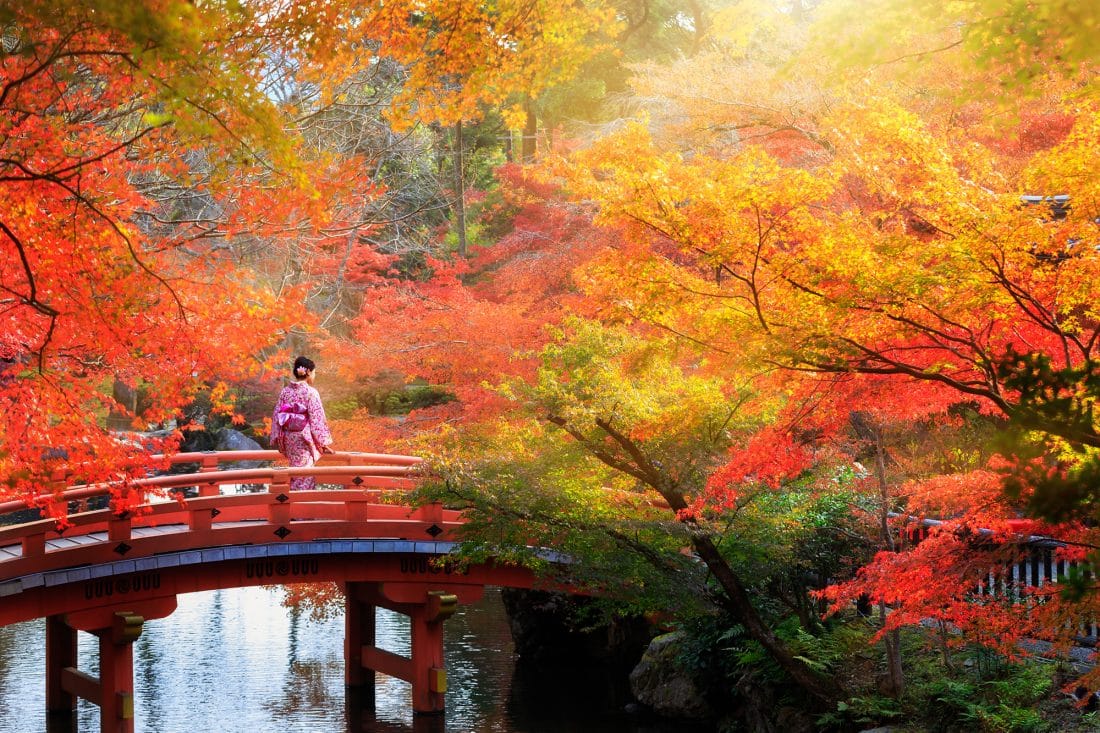
This first-timer’s Japan itinerary is perfect for your first visit to this incredible country. Discover the amazing things to do, food to eat, and places to visit in Japan in this complete guide.
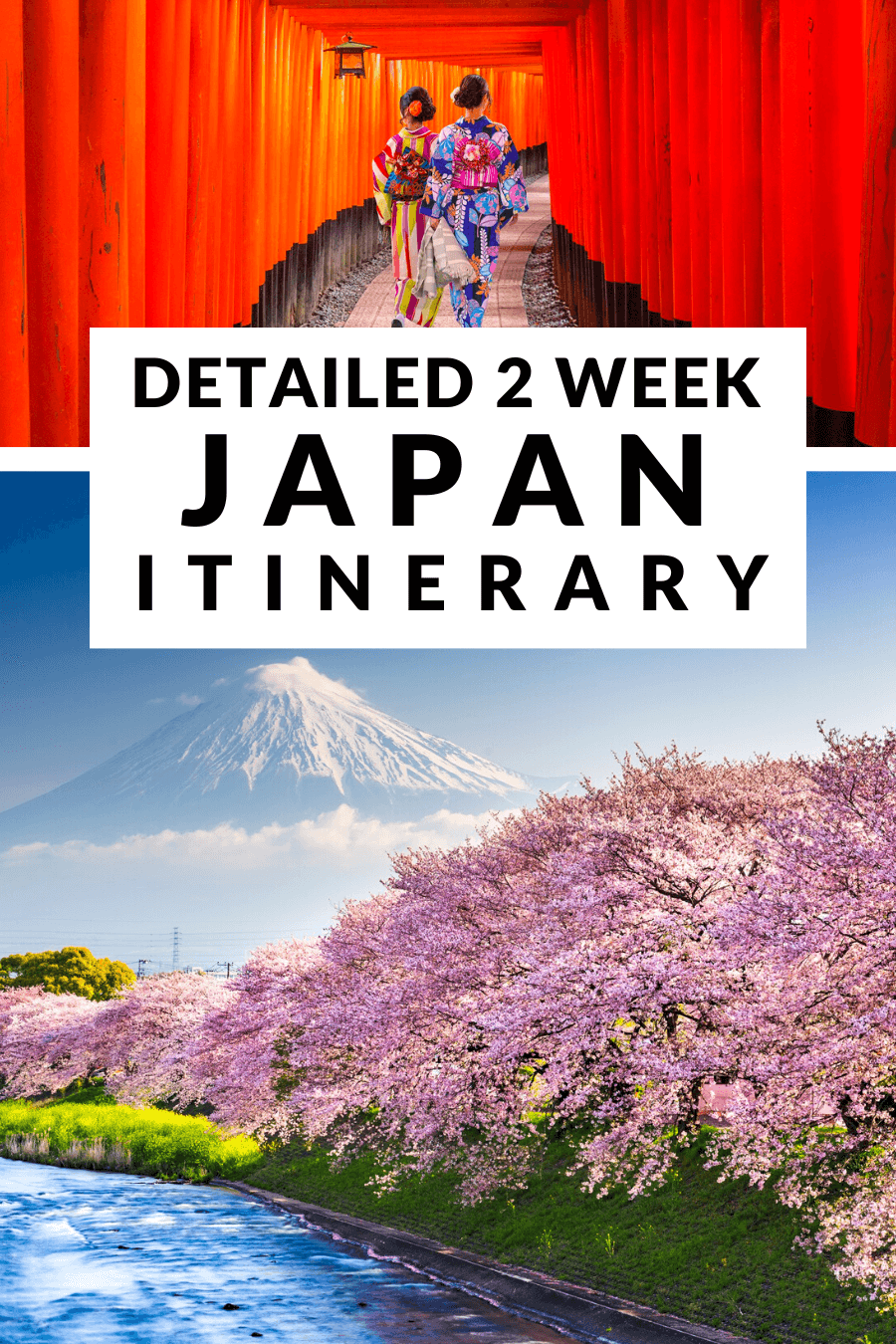
- The Perfect First Timer’s Japan Itinerary: The Best Places to Visit in Japan
This post contains affiliate links.
I’m so excited to share this Japan 2 week itinerary with you! We just booked tickets to go back to Japan again in 2024 and I’m so excited to revisit all of these places and add some new ones too! This will be our second Japan trip, and I can’t wait!
I have two good friends who live in Japan and they’ll only be there for another year, so I knew that my time to go to Japan was now! This was my first stop in Asia and I couldn’t have been more excited! While we’ve spent years in Europe, Asia has always eluded us, so I knew it was time!
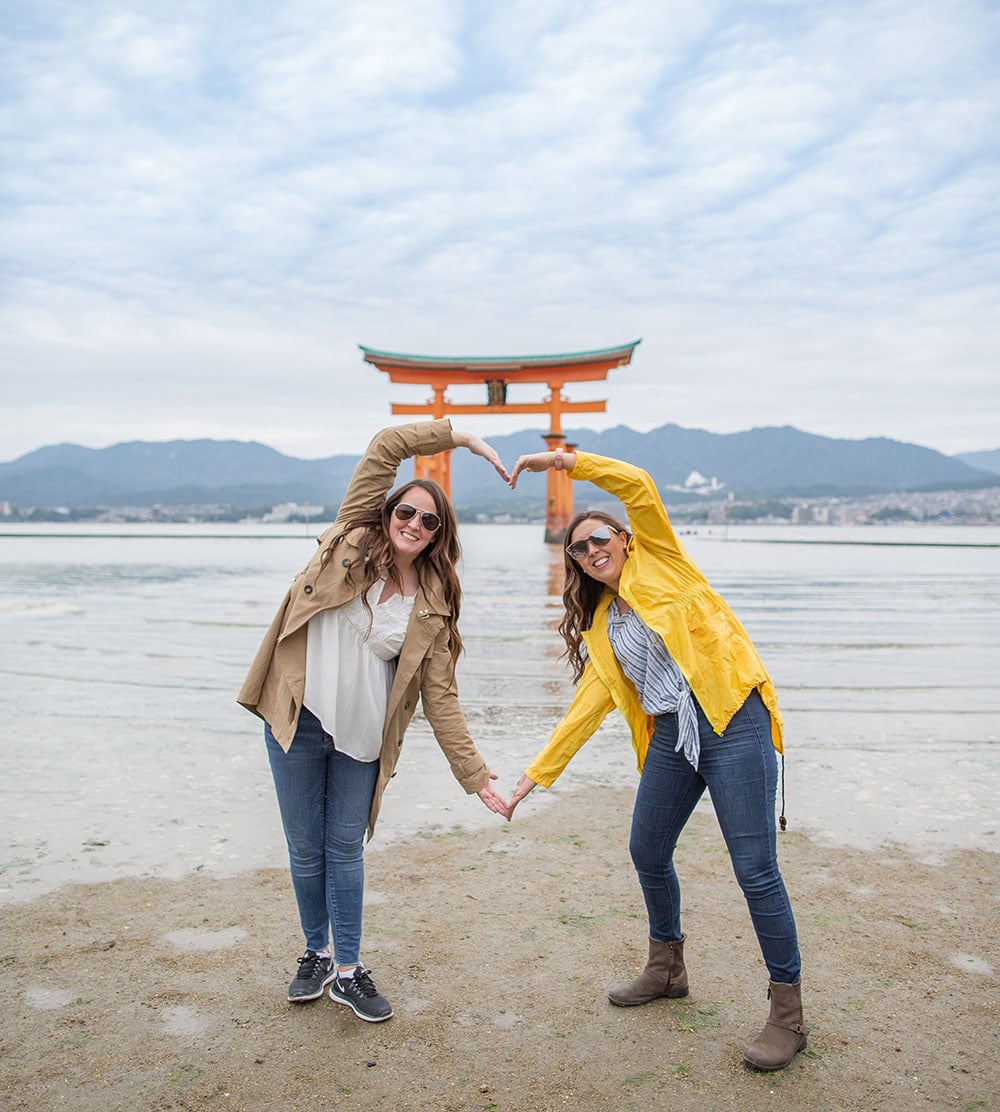
Be sure to check out our Japan Trip Planner to help you get started. It’s a great step-by-step guide to help you plan your trip.
I’ll be totally honest and tell you that I was very anxious before my trip. New continent, new language, new culture, new food. Just a fear of all the unknowns to be honest. But rest assured, once I got to Japan I was feeling great about it all. It really helped to have friends who knew the culture too and I loved these tips for visiting Japan!
Did you know that Japan is one of the safest countries in the world? If you didn’t, don’t feel bad, I didn’t either. I think the number one thing I was totally shocked by was that almost none of the bikes in Japan had locks on them! I saw maybe 3 our entire time there.
The Japanese people are so kind, respectful, and helpful. I was chatting with a British ex-pat in a Japanese garden one morning and he said: “You couldn’t get mugged in this country if you tried!” I’m pretty sure he was right. I never once felt unsafe during our time in Japan.
My friend’s 5-year-old daughter goes to “Yo Chien” or Japanese Primary School and she said that the entire first year of school is dedicated to learning how to be a good person. They serve each other, clean the school, learn manners, and generally learn how to be a respectful human being and be a productive member of society. I think that is definitely more helpful than knowing their ABC’s at 5 years old! There is just so much that we can learn from Japanese culture and its definitely a country worth visiting.
There are so many amazing and unique things to do in Japan . If you’re going for the first time and looking for the perfect Japan trip, I’ve created this Japan itinerary that will explore the basic sites that are easily accessible by train or a bullet train and offer some of the best cultural, culinary, and fun experiences the country has to offer. While there is much more to explore in Japan, this is a really good starting itinerary.
- Planning a Trip to Japan?
If you’re planning a trip to Japan, let me do the work for you. This 2 week Japan Itinerary is a detailed step-by-step guide for how to visit this amazing country.
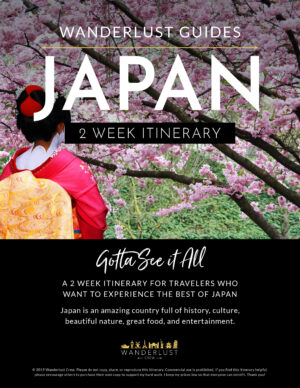
Here's a Short Cut
Getting to Japan
What to pack when you visit japan, japan home rentals, money in japan, what to know before you go to japan, getting around japan how to use your japan rail pass, japan itinerary map, day trip to mount fuji, what to eat in japan, japan itinerary faq, more resources for japan.
Getting to Japan was fairly easy. Flying to Asia from the US can be pricey, but if you know how to get cheap flights, there are always good deals to be found. I spent quite a lot of time perfecting my cheap flight finding skills, so be sure to learn about it here . I spent $600 on tickets from San Francisco to Tokyo.
What to pack for your trip to Japan depends on what time of year you’re going and where you’ll be traveling to. I went the first two weeks of October and it was HOT! It rained on and off several of the days that we were there, but was still very warm and very humid. However, if you go to Northern Japan (great to try hot springs), the weather will be cooler. My friend lives in Misawa and they get huge snowfalls each winter. There is incredible, and affordable, skiing in Northern Japan as well.
If you’re going anywhere between April and October though, this is what I recommend taking to Japan
Here’s what I packed for our own trip to Japan in October:
- 2 sundresses
- 1 pair of jeans
- 1 pair of leggings (for the plane mostly)
- 1 jean jacket (that I hardly used)
- 1 rain jacket (I brought this one and it is great because it’s light but totally waterproof)
- 1 pair of sandals (a pair that can get wet in the rain… these are my favorite travel sandals ever )
- 1 pair of boots (I wore these only one time and regretted it)
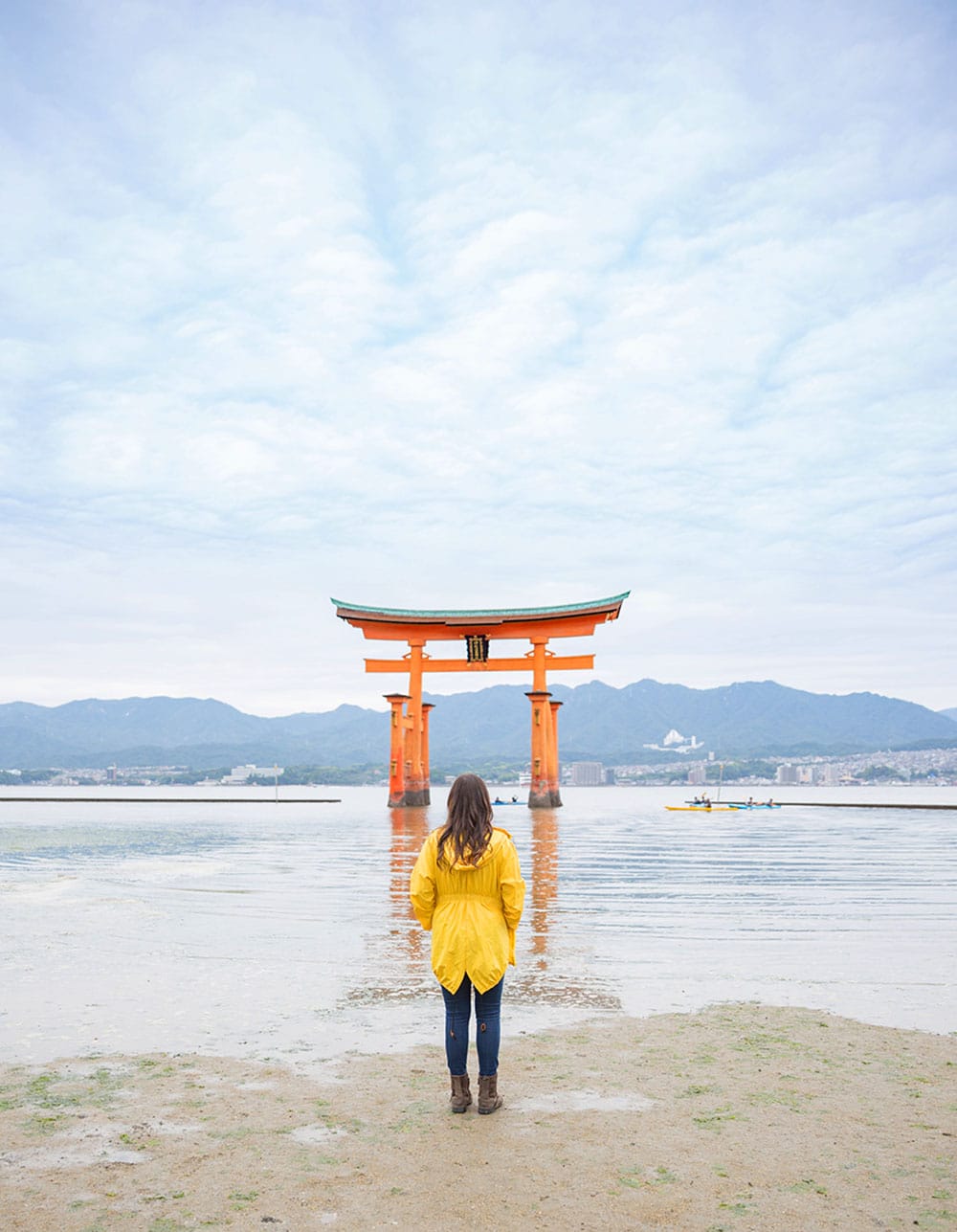
I think if you are sticking to Tokyo and south of Tokyo, this list would be appropriate from April to October. I honestly wish I would have packed more sundresses. I felt like almost everything we did could be done in a dress and it was much cooler!
Where to Stay on your Japan Trip
We were lucky and got to stay with friends at a Military Hotel for about $50/night, but we also stayed in VRBOs around the country. They were affordable, clean, and in good locations. As always, be sure to read reviews and the fine print before booking a VRBO . We love VRBO and use it around the world. I’ve also compiled this list of great and affordable VRBOs in Japan :
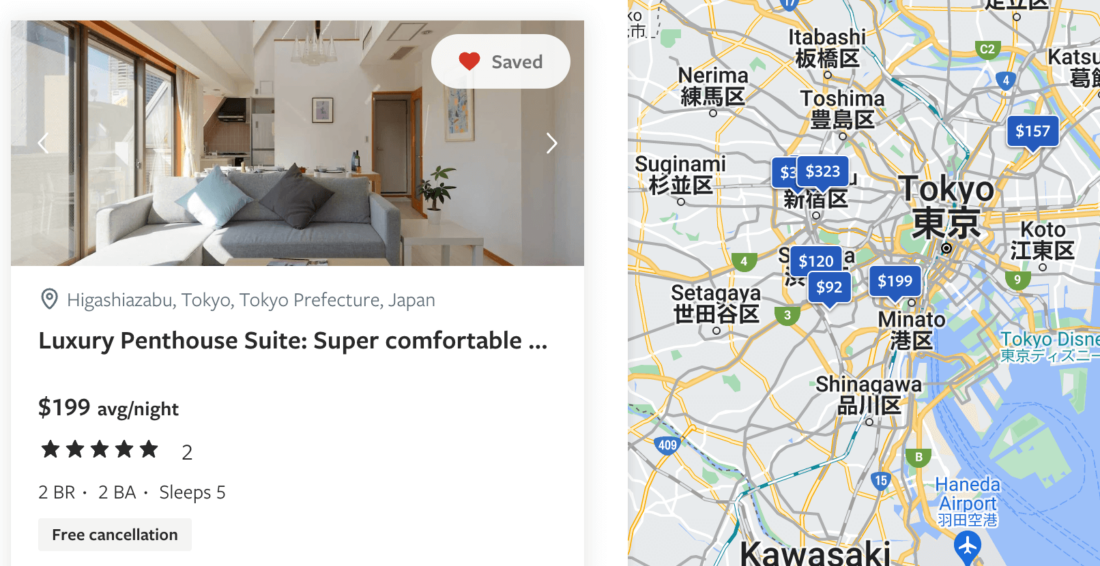
There are also some great hotels in Japan if VRBO is not your thing!
The currency in Japan is the Yen. Converting Japanese Yen to US Dollars is really simple. 100 Yen is Equal to about $0.70 USD 1000 Yen is Equal to about $7 USD Bills from the ATM or from an Airport Money Exchange come in 10000 , 5000, and 1000 increments. The coins come in 500, 100, 50, 10, 5, and 1 increments.
Most places in Japan accept cards. Just beware of any international transaction fees. We use the Chase Sapphire Card to earn double points on travel and to avoid fees while traveling. There were definitely some places that did not accept cards, so be sure to have cash on hand.
Japan is a completely different culture than what visitors may be used to. Anywhere you go in the world, it’s a good idea to learn about cultures and the best practices of your destination. You don’t want to accidentally offend anyone or make an embarrassing mistake. Be sure to read my top 20 tips for visiting Japan.
This is probably the most important information I can tell you about visiting Japan. Getting from city to city in Japan is NOT cheap! A train ticket from Tokyo to Hiroshima can cost around $180. That’s a little steep for my taste, but I knew I wanted to see more than just Tokyo.
The good news is that Japan offers an affordable “ Japan Rail Pass ” that makes traveling around the country extremely affordable for tourists. Read more about how to buy and use your JR Pass here: How to Use Your Japan Rail Pass.
Best places to visit in Japan
For your first Japan trip, it’s best to see a variety of places, but not move too quickly. For a somewhat small country, Japan packs a lot into a small geographical area. For the first time you visit Japan, I recommend seeing all the basic sites like Tokyo , Miyajima , Osaka, Hiroshima , and Kyoto. While there are many more places to visit in Japan that are just as incredible, these areas will be easily accessible using the Japan Rail Pass and are accustomed to tourists.
You can also check out some of these Japan tour packages to see what else you might be interested in. It’s a great way to see the country if you’re not up to planning your own Japan itinerary.
You can use this interactive map to navigate the best places to visit in Japan on your first visit.
No trip to Japan would be complete without visiting the Japan’s capital city, Tokyo. As polite, respectful, and mild-mannered as the Japanese are, it can also be a fun and quirky culture. Tokyo is definitely evidence of this. This huge city is full of light, color, and craziness all around mixed in with serious businessmen and women going to and fro. If you want to learn more about Tokyo, read my guide to visiting Tokyo here: Complete Guide to Tokyo
Mount Fuji is a great place to take a day trips to from Tokyo. It’s a beautiful site and you’ll want to try to plan this on a clear day if you can, however it takes a few hours to go here from Tokyo. Be sure to read this for a complete itinerary for a day trip to Mount Fuji.
This island’s name literally means “island of shrines,” and is Japan’s third most popular site. On Miyajima Island, you will be greeted by friendly deer and beautiful scenery. Read more about this UNESCO World Heritage site in my article here: What to do on Miyajima Island
Famous for being the tragic first target of the nuclear bomb during WWII, Hiroshima is a city full of history and new beginnings that is worth seeing when you visit Japan. It is heartbreaking and heartwarming at the same time. Visiting Hiroshima was hard, but I think it’s so necessary. Read about my time in Hiroshima here: Complete Guide to Hiroshima Japan
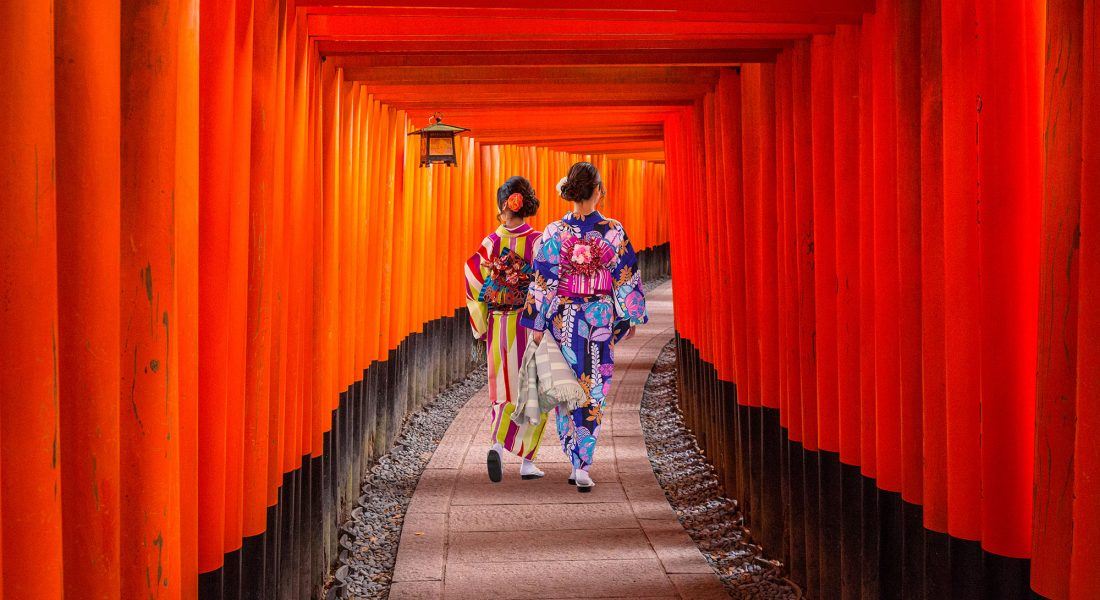
Kyoto, known as the old capital of Japan is beautiful and unique for a reason. It is one of the only places in Japan that was saved from bombing during WWII and therefore has much preserved older architecture that is not seen in other areas of the country like Hiroshima, Nagasaki, and Tokyo. Kyoto is also home to some of the last remaining Geisha in Japan. Many visitors like to come to Kyoto and rent Kimonos and walk the city. The prefecture of Kyoto is large and there is much to do. Plan at least a few days here. Learn more about what to do in Kyoto with kids here and what to do in Kyoto as a solo traveler here.
There is much to do and see in the city of Nara, including the Himuro Shrine, and Isuien Garde, but it is famous for Nara Park where wild deer roam free and are unafraid of humans. Nara is a really easy day trip from Kyoto or Osaka and a favorite with kids! You can read more about visiting Nara here .
Osaka is a great place to base yourself in Japan with Kids if you plan on visiting both Nara and Kyoto. It’s central to both and an easy train ride away. Osaka is also a great place for kids with Universal Studios, Legoland, Osaka Aquarium, Omigachi Park, Tennoji Zoo, and plenty of animal cafes around the city! You could definitely spend several days in Osaka and still not see it all. Learn more about Osaka for kids here.
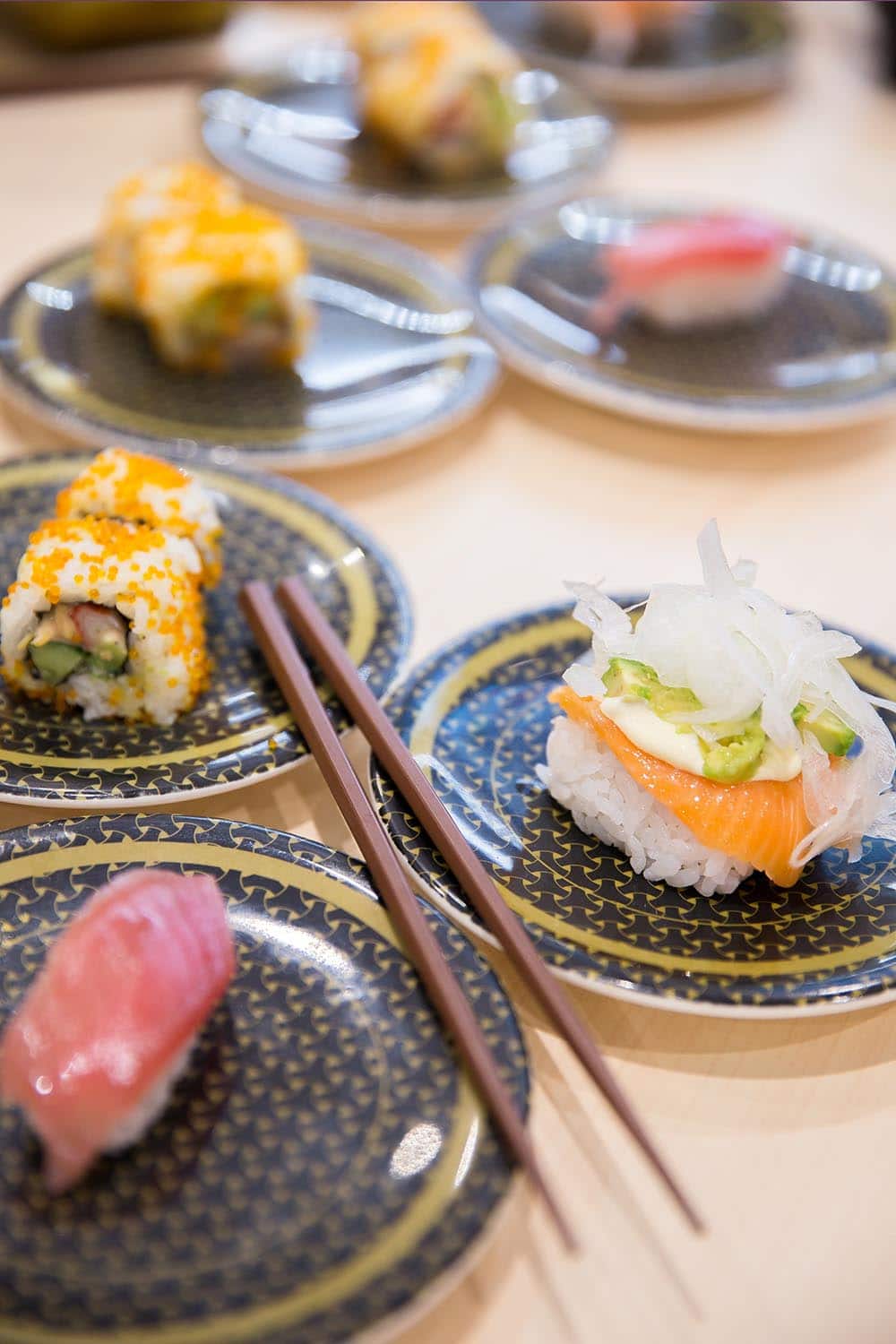
Blending many influences from the east and west along with ancient traditions, Japanese cuisine is some of the tastiest in the world. After visiting Japan for several weeks and eating my way through the country, I compiled this list of 25 foods you must try in Japan Don’t skip foods that might seem different or strange to you, especially their street food, you may just find something that you love. Be brave and have fun!
I absolutely loved my first time in Japan and grew to have a deep respect for the country and its people. I can’t wait to get back and bring the whole family next time. With so many things to do and places to visit in Japan, I think a trip back is definitely necessary, but I think this is a great first timer’s Japan itinerary to get you started.
To start, you near to specify your date of arrival, flights, and any other information required on your itinerary. Once you have that, you can then add details such as the duration of stay in each city, transportation options, and the attractions and activities planned. Make sure to include important contact information (such as your hotel address or phone number) so that it is easy to find if needed. Additionally, it’s a good idea to list any applicable fees and schedules, as well as the items you plan to bring with you. Finally, make sure to double-check all details for accuracy before submitting your itinerary so that your trip is uninterrupted.
Just like traveling to other countries, you need to make sure of your Visa requirements, have a travel insurance, and check the local customs. It is also important to research the currency exchange rates to budget properly as well as understand Japan’s language and culture. There are certain laws, such as no smoking indoors or in public spaces, which you should be aware of before travelling. Finally, it’s always best to have an itinerary ready for your trip so that you can make sure everything runs smoothly.
If you’re traveling for the first time, 7-10 days will provide you with enough time to get a feel for the country. You can take in some of the must-see attractions, visit popular cities, and explore other regions too. Of course, if you want to fully immerse yourself into Japan’s culture then it might be worth planning a longer trip with 14 days or more. That way you’ll have enough time to take in more sights and have a relaxed, enjoyable experience.
Currently, there’s no need to present a vaccination certificate upon entering Japan. However, it is important to take into account all the safety measures and regulations in place for visitors. You should also be aware of Japan’s laws regarding certain activities such as underage drinking and smoking before you arrive. Additionally, you should make sure to double-check your travel plans (including any visa requirements) before departing for your trip.
25 Foods You Must Try in Japan Guide to Miyajima Japan Guide to Hiroshima Japan Guide to Tokyo Japan Guide to Nagoya Japan Guide to Osaka Japan

Wanderlust Crew
4 thoughts on “ two weeks in japan – the best japan itinerary for first-timers ”.
This is a great overview! Thanks heaps. Japan is on my travel list but I need to convince my hubby (mainly because of the food is his reason I think). I love love love the first year of primary school! We have lots of learn from Japan (and Finland I think) for schooling. My son is going into grade 1 so I don’t think we’ll see any changes in his schooling life x
Oh man, read this for the food in Japan. It might change his mind. I was a little worried about the food as well but ended up loving it so much! https://wanderlustcrew.com/japan-food/ My friend’s kids go to a Japanese school and it’s so cool! All of kindergarten they just learn manners and how to serve each other. It’s such an amazing approach to education!
Pingback: Is Osaka Worth Visiting in Japan? What You'll Miss if You Don't Go | Sand In My Suitcase
Pingback: 10 awesome car-free vacations for families - Travel Car Seat Mom
Leave a Reply Cancel reply
Your email address will not be published. Required fields are marked *
Notify me of follow-up comments by email.
Notify me of new posts by email.
This site uses Akismet to reduce spam. Learn how your comment data is processed .

The Ultimate Itinerary for a Trip to Japan: Unforgettable 7, 10 and 14 Day Journeys (Updated 2024)
Some destinations reward spontaneity – in Europe, cheap flights and rail passes give you the freedom to wake up in the morning and choose your next destination on a whim. Japan, on the other hand, rewards forward planning.
The country’s abundance of both natural and manmade attractions, combined with its high standard of living and general efficiency, make it a fairly pricey destination. The more you plan, the better you can mitigate the damage to your wallet, and get the most out your trip – no matter how long you plan to stay.
These itineraries are designed to inspire you to build your own trip. Based around a few key highlights that represent both modern and ancient, they’re crafted to give you a rich and satisfying experience of Japan in 7, 10 or 14 days. Let’s jump right in!
Psst: want more tips for planning a trip to Japan? Check our rail pass guide and cheap eating tips .
- 1 Getting Around
- 2 7 Day Itinerary: Tokyo and Mt Fuji (Fuji Five Lakes)
- 3 7 Day Itinerary: Osaka, Kyoto and Nara
- 4 10 Day Itinerary: Tokyo, Mt Fuji and Kyoto
- 5 10 Day Itinerary: Osaka, Kyoto, Nara and Hiroshima
- 6 14 Day Itinerary: Tokyo, Mt Fuji, Osaka, Kyoto, Nara, and Hiroshima
Getting Around
Before we get to the itineraries, there's one important piece of planning to keep in mind – whether or not to get a JR pass . A Japan Rail (JR) pass is exclusively available to tourists, and grants you unlimited travel on JR trains within Japan, including the world-famous bullet trains. Depending on your itinerary, this will save you time and money vs buying individual train tickets within Japan. But importantly, you must purchase the pass before you arrive in Japan . We recommend ordering from Klook for their low prices and 10-day global delivery.
We've marked the itineraries that we recommend the JR pass for below, but for a more in-depth guide, be sure to read our full guide The Japan Rail Pass: Is It Worth The Cost?
7 Day Itinerary: Tokyo and Mt Fuji (Fuji Five Lakes)
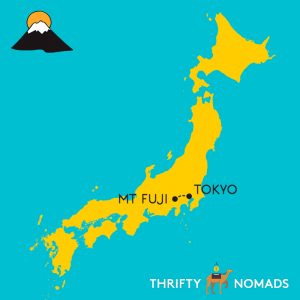
Get the essentials of urban and rural Japan with four days in the unforgettable capital, followed by three days of reflection and recovery under the shadow of Mt Fuji.
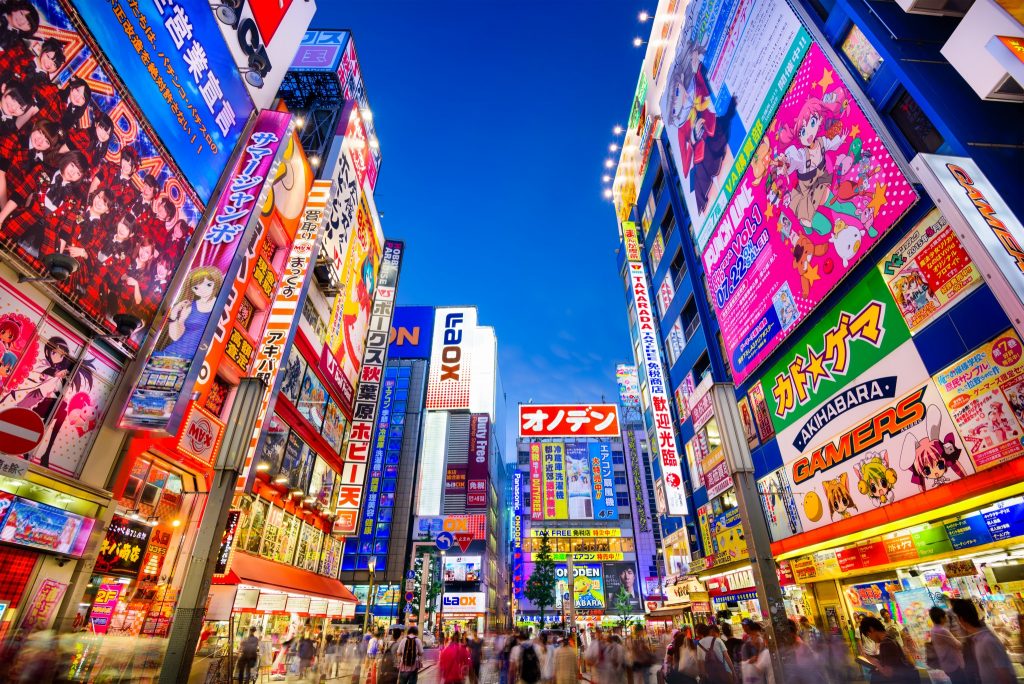
Tokyo: 4 Days
- Highlights: Go crazy in Japan’s frenetic, eclectic and incomparable capital. Live out a manga fantasy in Akihabara , drink shoulder to shoulder with locals in Roppongi , and see the world’s largest metropolis in 360 degrees from the top of the Tokyo Tower . And for an immersive digital art experience, check out the popular teamLab Planets TOKYO Museum .
- Where to stay: Public transport is comprehensive, so search far afield. Roppongi neighborhood if you like nightlife, Shinjuku to be close to the beating heart. Use TripAdvisor to compare hotel and hostel deals across all booking sites along with thousands of reviews.
- What to eat : Chains like Sushiro ($1 / plate train sushi) and the ubiquitous Gyudon houses like Yoshinoya can get you a delicious local meal for a budget price. Check out a Maid Cafe for an authentic (if risque) local experience!
Mt Fuji: 3 Days
Tip: If you don't have 3 days to spend in Fuji, you can book a full day tour from Tokyo .
- Highlights: See why this 3776 meter high mountain has inspired artists, writers and pilgrims for countless centuries. Soak up the volcanic waters in the Five Lakes District , a major tourist destination since the 1920s, it’s still possible to get away from the crowds and immerse yourself in nature.
- Where to stay: The Five Lakes Region contains a wealth of hotels and resorts. If you’re striking out, try a bit further away from (but still in plain view of) the mountain in Hakone district. Compare across booking sites with TripAdvisor's hotel search.
- What to eat: Try the regional speciality: udon noodles, often served cold in a delicate, flavorful sauce.

7 Day Itinerary: Osaka, Kyoto and Nara
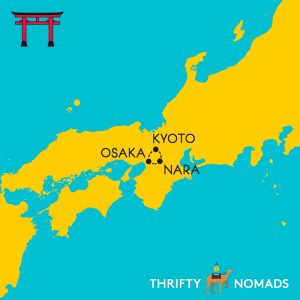
Osaka: 3 Days
- Highlights: Japan’s second biggest city is a microcosm of everything that magnetizes visitors to the country. Gaze in awe at giant plastic sea creatures and effusive street vendors in Dōtonbori , wander among the tuna merchants at the fish market, and connect with history at the 16th century Osaka Castle . Get to know Osaka like a local with a highly-rated walking tour .
- Where to stay: Try AirBNB and trust the train network if you find a good option a little outside of town. For hotels and hostels, compare across booking sites using TripAdvisor .
- What to eat : The same budget chains in Tokyo will serve you well here (I practically moved in to my nearest Sushiro!), but you really must try the street food on Dōtonbori .
Kyoto: 2 days
- Highlights: After the urban grunge of Osaka, it’s time to embrace the Japan’s spiritual side at the ancient seat of empire. It’s still possible to see Geisha in the historic Higashiyama District, which you can even explore by rickshaw , and the subtle beauty of temples like Kinkaku-ji is simply too much to put into words. Make sure you catch everything there is to see with a custom-made walking tour with a local . Go!
- Where to stay: Downtown Kyoto is the most convenient spot for sightseeing and will allow you to cover much of the historic town on foot. Try Airbnb or compare hotels and hostels across booking sites with TripAdvisor .
- What to eat : Restaurant prices can be steep so take a trick from the locals and stock up on tasty (and filling) instant meals at chain stores like the ubiquitous 7/11
Nara: 2 days
- Highlights: Stick with the theme of history but swap the Geisha for sacred deer in Nara , Japan’s capital from AD 710 to 794. In Nara park you can sip green tea in a traditional “Chaya” tea house and watch the deer frolic over 700 year old ground. Hire a local guide to make sure you catch it all!
- Where to stay. While it’s possible to day trip from Osaka, the town is well worth staying overnight – guest houses are abundant and there are even hotels in the historical park! You can compare all your options and find the best price using TripAdvisor .
- What to eat . Vegetarian food and pickled delicacies are the local specialities, due to the surrounding mountains and buddhist communities.

10 Day Itinerary: Tokyo, Mt Fuji and Kyoto
Got 10 days? Let’s do it right. Take a deep dive into the capital, cleanse yourself with nature in Mt Fuji and the surrounding 5 Lake District, and transport yourself back in time in Kyoto – a rich overview that will leave you feeling refreshed, satisfied and exhilarated.
For this itinerary, we recommend a JR pass . It will save you precious travel time on the bullet train, and save you money on train fares between, and within, Tokyo and Kyoto. Remember to order your pass BEFORE you enter Japan (we recommend Klook ). If you're still unsure, be sure to check out our in-depth guide on whether the JR pass is worth it .
- Highlights: Lose yourself among the neon lights of Shibuya and have a drink at the Monster Cafe . Watch locals transform themselves into Manga characters on an anime/gaming tour in Akihabara , drink hot sake with locals in Roppongi, and let digital art completely immerse your senses in Japan’s unforgettable capital.
- Where to stay: Public transport is comprehensive so search far afield. Roppongi neighborhood if you like nightlife, Shinjuku to be close to the beating heart.
- What to eat : Tokyo has unlimited dining options – if you’re on a budget, try Gyudon and brave the budget chains where it’s still possible to order with ancient vending machine located by the kitchen!

- Highlights: Make all your instagram followers jealous as you soak up the steamy volcanic waters under the shadow of Japan’s largest and most famous mountain.
- Where to stay: The Five Lakes Region near the mountain contains a wealth of hotels and resorts. If you’re striking out, try a bit further away from (but still in plain view of) the mountain in Hakone district.
Kyoto: 3 days
- Highlights: The twin temples Kinkaku-ji and Ginkaku-ji (gold pavilion and silver pavilion) have been carrying out an architectural and spiritual debate for centuries. It’s still possible to see Geisha in the historic Higashiyama District, which you can even explore by rickshaw . Make sure you catch everything there is to see with a custom-made walking tour with a local .
- Where to stay: Downtown Kyoto is the most convenient spot for sightseeing and will allow you to cover much of the historic town on foot.
- What to eat : Live out a warrior fantasy at the Samurai Restaurant . It’s a bit kitsch and definitely designed for the tourists, but so what – you’re on holiday!
10 Day Itinerary: Osaka, Kyoto, Nara and Hiroshima
Get the best of Japan today and yesterday in racey Osaka, tranquil Kyoto and serene Nara, before coming face to face with perhaps the darkest period of Japan’s history at Hiroshima.
For this itinerary, we recommend a JR pass . It will save you tons of travel time on the bullet train to Hiroshima, and save money on train fares within the Osaka/Kyoto/Nara area. You need to order your pass BEFORE you enter Japan (we recommend Klook ). If you're still unsure, be sure to check out our in-depth guide on whether the JR pass is worth it .
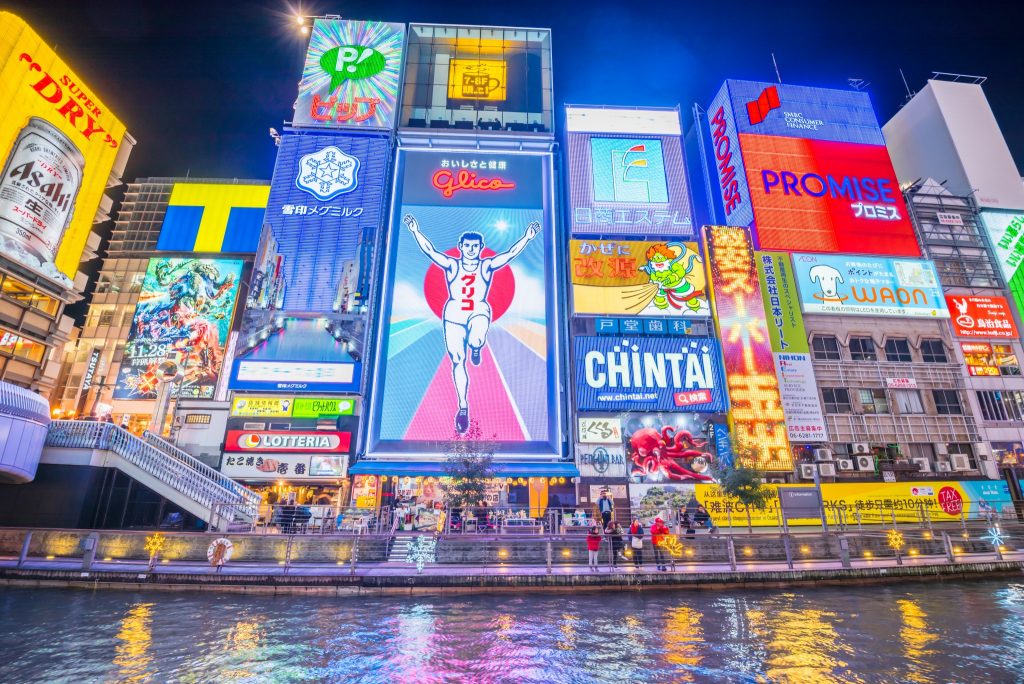
- Highlights: “Forget Tokyo,” I was told when I planned my first trip to Japan, “Go to Osaka!” While the capital is awesome, Japan’s second city more than holds its own. Here you can gaze in awe at giant plastic sea creatures and effusive street vendors in Dōtonbori, wander among the tuna merchants at the fish market, and connect with history at the 16th century Osaka Castle. Get to know Osaka like a local with a highly-rated walking tour .
- Where to stay: Try AirBNB and trust the train network if you find a good option a little outside of town.
- What to eat : Try the street food on Dōtonbori! A nightfood tour will help you find the best spots and eat where the locals eat!
- Highlights: Say goodbye to the furious pace of modern Japanese city life, and embrace the tranquil, spiritual and ancient in Kyoto. Believe it or not, but it's still possible to see Geisha in the historic Higashiyama District, even from a rickshaw . The gentle beauty of temples like Kinkaku-ji is simply too much to put into words. Make sure you catch everything there is to see with a custom-made walking tour with a local . Go!
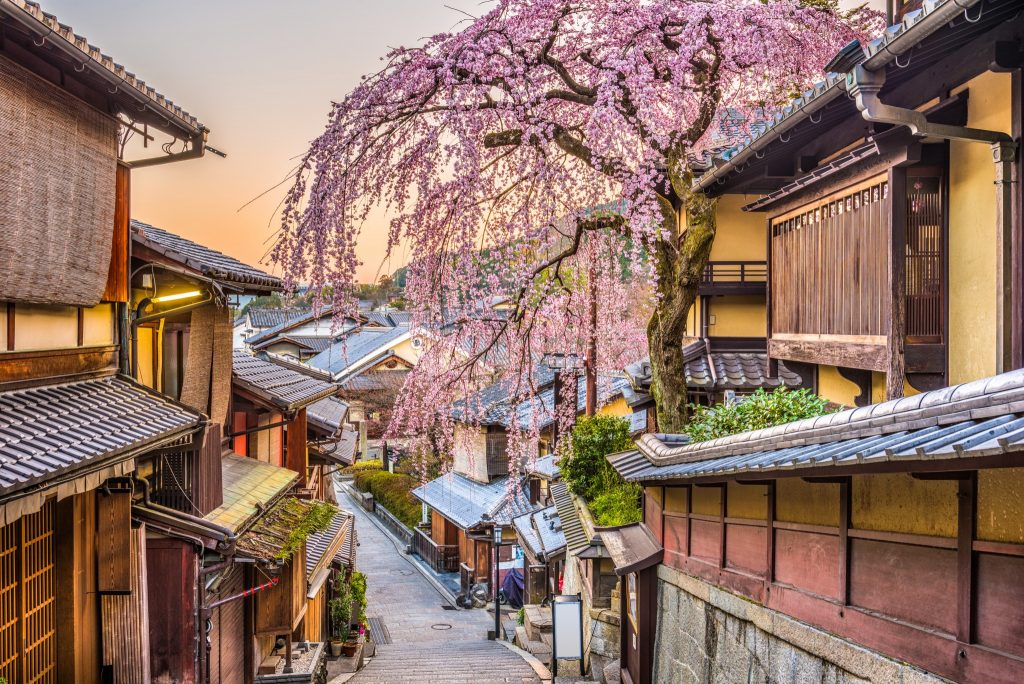
- Highlights: In Nara park you can sip green tea in a traditional “Chaya” tea house and watch the deer frolic over 700 year old ground. Hire a local guide to make sure you catch it all!
- Where to stay. While it’s possible to day trip from Osaka, the town is well worth staying overnight – guest houses are abundant and there are even hotels in the historical park!
- What to eat . Thank the Buddhist communities in the surrounding mountains for the abundance of local vegetarian food.
Hiroshima: 2 days
- Highlights : Infamous for its more recent history (which you can learn from a local on a cycling tour ), the rebirth of Hiroshima from ashes into a vibrant modern city is reason to visit in itself. In addition to haunting museums and poignant relics to the nuclear attacks, Hiroshima is the gateway to rural Chūgoku , a chance to tip your toes into Japan’s unspoiled wilderness.
- Where to stay : Hiroshima is drenched in hotels. Stay near the train station for convenient access to the city center and surrounding attractions.
- What to eat : Try the local okonomiyaki, a delicious, savory grilled pancake smothered in sauces and toppings.

14 Day Itinerary: Tokyo, Mt Fuji, Osaka, Kyoto, Nara, and Hiroshima
This is an itinerary for people who want it all! You’ve got two weeks, you’ve got your rail pass , and you’re going to jolly-well make the most out of your time. Well, if you’ve got the energy, then here’s how it could be done. It’s everything you see above, rolled into one epic itinerary for the bold and brave.
For this itinerary, we definitely recommend a JR pass . With the distance being covered from the east to the west of country, the amount of time and money this will save is a no-brainer. You must order your pass BEFORE you enter Japan (we recommend Klook ). But if you're still unsure, be sure to check out our in-depth guide on whether the JR pass is worth it .
- Highlights: Start with the blast of energy, neon, weirdness and glamour that is Japan’s capital. Opportunities for entertainment are virtually unlimited – feel the awe of the emperor at the imperial palace, indulge in a retail fantasy in Ginza, and finish the day with a well needed pint of Asahi in Roppongi.
- Where to stay: Public transport is comprehensive so search far afield. Roppongi neighborhood if you like nightlife, Shinjuku to be close to the beating heart. Use TripAdvisor to compare hotel and hostel deals across all booking sites along with thousands of reviews.
- What to eat : The real question is what NOT to eat. You could go to a different restaurant in Tokyo everyday for 20 years and still not run out of options. If you’re on a budget, look to the local fast food chains – if you’re on a tight budget, trust to the 7/11!
Mt Fuji: 2 Days
- Highlights: Hear a rumble? Fuji-san isn’t just a stunning, snow capped mountain, it’s still an active volcano! Soak up the volcanic waters and watch Fuji’s towering form from the Five Lakes District , a popular spot for locals and and travelers.
- Where to stay: The Five Lakes Region contains a wealth of hotels and resorts. If you’re striking out, try a bit further away from (but still in plain view of) the mountain in Hakone district. Compare across booking sites with TripAdvisor's hotel search.
- What to eat: Try the regional speciality: udon noodles, often served cold in a delicate, flavorful sauce.
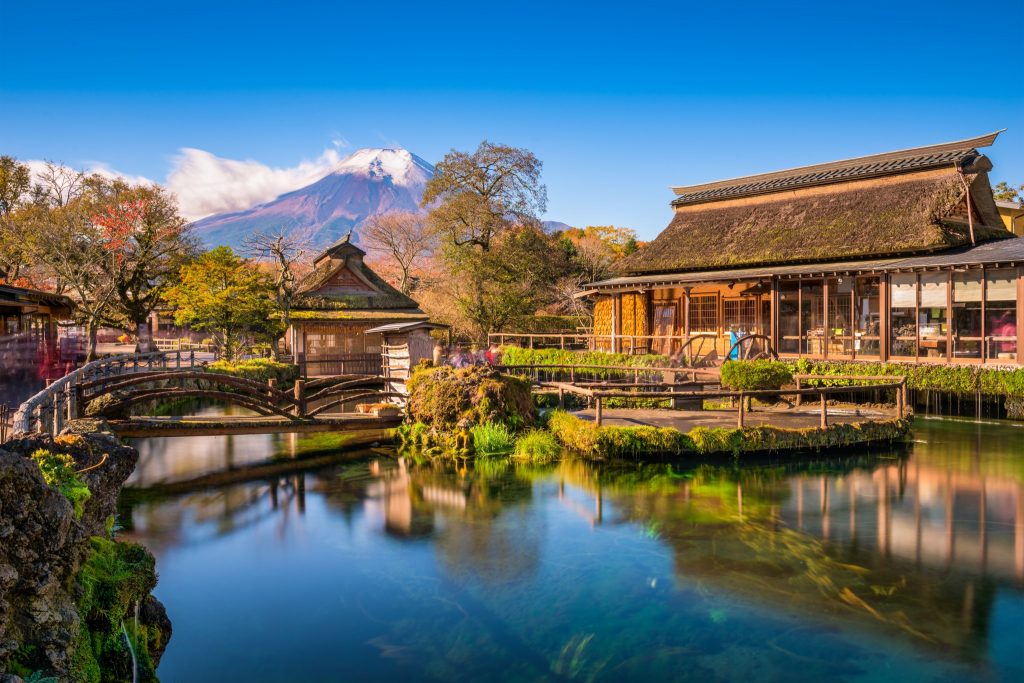
Osaka: 2 Days
- Highlights: Japan’s second biggest city is a microcosm of everything that magnetizes visitors to the country. Gaze in awe at giant plastic sea creatures and effusive street vendors in Dōtonbori , wander among the tuna merchants at the fish market, and connect with history at the 16th century Osaka Castle .Get to know Osaka like a local with a highly-rated walking tour .
- Where to stay: Try AirBNB or TripAdvisor and trust the train network if you find a good option a little outside of town.
- What to eat : The same budget chains in Tokyo will serve you well here (I practically moved in to my nearest Sushiro!) but you really must try the street food on Dōtonbori .
- Where to stay: Downtown Kyoto is the most convenient spot for sightseeing and will allow you to cover much of the historic town on foot. Try Airbnb or compare hotels and hostels across booking sites with TripAdvisor .

- Where to stay. While it’s possible to day trip from Osaka, the town is well worth staying overnight – guest houses are abundant and there are even hotels in the historical park! You can compare all your options and find the best price using TripAdvisor .
- Where to stay : Hiroshima is drenched in hotels. Stay near the train station for convenient access to the city center and surrounding attractions. Check both Airbnb and TripAdvisor for the best prices.
With the abundance of incredible places to visit in Japan, the only trouble you'll have with planning a trip here is which itinerary to follow. Tell us, what are your must-visit's on a trip to Japan?
How to Spend Two Weeks in Japan: An Itinerary for First-Time Visitors
Two weeks is the perfect amount of time for your first trip to Japan.
You’ll be able to explore this wonderful country from the mountains to the sea, wandering through chaotic neon-lined streets and serene Zen temples, soaking in onsens and filling yourself with more ramen and sushi than you ever thought possible.
For your first visit in Japan, I recommend kicking things off in Tokyo (4 nights) before heading to Hakone (1 night), Yudanaka (1 night), Kanazawa (2 nights), Takayama (1 night), Kyoto (3 nights), Hiroshima (1 night), and Osaka (2 nights). You’ll experience a perfect blend of cities and nature, and leave craving a return visit to do it all over again.
Here’s how these destinations look on the map:
Day One: Arrive in Tokyo and Get Your Bearings
If you’ve come from afar, this is likely going to be a hectic day that passes in a haze of jet-lag. It’s best to take things easy on yourself during your first day in this chaotic city, and spend your time exploring the touristy parts of Shibuya
Make sure to walk across the iconic Shibuya Crossing on your first day, then head to the nearby Starbucks for a kickass view from above. Tower Records is fun to visit for a hefty dose of nostalgia, and if you discover you’ve forgotten to pack anything in your luggage, this is the perfect area for shopping. I may have spent this first day replacing my well-worn travel closet with Japanese versions.
Where to stay in Tokyo: It’s your first day in Japan! And so, it makes sense to really throw yourself into the local experience. That’s why we decided to stay at this lovely onsen-ryokan in Shinjuku. (Whenever readers ask me which neighbourhood to choose in Tokyo, I always recommend Shinjuku or Shibuya.) The reason why I loved this specific property, though, is because it’s a ryokan (traditional Japanese Inn) that also has an onsen (hot pool). It’s a great way to jump immediately into all things Japanese.
And it was wonderful; one of my favourite hotels in the country. The rooms were small and cosy, and felt super-traditional and calming. The views over Tokyo at night from the window were incredible. And the rooftop onsen? With free popsicles afterwards? So good. It’s located in a quieter neighbourhood, but still only a 10-minute walk to the subway. I really recommend this one!
Day Two: Explore Harajuku and Shinjuku on Foot
Kick off your day with a hipster breakfast and latte in Harajuku. You’re going to adore this cool as hell neighbourhood , and want to spend an entire day cafe-hopping my way around the area. I recommend eating at Mr Farmer for a fun brunch, and loved Deus Ex Machina cafe for a morning caffeine kick.
There’s tons to do in Harajuku, so you’ll likely spend much of your second day in Tokyo walking, taking photos, and people-watching. I went to an ethically dubious hedgehog cafe , gawped at the unique fashion stores, fell in love with the Big Love Records store, and snacked on excellent gyozas at Gyoza Lou.
In late-afternoon, make your way back over to Shinjuku to head up to the top of the Tokyo Metropolitan Government Building. It offers one of the best free views in the city, and is worth visiting at sunset to watch the city slowly light up.
Round off your evening with one of my personal highlights from my time in Tokyo: yakitori and cold beer on Piss Alley, followed by bar-hopping around the charismatic Golden Gai bar district. This was so much fun!
Day Three: Head Over to Central Tokyo
Start your day at Tokyo’s Imperial Palace, and spend your morning wandering around the grounds and gardens. This is a wonderful area of the city and you can easily spend several hours exploring, especially in the beautiful East Gardens.
After grabbing lunch, opt for a laid back afternoon walking the streets of high-end Ginza to see a different side of the city. Ginza may be known for its luxury shopping opportunities, but Ginza Crossing, Itōya Stationary Store, Hamarikyu Gardens are all free to see.
Day Four: Get Your Geek On in Akihabara
The jet lag should be wearing off by about now, so how about a hefty dose of culture shock?
Kick off your final morning in Tokyo by heading to Asakusa to check out the famous Senso-ji Temple. It’s one of the most photographed spots in the city, so you’ll want to get there early. Once the crowds start to arrive, wander over to Ueno Park to spend a couple of hours walking the trails and sitting on benches beside the pretty lake.
Akihabara used to be Tokyo’s electronics district and while you can still find plentiful technology stores there — Dave bought a new shaver there! — it’s now also the home of manga madness . In short, this neighbourhood is bright, noisy, and jam-packed with comic book stores. It’s the perfect place to spend an afternoon people-watching, experiencing culture shock, and pondering how it’s possible for so much neon to exist in one place.
There’s tons to do here: you could jump on an afternoon walking tour that takes you to all of the hidden gems and big-name anime-themed attractions in the neighbourhood. You could visit one of the infamous maid cafes, or you could hit up Super Potato to dive into the vintage gaming classics of the 80s and 90s; some of the games aren’t for sale anywhere else in the world! And if you want to go all in on the madness, you could sign up for a themed go-karting tour through the streets of Akihabara, dressed as a character from a Nintendo game. Yes, really.
This part of the city is exactly what you’re imagining when you think of Tokyo.
Day Five: Check Out Mount Fuji from Hakone
If seeing Mount Fuji is high on your wishlist, you’ll want to take a trip out to Hakone. I spent the night there in order to see as much as possible, but you could also do it as a day trip from Tokyo ( there are day trip tours ) if you’re short on time. Check availability for those day trips using the widget below:
If you’re aiming to climb this active volcano, keep in mind you can usually only do so between July and August, and also remember it’s rare to find yourself in front of Mount Fuji with bright blue skies. Prepare for clouds in the hopes of being surprised — December offers the best chances of seeing the mountain with pristine blue behind it.
The best and cheapest way to see Hakone is by purchasing the Hakone Free Pass , which gives you unlimited rides on all the transportation options over two days. You’ll start by taking the train from Hakone-Yumoto to Gora, then jumping on the cable car to Sounzen. From there, you’ll board a ropeway to Owakudani where you can check out the volcanic activity and sample some sulphuric eggs, and then continue on the ropeway to Togendai.
Next up: a pirate ship! Yes, really. You’ll be able to grab a ride on the boat that sails across Lake Ashi from Togendai to Hakone-machi, and then walk around the lake to Moto Hakone. From there, you’ll be able to jump on a bus to the starting point! It’s an easy circular journey that’ll expose you to pretty views of Mount Fuji and the surrounding area.
If you have extra time and love checking out quirky sights when you travel, head to Yunessun Spa Resort, which was my one big Hakone oversight. There, you’ll be able to bathe in hot pools filled with sake, coffee, red wine, and even ramen .
Where to stay in Hakone: We opted for a private room in a lovely guesthouse , with a tatami mat floor to sleep on and a private onsen on-site. It ended up being another one of our favourite stays in Japan! The staff were lovely and there was a restaurant/bar that served up surprisingly fantastic pizzas. It had a cosy and chilled-out atmosphere, with great food and wine, and lots of blankets to snuggle up with as we ate. It was also worth staying here just to experience the private onsen — we got to go in as a couple!
Day Six: See the Snow Monkeys in Yudanaka (Optional)
It makes little logical sense to head from Hakone all the way to Yudanaka, as it involves four trains, some with tight changes, and half a day of travel, but if it’s winter and you’ve always dreamed of seeing Japan’s famous snow monkeys, this might be worth the detour for you.
Just keep in mind that the experience isn’t as organic as it’s touted to be online, and felt a bit like a zoo to me. You can read my report from my time at Jigokudani Monkey Park , along with some recommendations for making the most out of your visit if you do decide to go. If you’re visiting outside of winter, don’t bother going — the monkeys won’t be in the hot pools and the surrounding area is pretty ugly.
If you do decide to skip Yudanaka, I’d add an extra day to Tokyo, Kyoto, or Osaka in its place.
Where to stay in Yudanaka: In Yudanaka, we splurged on a stay in a cosy ryokan , which is something you have to experience at least once in Japan. With prices often reaching as high as $300 a night for the experience, I was thrilled when I stumbled across a more budget option in Yudanaka. It was run by an adorable Japanese couple, and their house came with a private onsen, return transport to the snow monkeys, and one of the most extravagant meals of my life. A kaiseki is a multi-course meal that will see you eating roughly a week’s worth of food (maybe an exaggeration) in a single night, sampling fresh, local Japanese cuisine. It was delicious, and I adored having no idea what anything was. I highly recommend the experience, although being presented with a seven course meal for breakfast had me on the verge of tears the morning after.
Day Seven: Sushi, Architecture, and Gardens in Kanazawa
I love Kanazawa! I added it to my itinerary because so many of my friends told me it was their favourite place in Japan and I came away having fallen head over heels in love with it, too. This lovely city on the coast is one of the more chilled-out spots in the country, where you can take things slow and enjoy where you are, rather than rushing around and trying to see as much as possible.
Odds are, you’ll be travelling a fair distance to get to Kanazawa (it’s about three hours on public transport from either Tokyo or Yudanaka), so you likely won’t get into the city until the afternoon. That’s no big deal because there’s not a huge pressure to sightsee here.
There are three main standouts when it comes to Kanazawa — the sushi, the history, and the gardens — and as long as you get to experience all three, you’ll be doing great. In fact, odds are, you’ll be able to see them all today.
If at all possible, try to time your arrival in Kanazawa with lunch. One of my favourite meals in Japan was at the fabulous Omicho Market, which is famous for its sushi, sashimi, and high-quality fresh seafood.
The market is less touristy than the chaotic Tsukiji Market in Tokyo, and that means more locals, cheaper prices, and just-as-fantastic seafood. Wander the stalls taking photos, choose a restaurant that’s packed with locals, then sample some of the freshest sashimi you’ll ever encounter. Let’s just say I don’t plan on opting for sashimi outside of Japan very often after this experience!
After lunch, kick off your sightseeing in Kanazawa by heading to its most famous attraction: Kenruko-en Gardens. It’s one of the top three gardens in Japan and makes for a perfect way to soak up the relaxed vibes. You could see the entire park in half an hour, but most people opt to go slow and spend a full hour there. Somehow, Dave and I managed to fill a whole two hours in the park, sitting beside the pond, admiring the trees, and wandering down every pathway we could find.
To round off you afternoon explorations, pop over to the nearby Kanazawa Castle for a deep dive into Japanese history and architecture, before venturing out for some more delicious seafood in the evening.
Where to stay in Kanazawa: Kanazawa is home to some seriously cool accommodation! We had a hard time choosing where to stay because every property looked so cosy and inviting. In the end, we settled on this minimalist, modern set-up — it was great value for money relative to most other places we stayed in Japan, especially when you consider it’s only been open a year. It’s in a great location, right outside Omicho Market, where you’ll sample the best sushi of your life. Also within walking distance is Kanazawa Castle and Kenroku-en Garden, so you’re really staying in the heart of it all. I recommend signing up for the traditional Japanese breakfast, as you’ll likely not have had anything else like it before! There’s also an onsen and laundry facilities (always appreciated mid-trip!), and the staff were so sweet and kind.
Day Eight: Go District-Exploring in Kanazawa
For your second day in Kanazawa, get ready to get your history on by spending some time in the well-preserved teahouse, geisha, and samurai districts.
Higashi Chaya District is the largest and more famous geisha district, dating back to the 1820’s, and is full of pretty buildings, teahouses, and gold leaf galleries. Make sure to take a look around Ochaya Shima, an old geisha house that’s been preserved as a museum and is fascinating to walk around.
If the crowds at Higashi Chaya get too much for you, spend some time around the nearby Nishi Chaya and Kazue-machi districts, which are less crowded. Nagamachi Bukeyashiki District is where middle-class samurai families used to live and is now home to canals, cobblestone streets, and mud walls surrounding former samurai houses.
Spend the afternoon wandering alongside Kanazawa’s river as a lowkey way to round off your time in the city.
Day Nine: Step Back in Time in Takayama
Takayama, in the Japanese Alps, is a relaxed mountain town with beautiful traditional buildings, famous sake, and delicious Hida beef.
Spend your morning exploring the old wooden houses and hillside shrines, while making it a priority to check out one of the town’s cosy cafes for a soothing cup of green tea.
In the afternoon, head to the Hida Folk Village — an open-air museum showcasing 30 traditional farmhouses in the architectural style of the Hida region. If you were feeling particularly ambitious, you could attempt to squeeze in a half-day trip to UNESCO World Heritage Site Shirakawa-go, where you’ll find a secluded village full of traditional gassho-style homes with steep thatched roofs that keeps the snow off in colder months.
Make sure to squeeze in some sake-tasting and Hide beef-sampling during your evening in Takayama.
While Takayama is small and easily explored, there’s tons to do in the surrounding area, so you could easily swap your itinerary around in order to spend two nights here and one in Kanazawa.
Where to stay in Takayama: In Takayama, we stayed in a small, locally-run guesthouse in the centre of town. It felt like particularly good value for Japan, as it was one of the few places we stayed that you could describe as spacious! It even had a kitchen and washing machine. The beds were comfortable and the hotel was within walking distance of everywhere, including the train station. It was quiet, the staff were lovely, and overall, it made for a comfortable stay!
Day 10: Check Out the Highlights of Northern Kyoto
Kyoto! This will likely be one of the highlights from your trip to Japan — as long as you’re prepared for the number of tourists to be intense at times.
The busiest time to travel is the first week of April when cherry blossom season rolls around and you’ll be looking at extreme prices and enormous crowds if you decide to visit then. In mid-November, the autumn foliage hits its peak, and it’ll be almost as crowded. In general, summer and winter are the least overwhelming months in Kyoto, although mid-August and the week around New Year’s Day are popular with local tourists.
Aim to spend your first day in the city hitting up the highlights of Arashiyama, in Northern Kyoto. Make the Bamboo Grove your first stop, as the later in the day you leave it to visit, the more people you’ll have to contend with. Unless you can get there right as the sun rises, dismiss your dreams of having the entire spot all to yourself. Still, it’s a beautiful place, whether it’s overrun with tourists or not.
Tenryu-ji Zen temple, at the entrance to Arashiyama Bamboo Grove is worth a look and worth the entrance fee for some respite from the noise, and it’s home to one of my favourite gardens in Japan.
After grabbing some lunch in Arashiyama, head over to Kinkaku-ji temple — one of Japan’s most iconic buildings. Otherwise known as the Golden Pavilion, this is a must-see while you’re in Kyoto, and I bet you won’t be able to stop taking photos of its glistening reflection in the water. It’s likely to be the most crowded place you visit in all of Japan, but it’s still easy to snap shots without other people in view.
Where to stay in Kyoto: In Kyoto, we stayed in a cosy hotel in the heart of town — we loved this place so much in 2017 that when we returned to Japan this year, we knew we’d have to stay there again! The property was in a fantastic location for exploring Kyoto and the bathrooms were nicer than anywhere else we stayed. It’s one of the top-rated guesthouses in the city — while also being one of the cheapest — so when you take that into consideration, I’m convinced you won’t find anywhere better to stay in Kyoto.
Day 11: A Day Trip to Deer-Filled Nara
The undisputed highlight from my time in Japan was the day I spent playing with deer in Nara. If you want to know what my idea of paradise looks like, it’s fairly identical to that photo above.
Nara was the first capital city in Japan, so there are lots of shrines and historical activities to explore while you’re there.
You could spend the entire day squealing over the wild deer that have made Nara their home. With over 1,000 of them inhabiting the city, you’ll find them everywhere. In the parks, outside the temples, wandering into shops, queuing for a bus — these deer are viewed as sacred by locals and are protected as national treasures. You can buy snacks from vendors around the city and feed them if you like — it’s a lot of fun, especially when they bow to greet you!
If I was going to do this day trip again, I’d book a morning half-day tour that takes you to all of the important temples, shrines, and historical monuments in Nara. Then , I’d spend the entire afternoon just hanging out with the deer and marvelling at how calming they are. (I got so excited about the deer that I spent all day posing with them and didn’t see any of the important parts of Nara!)
Day 12: Geishas and Shrines in Kyoto
For your final day in Kyoto, plan to spend your time hunting down geishas, wandering through the historic district, and hiking through the Fushimi Inari Taisha shrine’s thousands of red torii gates.
Kick off your day in the historic Higashiyama district, one of the best-preserved parts of Kyoto. Stroll through the narrow lanes, take photos of the old wooden buildings, and stop at traditional stores to stock up on souvenirs.
Roughly an hour before sunset, head to Fushimi Inari Taisha to get some exercise in. I recommend walking the entire four kilometre climb up the mountain for one specific reason. Sure, you’ll get the gist of the shrine within the first couple of minutes, but the further you walk, the less people you’ll encounter. By the time you reach the top, you’ll have those famous torii gates all to ourselves. By going around sunrise or sunset, you maximise your chances of finding solitude.
Next up: the district of Gion! It’s the birthplace of geisha culture and as such, many tourists head there in search of a glimpse of a working maiko or geisha. Make sure you head there in the evening after climbing through the torii gates.
Day 13: Hiroshima and Miyajima Island
Get your day started early because we’ve got a lot of ground to cover. You’ll be heading to Hiroshima today and the best way to get there is via the Shinkansen bullet train. There’s plenty of departures running throughout the day, so there’s no need to panic about getting to Kyoto Station at a certain time. However, it does take slightly over 90 minutes to get there, and we’ll only have one day to explore, so earlier is better!
Some visitors to Japan wonder if it’s necessary to go to Hiroshima; let’s just say it’s not the most cheerful of travel experiences! However, in my opinion, Hiroshima is so important to visit. Not only will you get to fully educate yourself on the horrors that took place here, but you’ll also be able to witness the city’s incredible strength and resilience.
Hiroshima in 2024 is so much more than its past. It’s a vibrant, modern — even hipster — city with excellent food and warm locals. It’s inspiring to witness first-hand how the destination has grown and evolved over the past 80 years. You’ll get a lot out of your visit, I think — I certainly did.
I recommend aiming for the Nozomi 77 Shinkansen, which leaves from Kyoto Station at 7:40 a.m. With no changes along the route, it gets you to Hiroshima by 9:20 a.m.
You can use Google Maps’ public transport information to get from your Kyoto hotel to Kyoto station via the bus — or take an Uber — and rather than having breakfast in a cafe, I recommend grabbing some snacks from a 7-11 at the station to help save on time.
Hiroshima’s train station is located roughly three km, or two miles, from the city’s main landmarks, so I don’t recommend leaving your luggage in the station while you explore. Instead, do as I did and venture first to your hotel to drop your bags; your accommodation should be close to the centre of town. I stayed in this capsule hotel — my first time in one! — and loved it. It was just a three minute walk to Peace Memorial Park, which is where our explorations begin.
Start off by giving yourself several hours to wander the Hiroshima Peace Memorial Museum. It’s undeniably intense and a difficult place to visit, but you need to go in order to fully understand what took place in this city.
After a quick lunch in Hiroshima, hit the rails and take the train and ferry out to nearby Miyajima Island. It’s a place for respite after a heavy morning of sightseeing, and while you’re there, you can swoon over the wild deer that roam the island, snack on street food, and take selfies in front of the famous Great Torii of the Itsukushima Shrine — you’ll probably have seen this in Japan guidebooks. Most visitors love the laid back vibe of Miyajima.
Head back to Hiroshima for dinner and tuck into a delicious plate of okonomiyaki. Hiroshima’s version of this savoury Japanese pancake is filled with yakisoba noodles, and is the ultimate in comfort food. Definitely make sure to try this while you’re in town so that you can compare it to the Osakan version at your next stop.
Where to stay in Hiroshima: In Hiroshima, we opted for a capsule-style hostel because I didn’t want to leave the country without trying one. Fortunately, we found ourselves in a room with only two other people staying there, so our capsule room with 20-odd beds was light on snorers. The owner of this place was ridiculously lovely, and it was in walking distance of all of the attractions. Really great bathrooms, a fun common area, and a cheap price. I would have stayed another night!
Day 14: Start Eating Everything in Osaka
Wake up bright and early on day 14 and spend a couple of hours wandering through Hiroshima before checking out of your hotel and heading to Osaka. I used this time to stroll through Shukkei-en Garden, visit the Children’s Peace Monument, and take one final wander through Peace Memorial Park.
Onwards! Osaka ended up being my favourite city in Japan, and that’s primarily because it’s where you go to eat . I had one of the best meals of my life in Osaka, and every single thing I ate felt like it was on the verge of life-changing. Dramatic? Always. But man, I love the food in Japan.
After grabbing some lunch, head straight to the city’s most famous attraction: Osaka Castle. If you’re tight on cash, you don’t need to pay to head into the interior, but it does have a pretty great view over the city from the top floor. It’s one of the prettiest castles in Japan, so even sitting outside and taking photos of the shimmering specks of gold feels like a worthwhile activity.
Spend your first evening exploring Dotonbori by night. This vibrant, bustling neighbourhood, and the flashing lights at night are exactly what you’re picturing Japan to be like. Head to Hanamaruken Namba Houzenji for a bowl of pork rib ramen for dinner because it was one of the best meals of my life.
If you’re as much of a foodie as I am, you might want to opt to take this three-hour walking food tour of Osaka while you’re in town. You’ll get to sample 10 of the best local dishes, like takoyaki and yakitori, and two local drinks. The tour covers a whole range of eating establishments, leading you from a street stall to a market, introducing you to a classic Japanese restaurant and izakaya, and finishing off with a secret local hangout.
Where to stay in Osaka: I rounded off my time in Japan with a little bit of a treat, opting for this four-star hotel that offered a ton of freebies. It’s all about the onsen here — it’s open all day and is simply beautiful. After you’ve finished your daily bathe, there’s free ice cream to eat, free comics to read, massage chairs to relax in, and even free ramen to slurp on. Yes, really! It was in a great location for Osaka — just a couple of blocks from the nearest metro station. The decor was calming and traditional; the perfect way to say goodbye to Japan.
Day 15: More Osaka Exploring
If you’re flying out of Tokyo, you’ll likely want to head back to the capital today, but if, like me, you’re flying out of Osaka, you have another day to eat, eat, eat!
Spend your morning in northern Osaka, exploring the area around the Umeda Sky Building. Consisting of two 40-floor skyscrapers connected at the top by the world’s highest escalator, it offers an excellent view of the city and is one of Osaka’s most recognisable landmarks. If you’re into your technology, I recommend spending the rest of your morning marvelling at the enormous Yodobashi Umeda electronics store. You could easily spend an entire day getting lost inside there!
Head to nearby Nakazakicho for the afternoon, which is Osaka’s hipster neighbourhood, and so much fun to explore. There’s lots to keep you busy here, from vintage clothing stores to adorable cafes to craft beer to homemade organic granola, because of course.
And That’s How to Spend Two Weeks in Japan!
This itinerary is perfect for a first-time visitor to Japan. It won’t feel too rushed, there’ll be a good mix of cities and nature, and you’ll undoubtedly leave with a dream of returning for a second visit.
There isn’t too much I’d suggest in terms of alternations: I’d probably suggest skipping out on the snow monkeys and giving yourself an extra day in Takayama instead. You might want to trade a day in Tokyo for a day trip to Nikko, or potentially take a half-day trip from Osaka to Kobe, but that would really be it.
Now, book those plane tickets and start counting down the days until you touchdown in Tokyo!
If you’ve been to Japan before, what would you have done differently?
Related Articles on Japan 🇯🇵 What’s it Like to Travel in Japan? 💴 The Cost of Travel in Japan: My Budget Breakdown 🍣 15 Weird and Wonderful Things to Eat in Japan 🎌 23 Incredible Things to Do in Osaka, Japan 😎 Hipster Harajuku: The Coolest Neighbourhood in Tokyo 🦔 Should You Go to a Hedgehog Cafe? My Experience in Japan 🐒 Why Seeing the Snow Monkeys in Japan Sucked
Lauren Juliff
Lauren Juliff is a published author and travel expert who founded Never Ending Footsteps in 2011. She has spent over 12 years travelling the world, sharing in-depth advice from more than 100 countries across six continents. Lauren's travel advice has been featured in publications like the BBC, Wall Street Journal, USA Today, and Cosmopolitan, and her work is read by 200,000 readers each month. Her travel memoir can be found in bookstores across the planet.
Related Posts
What’s it Like to Travel in Kazakhstan?
How to Spend One Week in Mauritius: An Itinerary for First-Time Visitors
The Cost of Travel in South Korea: My 2024 Budget Breakdown
How to Spend Two Weeks in Belize: An Itinerary for First-time Visitors
How to Spend Three Magnificent Days in Tbilisi, Georgia: A 2023 Itinerary
How to Spend Three Perfect Days in Delhi: An In-Depth Itinerary
89 comments.
Hi Lauren, Great write up. Just curious what was the final cost of your trip minus the flight costs. Planning on going next year and want a gauge on how much I will need. Don’t worry about costing it down to make it more appealing. :)
Thanks, Jon
I published a detailed budget breakdown last week. Here’s the link: https://www.neverendingfootsteps.com/cost-of-travel-japan-budget/ worked out to just under $100 a day. Would never lie about my expenses to make a place seem more appealing, by the way! I pride myself on my transparency.
Thanks Lauren, Didn’t mean to offend. Just meant to include things like food, activities, travel, etc so I can get a good picture. New to your site, didn’t know you posted a budget.
No worries!
Where did u stay in Yudanka?
It’s linked in this post: https://www.booking.com/hotel/jp/yasuragi.html?aid=1514105&no_rooms=1&group_adults=2&room1=A%2CA
If you ever make it to Okinawa, please visit the Pineapple Farm and try pineapple chocolate!! My family lived there for a couple years when I was younger and whenever coworkers of my siblings are stationed over there (in the military), I always ask them to bring me back pineapple chocolate – so delicious!!
Oooh, would love to go to Okinawa! I met a couple who live there while I was on my Great Barrier Reef tour last year and they really sold it to me :-)
Thanks Lauren. This perfect. I am planning on visiting Japan mid April 2019 and hopefully will see the cherry blossoms in bloom. Your itinerary sounds fantastic so I will definitely use it to plan my trip.
Ah, the cherry blossoms look amazing! You’ll have such a great trip :-)
Love this post! I’m hoping to go to Japan within the next few years :) Did you find it difficult to communicate while there?
Not at all! I was expecting a higher language barrier, but we didn’t struggle to communicate. There were a couple of restaurants and train stations where the locals couldn’t speak any English, but miming helped us a lot.
Japan is one of my top dream destinations! Hoping to head there next year. I am bookmarking this itinerary for future reference. This is so, so helpful – along with your Japan budget breakdown! Thanks for the awesome resources :)
Thank you for reading! :-)
Wonderful thank you for this fantastic post.! We are heading to Japan (first time visit) in 10 days time for 2 weeks ? super excited! I have done heaps of research and read lots of blogs etc and we have pretty much got the same route planned. Just a few wee differences…. we are skipping the snow monkeys but visiting Matsumoto and the Alpine Route instead. Thank you once again for your recommendations and sharing your knowledge with us ?
Sounds like a pretty perfect route to me! You’re going to have an incredible trip and eat SO WELL. :-)
*runs to pinterest pins* Thanks for all the information! Will def use this to plan my stay in Japan xx
Yay! Hope you have an amazing trip :-)
As you experienced, Japan has a terrible stance on the ethical treatment of animals. As I’m also sure you know, Japan is one of only three nations- the others being Iceland & Norway- that still engage in the slaughter of whales (Iceland’s began last week). For that reason, I would never set foot in those countries.
I’m not a fan of travel boycotts, but to each their own! If I didn’t visit countries that slaughtered whales, I’d feel as though I’d have to extend the same rule to countries that slaughter chickens, cows, pigs… and then I’d have nowhere left to visit.
Hey LAUREN! you are such an amazing writer. I loved this post. you represent Japan very well. after reading this blog, I am planning to take a trip to Japan in my coming holidays. thank you for this great piece of information.
Thank you so much! I hope you make it there and have a wonderful trip!
This itinerary sounds amazing! I spent a month in Tokyo back in 2014 working for a language program. It was an amazing month but sadly I didn’t get to explore around Japan as much as I would have liked to. We’re headed back in January but only for a 2 day layover. So will definitely look into your Tokyo suggestions. And have pinned this for later when I return to Japan and get to explore more!
Hi Lauren, I really enjoyed while reading your blog. Yes I totally agree with NISHA, Your are such a amazing writer.
I have been to Japan three times and I have to say this is the definition of a perfect trip around Japan! You hit all the major sites, saw a little bit of everything, and seemed to have a great trip. Now it’s time to start planning trip two, eh?
Thanks so much, Marie! I’d love to return during spring or autumn for my next visit.
I love the level of detail you included in this, Lauren. I have a week in Japan booked for October and I’m struggling to narrow down where to go. I know it isn’t really enough time to see much! Do you have any suggestions? Can I fit in Tokyo, Kyoto, and Osaka? And maybe Hiroshima?
Did you use the street vending machines?
They sell everything and are everywhere
I loved the soiled females panties machine the best :-)
Yeah, but only for drinks.
i can’t wait to head to Japan and replicate your itinerary exactly. Apart from the snow monkeys, as I don’t want to visit in winter anyway. Thanks for the useful post!
No problem! So happy to hear you found it useful :-)
The first time I went, we also visited Miyajima Island from Hiroshima… since then, we’ve (twice) stayed on the island for three nights. Totally worth it, as you might guess! Things do close early, but it’s lovely and the hike up Mt. Misen is great.
Ah, lovely! I’ll have to make sure I opt to spend more time there on a future visit :-)
Awesome tips! Will be headed to Tokyo for a week in a few months and this would really come in handy! I wanna try your Google Maps trick for food. I’ve always just researched a lot before I went but your trick seems like a lot of fun
Yeah! It’s mostly due to laziness on my part, but as long as I choose a place with high ratings, I’m very rarely disappointed :-)
Hi Lauren, We love Japan also but on our first trip (we live close by in Australia), we spent two weeks in Kyoto, venturing to Osaka, Nara and Lake Biwa from there. Next time we will want to go further afield and see much more, so I think your itinerary will serve us well for that trip. My husband isn’t keen to see the snow monkeys, so I was interested to hear that you weren’t that impressed. We will possibly switch out the 3 days in Kyoto for somewhere else, maybe Osaka so we can eat up big!
Hi Lauren, we are planning a two week trip June-July next year, two adults and my 11 yo daughter, who is just as keen as us to see Japan, being an amine fan and loving all things kitsch Japanese. You itinerary sounds perfect for us and will take you advice and skip the monkish but perhaps squeeze in Okinawa?
Does your itinerary include some rural Japan? I think you referred to a bathhouse, but we were thinking something up in the hills, very basic and authentic. Perhaps something like a short pilgrimage? Any ideas.?
Thanks so much for your great writing. I’m going to follow you!LUISA
Great post! planning on going to japan on March and your tips and itinerary will definitely help!!
Did you travel by yourself? did you meet other travelers? I’ll be going on a solo trip and I’m worried it might get lonely… any tips?
Super helpful post, thank you! My husband and I will be visiting Japan for the first time in mid-March for about two weeks. We’d like a mix of city/modern and nature and old Japan and crafts, and good food! Does this itinerary make sense? Day 1: Late afternoon arrival in Tokyo Day 2: Tokyo Day 3: Tokyo Day 4: Morning trains to Takayama Day 5: Takayama Day 6: Morning train to Kyoto Day 7: Kyoto Day 8: Kyoto Day 9: Day trip to Nara Day 10: Kyoto Day 11: Morning train to Hakone, do the loop that afternoon and stay overnight at an ryokan/onsen Day 12: train to Tokyo, stay one last night Day 12: Fly home
That sounds like a perfect itinerary to me! :-)
Hi! I just found your blog and I have to say that these Japan posts are incredible. There’s ample material online on Japan, but in the modern day of clickbait and 140 character statements, I actually sat and read each and every one of your posts from start to finish. Thank you for the time, effort, and for conveying your journey so eloquently. You’re helping me plan the honeymoon of a lifetime : ).
Quick question for you – what time of year did you go? Seems like November or December based on your snow monkey post. We were looking at mid to late November. Thank you!
Wow, that’s such a compliment! Thank you so much, Nikki :-) We went in early December.
Great post! I’m aiming to visit Japan in March and I’m going to follow your itinerary exactly.
Awesome! I hope you have the best time in Japan :-)
Hi and Happy New Year Lauren! I plan to take my nice and nephew who are 18 yrs. old to Japan. Based on their age, what 2 or 3 cities do you think offer the most for them during a week in Japan? They might get bored with too many temples. Are there any physical activities/experiences that you could recommend? For example, in Hawaii we went diving with the fish with an underwater scooter. Thanks for your time and thanks for your insight!
Hi Lauren, Your posts on Japan have been very helpful! :-) Thank you for sharing. We are planning to make a trip out to Japan and was wondering what you thought of the following itinerary.
D1/D2: Traveling to Tokyo from the US (we are staying in Shinjuku) D3-D4: Tokyo (East side one day and West side another day) D5: Visit Studio Ghibli in AM and then take train to Kyoto (we are staying in Gion) D6-D9: Kyoto (planning for one full day for Hiroshima/Miyajima and a half day in Osaka) D10: Leave Kyoto early for Takayama – visit Shirakawago for the illumination event D11: Explore Takayama in the morning and take train in afternoon to Nozawa Onsen D12: Nozawa Onsen (ski day!) D13: Nozawa Onsen (ski day!) D14: Nozawa Onsen (ski day vs. Snow monkey vs. head to Tokyo early vs. something local?) – travel to Tokyo in evening D15: Flight back to US from Tokyo in the evening
I am wondering what your thoughts are on our stopover at Takayama/Shirakawago. I was torn between getting tickets for the the illumination event vs. just visiting Shirakawago the next morning. I thought it would make the next day very rushed looking at the train time table since we would need to catch a train at 2 or 3PM in Takayama.
Also, I was very disheartened to read about your post about the snow monkeys. I wonder if you think it’s truly worth it. Our hotel in nozawa onsen has a bus that leaves at 9AM, reaches the park at 10AM and then returns to the hotel around 4PM. It will basically eat up the whole day. We weren’t technically planning on skiing 3D in a row but since the northeast has yet to have any significant powder snow… we are wondering whether we should stick to the resort and enjoy the real snow while we can.
Most itineraries such as yours sometimes include day trips from Tokyo to Hakone or Nikko. I feel like there is so much to see already in Tokyo that making a day trip out there will just take away from the other experiences. I know everything is a trade off with limited schedules. But I was wondering if you had any thoughts on whether Hakone/Fuji 5 lakes is particularly worth visiting in the winter? (we are going in February).
Finally, when you were in Japan did you go to a tea ceremony? All the guidebooks I have read mentioned it but I am wondering if it’s a tourist trap.
Thank you so much for taking the time to read this!
Hi, Thanks for such a good piece! Just wondered why you chose to do Kyoto-Hiroshima-Osaka in that order? If there was any particular reason? Thanks again :)
I had flights out of Osaka, so needed to finish up there. No reason why you couldn’t switch the destinations around if you wanted to! :-)
Hi Lauren, great post! I have just started on working on my itinerary for May-June. Where did you stay at Hakone?
Hi Kris! I list all of the accommodation I stayed in along with a mini-review of each in my Japan budget guide here: https://www.neverendingfootsteps.com/cost-of-travel-japan-budget/ In Hakone, I stayed in Hakone Tent and loved it — they had a private onsen for guests to use!
I just wanted to commend you on a couple of brilliant blog posts detailing Japan. I read both this and your breakdown of costs, prior to my trip last month, and found them extremely useful. I even stayed in the capsule-style hostel (somewhat akin to a kennel for adults) in Hiroshima – what an incredible location that was!
Thank you so much, Guy! That means a lot. I’m so glad to hear you had a wonderful trip!
Japan is something magical. Never felt so peaceful and safe as in this country. As soon as you leave Japan, you want to come back again! …to feed shikas in Nara! :D Can’t stop exploring this beautiful corner of the World! :) Thank you Lauren!!!
Hi there! Thanks for sharing your itinerary, it might inspire ours too. I was just wondering, did you travel with a backpack or a suitcase? In such a crammed holiday, I would be thinking backpack for practicality, but I know already that I want my suitcase there with me, to fill it to the brim with things to bring back from that land of dreams…
I have the feeling I’ll have more reading to do on your blog to try and find out more on, say, hedgehogs cafés and such ;)
I travelled with my 40 litre Osprey Farpoint backpack :-)
Ah right I see, that does seem more practical :)
Absolutely amazing post, and consider this bookmarked! It was a great explanation of fantastic places in Japan. This blog is helpful for 1st-time visiter to visit in Japan. Thanks for Sharing.
Hi Lauren! I’ve been having trouble finding the official link to the JR Rail pass, do you know which is the valid and proper cost? I’m afraid of paying so much and having it not be valid!
Thank you so much!
http://www.japanrailpass.net/en/ is the official site, but you can’t buy passes from them — you have to use one of the authorised sellers. I used the site I linked to in this post and it wasn’t any more expensive than anywhere else.
Thanks for sharing this! I’ve built out an itinerary and was hoping you could take a look. Is this too heavy on Tokyo vs. Kyoto?
Oct. 11 – 17: Tokyo Oct. 17 – 21: Kyoto (including day trip To Fushimi Inari/Uji/Nara) Oct. 21 – 23: Osaka (including day trip to Kobe) Oct. 23 – 24: Hakone Oct. 24 – 25: Return to Tokyo for 1 night + depart next day
Thanks for the great advice, we are going for blossom season this year and will be certain to use a lot of it!
I had one question if I may. It seems quite difficult/confusing to get to Takayama or Kanazawa from Hakone. Do you mind please letting me know how you went about it please as both places look great and would be a shame to miss out!
Thanks Lauren
I’d go back to Tokyo and then onwards to Kanazawa. You could break up the journey by spending a night in Matsumoto or Nagano if you don’t want such a long train ride. Hyperdia is the best app for figuring out which trains to take.
Great, thanks!
Google maps can now navigate all up to par with Hyperdia, even subway connections down to minutes. Give it a try first, I find some of the Japan based apps not as intuitive.
Thanks for sharing that tip, Howard!
Hi, what month did you travel in? Trying to work out whether it’s best to go in December or April!
I was there in December. The pros were fewer crowds and lower prices, but it was really, really cold. In April, the weather will be nicer but it’ll be crowded as hell and very expensive.
Lauren, My wife and I have a similar trip coming up. We bought the rail pass and are so excited to travel up and down japan. I have a question about baggage? For a two week trip that is going to utilize 95% public transport, and no lack of souvenirs, how do you manage your bags?
Thank you so much for all your great insights!
Thank God the Japanese have respect for public transportation, because, in a city like Tokyo, cars on the streets during rush hours would be Hell on Sundays. We had the luck to experience being on the moring train with suitcases, children going to school, commuters, and workers wondering what wrong with these people? Rush hour in Tokyo is such a great study of people working as a unit.
Hi Lauren! Thank you for your post is very inspiring. I know that it has happend almost one year from the post but I was wondering if you could remember the train combinations to arrive to Yudanaka. Thank you in advance, Sara from Spain
Hi! Can I ask how much this trip cost? It would be nice to know roughly how much I need to save.
Yep! I’ve got a detailed breakdown of every Yen I spent here: https://www.neverendingfootsteps.com/cost-of-travel-japan-budget/
I have plans to travel from Tokyo to Sapporo. Any advice please? Thanks
What would you like advice on specifically?
We’re planning a trip with our boys (7,7 and 8) in October and wilst we are worried about the costs – it’s great to see there’s also budget options without being in dorms:-).
We are thinking of visiting South Korea in the same trip – and have seen only a few posts there from your hand. Does it suck there since you didn’t blog so much from there?
I was wondering if SK is worth the trip at all? It’s cheaper than Japan and kind of similar and “just around the corner” from Japan.
We plan to begin in Tokyo and then take the trip all the way through to lastly take a ferry to Busan (SK). And stay for a month.
Thanks for a fab blog – I hope you get to travel soon:-)
Hello and thank you so very much for your “How to spend two weeks in Japan” ! We are using your itinerary as a basis to tailor our first trip to this amazing country. You mention staying in Shibuya whilst in Tokyo. I’ve checked out the Airbnbs and most seem to be Shinjuku City. Is that close enough to Shibuya? Hard to tell from the map – and obviously, haven’t got a clue if it would be a good “substitute” for Shibuya. Any suggestions, much appreciated. Thanks once again. Ana
Hi Ana! Yep, Shinjuku would be just as great. Shibuya and Shinjuku are about a half an hour walk from each other, so not too far. And Shinjuku is just as wonderful to stay in! If you can’t find anything in Shibuya, then I’d definitely be happy to go with Shinjuku.
Hi. Love your post and it’ll be my guide for my upcoming Japan trip. Can you please confirm the name of the hotel in Kanazawa? Everytime I click the link, a new hotel pops up.
Hi Keshav! Unfortunately, it looks like the hotel I stayed in is temporarily closed! I’d take a look at Kanazawa Guesthouse Stella as an alternative option: https://www.booking.com/hotel/jp/kanazawa-guesthouse-stella.en-gb.html well-rated and good value for money!
Hi! With little time for planning, me and my husband followed your itinerary, and we had a great time, so I just wanted to thank you for your blog. We actually did it backwards, from Osaka to Tokyo, and I’m glad we did it this way, as Tokyo is so different from the rest of Japan. Takayama (cool, mountainous, so many temples!) and Itsukushima (Miyajima Island – deer, tasty food, water floating temple!) were my highlights. Unfortunately I was ill in Kyoto and missed a lot, so I’ll have to go back one day. My husband loved Kanazawa, the sushi was SO good there. Anyway, thanks to you we had an AMAZING holiday, and we feel we did Japan justice in only 2 weeks.
Hi Lauren. Love your post. My wife and I will be traveling to Japan in March. We have a couple of days we are still planning. Would it make sense to take the train down to Fukuoka and Nagasaki from Hiroshima? From there we would be going up to Kanazawa. It would involve some long train rides. Just don’t know if it we are spreading ourselves too thin. (Our loop is Tokyo – 2 days – Kyoto – 5 days- Hiroshima – 1 day – Nagasaki/Fukuoka – 2 days – Kanazawa – 2 days – Hakone – 2 days- Tokyo – 2 days.) Thanks.
Personally, I wouldn’t add Fukuoka or Nagasaki to your itinerary. I think it’s too much distance over the time you have — especially Nagasaki to Kanazawa, which would involve sitting on a train for pretty much an entire day. Somewhere like Osaka would make more sense for that part of your itinerary. Either replacing Nagasaki/Fukuoka with Osaka or Kanazawa with Osaka.
I’d also maybe consider moving a day from Kyoto to somewhere else in your itinerary, too. You don’t really need five nights there to see everything, whereas you could be very jet lagged when you arrive (the jet lag is particularly brutal when travelling from the US or Europe) and appreciate having an extra day at the start in Tokyo.
If it was me, I’d do Tokyo (3 days) – Kyoto (4 days) – Hiroshima (1 day) – Osaka (2 days) – Kanazawa (2 days) – Hakone (2 days) – Tokyo (2 days). Or: Tokyo (3 days) – Kyoto (4 days) – Hiroshima (1 day) – Nagasaki/Fukuoka (2 days) – Osaka (2 days) – Hakone (2 days) – Tokyo (2 days).
Thanks, Lauren. I appreciate your feedback. I’ll let you know what we decide. We leave for Tokyo on Monday!
Best regards, Rob
No problem! Have an amazing trip — I can’t wait to hear all about it!
Thank you for all the information. We just got back form a fantastic trip to Tokyo, Kyoto, Koyasan, Osaka, Takayama and Kanazawa. Your tips were very helpful! Happy to provide any extra information for anyone else.
Hello Lauren! I love your breakdown and I am so going to use it for my planning. I was wondering if you would be able to help me with adding Disneyland and the Mario Go-Kart into the agenda. Like what day do you think we should do it? Do you think it will be too much for just a 2 weeks trip? Any suggestions would be greatly appreciated.
I love your travel blog! I am going to Japan in one week, and you have already planned the trip for me – thank you! <3
Yay! I’m so glad I could help. Have an amazing time in Japan, Tonje!
Leave a reply Cancel reply
Your email address will not be published. Required fields are marked *

Japan Itinerary for First-Time Visitors: 4 to 21 Days or More (Ultimate Travel Guide)
by Aileen Adalid Itineraries , Japan 70 comments
- 100+ Best Summer Captions for Instagram (Short, Long, Funny, & More!)
- Seoul Itinerary: Ultimate DIY Travel Guide for South Korea for 5 Days (More or Less)
- Best Hotels in Macau: From Cheap to Luxury Accommodations and Places to Stay
- 10 Famous Foreign Destinations in the Philippines (Top Lookalikes!)
- The Colorful & Grand Sinulog Festival of Cebu, Philippines (Tips & Travel Guide)
- World Nomads Travel Insurance: Honest Explanation & Review (2024)
- 10 Reasons to Stay in Bangkok’s Sheraton Grande Sukhumvit Hotel
- Top 10 FREE Things To Do in Helsinki, Daughter of the Baltic (Finland)
- Best Hotels in Skopje, Macedonia: From Cheap to Luxury Accommodations and Places to Stay
20 Safest Countries for Solo Female Travelers: The Best Trip Destinations in the World (& The 5 Worst!)
I’ve managed to travel to all 7 continents now, and from all of my adventures, one of the countries that I will never get tired of revisiting multiple times would be Japan! (Japan Itinerary)
As a timeless destination, I am forever enamored by Japan’s ancient traditions that are perfectly fused with its vibrant modernity. Not to mention the lush nature and exquisite cuisine that it has and I’m sure that I’ll still barely ‘ scratch the surface ‘ even if I spend my life exploring it in its entirety.
With that said, it does seem daunting to whip up a Japan itinerary — but then again, not really! The country may be vast but it’s totally possible to make the most of it with whatever time you have.
TRIVIA : Japan has 4 main islands: Hokkaido, Honshu (the largest where Tokyo is found), Kyushu, and Shikoku. These areas are all divided into 47 prefectures that are grouped into 8 regions (chihō). . For instance, the capital of Tokyo is within the Tokyo prefecture and under the Kantō region. Whereas the popular cities of Kyoto, Osaka, and Nara each have their own separate prefecture (under the same name) and are all under the Kansai region.
Where to Stay in Japan?
Come and check out my lists below that feature the top-recommended choices for cheap to luxurious accommodation choices in the country: Best Hotels in Tokyo Best Hotels in Kyoto Best Hotels in Osaka Best Hotels in Hiroshima
As of this date, I think I have already visited Japan more than 15 times and I still can’t get enough of it! Hopefully, with what knowledge I have, I can help you plan a great Japan itinerary trip with ease and speed.
Rest assured, the Japan itineraries in the latter section of this post is totally customizable to fit any number of days that you might be spending.
Top photo by: Shutterstock
Table of Contents
Japan Travel Guide
» quick travel planning.
- Top tours & experiences
- Find flights to Japan
- Visa requirements
- Best places to stay
- Travel insurance (5% discount)
- Stay connected
– – –
» Best Time to Visit
Honestly…? Any time! After all, Japan is a ‘year-round’ destination. But depending on your preference, below are the country’s seasons…
- Beware though because this is high season, so do expect higher prices and bigger crowds. It’s the same as well during Golden Week (concentration on national holidays) which happens from late April to the first week of May.
- Summer: Be prepared for high humidity and smoldering heat (with June being the rainy season) . If you want to escape this, head on ever to the mountains or to the northern island of Hokkaido.
- ★ Autumn: This is yet another great time for visiting Japan; besides, I personally love it when the trees turn into warmer hues. September though is usually the time when typhoons visit the country, so it could be best to plan your trip somewhere from late October to November (it’s also the best time for seeing the full autumn colors).
- Winter: As the temperatures drop, prices and airfares also drop. Take note though that it can get very chilly; but, supposing you’re not that sensitive to the cold, this can be a fun time given all the amazing ski resorts and festive atmosphere.
- WINTER: Dec to Feb
- SPRING: March to May
- SUMMER: June to Aug
- AUTUMN: Sept to Nov
Other Japan blooms to watch out for?
See this list of the most popular spring flowers in Japan — when to see them and where to go!
» Getting in to Japan
International visitors typically arrive at Tokyo’s Narita Airport (NRT), followed by Kansai Airport (KIX) which is south of Osaka. To get to any of these points, I recommend browsing through Skyscanner to find the best flight deals from your point of origin. If you’re from the Philippines like me, Skyscanner also scans through the budget airlines such as Air Asia and Cebu Pacific in order to find which of the 2 has the cheapest rate on the dates you choose.
From Narita Airport to Tokyo, you can:
- Ride an airport limousine shuttle bus that goes to key points and areas in Tokyo (around 1,000 yen = $10~).
- Is it worth it to buy a JR Pass for your Japan itinerary? Read here .
- Ride a taxi , which would be the most expensive at the range of 20,000 to 30,000 yen = $195~ to $295~.
- Uber is also a possible option to take, but a private transfer is usually at a better price — more so if you want a bigger car. Otherwise, if you’re coming from Haneda Airport , you can book through this service .
» Visa for Japan
If you’re NOT a citizen of any of Japan’s exempted countries , you are then required to avail of a visa beforehand. (If you’re from the Philippines, you can read my guide on how to get a Japan visa in Manila here .)
- Check full visa requirements here as per your nationality.
» Where to Stay (Japan Accommodations)
To search for the best hotel accommodation in Japan at the best prices, I suggest cross-checking hotel prices between Agoda and Booking.com . But if you’re rather interested in renting comfortable houses or apartments, you should search through AirBnB .
If you want particular hotel names per district, I prescribe that you read my lists below: Best Hotels in Tokyo Best Hotels in Kyoto Best Hotels in Osaka Best Hotels in Hiroshima
» Japan Currency
Japanese yen (JPY / ¥) wherein ¥100 is equal to about USD $1~ / €0.85~ / Php 45~ (this is as of March 2021). In the event that you want to exchange your money for JPY, I highly advise that you do NOT exchange your money at the airport since the rates there are not competitive.
- How to best exchange your currency? Either exchange it at a bank or at a money exchanger in your home country or in Tokyo’s city center. Better yet, just withdraw from an ATM with your debit/credit card — however, you must do one big withdrawal to minimize fees with your bank. Speaking of cards, a lot of Japan’s establishments accept credit cards but it’s always advisable to have cash on hand because a lot of smaller shops do not accept international credit cards.
» Cost of Travel in Japan
A lot of people have the misconception that Japan is an expensive destination; however, it is totally possible to travel on a budget! Just take note that accommodation rates typically go up during peak season (March to April in Spring and November in Autumn) .
To give you an idea, you should expect to travel in Japan with an average daily cost of about USD $45~ per person on a budget, or at least $120~ if you want to experience more comfort in activities, tours, hotels, and more. (Values below show low budget to medium budget ranges).
- Hotels: $25 to $120 USD / day
- Food: $12 to $30 USD / day
- Fun: $5 to $20 USD / day
- Transport: US$1 per subway ride*
*FREE subway and bullet train rides if you hold a Japan Rail Pass
» How to Get Around Japan
You could flag down a taxi, an Uber , ride the bus, rent a bike or go on foot; but if you want to be efficient and fast, the trains are the way to go!
Take note that Tokyo’s train system is dense and extensive, so it can be very confusing. However, all throughout my stay in Tokyo, I’ve managed to make it less complicated by simply using Google Maps (mapping my point A and point B and then checking out the directions for the subway/train/bus. — it even has real-time walking navigation and an offline option!)
TIPS : – Though Google Maps can be used offline, if you want routes or transportation schedules, it won’t work. So I recommend that you get a pocket WiFi or a SIM Card to stay connected online. . – Tokyo’s trains typically open around 5AM and close somewhere around midnight. If you don’t have an IC Card , purchasing local rail lines and subway tickets can only be done with cash or coins at the ticket machine. Credit cards are only applicable when buying long-distance bullet train tickets. . – If you’re traveling by train during rush hour, be wary that it can get crowded. If you’re a woman, you can ride the carriages that are designated only for females (this is only during weekdays until 9AM). . – You will notice that on escalators in Tokyo, people stand on the left side so that those who are in a hurry can pass on the right. But when you’re in the Kansai area (Kyoto, Osaka, etc.) it’s the other way around. . – When riding taxis, the left rear door is operated automatically by the driver so do NOT try to open or close it by yourself. . – There are several train etiquettes that you should remember when in Japan, number one of which is to keep the noise down to a minimum.
Speaking of which, when it comes to local train tickets in Tokyo, there are several types that you can choose from but what I would highly recommend is if you’re only planning on traveling INSIDE Tokyo, buy the prepaid IC cards (like Suica ) that can be used in any train or bus in the city.
NOTE: There is also the option of buying the Tokyo Subway Ticket which will give you UNLIMITED access to all subway lines of Toei and Tokyo Metro (but NOT JR lines, which is fine since most key places in Tokyo is accessible via Toei and Tokyo Metro). . There are options for this for 24 hours, 48 hours, and 72 hours. I only find this choice as economical IF, and only if, you are going to ride the train for MULTIPLE times in a day or a span of days. But if let’s say, you’re only going to one place or district in a day, then just use your IC card as per normal.
On the other hand, if you’re traveling outside of Tokyo, that’s a different matter since I would recommend that you consider buying a Japan Rail Pass or JR Pass for unlimited rides. To see if buying this train pass will be worth it for your Japan itinerary, go and read my explanation here .
- See the whole list of available train passes that you can get in Japan here !
» Staying Connected in Japan
Japan has one of the fastest internet connections in the world so you’re assured of great connections wherever you go. Hotels and most shops (even convenience stores) offer FREE WiFi connections — but in order to stay connected online at all times during your Japan trip, I recommend getting your own pocket WiFi or a SIM Card .
» Safety in Japan
Japan is one of the safest countries in the world with very low crime rates. I have been traveling solo to this country many times now and I have never felt unsafe even in the late hours of the night — however , this is NO excuse to get too complacent. ‘Little crime’ does not mean ‘no crime’, so stay vigilant and be “street smart” by using your common sense at all times.
Nevertheless, the Japanese people are one of the kindest and most respectful people I have ever met, so solo travelers don’t have much to worry about in this amazing country.
- HOW TO: Find the right travel insurance for you
» Helpful Japanese Phrases
Japan may be one of the most developed countries in the world, but a lot of the locals don’t speak English. However, this should not discourage you from traveling to this country because apart from the fact that there are a lot of translation apps that will help you understand and speak Japanese, a lot of the locals are also making the effort to learn and use the English language.
- RELATED READ: Best translation apps for travel
Anyhow, below are some helpful Japanese phrases that will help you along the way! And even if you do encounter a Japanese who can speak English, it doesn’t hurt to say a word or two in their language.
Hello: Konnichiwa ( Kohn-nee-chee-wah ) Thank you (normal): Arigatō. ( Ah-REE-gah-tohh ) Thank you (less formal): Arigatō gozaimas (Ah-REE-gah-tohh goh-zahy-mahs) Thank you (informal): Dōmo (DOHH-moh) Yes: Hai (Hai) No: Iie (E-eh) Goodbye (long term): Sayōnara (Sah-yohh-nah-rah) Goodbye (informal): Ja ne (Jahh neh)
Excuse me: Sumimasen (Soo-mee-mah-SEN) I’m sorry: Gomen nasai (Goh-men-nah-sahy) Is there someone here who speaks English?: Dareka eigo ga hanasemasu ka? (Dah-reh-kah ey-goh gah hah-nah-seh-mahs kah?) Help!: Tasukete! (Tahs-keh-teh!) Cheers!: Kanpai! ( Kan-pie!)
» Other Important Tips
Here are some other helpful travel and etiquette tips to remember for your Japan itinerary:
- Cars drive on the left in Japan, so be mindful when crossing the street. In this same manner, try to always walk on the left side so as not to bump into other people.
- Most restaurants require customers to pay for their meals at the cash register which is usually by the entrance. (They will typically leave the bill at your table, so after eating, take it to the register and pay before leaving).
- Some establishments and restaurants (and all private homes) have a sunken foyer entrance (genkan) with shelves of footwear by the door — a clear sign that you’re expected to remove your shoes before entering.
- If you are sick (have a cold, are coughing etc.) , it’s considered respectful to wear face or surgical masks in public. On that same note, do not blow your nose in public as it is considered uncouth.
- For more first-time traveler etiquette tips in Japan, come check out this post: [coming soon]
- I bet you don’t want to miss out on the top Japanese food dishes and drinks, so here’s a list of things you MUST try: [coming soon]
Other F.A.Q.
There is NO tipping culture in Tokyo or Japan in general. If you end up giving them something, they’ll mostly be confused why, and they will surely end up giving the money back to you. Sometimes, it’s even considered rude and insulting if you tip someone.
Japan typically uses two plug types: type A (two flat parallel pins) and type B (two flat parallel pins and a grounding pin at the bottom). The country operates on a 100V voltage and a frequency of 50/60Hz.
Please check their latest travel advisories page for more details.
All visitors to Japan must have a passport that is valid for at least 6 months after the period of their intended stay (as well as have 2 blank pages).
In general, no as long as you are a non-resident staying for less than 6 months.
If you want to operate a UA/Drone, it is required to follow the conditions set by the Minister of Land, Infrastructure, Transport, and Tourism (more info here ) . You can also contact Japan’s Drone Counseling Service ( [email protected] ) for more information.
Japan Itinerary Guide
It can be a daunting task to plan a Japan itinerary because the country is undeniably packed with SO many interesting places, picturesque sights, good food, fun activities, and colorful culture among many others!
For starters, I will list below summarized itineraries that are typically done for X number of days, and then it will be followed by a tabbed section that shows the things you can do in each area or city in order to fill up the travel days that you have.
••• 4 DAYS It’s preferable to just stay in one place like Tokyo — especially if it’s going to be your first time in Japan. However, if you rather want to explore the Kansai region, you can stay in Kyoto or mix in Osaka with a side trip to Nara. (For other areas that you can explore are: Chubu region, or Niigata , etc. Make sure to check the ‘Extra Days’ tab below for other ideas.) TIP : If you’re only spending 4 days in just Tokyo, you don’t really need a Japan Rail Pass. But if you’re exploring Kansai, it can be cost-efficient to get a JR regional pass. It really depends on your preferred itinerary, so you should read through this article .
••• 7 DAYS If you don’t want to rush yourself, you can simply spend 7 days in Tokyo; otherwise, it is totally possible to squeeze in Kyoto and/or Osaka too if you’re willing to do a fast-paced trip. Ideally for this, you will spend 4 days in Tokyo and 3 days in Kyoto and/or Osaka. TIP : It’s a good idea to get a JR Pass for this. But then again, it really depends on your preferred stops, so you should read through this article .
••• 10 DAYS Doing 5 or 6 days in Tokyo, and 5 or 4 days in Kyoto + Osaka + Nara ( Kansai area) would be great for this number of days. If you don’t mind a fast-paced trip, you can even squeeze in a trip to Hiroshima by lessening your days in both Tokyo and Kansai. Either way, feel free to mix things up. TIP : It’s a good idea to get a JR Pass for this. Read through this article to see if it’s worth it for you.
••• 14 DAYS Consider doing 5 days in Tokyo, 5 days in Kyoto + Osaka + Nara, 2 days in Hiroshima, and 2 days in any region you want for your Japan itinerary (check ‘Extra Days’ tab below — or spend 7 days in Tokyo and 7 days in Kansai Region. Otherwise, just prolong your days in Tokyo because that city is just so massive with so many things to do! It’s all up to you). TIP : It’s a good idea to get a JR Pass for this. Read through this article to see if it’s worth it for you.
••• 21 DAYS OR MORE With this number of days, you’ve got all the time to take things easy for your Japan itinerary! So feel free to extend the days per area and make sure to check the ‘ Extra Days ‘ tab to see other destinations you can explore. When planning out your route, do make sure to check travel times and connectivity to avoid future hassles. NOTE : On my first trip to Japan I spent about 20 days there as I explored Tokyo (6), Kyoto (3), Osaka (2), Nara (1), Hiroshima (3), Takayama (2), Magome-Tsumago (1), and Kinosaki (2). For this, I only used a 14-day JR Pass since I spent 6 days in Tokyo and it was cheaper to just buy single tickets in the subway. TIP : A 14-day or 21-day JR Pass is costly at first sight — but it could totally help you save up more depending on your itinerary. Make sure to do some calculations to see if purchasing single tickets is better or not. See this article for more info.
ADDITIONAL TIP: To further save up on time when you’re visiting multiple cities, please consider booking a flight out of Japan to the nearest international airport on your last day so you don’t have to travel back to Tokyo’s Narita. . So for example, if you end your Japan itinerary somewhere in the Kansai region (Kyoto, Osaka, etc.), go and book a departure flight from Kansai Airport instead. Of course, this depends if the ticket is not more expensive compared to a roundtrip flight that’s all done at Tokyo’s Narita Airport. Either way, if you don’t mind the additional travel time and you’ve got a Japan Rail Pass, it’s absolutely fine to travel back to Narita after your trip.
IMPORTANT NOTE:
- The following Japan itinerary section is in a tabbed format; so, in order to see the next day’s contents, just click the headings below.
- I will mainly highlight the so-called “ Golden Route ” that comprises Tokyo, Kyoto, and Osaka followed by Nara and Hiroshima, and then format them under a 14-day itinerary . After all, they are the typical spots that are visited by the vast majority of first-time tourists in Japan.
- Rest assured, I will also cover other regions in Japan under the ‘ Extra Days ‘ tab below so that you can consider these places if you happen to have more days for your trip, or if you simply want to see more than the typical.
Tokyo Itinerary & Side Trips
The way I see it, Tokyo can be a separate country on its own given how massive it is. That being said, keep in mind that going from one place to another within this urban city can often take 30 minutes to an hour — or even more! (Always check Google Maps to verify your travel times).
- With that in mind, even if it is humanly possible to go to ALL of the attractions listed below per day for your Japan itinerary, it’s best that you don’t because you will definitely be running around. This is why I suggest that you pick out the top spots that you really like and then save the rest for later or for other days (in case you have more days in Tokyo).
RELATED READ: – Detailed Tokyo Itinerary – Top Things to do in Tokyo (Per District) – Best Hotels in Tokyo – Best Cherry Blossom Spots in Tokyo – 10 Things Foreigners Must Know About Japan
◘◘ Day #1 — West of Tokyo
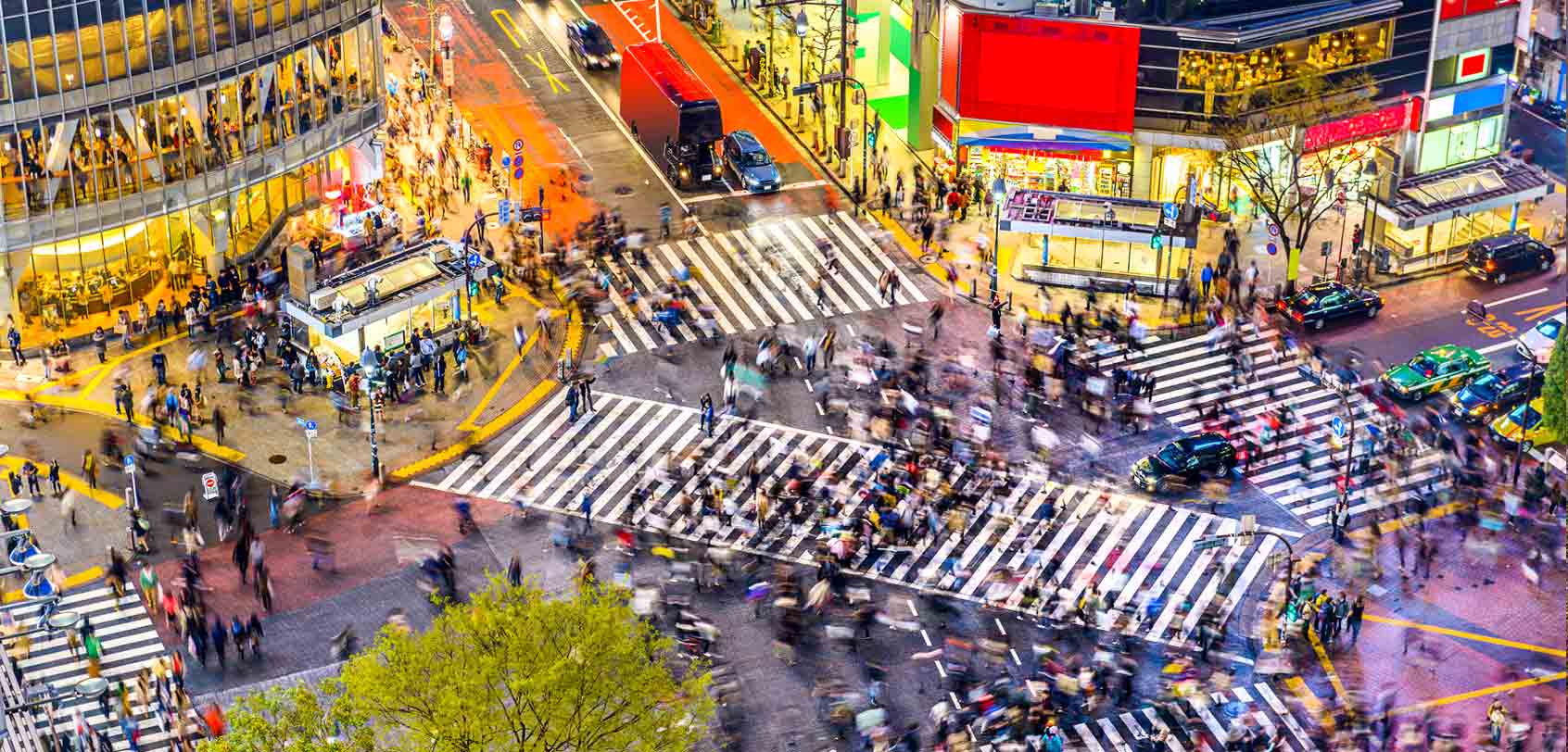
The Tokyo Metropolis is composed of 23 special wards and the city’s top highlights are found in only a few numbers of these wards. For ease of discussion, I will divide Tokyo into two: the west and the east. Below are the west’s top attractions…
SHIBUYA. This is referred to as a major nightlife area but it’s also a major shopping and entertainment venue especially because of its strong youth presence in fashion and culture.
- ★ Shibuya Crossing: Found in front of Hachiko Exit, this is arguably the most prominent landmark of the district and the most filmed spot in the area. If you want to get a good view of it, go to the QFRONT building where a big Starbucks cafe is found. It’s best to come during rush hour to see an impressive sight but be prepared for crowds inside the cafe. Nevertheless, if you want more of a higher bird’s eye view, go to Shibuya Hikarie shopping mall’s Sky Lobby on the 11th Floor.
- ALTERNATIVE : If you want less of the crowd, there’s a bigger statue of Hachiko along with his master, Professor Ueno, at the grounds of UTokyo or the University of Tokyo. .
- Rainbow Karaoke in Modi is incredibly stylish yet cheap, Karaoke Kan is famed for being the location of the movie ( Lost in Translation )’s karaoke scene, or for the more standard chain, Big Echo is a good one.
- Love Hotel Hill: This is where you can find the biggest concentration of love hotels in Tokyo, and though it’s not a typical item on a ‘ things to do in Tokyo ’ list, it can be an amusing thing in itself especially if you’re traveling with your loved one — largely because of how the rooms are delightfully themed. Just be warned though that some love hotels don’t accept same-sex couples or even two foreigners. Nevertheless, you can ‘rest’ in a room for 1-4 hours at around 1,500 yen ($15~) per hour or ‘stay’ in a room overnight for as low as 7,000 yen ($68~). .
- For nightlife: Two of the most brilliant clubs would first be the mammoth super club ageHA with over 4 dance floors, an outdoor pool, and an outdoor dance tent; and second, the laser-filled Womb club with its identifiable giant mirror ball. Better yet, get this Tokyo Nightclub Pass that grants you UNLIMITED entry to the top 7 nightclubs in Tokyo! .
- ★ Don Quijote, Loft, and/or Tokyu Hands: These shops are great to include in your Japan itinerary if you’re looking for cheap souvenirs, novelty items, stationaries, and more!
- Center Gai, Koen Dori, Spain Slope, and/or Shibuya 109: The first 3 are distinct shopping streets in Shibuya, whereas Shibuya 109 is a complex that you don’t want to miss out on if you want to do some serious shopping!
- Shimokitazawa : This nearby district is a great ‘bohemian’ spot if you’re looking for vintage and second-hand items and clothes. .
- Ichiran Ramen: A famous ramen (noodle soup dish) place that gained popularity worldwide because of its solo booth style of dining. Rest assured, the ramen tastes superb here and is worth a try so jot this down on your Japan itinerary!
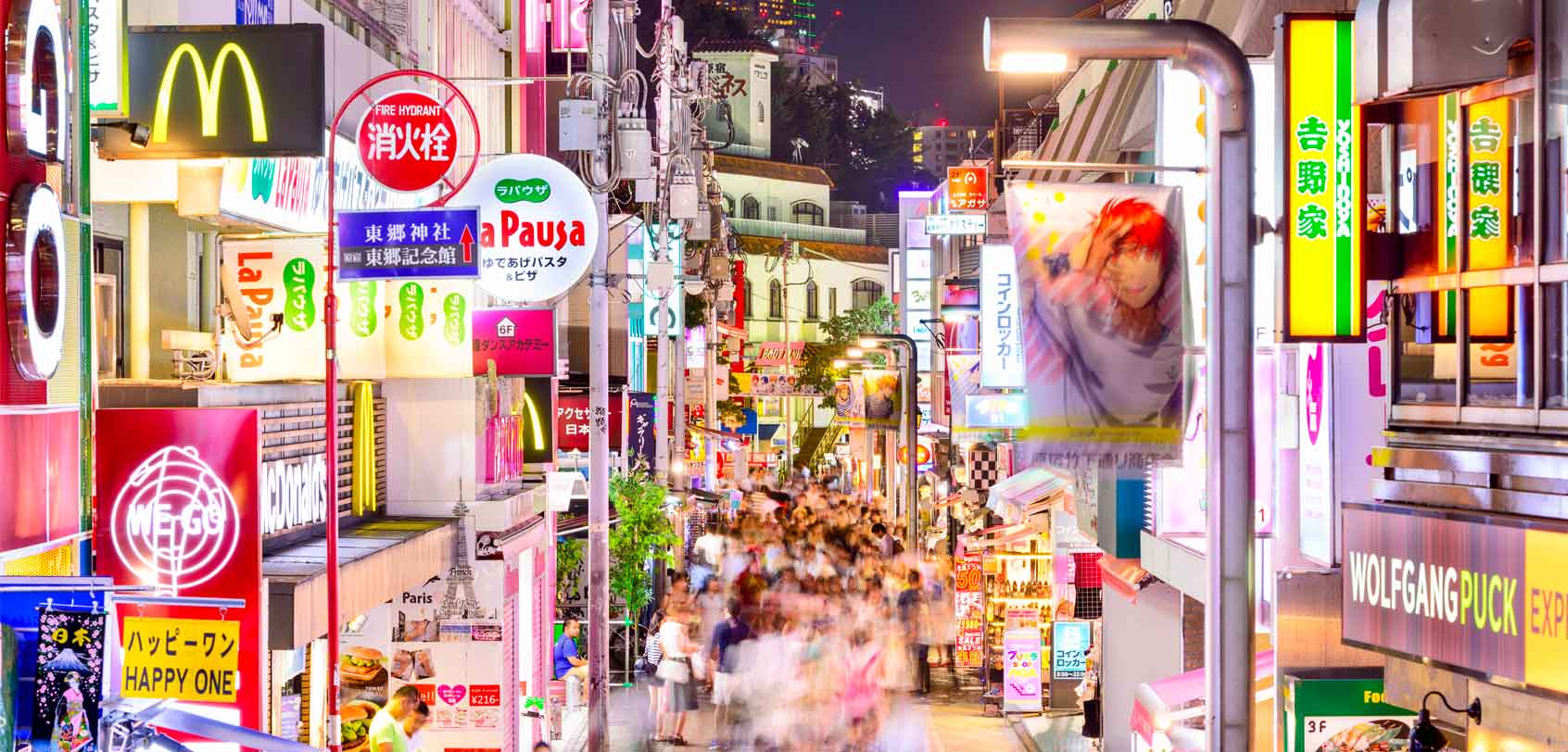
HARAJUKU. Famed for its fashion scene, quirky culture, cosplay shops, and so much more!
- TIP : If you want to witness a traditional Japanese Shinto wedding in which they make a procession to the temple, head here around 10AM and try your luck!
- Yoyogi Park: A typical meeting place for Japanese people from all ‘walks of life’. Since it’s just near the trendy Harajuku, you will normally find crowds of band members, lolitas , cosplayers, and fashionistas in interesting clothing (they’re sometimes concentrated around Jingubashi or the bridge near Meiji Shrine). Taking photos of these people in fancy clothing is perfectly fine, but it’s best if you ask for permission first since not all of them are there to please the crowd — they’re usually just there to hang out or do practices, etc. .
- TIP : Wanna do a guided tour? Take this Harajuku half-day tour that will take you through Takeshita as well as grant you access to some of the district’s top cafes!
- Cat Street: If you want to stray away from Takeshita Dori’s crowd, this is the next best place to be.
- TIP : Drop by Espace Luis Vuitton Tokyo which is found on the top floor of its building to find an amazing art space — not to mention that the bathrooms are really fancy.
- Daiso Harajuku: This is one of Japan’s famous 100-yen variety-store shops that offer affordable housewares, toys, stationery, decorations, bento supplies, gifts, and more!
- Tokyu Plaza Omotesando Harajuku: This is a multi-story shopping center that recently became even more popular because of its kaleidoscope-like entrance that’s made of dozens of tilted mirrors. Don’t miss out as well on its rooftop terrace area on the 6th floor if you want views over Harajuku. .
- Maison de Jullieta: Kawaii (cute) culture is a ‘thing’ among the Japanese and one of those kawaii fashion styles would be the sweet lolita look. In Maison de Jullieta in Harajuku, you can dress up as one — complete with costume, makeup, and hair arrangement at a price of around 10,000 yen ($97~)!
- Kawaii Cafe: In line with Harajuku’s colorful splash of colors and eccentric atmosphere, there exists the Kawaii Monster -themed cafe! With over 5 separately themed areas, the cafe is like a rainbowholic’s paradise where every corner is filled with kawaii decoration and Instagram-worthy scenes.
- ★ Purikura: Purikura runs like a photo booth — but ‘leveled up’ in a Japanese kind of way and it’s widely popular among females. Through these machines, you can take photos of yourself or your friends in a studio-esque booth; after which, you will be digitally enhanced. By that, I mean automatically Photoshopped in a kawaii manner: bigger eyes, whiter skin, and narrower face.
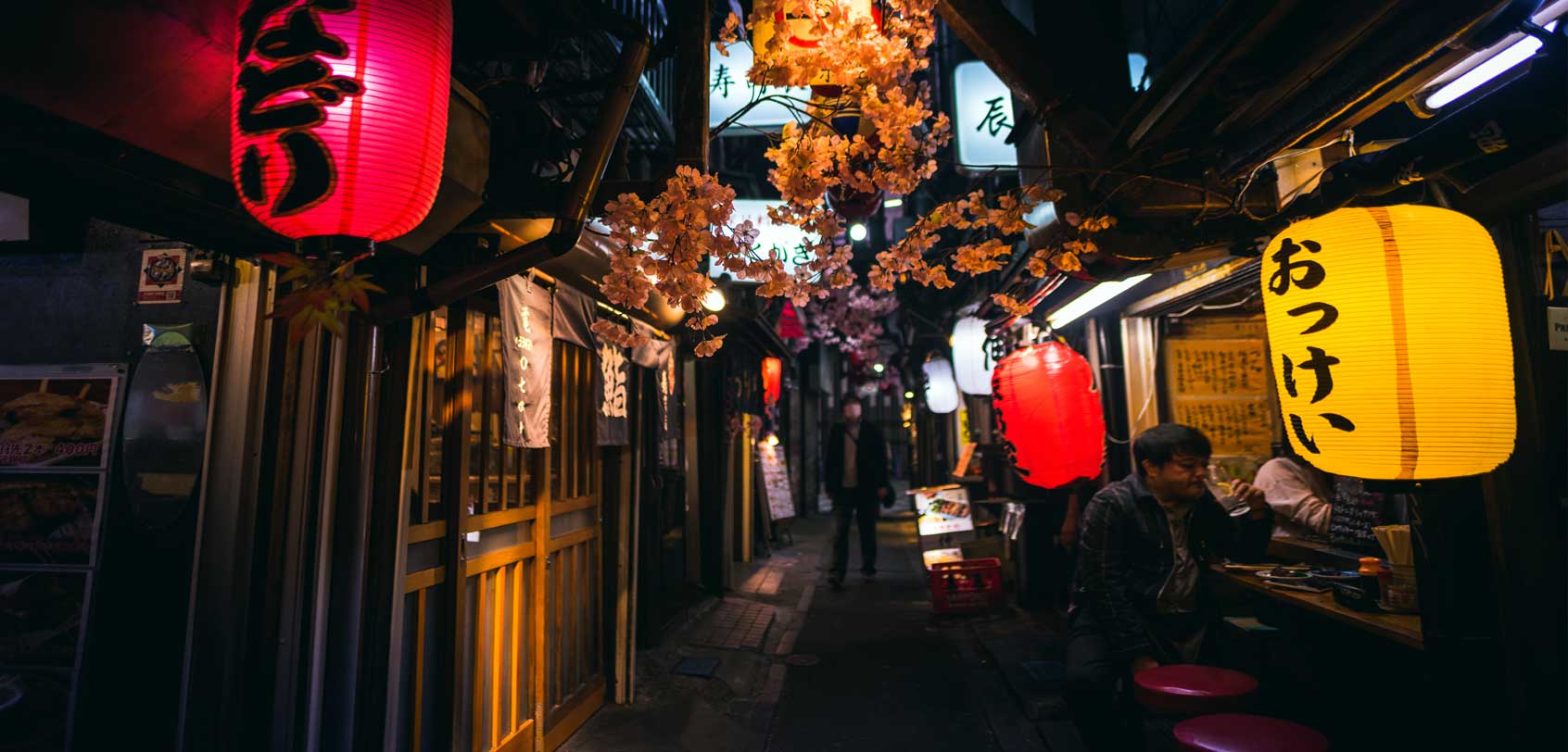
SHINJUKU. As a major city center, Shinjuku has the busiest train station in the world (Shinjuku Station) , it houses the administration center for the Tokyo government, and holds a plethora of amazing things to do in Tokyo!
- Tokyo Metropolitan Government Building: Towering at 243m, this structure has two towers and each of these has an observatory which visitors can visit for FREE in order to get a bird’s eye view of Tokyo. I recommend the southern tower since it shows a better ‘side’ of Tokyo (closes at 5:30PM), whereas the northern tower is best for night shots since it closes later into the night (until 11PM).
- Shinjuku Gyoen: Best visited during sakura and fall season, this place is just a stone’s throw away from Shinjuku station and it is surely one of the city’s largest and most favored parks. Here, you will find three different gardens, a traditional Japanese landscape garden, a French garden, and an English landscape garden.
- Samurai Museum: As a Japanophile , I have also been enchanted by the culture and history of the samurai (or bushi ) — Japan’s notable military warriors. Adults can enter for a fee of 1,800 yen ($18~) in order to see the impressive exhibits; but the highlight of this place is probably the experiences that you can try: photoshoot with basic samurai gear (500 yen $5), sword battle performance with an actor (free), samurai calligraphy lesson (500 yen or $5~), and professional photoshoot with full samurai gear (starts at 32,000 yen or $320~). .
- TIP : Book here for a guided tour so you don’t miss out on anything!
- TIP : For your Japan itinerary, book here for a guided tour so you don’t miss out on anything!
- Kabukicho: This is the entertainment and red-light district in Shinjuku which is sometimes called the “Sleepless Town”. Unlike Amsterdam which features prostitutes on the windows of their buildings, Kabukicho has a more subdued collection as it only includes hostess clubs, love hotels, massage parlors, and more. Unless you want to avail these kinds of services, as a regular tourist, I just find this as an interesting place to see in Tokyo. Rest assured, I felt entirely safe walking around here since it didn’t feel seedy. Truth be told, one particular thing about Kabukicho that I best liked to see or observe was the pachinko parlors. (Pachinko is an insanely popular game in Japan that somehow resembles pinball and since gambling is illegal there, this is the only way that locals can ‘gamble’.) .
- READ : For my experience !
- Godzilla: Japan’s famous giant monster and pop culture icon, Godzilla , can be seen here in Shinjuku atop Toho Cinemas. It’s a nice spectacle because he looks like he’s taking a peak from the building above — seconds away from wreaking utter havoc .
- Animal Cafes: Plenty of people would recommend that you go to Tokyo’s well-liked animal cafés such as those of a cat café, owl café, rabbit café, goat café, etc. (There are lots of them found around Shinjuku such as Cat Cafe Calico, etc. ). I don’t like them though because I’m uncomfortable with the idea of keeping multiple animals in such a small space with strangers that they’re not that accustomed to — but, I leave it up to you to decide what you would do.
◘◘ Day #2 — East of Tokyo
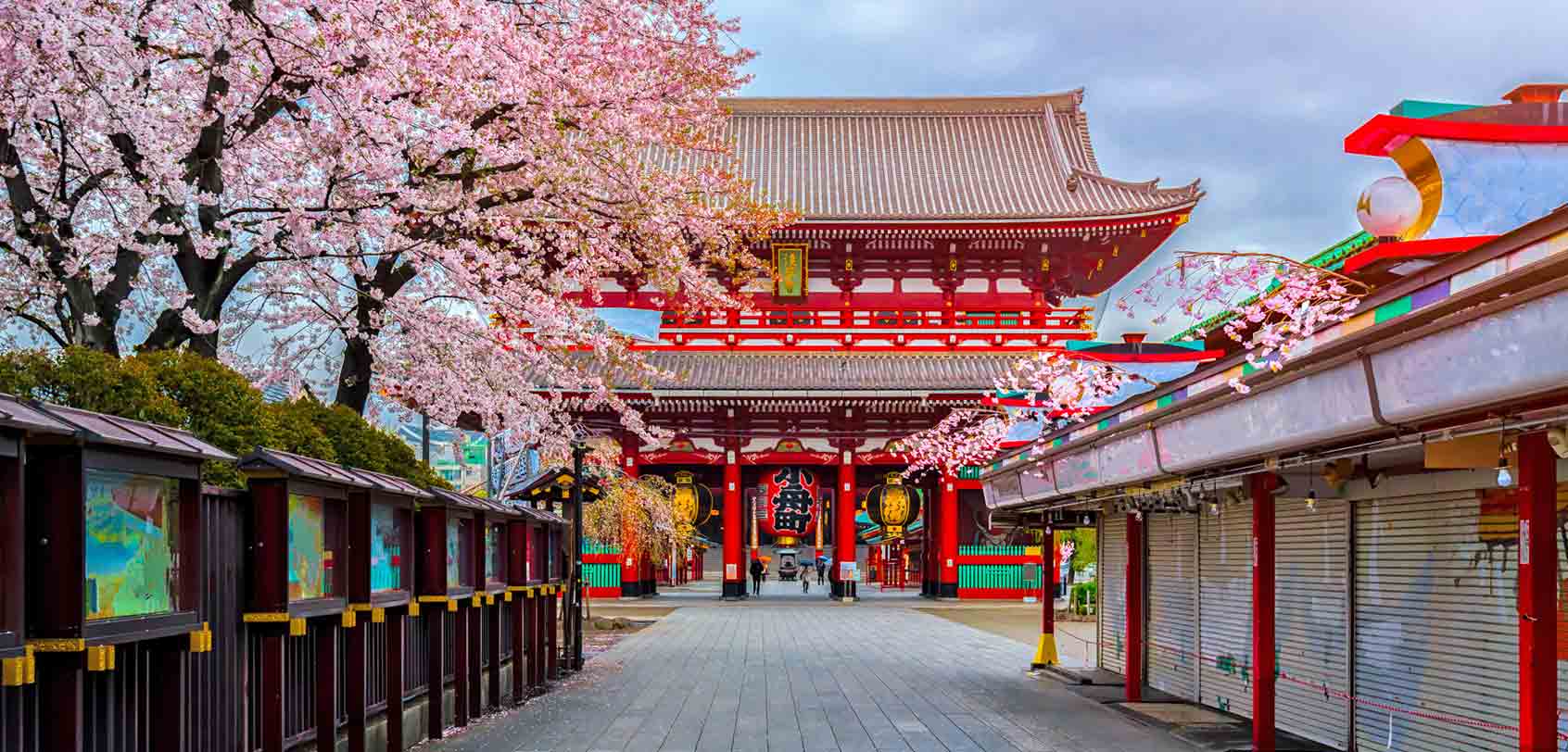
Photo by: Shutterstock
ASAKUSA. This is said to be the center of Tokyo’s shitamachi (“low city”) — which means that it’s an ‘olden’ district where you can get a feel of how Tokyo was in the past decades.
- ★ Senso-ji Temple and Asakusa Shrine: Take note that a shrine is dedicated to the Shinto faith, whereas a temple is dedicated to Buddhism. These two places are the main highlight in Asakusa with Senso-ji being the oldest temple in Tokyo. There is also an impressive “Thunder Gate” called Kaminarimon (which is a symbol of Asakusa and Tokyo) in front of the temple.
- Sumida River and Park: For a leisurely stroll, go over to Sumida River and lounge by Sumida Park which stretches on both sides of this body of water. Like what you’d expect, there are cherry blossoms here that come alive in spring, and then during July on its last Saturday, this becomes a great spot for viewing the Sumida River Firework. (If you see a golden building with an odd golden structure on top that looks like a teardrop, that’s the Asahi Beer Tower with its ‘Asahi Flame’.) .
- Read my kimono rental guide here to learn more about the process.
- Samurai Armor rental: You can take a step further and rent to wear Japan’s famous traditional warrior’s (samurai’s) armor! If you book this activity online , you can even have a professional photographer take photos of you.
- Rickshaw ride: To complete your kimono look, I recommend that you rent a traditional Japanese rickshaw which will take you around key spots in Asakusa.
- To be frank with you, this is a very long ceremony where you will sit motionless for hours as you follow a set of guidelines… but it is a striking example of Japan’s amazing culture that is exceptional for immersing one’s self with. For a good place to try this in, go here .
- Hanayashiki: If you’re up for it, this is said to be Japan’s oldest amusement park (built in 1853). .
- ★ Nakamise shopping street: Stretching about 250 meters from Kaminarimon to the main grounds of Sensoji Temple is this picturesque shopping street with over 50 shops that offer local specialties and the usual array of tourist souvenirs.
- Shin-Nakamise: Also called as “New Nakamise”, this runs perpendicular to the Nakamise Shopping Street and is lined with various shops and restaurants.
- Asakusa Kagetsudo: This is a famous melon-pan store that has been running since 1945. Melon-pan is basically a sweet baked bread with an outer layer that looks like a melon — so it’s just named that because of its appearance and not because it tastes like a melon. When you buy from this store, it is best to eat it when warm.
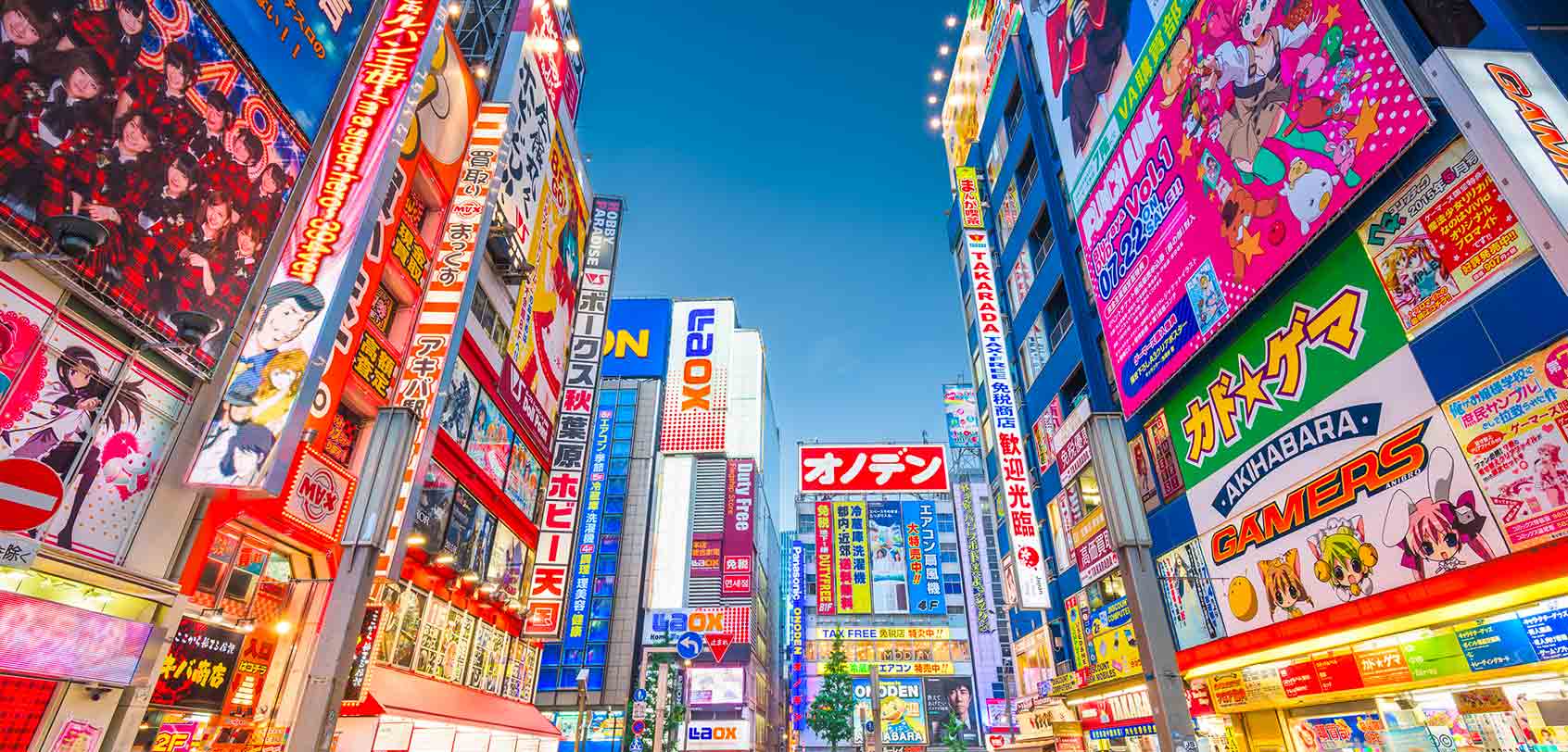
AKIHABARA. Dubbed as the otaku* cultural center and tech shopping district of Japan, walking through Akihabara’s main street called Chuo-dori will already give you an idea of what this district is all about. *Japanese term for people who have obsessive interests commonly towards anime and manga. A synonymous word in English would be ‘geeks’.
You see, Japan may have an amazing olden culture, BUT it has also developed an equally amazing modern culture over the recent years, and it is in Akihabara that you can get a glimpse of this somewhat wacky ‘evolution’.
- Maid cafe: A lot of people in Tokyo love to cosplay — a form of roleplaying where people wear costumes to represent a character (often found in animes and mangas). One of the good ol’ favorites of the Japanese when it comes to cosplaying or ‘dressing up’ is waitresses dressed in those frilly Victorian maid costumes. In line with their ‘character’, they will even act as if they’re servants and then treat others as their masters. Now apply that idea to a café, splash it with small games, a cutesy demeanor, brief performances, and picture-taking with customers and that’s where you get the famed maid cafes of Japan. A great place to try in Akihabara would be @Home Cafe.
- ★ Arcades: We have tons of video game arcades in the Philippines — HOWEVER, they’re not as insanely amazing, bright, exciting, and numerous as what Tokyo has! One of the most known gaming arcades in Tokyo would be Taito Station . (You could also do purikura inside these arcades).
- ★ Go Kart: Come live on the edge and explore downtown Tokyo in a cool Go Kart while you’re dressed in popular cosplay costumes! With this fun driving tour , you can opt to do a one-hour experience or a whole day affair. .
- Yodabashi: If you have time to visit only 1 tech gadget store in the district, then this 9-story building is your best bet! After all, it is proven that their items are usually cheaper than in Europe or even Asia.
- Mandarake or Tokyo Anime Center: Mandarake , a gigantic 8-floor complex that is full of merchandise related to anime and manga, is the best go-to space if you’re a hardcore otaku or at least a knowledgeable one at that; whereas I believe that a visit to the Tokyo Anime Center is best done first by people who have no idea of the otaku scene in order to gain a better understanding of it.
SUMIDA. The most noteworthy attraction that you should visit in this ward would have to be the following:
- Tokyo Skytree: At 634m, this is the tallest tower in the world. It is primarily a television and radio broadcast site for the Kanto Region; but for travelers, you can visit the large shopping complex, aquarium, and planetarium that are located at its base. And of course, for sky-high views of the city, Tokyo Skytree has two observation decks and you can purchase your tickets here .
- Try chanko nabe in any of the restaurants in the neighborhood. This is basically a hot pot dish that is a staple food of sumo wrestlers.
- TIP : To reserve your sumo tickets for Japan’s Tokyo Grand Sumo Tournament, go to this link . For the months wherein tournaments are not held, you can get a close-up look at the sumo wrestlers’ morning fight practices via this tour .
◘◘ Day #3 — Mt. Fuji
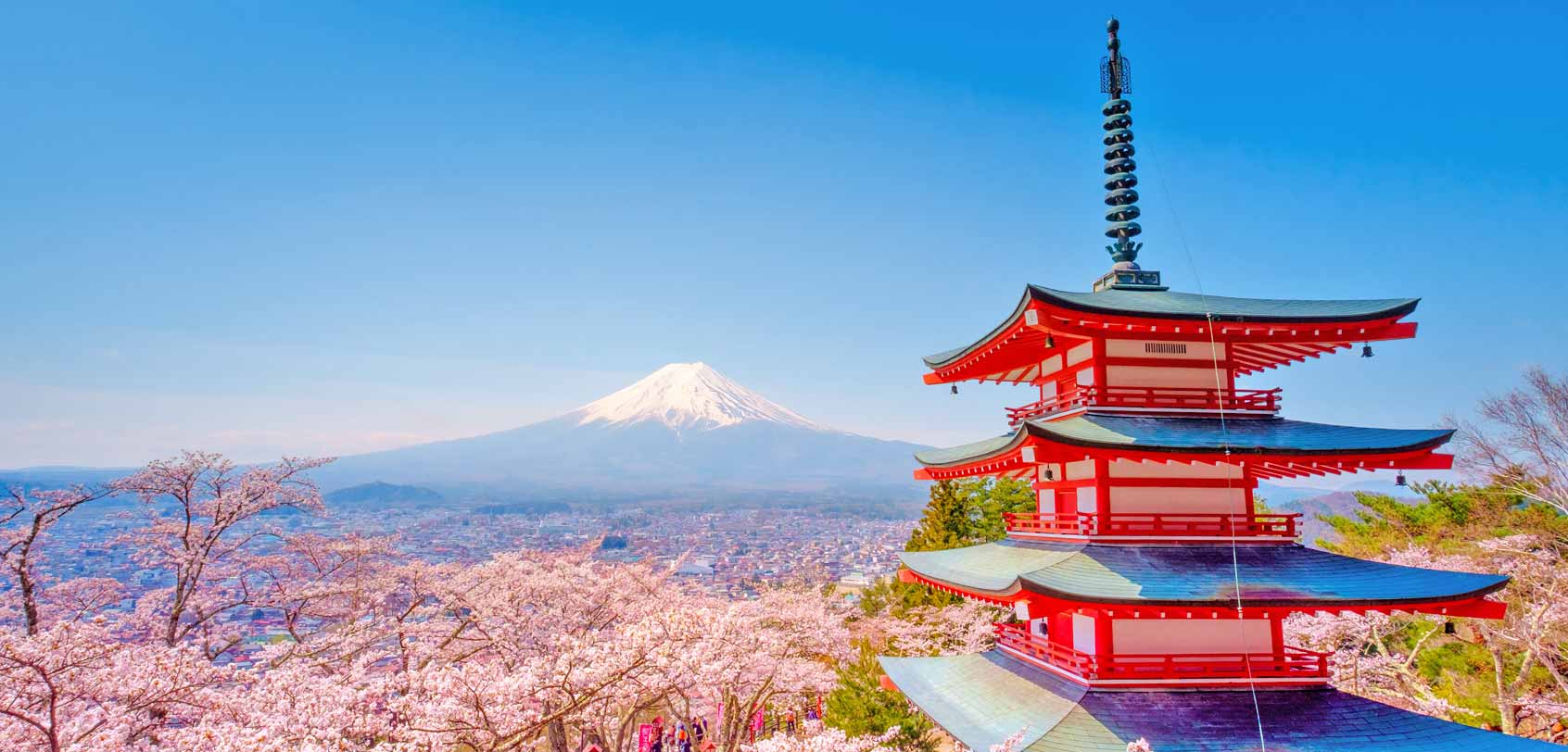
It’s time to check out Mt. Fuji or ‘Fuji-san’ (it’s how the locals commonly call it).
As the country’s tallest peak, it has been considered one of the most iconic sights in Japan so it would be a good idea to dedicate this day to it. There are several ways for seeing this active volcano in all its glory (including riding a Tokaido shinkansen from Tokyo to Osaka if you sit on the right, 40min before Shin-Fuji Station, or going to Fuji Subaru Line 5th Station) but below are the best locations for viewing it.
- Some people do one of the places below as a day trip, while others as an overnight trip to also experience staying in a ryokan (traditional Japanese inn). It’s totally up to you, but naturally, if you’re short on time, making it a day trip would be enough.
- Clouds often block the view of Mount Fuji so you often have to consider yourself lucky if you get a clear view of it. It is said that visibility tends to be better during the colder seasons of the year than in summer. Otherwise, it’s great in the early morning or late evening hours compared to the middle of the day.
- To save up on transportation costs, get a Hakone Free Pass to gain unlimited travel on eight transportation options including the Hakone Sightseeing Cruise (Pirate Ship), Hakone Tozan Train, Hakone Tozan Bus, Hakone Tozan Cable Car, and Hakone Ropeway.
- For a hassle-free experience, you can take a Hakone day tour that already includes a stop at Mt. Fuji and some other interesting activities like a lake cruise and more. Or, you can also do this other Hakone tour . .
- For a hassle-free experience, you can take a Mt Fuji day tour to this lake region with the inclusion of Kachi Kachi Ropeway, fruit picking, and fruit picking.
- A different option is to rather go to Chureito Pagoda (pictured above) which is still part of Fuji Five Lakes but not found within Lake Kawaguchiko. This spot is a favorite among photographers, especially during spring or autumn and it’s easy to see why! (This tour includes this pagoda as a stop) .
For other options and details, you can read my Mt. Fuji tour post!
- For a hassle-free experience, you can do a Kamakura + Enoshima day tour. .
- Enoshima: (1hr from Tokyo) This is a touristic island that offers a variety of attractions (Enoshima Shrine), beaches, parks, an observation tower, and caves (Iwaya Caves). If I say so myself, doing a Kamakura + Enoshima day tour would be ideal if you want to check out both of these towns. .
- Fuji Shibazakura Festival: (2hrs from Tokyo) This is a famous time-limited event that is usually held at Fuji Motosuko Resort from the middle of April to late May. If you have the time, I recommend doing a sakura tour of this festival as it features over 80,000 blooming shibazakura (pink, red, and white mountain phlox flowers) over 6 acres of sloping hills. Pair this off with a great view of Mt. Fuji and it instantly becomes an Instagrammable spot!
◘◘ Day #4 — Other Day Trips Outside Tokyo
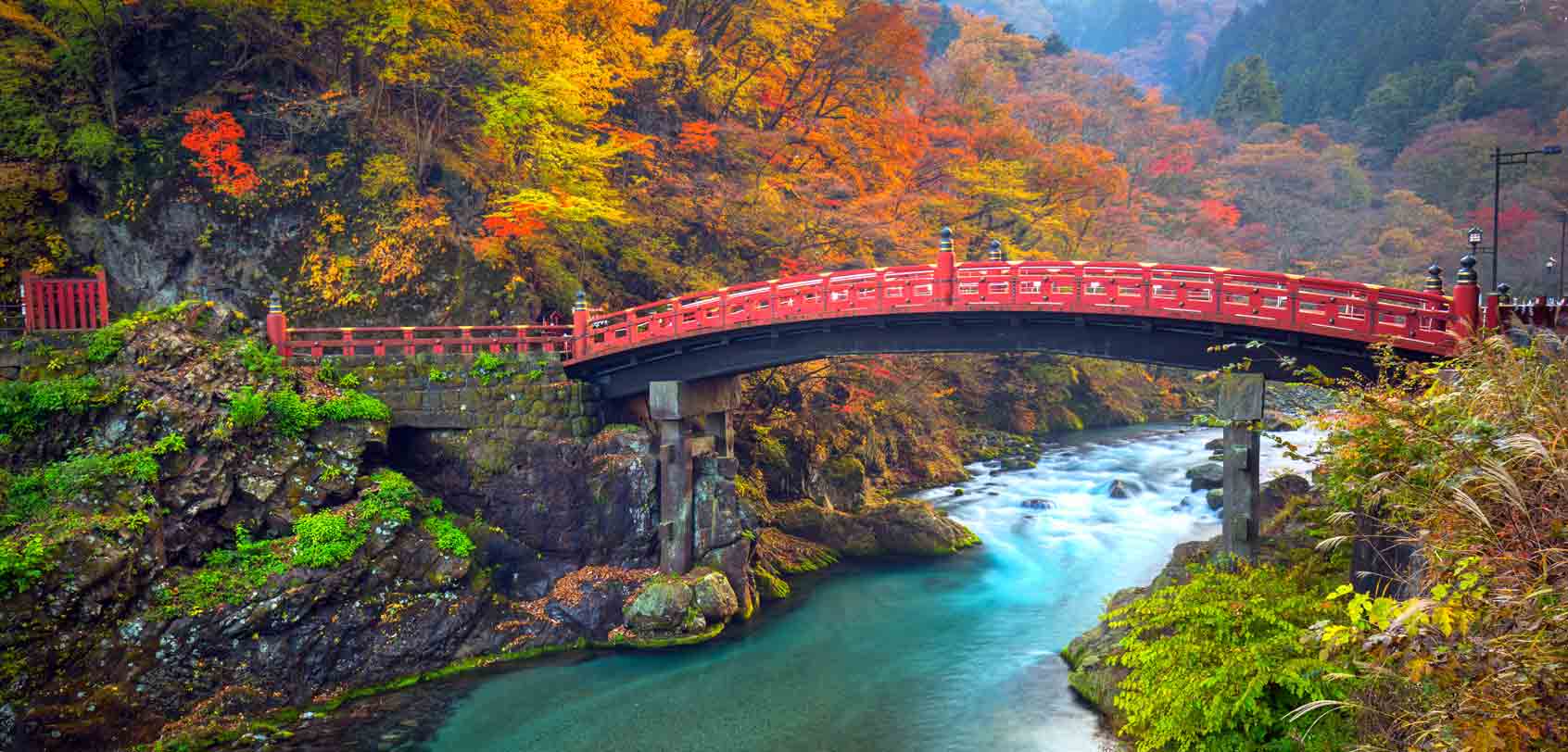
Below are other interesting day trips that you must see near Tokyo!
- TIP: For a hassle-free experience, you can do a Nikko day tour that includes several stopovers. .
- TIP: You can avail of a ‘ Yokohama and Kamakura Enjoy Pass ‘ to enjoy the major sightseeing attractions in these cities. .
- Kusatsu: (3hrs from Tokyo) This is a sound trip to make if you want to visit one of Japan’s most famous hot spring resorts. In fact, Kusatsu Onsen is blessed with large volumes of high-quality spring water which makes it popular among locals and tourists alike. You will love the atmosphere here as you find almost everyone wearing yukata/kimono on the streets. Otherwise, when winter comes, the town becomes a great ski resort to visit. .
- Chichibu: (2hrs from Tokyo) This city is a great place to escape if you want to get away from Tokyo’s bustle. After all, its forested mountains provide impressive nature views and hiking opportunities. One of the most sought-after events here though is its Chichibu Night Festival in December and its Hitsujiyama Park in Spring (for its beautiful pink moss park).
◘◘ Day #5 — …or More! (Tokyo Extra Days)

Naturally, there’s more to Tokyo than the sights I’ve mentioned on days #1 and #2 above. So in order to fill up your Japan itinerary with other activities for your extra days in the capital, below are some considerations that you can make.
WEST OF TOKYO.
- To enjoy the picturesque rooftop views on Mori Tower’s 52nd floor, just book an Observation Deck ticket online .
- Below Mori Tower, you will find a giant spider sculpture called Maman which means ‘mother’ in French. This is made by the artist Louise Bourgeois .
- Tokyo Midtown is yet another building that you can go into if you’re up for more shopping and entertainment.
- During Christmas, head to the area in Mori Tower that faces Keyakizaka Street in Roppongi Hills to see a great view of Tokyo Tower being illuminated by the street lights. Whereas if you go to Tokyo Midtown, you will find the Starlight Garden which has over 280,000 lights that are magically spread out on the grounds!
- ★ Tokyo Tower: At a height of 333 meters, this is like a replica of the famous Eiffel Tower. Made after Japan’s post-war rebirth, this used to be the country’s tallest tower — until Tokyo Skytree was made in 2012. Despite this fact, the tower’s prime location is still a splendid place to see a panoramic view of the city. There are 2 observatories here: the main one at 150m high and the special one at 250m high. The entrance is at 900 yen ($9~) for the main observation deck and 1,600 ($16~) yen for both decks. To book your tickets, go here .
- Nightlife: Clubs and bars in Roppongi can be a dizzying encounter for a first-timer; so it’s actually preferable if you visit this with a local. Otherwise, just a bit of advice: avoid the men (generally African men) who would try to push you into going to their clubs! More often than not, those are seedy ones, and later on, they might even overcharge you. For the best clubs to go to, I suggest Jumanji55 , V2 Tokyo , or Club Brand Tokyo which all have a good mix of locals and foreigners. Better yet, get this Tokyo Nightclub Pass that grants you UNLIMITED entry to the top 7 nightclubs in Tokyo! .
- Hie Shrine: You don’t need to travel all the way to Kyoto to witness a Shinto shrine with multiple iconic red torii (traditional Japanese gate) because you can find this right in the heart of Tokyo! (Otherwise, there’s also a similar one called Nezu Shrine).
EAST OF TOKYO.
- Imperial Palace: This is the main residence of the Emperor of Japan and it’s actually a massive park surrounded by moats. It contains buildings including the palace, private residences of the Imperial Family, offices, museums, and more.
- ★ Chidorigafuchi: Located just at the northwest section of the Imperial Palace is this moat section. This area is highly recommended during sakura season as it is one of the best spots for hanami (cherry blossom viewing). To add: they regularly light up the trees at night during that period and then you can even rent boats there!
- Tokyo Central Railway Station: This is the busiest railway station in Japan in terms of the number of trains per day and it’s quite a sight to see! For starters, you’ll instantly find this building because of its red brick appearance — a look that survived from when it was first opened in 1914. .
- DiverCity Tokyo Plaza: This is a dining, entertainment, and shopping complex which also features attractions related to the famous Gundam anime series. Truth be told, it also has a life-size Gundam statue in front of its building.
- Fuji TV Area: This is called such because of how the Fuji TV Building (one of Japan’s biggest TV stations) towers above everything else. As a visitor, you could definitely go into Fuji TV’s observatory deck that’s located in the circular portion of the establishment. Other things to see around here would be the shopping mall of Decks Tokyo Beach and the scenic Rainbow Bridge (which looks dashing at night, and where you can also find a replica of the Statue of Liberty.)
- TeamLab: Yet another Instagrammable attraction, this interactive museum is well-known for digital and light art, and to book your tickets, just go here .
- The Soho: This is an Instagram-worthy office building that’s famed for its color-blocked hallways.
- ★ Oedo Onsen Monogatari: If you can’t afford to go to a hot springs resort town, this is the next best thing for your Japan itinerary! This is basically a hot spring theme park that emulates the atmosphere of the Edo Period. You can enjoy various types of indoor and outdoor baths, restaurants, massages, games, and other entertainment while wearing a yukata (traditional Japanese wear). To reserve tickets for this, go here .
- ★ Tsukiji Market: Fish is a big business in Japan and the Tsukiji Market is a marvelous point for observing this lively industry as well as tasting its fresh produce. To date, this market has been divided into two, one of which is still found near Tsukiji Shijo Station and the other near Odaiba. If you want a guided day tour here, book an experience here . .
- TIP: Make the most of this area’s local flavors and drinking spots by doing a ‘ Tokyo After 5 ‘ tour!
- If you want the best ‘festive’ experience on this street, I suggest walking through here on weekends from 12PM to 5PM (until 6PM from April to September) because it is customarily closed to automobile traffic — an event known as ‘Pedestrians’ Paradise’.
- Depachika: This is a combination of the words depato (department store) and chika (basement). In Japan, most of the big department stores such as that of Mitsukoshi have their basement floor made into some sort of food market — but actually, if I have to describe it myself, I will call it a ‘food theme park’ because you can get to have a fun yet quick introduction into the VAST variety of Japanese food there — including square watermelons and insanely priced strawberries! Anyhow, the stalls are very generous with giving away samples too; so if you’re on a budget, you really don’t have to buy something (though it will be respectful to do so, naturally).
OTHERS (NEAR TOKYO)
- To book discounted tickets, reserve your spot here. .
- To book discounted tickets, reserve your spot here.
Kyoto Itinerary & Side Trips
Kyoto used to be the capital of Japan — nevertheless, it has retained that former glory with its great historic value alongside countless temples, shrines, gardens, imperial palaces, and traditional wooden houses among many others.
If I may add, this is also the city that is well known for its formal traditions most especially that of the geisha (or geiko ) who are Japan’s famed professional female entertainers. For these reasons and more, this is important to include in your Japan itinerary.
Looking for top sakura locations in Kyoto?
Check out this ultimate guide to Kyoto cherry blossom spots — from lesser-known locations to the most popular ones!
RELATED READ: Best Cherry Blossom Spots in Kyoto Best Hotels in Kyoto
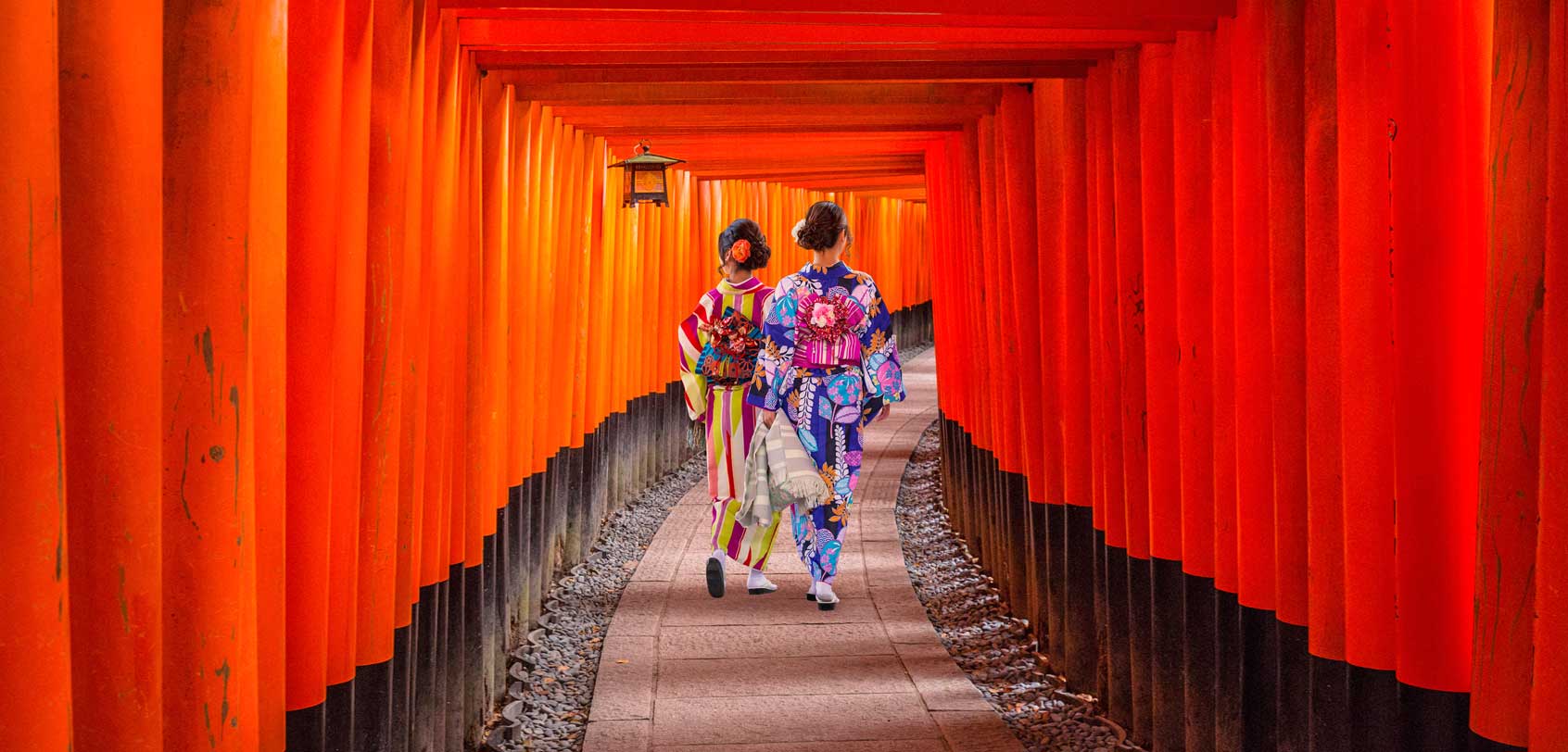
Take note that it takes around 3 hours by bullet train (shinkansen) to get to Kyoto from Tokyo. With that said, the ‘things to do’ for this day of your Japan itinerary should be fewer, but depending on your arrival time, it’s still possible to do a lot. Go and pick from my suggestions below…
- Nijo Castle: Also called Nijojo , this is the former residence of the first shogun (military dictator) in the Edo Period during his stays in Kyoto. Today, this castle is divided into 3 areas: the Honmaru (main circle of defense), the Ninomaru (secondary circle of defense), and the gardens. What’s great about the castle grounds too is that there are over 400 cherry blossom trees so it is quite a sight during the spring season. (Admission is 600 yen).
- Nishiki Market: Known as “Kyoto’s Kitchen”, this is a long yet narrow shopping street that features over 100 lively shops and restaurants. This is a great spot to visit for your Japan itinerary if you want to buy any fresh produce or Kyoto specialties. As a market with a long history, this is also a great place to mingle with the locals.
- Kyoto Imperial Palace: This great expanse used to be the residence of Japan’s Imperial Family until 1868, when the capital was moved to Tokyo. Given that this is within the Kyoto Imperial Park, it makes for a leisurely stroll to go through the space which is full of ponds, gardens, and weeping cherry trees. (Admission is FREE).
- Manga Museum: If you’re fascinated by Japan’s manga (comics) culture and history, this could be a quaint stopover for your Japan itinerary. Sometimes there are even artists who set up exhibits and offer sketches or portrait drawings of the visitors. (Admission is 800 yen).
- For a hassle-free experience, you can do a guided Fushimi-inari tour that includes a Sagano Train ride and a visit to Arashiyama.
- Pontocho: This is a dining area that’s packed with restaurants offering a wide range of choices from local to foreign cuisines. Take note though that most establishments open from around 5PM to 11PM only. If you come in the warmer seasons, most of the places build temporary platforms over the river for open-air dining (called kawayuka ).
TIP : If you want a hassle-free experience for your Japan itinerary, you can take a guided Kyoto morning tour or afternoon tour to key places in the city.
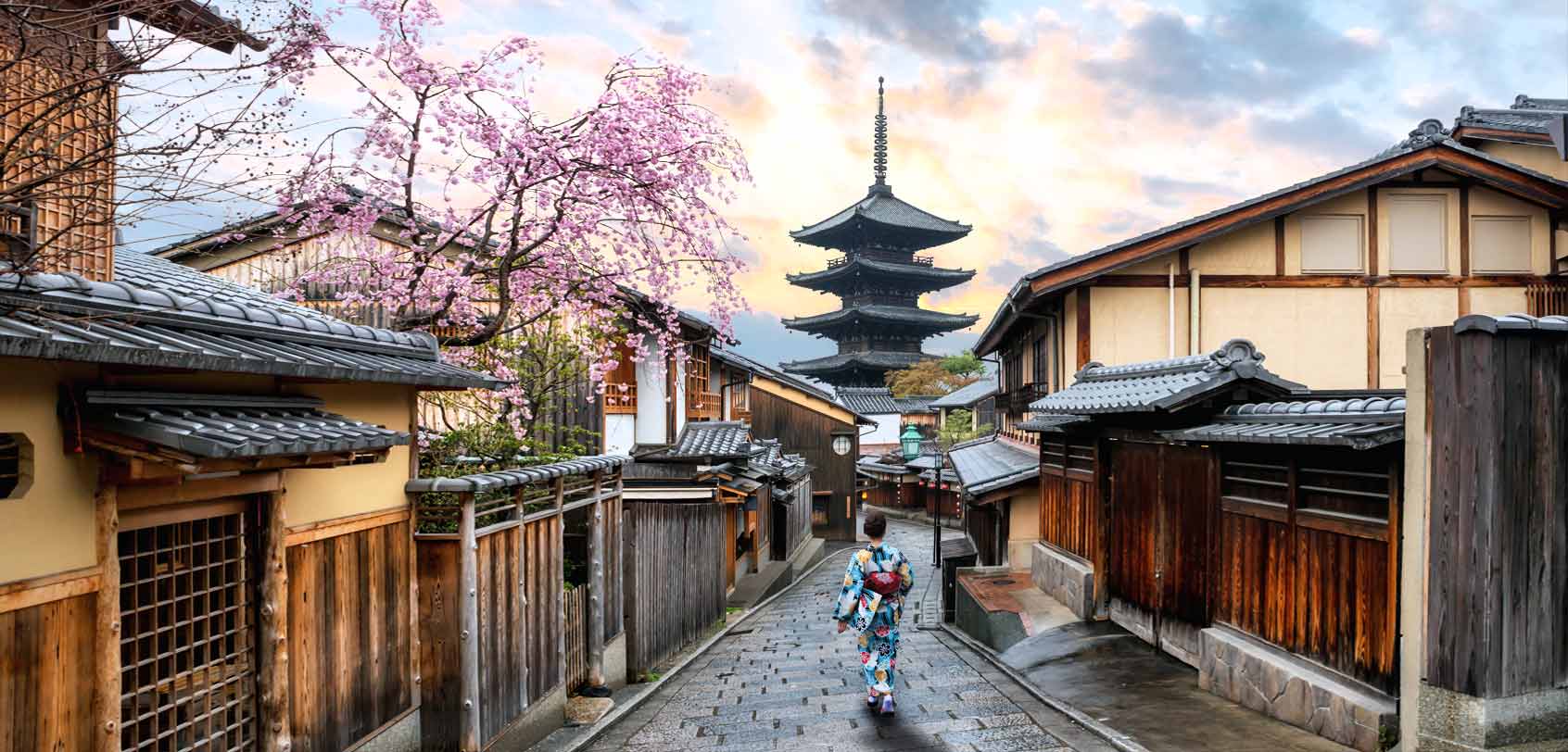
Time to make full use of this day in exploring Kyoto’s other important sights!
In my opinion, though it is possible to do all of the sights below in one day, it’s still a good idea to pay heed to the time especially if you plan to do a Kyoto kimono rental too because it will lessen your hours of exploration (given that putting on a kimono takes some time).
- Kiyomizudera: This is a famous temple in Kyoto that’s listed under the UNESCO World Heritage and it is best known for its wooden stage that stretches out to the hillside as it offers great views over the cherry and maple trees below it — so imagine how the site will be like during spring or autumn! (Admission is 400 yen).
- Other streets to check out in the district are Sannenzaka / Sanneizaka and Ninenzaka.
- ★ Kinkaku-ji: Lauded as the ‘Golden Pavilion’, this is — indeed — a structure that’s mostly covered in gold leaf. This Zen temple actually used to be the retirement villa of a shogun. Today, you would absolutely enjoy its impressive architecture as it overlooks a picturesque pond. Before leaving, don’t forget to go through the gardens and check out Sekkatei Teahouse to enjoy some matcha tea and sweets. (Admission is 400 yen).
- Ginkakuji: On the other hand, though this is referred to as the ‘Silver Pavilion’, it’s not really in silver — it never was. Many believed that it garnered its name after the building was built to contrast the Golden Pavilion. Either way, this remains to be a popular spot for many.
- Philosopher’s Path: This is a pleasant stone path (near Ginkakuji ) that is a must to visit during cherry blossom season . Its name was derived from Nishida Kitaro, one of Japan’s most famous philosophers, who used to practice meditation while walking this route.
- Hanami-koji Street and Shirakawa Area: The most popular places within Gion, so don’t forget to wander around here.
- ★ Gion Corner: Ideally, one of the ultimate experiences in Kyoto is to dine with a maiko or geiko, but since this is often expensive and exclusive, the next best thing you can do to ensure that you witness a real maiko or geisha is to visit Gion Corner. Aimed at foreign visitors, this place offers cultural shows that introduce traditional Japanese arts such as the tea ceremony, ikebana, bunraku, Kyogen comic plays, and maiko dances.
- Shijo Avenue: Bisecting Gion district is a popular shopping area that sells local souvenirs and gifts.
- Gion Matsuri: This is the festival of Yasaka Shrine and it is said to be the most famous festival in Japan! Therefore, if you happen to be in Kyoto in the month of July, you’re in for a treat because they celebrate during the whole month (with the highlight being July 17 as they do a grand procession of floats called Yamaboko Junko).
TIP : Wanna join a guided tour to the geisha districts for your Japan itinerary? Click here !
Kimono rental: Much like Tokyo, Kyoto has a lot of kimono rental shops too. If you only have the budget to do one kimono experience, I highly recommend doing it in the unique atmosphere of Kyoto than in Tokyo’s Asakusa! Another option is to do an oiran ( courtesan ) rental or photoshoot at Studio Esperanto .
◘◘ Day #8 — …or More!
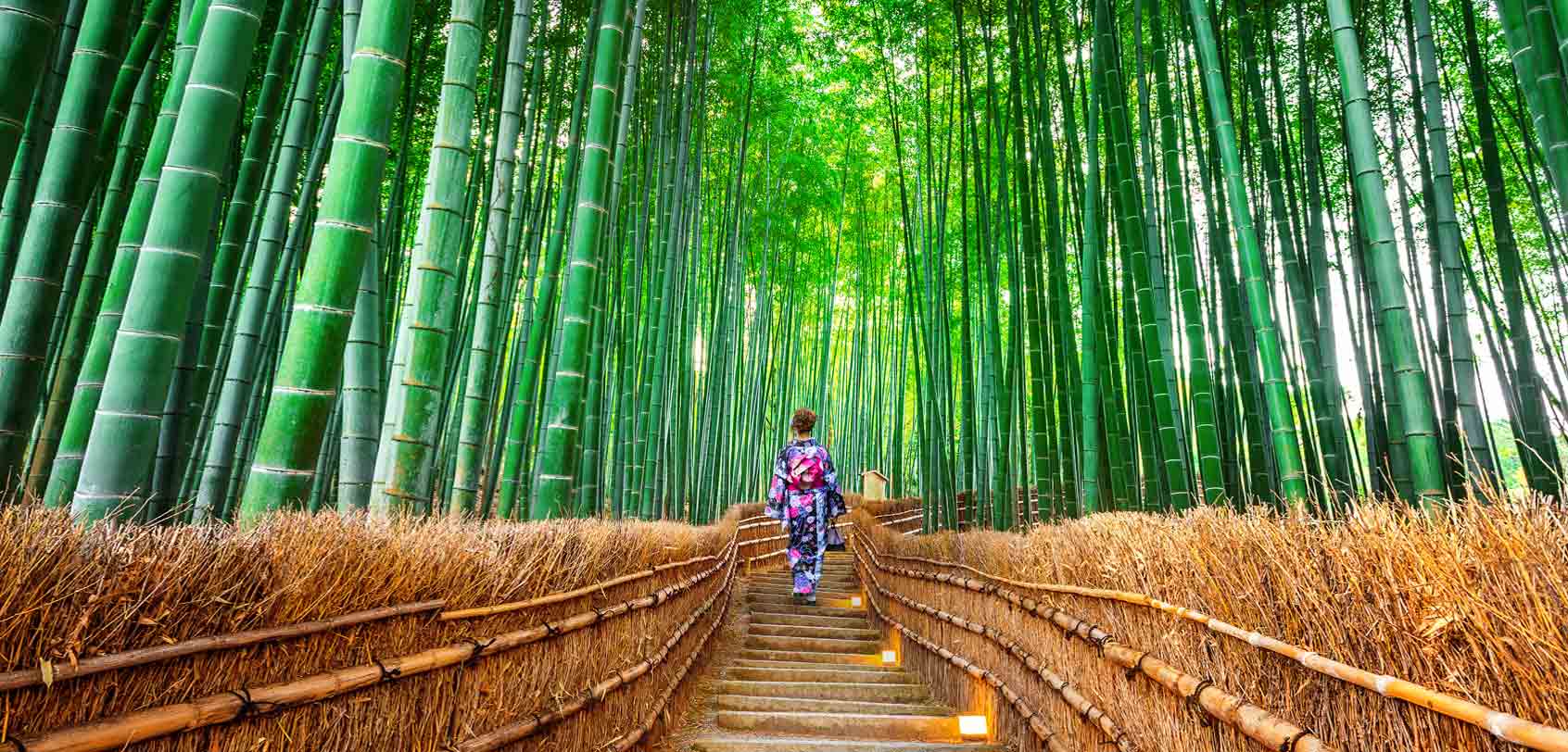
Arashiyama is particularly popular during the spring and autumn season — nevertheless, it’s a year-round destination due not only to its close proximity to Kyoto but also to its natural setting! In order to make the most of your Japan itinerary, don’t forget to check out the following Arashiyama highlights…
- Bamboo Groves: I’m sure you’ve seen photos of this place and it is famous for a reason: it really makes for a nice scenic walk or bicycle ride! If you happen to have the budget to rent a kimono in this area as well, then it is a must to take photos on this path. To avoid the crowd, I recommend coming in the early morning.
- Togetsukyo Bridge: Translated to ‘Moon Crossing Bridge’, this is an iconic landmark within Arashiyama due to how it is backdropped by the forested mountains. There is even a park by the river which is speckled with cherry trees.
- Monkey Park Iwatayama: The entrance to this park is found south of the Togetsukyo Bridge. Be wary that it’s a bit of an uphill climb — but which only spans for about 10 minutes. In this place, you will love the fact that there are over a hundred monkeys roaming freely in the open area. I particularly loved my experience here as I also fed the monkeys from a designated area. To add, this is also a great vantage point for panoramic views over Arashiyama. (Admission is 550 yen).
The center of the district is quite compact so I suggest taking your time strolling around. Other places of interest that you can check are Tenryuji Temple and Saga-Toriimoto Preserved Street. (Want a guided Arashiyama tour packaged together with Nara for your Japan itinerary? Check out this tour . Otherwise, you can also just take a half-day tour that will only focus on the top sights within Arashiyama.)
Or, you can also do this other Arashiyama tour from Kyoto with a Nara stopover for your Japan itinerary.
If you still have some more time, there is an option of doing the Sagano Scenic Railway which is a sightseeing activity on an old-fashioned train. Most people usually take a guided tour for this which is partnered together with a tour around Arashiyama. If not, you can just simply buy a one-way ticket .
◘◘ Extra or Substitute Activities in Kyoto

Got some more time for your Japan itinerary? Check out these other places…
- ★ Daigoji Temple: A designated UNESCO World Heritage Site that is hugely popular especially during autumn or springtime due to its picturesque surroundings. Sure enough, with its beautiful grounds, landscaped gardens, hiking trails, and so much more, it instantly makes for a worthy destination for your Japan itinerary.
- Toji Temple: This is yet another one of Kyoto’s many UNESCO World Heritage Sites and what’s notable about this temple is its 5-storied pagoda which is said to be the tallest pagoda in Japan.
- Shojuin Temple: This has risen to popularity among young females in Japan primarily because of its Instagrammable heart-shaped window called an ‘ inome ‘ window in its guest hall. What’s more, the temple’s ceiling has beautiful pieces of splendid patterns. (Admission of 400 yen).
Osaka Itinerary (including Nara)
Osaka has the 2nd largest metropolitan area after Tokyo and as a part of the Kansai region, it is best known not only for its grand shogunate castle but also for its nightlife and street food. Truth be told, this is a quintessential stop for your Japan itinerary!
RELATED READ: Best Cherry Blossom Spots in Osaka Best Hotels in Osaka
◘◘ Day #9 (Nara)
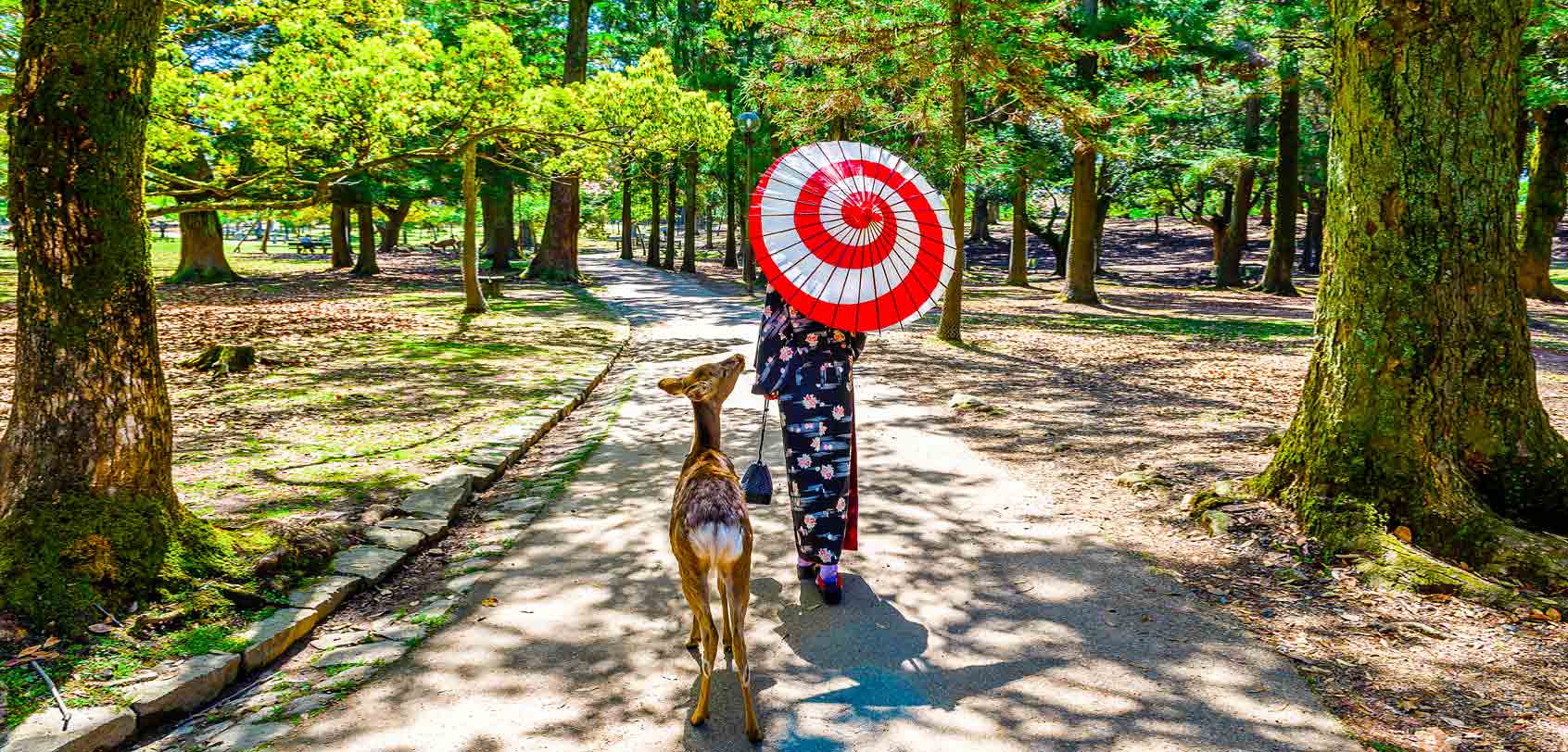
For your Japan itinerary, take note that it only takes about 1 hour by train to get to Osaka from Kyoto. After you check in to your Osaka accommodation , venture out on a day trip to the nearby district of Nara (which only takes less than an hour). If you’re not up for that, you can interchange this with day #10.
Nara is the first permanent capital of Japan, after which it was moved to Nagaoka, later to Kyoto, and then to Tokyo. Today, this district is famous for its historic treasures and adorable deer park.
- TIP : Try bowing down to the deers and oftentimes, you will find that they bow back! It is said that back in the olden times, the locals bowed down to them as they were (like I said) regarded as messengers of God. For generations, they have retained this Japanese custom especially when they expect some food.
- ★ Todaiji Temple: Found adjacent to Nara Park, you’ll first enter this temple’s towering Nandaimon Gate with fierce-looking statues that represent the Nio Guardian Kings. This is followed by the main hall, the Daibutsuden (Big Buddha Hall) which is the world’s largest wooden building housing one of japan’s largest bronze statues of Buddha.
- Horyuji Temple: This is one of the world’s oldest surviving wooden structures and a designated UNESCO World Heritage.
TIP : It’s possible to take a guided tour to Nara from Osaka (with a stop to Arashiyama included in it too). Alternatively, if you want to focus on this city only for your Japan itinerary, you can also just take a focused Nara tour .
If there’s still time, head on over to the nearby Mount Yoshino — even more so if you’re in Japan during its sakura season. Besides, this is regarded as the country’s most famous cherry blossom spot given the 30,000 cherry trees found on its slopes! Truth be told, Mount Yoshino together with the nearby Mount Koya and Kumano have been designated as a cultural UNESCO World Heritage Site since 20014.
Wanna stay a night or more? Check out these top best hotels in Nara grouped from budget to luxury places to stay.
◘◘ Day #10+ (Osaka)
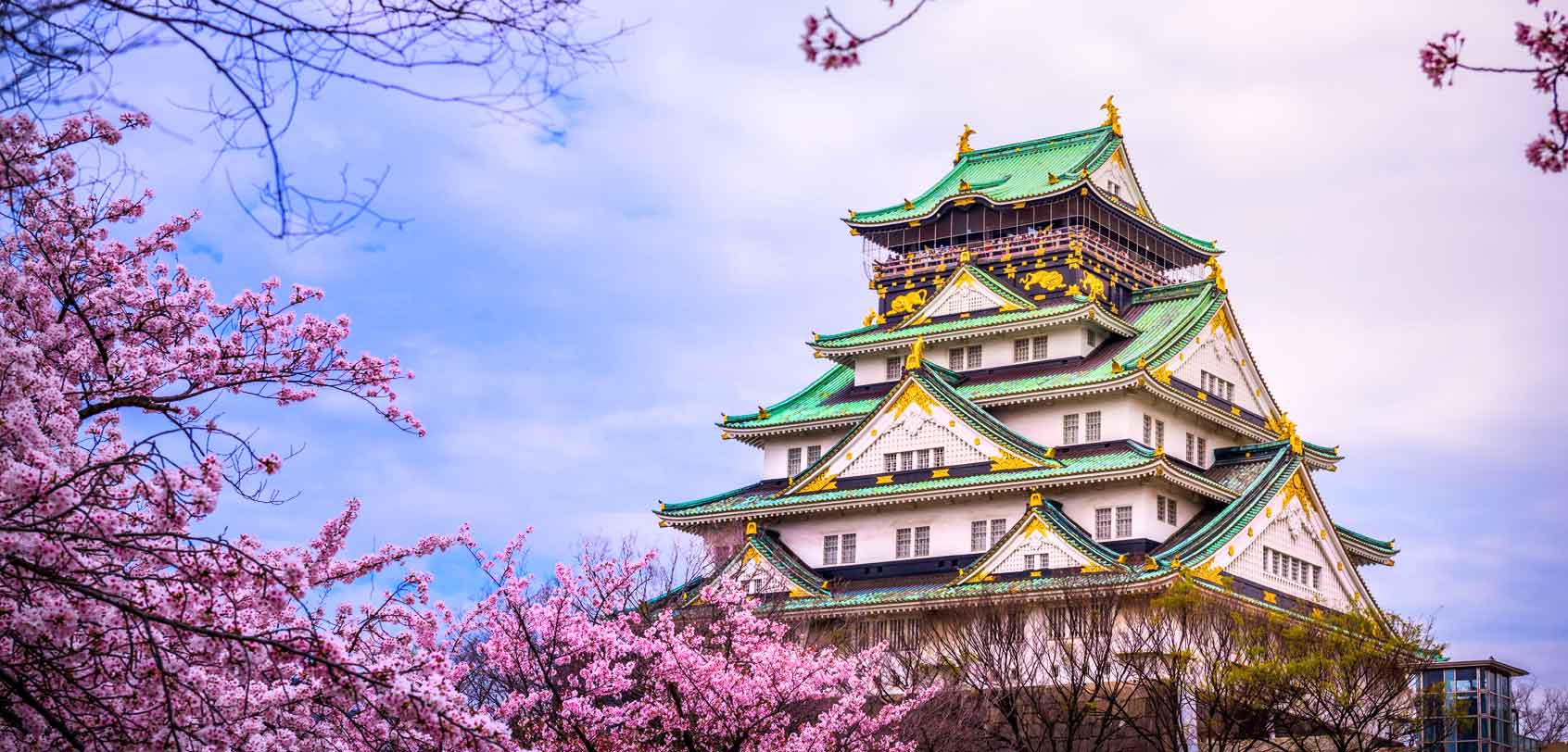
For this part of your Japan itinerary, t’s time to explore Osaka’s top wonders, namely…
- Beside it is the Nishinomaru Garden with over 600 cherry trees with an admission of 200 yen.
- TIP : Don’t miss out on the cool photo opportunities on the long escalator that leads to this observatory! In the basement of the building, you’ll also find a restaurant floor that emulates the early Showa Period of Japan.
- If you see a long line, don’t hesitate to line up too because most of the time it means that it’s a pretty good place! (Of course, if you don’t mind waiting).
- Shinsaibashi Shopping Arcade: This nearby area is Osaka’s premier shopping center that combines retail stores, boutiques, department stores, etc.
- Hozenji Yokocho Alley: This narrow path has a number of interesting restaurants and izakaya (informal Japanese pubs) that are somewhat reminiscent of Kyoto’s Pontocho alley.
- Shinsekai: If you want a less crowded version of Dotonbori, this is the place to go to for your Japan itinerary. Notable here is the Tsutenkaku Tower (the symbol of the district) and the kushikatsu (an Osaka specialty of various battered deep-fried foods)
TIP : Want to save time for your Japan itinerary? Take a guided Osaka walking tour or a food tour !
Are you rather looking for a fun and quirky way to explore Osaka? Then come and join a Go Kart experience and race through the city!
◘◘ Extra or Substitute Activities in Osaka
- For greatly discounted tickets, book online : ( standard E-ticket /+ express pass 3 , express pass 4 , or express pass 7 ).
- Hirakata T-SITE: This is a commercial complex near Hirakatashi Station that has beautiful architecture. Inside it is the famous Tsutaya Bookstore which has over 150,000 books and which also has become a recent hit on Instagram for its charming interiors.
- Osaka Aquarium: This is an incredible aquarium that displays over 15 tanks, each representing specific regions of the Pacific Rim. For instance, the central tank that represents the Pacific Ocean is 9 meters deep and is home to a whale shark which is the main attraction of the aquarium! ( Reserve your tickets here ).
Hiroshima Itinerary & Side Trips
This is the city that was largely destroyed back when an atomic bomb was dropped over it during World War II. Great efforts were taken to rebuild the city and today, Hiroshima is well known for its aspirations of tranquility with its Peace Memorial Park and if I must say so myself, this is a must for your Japan itinerary.
RELATED READ: Best Cherry Blossom Spots in Hiroshima Best Hotels in Hiroshima
◘◘ Day #11 (Hiroshima)

Please take into account in your Japan itinerary that it takes more or less 3 hours to get to Hiroshima from Osaka. Once here, below are landmarks that you can include on your…
- Peace Memorial Museum: Comprises of 2 buildings that go through the history of the city and the events that happened after the nuclear bomb. When I visited here, most of the exhibits were upsetting — and for good reason because they wanted to serve as a reminder of how we should never take peace for granted.
- A-Bomb Dome: This is what remains of the former Prefectural Industrial Promotion Hall. When the bomb exploded, this is one of the few buildings that still stood and remains so today. (This is also a listed UNESCO World Heritage Site).
- Cenotaph: This is an arched tomb dedicated to the A-Bomb Victims who died. Underneath it is a stone chest that holds the register of their names that number over 220,000. On the anniversary of the bombing, a ceremony is held at the park every year along with an observed silence at 8:15AM (the exact time of the bombing).
- Hiroshima Downtown: This is a bustling downtown area with Hondori Street as its main feature. As you venture about this place, do try the city’s specialty which is the Hiroshima-style okonomiyaki — a delicious savory pancake containing various ingredients.
- Hiroshima Castle: This was destroyed by the atomic bomb in 1945 but it was rebuilt and nowadays, it holds exhibits about the castle’s history as well as Japanese castles in general.
TIP : If you don’t intend to stay a night in Hiroshima, you can take a day tour to this city — which will already include a trip to Miyajima. (Starting points for your Japan itinerary can be from either Kyoto or Osaka ).
◘◘ Day #12 (Miyajima)
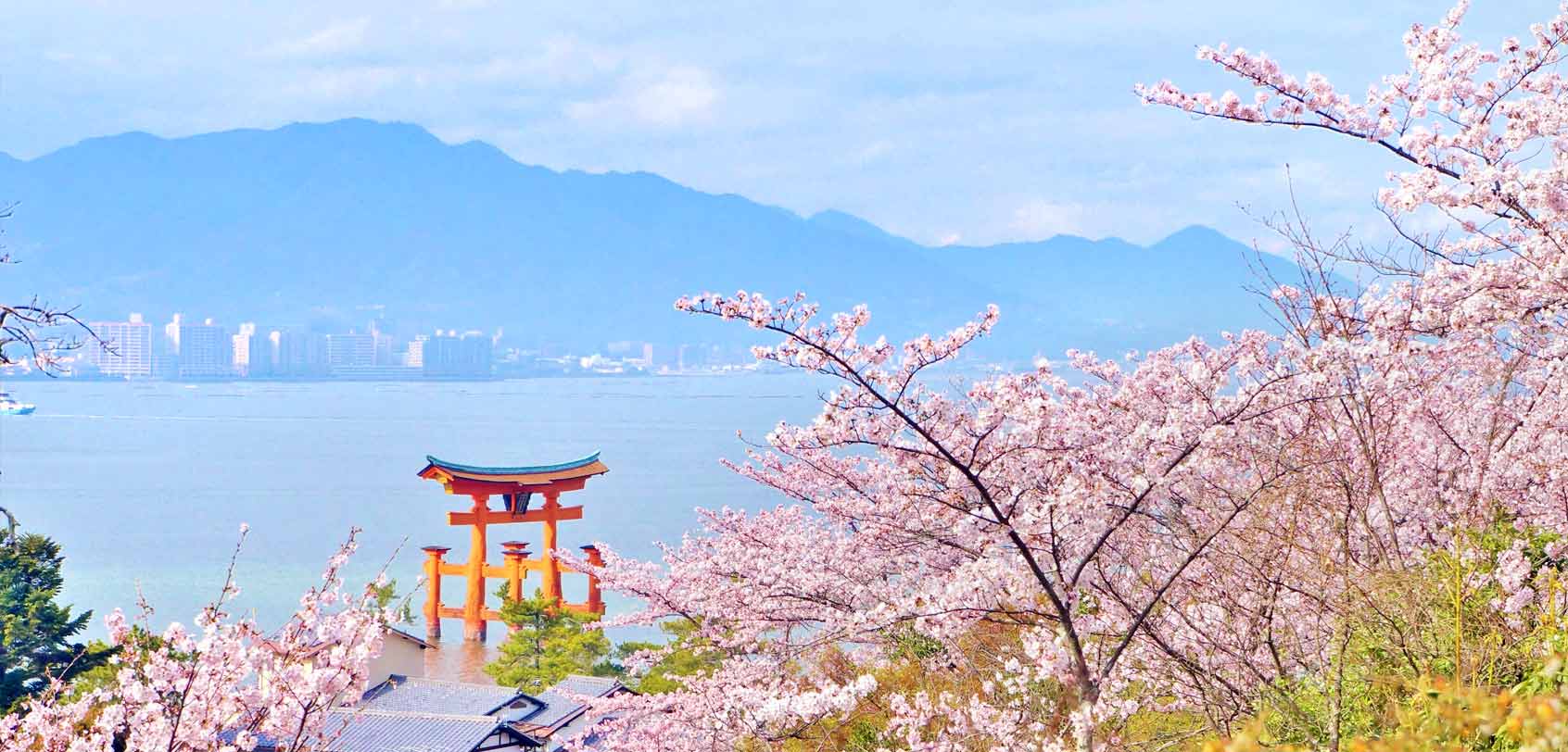
Just a 1-hour ride away by train and ferry from Hiroshima is the small island of Miyajima. It’s particularly famous for its giant torii gate that seemingly floats on the water during high tide — making it one of Japan’s best views. Most people do this as a day trip for their Japan itinerary but you could also stay overnight to experience a ryokan (traditional Japanese inn).
- If you want the best view, be mindful of the timings of the tides during your visit. High tide is obviously when it is most picturesque, but the low tide has its charm too because then you can walk up to the gate and see it up close.
- Momijidani Course: shortest but also the steepest and goes mostly through the forest.
- Daisho-in Course: offers the nicest views and is not as steep as the other two.
- Omoto Course : any of these 3 hiking trails takes about 1 to 2 hours to reach the summit.
- Daisho-in Temple: Found at the base of Mount Misen. There is an interesting Buddha ritual here wherein as you walk up the temple steps, you spin the metal wheels with inscribed sutra as it is believed to have the same effect as reading them.
- Omotesando: This shopping street is the busiest place in Miyajima where you can find souvenir shops, food stalls, and restaurants. Why not do some shopping here while doing your Japan itinerary!
Other Destinations & Trips
Obviously, there is more to Japan other than the famous destinations of Tokyo, Kyoto, Osaka, Nara, and Hiroshima. So if you have more days on your Japan itinerary, consider filling it up with any of the following destinations!
TIP : For a complete list of amazing tours and activities to do for your Japan itinerary, see here ! When booking, use code AILEENKLOOK to get 5% off!
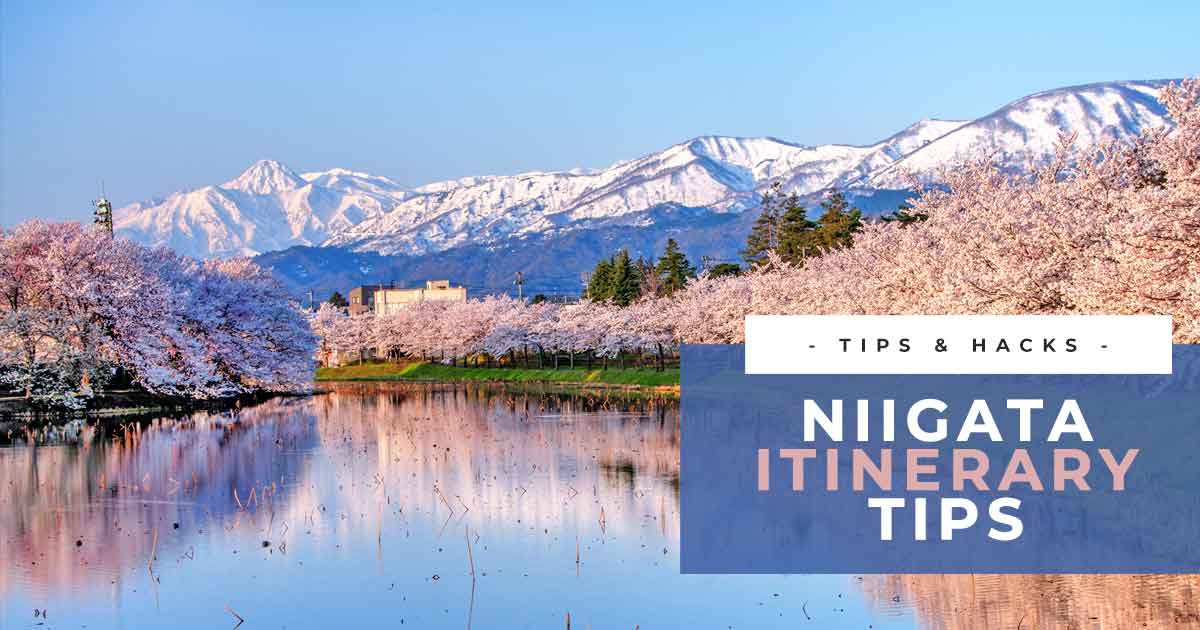
Niigata Itinerary

Chubu Itinerary
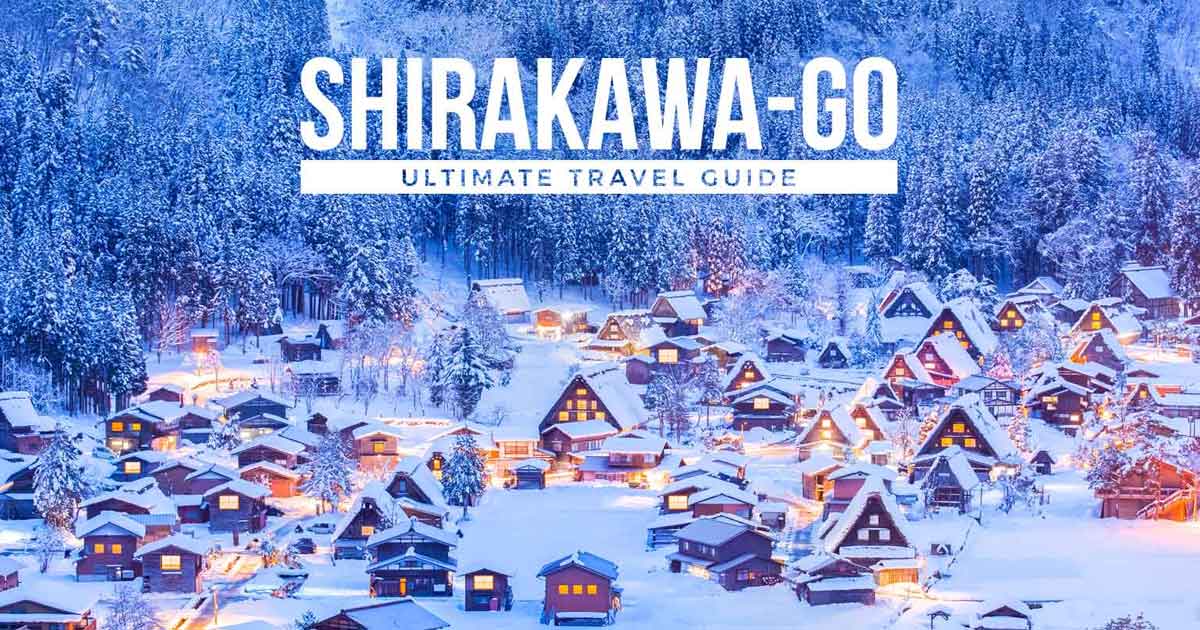
Shirakawa-Go
Tateyama Kurob Alpine Route
◘◘ Day #13 and Onwards
(My favorites are marked with a ★).
NORTH OF JAPAN.
- See here for a list of things to do in Hokkaido . .
- READ : Niigata Prefecture: A New Japan Foodie Destination! .
- Nagoya: Also found within the Chubu region is Nagoya which is known for its towering castle. Other notable sites are as follows: Korankei, City Science Museum, Atsuta Shrine, and Railway Museum. For food, check out Sekai no Yamachan , a famous izakaya (Japanese pub) in the city that serves flavorful “legendary chicken wings”. .
- Kanazawa: This is the capital of the Ishikawa prefecture and it boasts historical attractions as well as its ‘ Kenrokuen ‘ — said to be one of the 3 best landscape gardens in Japan. .
- Kiso Valley: Nestled within Nagano prefecture is this valley that holds an ancient 70km trade route called Kisoji which was later on combined with other routes forming the 500km long Nakasendo . Today, nearby post towns of Magome, Tsumago, and Narai are flocked by visitors not only to hike through the Nakasendo but to also revel in the traditional stone paths and wooden buildings of these quaint towns. Truly an interesting addition to your Japan itinerary! .
- READ : Things to do in Matsumoto .
- For more info, read here . .
- READ : Things to do in Takayama
- Tateyama Kurobe Alpine Route: If you’re up for incredible and unique nature activities in Japan, it’s a MUST to visit the stunning mountain sightseeing route that’s commonly referred to as the “Roof of Japan”. A crowd favorite as of late is its grand ‘Snow Wall’ that’s open from mid-April to late June! For more info, read here . .
- You can do this as a day tour from Nagano .
- Shibu Onsen: An old-fashioned hot spring town
- Shiga Kogen Resort: The largest ski resort in Japan.
Wanna see cute and fluffy foxes? Then go and visit the famous fox village in Miyagi Zao’s city of Shiroishi for your Japan itinerary! . Check out this blog post to find out more: The Fluffiest Place on Eart: Miyagi Zao Fox Village!
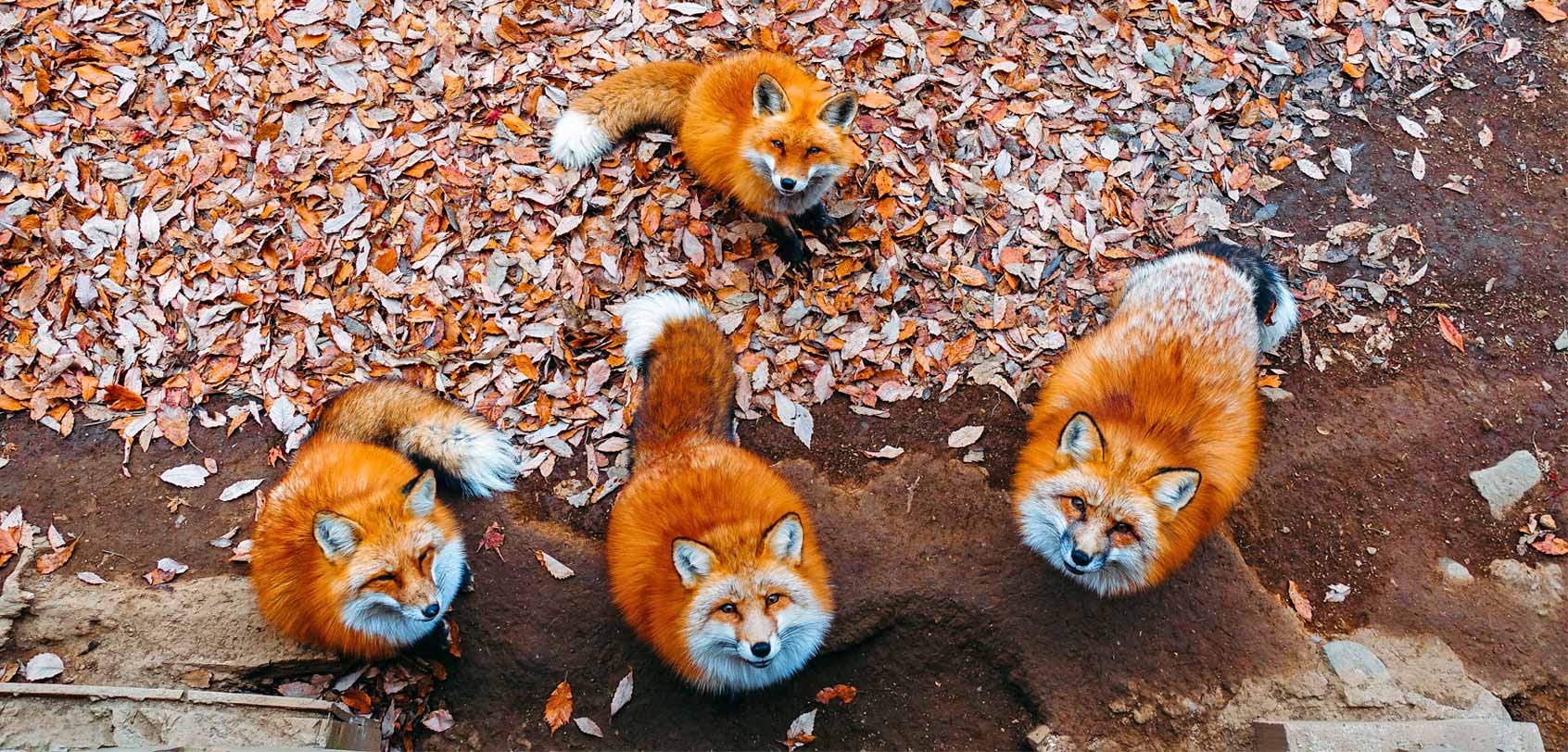
SOUTH OF JAPAN.
- ★ Kinosaki: Located about 3 hours away from Kyoto, this is a pleasant onsen town that has a great atmosphere. I stayed here before for 2 nights and I loved strolling around the town in my yukata and geta (wooden clogs), feeling like a local! After all, everyone (locals and foreigners alike) who visit the town almost always wears the same attire when going about the place onward to the public baths. .
- See here for a list of things to do in Okinawa . .
- Himeji: This place is most famous for its Himeji Castle which is typically considered to be Japan’s most beautiful surviving feudal castle. Because of this, it is both a UNESCO World Heritage Site and a national treasure that you must see for your Japan itinerary. .
- See here for a list of things to do in Kobe .
Booking Essentials

TIP: It’s a good idea to crosscheck the prices with other popular travel insurance providers like World Nomads and HeyMondo (as my reader, you get 5% off)! . However, take note that a travel insurance’s affordability typically means lesser coverage; so please always ensure that you read the fine print in order to decipher which travel insurance company is the right fit for you and your trip!
The Best Tours in Japan?
Come and check out this list of the top things to do in Japan which features the best activities and tours to do in Tokyo, Okinawa, and more!

There really is SO much to see in Japan! …But I believe that my travel guide here is already a good start. Please feel free to tweak this itinerary and make full use of my extra activity suggestions in order to make your trip shorter or longer and better fitting for your travel style.
Enjoy and do let me know how your trip goes!
Have you seen my latest vlog?

Hey there! I am Aileen Adalid. At 21, I quit my corporate job in the Philippines to pursue my dreams. Today, I am a successful digital nomad (online entrepreneur, travel writer, & vlogger) living a sustainable travel lifestyle.
My mission? To show you how it is absolutely possible to create a life of travel no matter the odds — and I will help you achieve that through my detailed travel hacks, guides, resources, tips, and MORE!
Follow Along
CURRENTLY BASED IN: The Philippines
- 100k Followers
- 51k Followers
- 80k Followers
- 10k Followers
- 23.1k Followers
Trending Now
Visa application tips: 4 important things to get you approved.
Increase your chances of getting that approval — here are the 4 topmost important visa application tips to remember when you’re applying!
Elegance on the Water: The Ultimate Mekong River Cruise Experience for the Discerning Traveler
Here’s why you should put a Mekong River Cruise high up on your bucket list for your upcoming Asia adventures!
Best Hotels in Cebu: From Cheap to Luxury Accommodations and Places to Stay
Explore the best hotels in Cebu — from luxurious five-star resorts, cozy boutique stays, to budget-friendly hostels!
EU261 Compensation: Your Essential Guide on European Flight Delays or Cancellations
Learn to claim EU261 compensation for flight disruptions like delays, cancellations, downgrades, or denied boarding!
Find out the BEST and safest countries for solo female travelers to go on adventures to — as well as the 5 most dangerous destinations!
Latest Posts
Learn Today
How to start a successful blog, 70 comments.
I want to go back there so much! Loved it
This really is a comprehensive guide to Japan. It has everything you would need to know about Japan and how to plan the perfect itinerary.
we are planning to visit Japan next year and this is very helpful
Thanks for sharing this useful article about Japan itinerary, it will so great holiday :)
Do I need JR Pass if I travel to Hakone? My whole trip is just 5 days.
I guess that would mean you’ll mostly base yourself in Tokyo? If so, I don’t think you’ll need a JR Pass — but to be more precise you can read my article here: https://iamaileen.com/japan-rail-pass-guide/ . It has a link to a calculator site there that can calculate if having a JR pass is worth it or not for your route. Hope that helps!
Submit a Comment Cancel reply
Your email address will not be published. Required fields are marked *
Be notified of follow-up comments by email
Submit Comment
Pin It on Pinterest

The Perfect 14-Day Japan Travel Itinerary for First Timers
By: Author Kris
Posted on Last updated: May 28, 2024
Are you planning a 14-day trip to Japan? You came to the right place. Japan is a fascinating destination that has much to offer.
But when you have just 2 weeks in Japan you will have to make choices.
That’s why we compiled this 14-day Japan travel itinerary based on the highlights and the things we loved the most during our Japan itinerary.
We want to inspire you with this 2 week Japan itinerary and hope you will love your Japan trip as much as we did.
There is a really good chance that this post contains affiliate links. If you click one of them, we may receive a small commission (for which we are deeply grateful) at no extra cost to you.
Table of Contents
Tip: Be sure to become a member of our brand new Japan Travel Planning and Tips Facebook group . The purpose of this group is to help you plan an amazing vacation to Japan. You can ask questions and exchange tips with fellow travelers.
Japan Essentials
We almost always find the best flights to Tokyo and Osaka on Momondo . It may be worthwhile to compare these with Skyscanner and a new but promising flight aggregator, WayAway .
Don’t lose time upon arrival at the airport and order your Japan travel SIM or portable WiFi device in advance so that it’s ready and waiting for you at the airport when you arrive.
Find out which JR Pass will save you the most for your trip to Japan.
Check out our ultimate Japan travel blog where you can find many more interesting Japan articles to prepare for your trip.
Need help with your Japan trip planning? Check out this post on how to plan your trip to Japan.
Japan Travel Planner
If this is your first Japan trip, we totally understand if you’re feeling a little overwhelmed with your travel planning. There is so much to see and to do and Japan’s train network is excellent but at the same time very different from what most of us know from our home country. That’s why we created our Japan travel planner . A document that will help you with all the details of your travel plan. Follow the link for the full details .

Our Japan Itinerary For 14 days
Day 1-2: tokyo.
Most international flights will take you to Tokyo so this is where you’re 2 weeks in Japan adventure starts.
- 5 days in Japan
- 7 days in Japan
- 3 weeks in Japan, the perfect itinerary for first-time visitors.
Getting from the Airport to Tokyo
When somebody is referring to Tokyo International Airport they refer to Haneda airport but in reality, Tokyo has 2 international airports: Haneda and Narita airport.
The general rule is that Narita is the airport for low cost carriers while premium connections are grouped at Haneda. But even if you don’t fly low-cost, you have a good chance of arriving at Narita. Narita handles 3 times as many international flights than Haneda. Domestic flights are mostly leaving from Haneda.
In reality you will notice that there isn’t really any logic in how the flights are divided between the 2 airports. Because there are not enough landing slots in Haneda, ANA sometimes has to look to Narita when it adds extra weekly flights to a certain destination. As a result the flight from Washington arrives in Narita on Wednesday, Thursday, and Sunday and on Haneda on the other days of the week.
Which of the 2 airports is best for you as a passenger? Probably Haneda because it is closer to the city. It takes less time to get from the airport to the city and it is also cheaper.
Below is additional information about both airports.
Haneda International Airport
Haneda International Airport is located 14 kilometers south of Tokyo Station. It is the oldest of the two airports.
It used to mainly handle domestic flights after Narita airport opened but with the addition of a new international terminal in 2010, it now handles most business routes while Narita focuses more on leisure routes.
The two main ways to reach central Tokyo from Haneda Airport are the Keikyu Line and the Tokyo Monorail. Both require a transfer to the JR Yamanote Line to reach major stations in central Tokyo.
Depending on the location of your hotel and the length of your flight (and the amount of sleep you could get) you might not be looking forward to train and subway rides in your first hours in Tokyo.
After a long flight, a direct transfer from the airport to your hotel will be a lot more comfortable.
You can find more information about a shared transfer here:
Shared Transfer
Private Transfer
Narita Airport
Narita is the smallest of the 2 airports but it is the gateway to Tokyo for many international tourists.
It lies 60 km east of central Tokyo. Although it is located further from central Tokyo it is also well-connected to the city. Compared to Haneda, you even have more options.
There are plenty of public transportation options to reach central Tokyo from the airport. You could take the JR Narita Express, the Keisei Skyliner, buses and taxis. Those who like to make a grand entrance can even choose for a helicopter transfer.
The JR Narita Express
The JR Narita Express , abbreviated as N’EX, is covered by the Japan Rail Pass. This makes N’EX your best option if you have a JR Pass.
To use this train with your Japan Rail Pass you need to exchange your voucher for the actual pass at the airport.
Once exchanged you will also need to reserve seats as N’EX is one of the few trains that only has reserved cars.
Japan Rail Pass is it worth it?
The Keisei Skyliner
The Keisei Skyliner is a good alternative to N’EX if you have no Japan Rail Pass.
The prices, the comfort and the train schedule of both trains are comparable.
The main difference is that N’EX will take you to Tokyo station, Shinagawa, Shibuya, Shinjuku, Ikebukuro & Yokohama. The Keisei Skyliner heads to Nippori station and Keisei Ueno (close to Ueno station).
Both trains offer easy transfer to the JR Yamanote Line, the main loop line in Tokyo.
As with Haneda, you can also book private or shared transfers from Narita to central Tokyo.
Find more information about a shared transfer here: Shared Transfer
or you can opt for a private transfer here: Private Transfer

Getting Around in Tokyo
If you have a japan rail pass.
If you have a Japan Rail Pass you can use this pass on the JR trains that run on the inner-city network in Tokyo, a very extensive network that can be compared with a metro network.
If You Don’t have a Japan Rail Pass
If you don’t have a Japan rail pass or you choose to activate your Japan rail pass after your visit to Tokyo, a Tokyo subway pass might be a good alternative. You can buy this pass at tourist information centers, BIC camera shops, and certain hotels.
There’s a list of selling points on the Tokyo Metro website . Be sure to bring cash as credit or debit cards are usually not accepted.
The pass can also be bought online which is even more convenient.
When you buy your pass online you will receive a voucher that you can use to quickly and easily collect your pass at the airport and seconds later you will be on your way to your hotel. Your pass can be used immediately, so you can use it if you would have to change to the metro en route to your hotel.
Click here to read reviews and buy your Tokyo public transportation pass here: Tokyo Metro Pass
or read our full article about Tokyo’s public transport.
Things to Do in Tokyo
If you visit Tokyo during the cherry blossom season it may be tempting to spend 2 days visiting the parks. There’re many great parks to see the cherry blossoms. We wrote a separate article about the best places to see the cherry blossoms .
The parks are great but there’s so much more to see and do in Tokyo…
Out of all the highlights in Tokyo, we visited the busiest intersection in the world at Shibuya as well as the Imperial Palace, Harajuku, Yoyogi Park, the Sensoji temple, the Asakusa district, the neighborhood around the Skytree and much more. Here you will find our detailed Tokyo 2-5 itinerary.
Organized Tours and recommended activities in Tokyo
Here are 2 top-recommended activities for when you’re in Tokyo.
We’re not a huge fan of organized tours but in this case it’s the best option. The tour will save time and, moreover, the tour guide will enlighten you about the different sights you visit.
We partnered up with GetYourGuide and Klook for these activities.
We love GetYourGuide because they’re flexible. Sometimes your plans change last minute and then you want to be able to cancel your tickets and get your money back. It’s also good to know that GetYourGuide has your back when the local tour operator doesn’t show up or cancels your trip.
Klook is a trustworthy travel company headquartered in Hong Kong that teams up with local operators to offer all kinds of travel experiences.
We selected 2 excellent tours in Tokyo just for you.
Tokyo Skytree skip the Line Tickets

The Tokyo Skytree is, with a height of 634 meters, the highest building in Japan. It’s also the highest free-standing tower in the world.
The tower houses 2 observation platforms that offer a fantastic view of Tokyo.
They are respectively at a height of 350 and 450 meters and are amongst the highest in Japan.
Here you can enjoy a breathtaking view of Tokyo. An absolute Tokyo must-visit when you want to see Tokyo from above.
The lines are often very long so we recommend you to book skip the line tickets.
Read reviews and book: Tokyo Skytree Tickets
If you are looking for a free alternative, you should head to the Metropolitan Government Building. This building has 2 towers that each offer a viewing platform at a height of 202 meters. The northern tower stays open until 11 p.m. and ‘Tokyo By Night’ is really spectacular.
Make a Day trip to Mount Fuji

This is the perfect excursion if you want to escape the hustle and bustle of Tokyo.
You will travel by coach to enjoy Mount Fuji lake Ashi, the must-do ropeway to Owakudani Valley, and a visit to Subashiri 5th station.
An amazing tour with lots of activities.
Read reviews and book: Mount Fuji Day Tour
For an overview of more amazing Mount Fuji Tours from Tokyo, check out this post. If you prefer making a private Mt Fuji tour, click here.
Where to Stay in Tokyo
When you only have 2 days in Tokyo we recommend that you stay centrally in Shinjuku. Then you are close to various highlights and thanks to the Shinjuku train station you have quick access to the other parts of the city and the whole of Japan.
Hilton Tokyo

The Tokyo Hilton is situated in lively Shinjuku. From the hotel, it’s about a 15-minutes walk to Shinjuku train station.
You can also make use of the free hotel shuttle which takes hotel guests to the station every 20 minutes. The airport limousine bus has a stop at this hotel.
There’re multiple restaurants and supermarkets in this area. Last but not least, after a busy day exploring this vibrant city you can relax in the indoor pool or sauna.
Highly recommended if you are looking for a good hotel in the vicinity of public transport.
Check prices and availability:
Booking.com
- Where to stay in Tokyo for the first time to learn how the city is structured. We explain what the busy and quieter neighborhoods are and show you which sights are located where.
- Tired of plain vanilla hotels? We are too sometimes. Check-out these Cool hotels in Tokyo !
- Have a look at the Best Airbnb’s in Tokyo if you prefer a vacation rental over a hotel.
- Hotel rooms can be small in Tokyo. If you’re traveling with a group of friends or as a large family you may want to stay in one of these larger Airbnb properties that can host your whole party.
- Looking for a ryokan with a private onsen in Tokyo, check out this post.

Day 3: Matsumoto
Best things to do in matsumoto.
The next step in our 14-day Japan itinerary is Matsumoto.
There’re many Samurai Castles scattered across Japan and you should visit at least one during your 14 days in Japan.
We opted for the castle in Matsumoto as it is one of the few remaining original castles. Most other castles you will see are reconstructions.
Guides are available at the entrance of the Matsumoto castle. They provide free tours and will share interesting stories about how life used to be in the castle as well as about the different wars that prevailed over Japan.
If you’re short on time you could consider skipping Matsumoto and visit Osaka castle or Hiroshima castle. (both are reconstructions)
All castles are more or less similar so if you only have 14 days there’s not really a reason to visit more than one.
If you have more time, or are fascinated by the rich history of Japan, it’s worthwhile to visit multiple castles. With each visit you learn a little extra about the rich history of the country and the many aspects of these monumental buildings.
Where to Stay in Matsumoto
hotel kagetsu.

This hotel more than exceeded our expectations. Hotel Kagetsu is situated 20 minutes on foot from the train station and really close to Matsumoto Castle and the small but picturesque old town.
The hotel offers free bicycles to explore the area.
The hotel also has a good restaurant and you have more dining options within walking distance.
You get a comfortable and spacious room, certainly by Japanese standards, and your Yukata and slippers will be waiting in your room if you want to use the onsen.
A great option in this charming city.
Check prices and availability on Booking.com: Booking.com

Day 4-5: Yudanaka
Best things to do in yudanaka.
Yudanaka will surely be one of the highlights of your 14 days Japan itinerary.
You can visit the snow monkeys and, just like the monkeys, you can also take some time yourself to relax in one of the many local onsens.
Yudanaka is in the countryside.
Here you see a different side of Japan, different from the crowds in the mega-cities.
Seeing the monkeys takes about half a day. At least that’s how long we, true animal lovers, spent in the park. The park is not that big, but it was very cute to see the monkey’s doing their thing.
The best time to visit the snow monkeys is, of course, the winter. During other periods it’s best to head to the park very early when it’s not yet too warm. The colder it is, the more likely you will see the monkeys warming themselves in the natural onsen.
The best place to relax in the Onsen yourself is Shibu Onsen. You should head to Shibu onsen in the evening.
After you’ve seen the monkeys it’s time to head to the onsen. The best place to do so is Shibu Onsen. This is a village a few minutes walk from Yudanaka.
In the picturesque car-free high street you will find 9 public onsens that are supplied by the hot springs. You can wander from one bathhouse to another in your Yukata and on your traditional wooden sandals.
The baths are open from 6 AM to 10 PM. You can go exploring the onsen in the afternoon but the experience becomes truly magical after sunset.
The baths are always locked so make sure to ask for the key in your Ryokan. Only Ryokans in Shibu Onsen will be able to provide you with a key. If you’re staying somewhere else you can visit the public bath called O-yu which accepts day guests between 10 AM and 4 PM.
Where to stay in Yudanaka
Shimaya ryokan .

Shimaya Ryokan is not a hotel that we typically would recommend. To start with it’s not a hotel but a Ryokan which is more like a B&B.
The rooms are very simple, typical for a Ryokan, and look a bit dated. But the hospitable owners of this Ryokan made up for all of this.
The owner picked us up at the train station, offered us a ride to the monkey park and back, and gave us tons of tips about all the places we would visit next during our trip.
Sleeping in a traditional ryokan is something you should do at least once when you’re in Japan, so why not do it here with these friendly hospitable owners.

Day 6: Kanazawa
Kanazawa charmed us enormously during our first trip to Japan. If you ask us, this is one of the hidden gems of the country that gets too little attention. This city is less touristy and that makes a visit so pleasant.
Things to do in Kanazawa
A visit to Kanazawa is not complete without a visit to the Kenrokuen Garden . The garden is regarded as one of the most beautiful in Japan and it is also one of the best places to see cherry blossoms.
The weather was a bit disappointing during our visit so we couldn’t fully appreciate the park. We certainly thought it was beautiful but not better than what we already saw in Tokyo. Still, we could not get enough of the cherry blossoms.
Right next to the Kenrokuen garden is the reconstructed Kanazawa castle. Visits are free and can easily be combined with a visit to the Kenrokuen Garden.
Another highlight of a visit to Kanazawa is a stroll through the old Geisha district Higashi Chaya , often just called: “Old Town”.
The old town of Takayama is more often mentioned in tourist guides and blogs but we found the old city of Kanazawa to be much more charming. Besides, it was also a lot less crowded.
Not enough time to visit both cities? Read here about the biggest differences between the two cities and decide which city you prefer.
In Higashi Chaya, you could take a quiet stroll, look around, and enjoy the beautiful old houses. Unfortunately, this was not possible due to the crowds in Takayama.
To complete the experience you can do this hike with a guide. A walk through the geisha district in the evening, where you learn more about the mysteries and intrigues of this old neighborhood, concluded with a traditional dinner, is an unforgettable experience.
You should also go and take a look at Nagamachi , the old Samurai district. There’re some really spectacular villas in this district, but Higashi Chaya impressed us more.
Finally, we recommend that you head to Omicho market to still your hunger. The market is open for both lunch and dinner. There are over 180 stalls selling everything from seafood to fresh fruit and vegetables and there are some restaurants where you can sit down and enjoy a full meal.
Here you can find a complete Kanazawa itinerary.
Kanazawa is also a great day trip from Tokyo. For a list of more day trips from Tokyo, click here.
Where to stay in Kanazawa
Holiday inn ana kanazawa sky.

The Holiday Inn ANA Kanazawa Sky is centrally located within walking distance of the station and just across the Omicho fish market.
The Kanazawa Castle and Kenrokuen Garden are just a few minutes walk away.
You have spectacular views of Kanazawa from the lobby and the restaurant. We couldn’t have imagined a better hotel in Kanazawa.

Day 7-9: Kyoto
Things to do in kyoto.
Kyoto was once the capital of Kyoto and today one can still see how prosperous this city once was and is up till today. There are thousands of temples and many well-preserved historical buildings. And Kyoto is of course also the place to see Geishas. That brings us to Gion.
Gion is an upscale neighborhood of Kyoto and is the oldest Geisha district of Japan.
A must-do experience in Gion is an evening walk in this charming district. You can do this on your own but we recommend doing it with a local guide.
During our walk, we learned a lot about this traditional custom and we still have fond memories of our hike.
It was interesting to learn about the difference in cultures and the icing on the cake was that we did spot some Geishas.
Here you can read the story of our evening walk in the Gion district .
Of course, Kyoto is not just about the Geishas. There are many other sights:
The Inari Shrines where you will find thousands of Torii gates are very touristy but definitely worth a visit. It’s enough to move further away from the entrance, higher up the mountain, to escape the crowds.
The philosopher’s path is known as a place to see the cherry blossoms. But a walk along the path also pays off outside this season. You come across plenty of temples along the path. Unlike Tokyo where all temples are free, there is an entrance fee for all temples in Kyoto. Most of them are however not that different from temples that you will find elsewhere in Japan.
One temple that is certainly worth visiting in Kyoto is Kinkakuji or the Golden temple. This is probably the most beautiful temple we saw in Japan. (Kinkakuji is not situated along the philosopher’s path.)
If you have the time you can also make a side trip to Arashiyama , a district on the outskirts of Kyoto that is well-known for its bamboo forests. Expect a big crowd! Fortunately, it immediately becomes a lot quieter as soon as you make your way away from the center.
We discovered some charming quiet spots in Arashiyama. You can go to the park around the Jojakkoji temple from where you have a stunning view. From there, you can walk further north to Saga-Toriimoto Street.
This is a picturesque street lined with preserved, traditional houses. Best of all, we had the street to ourselves while we were wandering through it.
When you reach the end of the street, you will reach the Adashino Nenbutsuji Temple, and adjacent you will find a bamboo forest that is just as beautiful as the one close to the center where all the tourists are.
When we just got off the train and ended up in the crowd, we were afraid it would be an unpleasant day because of the bustle.
But in the end, we did have a really enjoyable day as we discovered some pleasant quiet spots in and around Arashiyama.
The bus tours seem to limit their visit to the Togetsukyo bridge and the nearby Tenryuji temple and bamboo groves. Other places were not nearly as crowded.
Take a look here for more must-see places in Kyoto or read our detailed 2-day itinerary here. Here are some fun things to do in Kyoto at night.

Where to Stay in Kyoto
Kyoto is the most touristic city in Japan. You will undoubtedly notice this in the hotel prices.
We were confronted with prices upwards of € 800/night during the cherry blossom season.
Because of these high prices, we started looking at alternatives and we decided to book a stay at the Marriott Lake Biwa.
This is a nice hotel that is located 20 minutes outside Kyoto by train, but it meant a serious difference to our wallets.
Below we show two options. 1 good hotel in Kyoto and the Marriott as an alternative.
Marriott Lake Biwa

This Marriott hotel is located alongside the coast of beautiful Lake Biwa, an ideal setting if you want to escape busy Kyoto at night.
The hotel offers a free shuttle service to the train station where you can catch the train to Kyoto station.
The only drawback of this hotel is that you have to take into account the schedule of the shuttle which only runs once every hour.
But considering what you get in return and the price difference in the peak season, this hotel can be a good deal.
Royal Park Hotel Kyoto

If you have only 3 days in Kyoto it might be better to stay in the center of Kyoto.
In that case, the Royal Park Hotel Kyoto is an excellent choice.
It is within walking distance of the Gion district, two metro stations, and various temples.
The rooms are neat and the bathroom is fully equipped. You can enjoy a nice breakfast at the bakery next to the hotel.
Check prices and availability on Booking.com : Booking.com
- Here’s an overview of Kyoto’s various districts including some excellent hotels
- We’ve also handpicked some highly-rated Airbnb’s in Kyoto
- Kyoto might be the best place to stay in a Ryokan so we also have a great selection of Kyoto Ryokans and Ryokans in Kyoto with a private onsen.

Day 10-11: Hiroshima and Miyajima
Best things to do in hiroshima and miyajima.
When you are here, don’t miss the peace park in Hiroshima .
There is a special atmosphere in the peace park. You will find an interesting museum about the atomic bomb and touching stories about how the survivors had to rebuild their city and their lives.
It is also worth making a small detour to have a look at the castle.
If you have a Japan Rail Pass, you can make free use of the hop-on-hop-off bus operated by JR. When you arrive at the station, just drop in with the tourist office. They have route maps of the buses and can explain which bus to take and which stop to get off to get to your hotel.
You can get from Hiroshima to Miyajima in about half an hour both by tram or by JR train. The train is covered by the Japan Rail Pass , the tram is not. Once you arrive at the train station in Miyajima, it is nothing more but a short 5-minute walk to the harbor where you then take the ferry to Miyajima island.
2 ferries go to the island, one of which is operated by JR and also covered by the JR pass.
On Miyajima island or rather just in front you will find the photogenic Torii gate which seems to float on the water during high tide.
The times of high and low tide are signposted at the entrance of the ferry terminal. The Torii gate is the tourist attraction of the island, but also the colorful Daisyoin Temple is worth a visit.
We took the time to wander around this temple and it seemed like we found a hidden gem on this island.
Here you can find our detailed Hiroshima itinerary.
Where to Stay in Hiroshima
Ana crowne plaza hiroshima.

The Ana Crowne Plaza is within walking distance of the peace park and near shops and restaurants. The rooms are not too big but clean and fully equipped. The staff also speak good English.

Day 12-13: Osaka
As soon as you arrive in Osaka you will notice that you are back in a metropolis. We loved the atmosphere in this city, it’s alive 24/7 and is night and day compared to neighboring Kyoto.
Best Things to do in Osaka
The Namba district is alive day and night but is probably at its best at night. The least you can say about this district is that it is simply spectacular. You can find our complete article on the best things to do in Osaka at night here.
Osaka is also known as the kitchen of Japan. For an overview of the best Osaka food tours, click here.
Or why not attend a cooking class and learn how to prepare this delicious food yourself.
Osaka Castle is a restored castle but that doesn’t mean it’s not impressive. It’s a popular tourist attraction and a good spot to enjoy the Sakura.
If you’re visiting Osaka during the Sakura season you can walk along the river from the castle to the Kema Sakuranomiya Park, another beautiful park with lots of cherry trees.
Shinsekai is another district that is worth a visit.
You can also make a day trip to Nara . In times long gone this city was the capital of Japan. It still houses a large number of historical temples, impressive landmarks, and national monuments from that day.
In the Todaiji Temple, you will find the largest wooden building in the world, the Daibutsuden (“big Buddha hall”).
As its name says inside the building you will find a gigantic Buddha. Don’t limit yourself to this temple only. Venture up the mountain to “Nigatsu-do” for a breathtaking view.
Children will also love a visit to Nara because of the deer that roam freely in the park and no doubt will come begging for cookies. Here is a list of what there is to see in Nara.
Here you can find all our Osaka posts:
- Free Things to Do in Osaka
- Best Things To Do in Osaka
- 1-Day Osaka Itinerary
- 2-Day Osaka Itinerary
- Hidden Gems in Osaka
- Best Osaka Food Tours
- Best Things To Do In Osaka At Night

Where to Stay in Osaka
Holiday Inn Osaka Namba

This Holiday Inn is close to Namba station and just a few minutes on foot from the famous Glico bridge, probably the most famous sight in Dotonbori.
This neighborhood is alive day and night and as a result, the rooms can be somewhat noisy at night.
The rooms offer all comfort but are rather small. The biggest asset of this hotel is its superb location.
Holiday Inn
- Read our detailed “ Best Place to Stay in Osaka ” article to discover the best locations
- See a selection of recommended Airbnb’s is Osaka
- Or go for a traditional stay in a Ryokan in Osaka . If you prefer a ryokan in Osaka with a private onsen, click here.
- For a cheap stay in Osaka, check out our list of cheap capsule hotels in Osaka.

Day 14: Tokyo
We end our Japan itinerary back in Tokyo.
If you would end your trip on a Sunday you could head to Akihabara . The main street that runs through the Akihabara district is closed for cars on Sundays.
This makes a visit to Akihabara much more fun. Foresee enough time. Browsing through the shops like Mandarake is what makes a visit to Akihabara worthwhile but you will quickly spend several hours snooping around these stores, looking at all the curiosities.
If you’re looking for something completely different then we recommend a relaxing day in Tokyo DisneySea . Next to Tokyo DisneySea is Tokyo Disneyland but we recommend the first because Disneyland is a sort of replica of all the other Disneyland Parks in the world. And above all, DisneySea won an award for its design.
The park can be busy at times but it is possible to visit the majority of the attractions in one day by using the Fastpass system.
We visited the park during the “Golden week” and we could do all the major attractions.
If we can do that during the Golden Week, so can you at any other time of the year. 🙂
We loved the design of the park and there were some great attractions. It was also fun to see how some Japanese completely dress up in the Disney magic.
Click here to get more information about the Disney tickets:

Japan Travel Tips
Here we share our best Japan travel tips that will help you plan your Japan itinerary and have an unforgettable tip.
Best Time to Visit Japan
It is difficult to specify one particular season as the best to visit all of Japan.
The best season will depend on the region you’re going, the activities you want to experience, and the things you want to see.
But in general spring and autumn come to mind for a trip through Japan .
There is little rainfall, overall pleasant temperatures, and clear skies.
The stunning cherry blossoms are a real tourist attraction in spring and the vivid hues of the autumn leaves ensure a colorful experience in autumn.
Here is some more information about the different seasons and some specific regions.
Our ultimate Japan travel guide where you can find all our Japan articles.
Spring is an excellent season to visit Japan as early in spring the cherry blossoms (Sakura) will start appearing in Southern Japan.
They start blossoming in the South and gradually make their way Northwards.
It is a natural event so the exact blossoming period is different each year but the Japanese tourist board keeps predictions on its website .
Spring is also the most touristy season.
The Sakura not only draws tourists from all over the world but also Japanese go crazy over this yearly event.
Late April and early May also mark the “Golden Week”, a week with 4 Japanese holidays in which many Japanese take a local trip.
We found it was still OK in terms of crowds but we definitely advise to book your accommodation well upfront because the prices go through the roof.
Over summer the temperatures can rise up to 35 degrees Celsius but it may feel even hotter due to the humidity.
Big cities like Tokyo, Kyoto, and Osaka become uncomfortably hot.
June and July is also the rainy season.
The rainy season ends by the end of July but the days continue to be hot and humid and generally unpleasant if you’re not used to this kind of weather.
“To Travel is to Live”
During August and September, you also have the biggest risk of seeing (part of) your travel plans ruined by a typhoon.
Hokkaido is the only region in Japan that escapes the stifling heat. Here you have mild temperatures all summer long.
During summer Japanese organize a number of popular festivals (called ‘Matsuri’). Each festival is different but they’re all very brisk and impressive.

Autumn is another lovely option to discover Japan. Colorful autumn leaves, known as Koyo in Japanese, draw just as many visitors in autumn as the cherry blossoms do during spring.
The best time to view the colorful foliage is subject to weather conditions and, as Japan is surprisingly vast, it also differs greatly between the various regions.
The Japanese tourist board has an overview of the best times to visit the popular Koyo spots .
It starts to get cooler by the end of September.
October offers pleasant temperatures slightly above 20 degrees Celsius.
November tends to be somewhat cooler but thanks to the clear blue and sunny skies it is still a lovely month to travel.
Winter in Japan is a time for snow sports in Hokkaido but it is low season in most other regions in Japan.
Temperatures range from cool to cold, there may be some snowfall in and around Tokyo in January and February but the snow usually melts as soon as it falls.

Japan Top Sites
Mt. Fuji, one of the most beautiful natural places in Japan and Japan’s highest mountain, can be best viewed on a clear day from Hakone.
The cooler months offer the best chance of seeing the volcanic mountain.
The biggest chance to see the mountain in all its glory is from November to February. March, April, and October also offer reasonably good chances of a complete view but during the other months, your chances are slim.
The season to climb Mt. Fuji is July to mid-September when the mountain is generally snow-free.
The easiest way to see Mount Fuji is with a day tour. Here is a complete overview of the Mount Fuji day trips from Tokyo.
Looking for a place to stay in Hakone? Check out the following posts:
- Best Airbnbs and vacation rentals in Hakone.
- Best ryokan with private onsen in Hakone.

Yudanaka Snow Monkeys
The Yudanaka Snow Monkeys are so cute if you can see them bathe in their hot springs.
They take these baths to warm up which means you have to plan your visit during the colder months.
Winter is without any doubt the best season but early spring is still OK as long as you make sure you go early in the day.
We went late March, first thing in the morning, and could still catch a few monkeys in the hot springs.

Okinawa has a subtropical and humid climate.
Summers are hot and wet with temperatures up to 30 degrees Celsius, in the winter months, the day temperature on these islands still reaches a comfortable 20 degrees Celsius.
Often called the Hawaii of Japan this place is popular for snorkeling.
The water temperatures range from about 18 degrees Celsius in winter to 29 degrees during summer.

Cheap Flights to Japan
If you want to score cheap flights to Japan we recommend using Momondo and Skyscanner .
Both are flight aggregators that compare several hundreds of booking sites and give you an overview of the best flights and the cheapest sites to book them.
Momondo and Skyscanner are both very good at finding good deals, of the two, Momondo is probably the one with the most intuitive user interface.
Read our full review about 10 booking sites here.
Going Independent or Joining an Organized Tour
We found it easy and straightforward to create our own travel itinerary.
It was also fairly easy to travel through Japan independently. Despite the fact that the Japanese don’t always speak English very well, they are enormously helpful.
But if you want the company of a group, don’t have the time to create your own itinerary, or just don’t want to go independent, you could also join an organized tour.
Tourradar is a trustworthy company where you can book an organized tour to Japan to make it easy on yourself.
Here you can find all organized tours to Japan: Organized Tours Japan
Here’s an overview of Japan package tours . We also made a selection of 5-day tours of Japan and 7 days Japan tours.
If you prefer a self-guided Japan tour, click here.

Do I need Travel Insurance for Japan
Travel Insurance is something that can be overlooked when you prepare for your vacation. Certainly when you’re traveling to a safe and civilized country.
We didn’t get travel insurance for our first holidays.
A few years later we both took out new credit cards that came with travel insurance and relied on those. We know better now…
Overall, chances are slim that you will encounter any problems while traveling through a civilized country such as Japan. But when things go wrong in civilized countries, the medical costs can be high.
We learned it the hard way when we once had to visit a hospital in the United States.
The medical care was excellent but we had high out-of-pocket expenses as it turned out the insurance that came without credit cards didn’t cover these costs. It turned out we were underinsured.
Drawing up a travel insurance policy may seem expensive at first but it can potentially save you a significant sum, significantly more than the small insurance fee.
Good travel insurance covers things like medical expenses, trip cancellation, overseas medical costs, evacuation, baggage damage or loss, and theft.
Get a free quote:
or read our in-depth post with everything you need to know about Japan travel insurance.
What’s the Best Way to Pay in Japan
We took a little bit of cash with us but most things we paid with our credit card.
Expenses abroad can be seriously inflated by fees from your bank or credit card. That’s why I’m a huge fan of my N26 account.
The account is available to most EU residents.
The checking account is free as well as the associated Mastercard and there’s no exchange rate provision when you use to card for payments abroad.
There’s a 1,7% exchange rate provision when you withdraw money abroad but even that is free with the premium Black Mastercard.
The app is another great feature of the card, you can follow your expenses in real-time and instantly block your card if you see any signs of fraud.

Local SIM card or a Pocket WiFi Device
A local SIM card or pocket WiFI device comes in handy. We have often used Google Maps to find our way around major cities.
When looking for a Japanese SIM card, there are so many options that you cannot see the forest for the trees, therefore we created this useful article so you can choose the best Japanese SIM card for you . If you prefer a pocket WiFi device, you can read our detailed post about the best WiFI pocket device here .

Luggage Forwarding Service
When you’re traveling by train it’s also a good idea to forward your baggage. You can read these tips and much more in our separate article about traveling to Japan for the first time .
From May 2020 you need a reserved seat if you travel with large suitcases on the Tokaido-Sanyo-Kyushu Shinkansen.

Traveling Around Japan
We traveled around Japan by train and could save a few bucks by buying a Japan Rail Pass in advance.
Get more information on the Japan Railpass here: Japan Railpass
Or read this article in which we describe how you can find out whether you would also benefit from a Japan Rail Pass .
General Japan Travel Tips
Wondering what to wear in Japan? Take a look at our complete Japan packing list.
If you are looking to buy some souvenirs? These are the best Japanese souvenirs.
If you have less than 2 weeks to spend in Japan, take a look at this 5 day Japan itinerary or at this ultimate Japan bucket list to get inspiration for your trip.
We hope we have inspired you with this 14-day Japan travel itinerary. Japan has a lot to offer and unfortunately, there’re a number of things we had to omit in this Japan 14 days itinerary but this trip takes you along the highlights and the things we loved most.
Are you ready to discover the best of Japan in 14 days?
If you like this article, pin it

Thursday 13th of June 2024
Thanks for the info. We are planning our first trip to Japan for May 2025 or October 2025. Much appreciated.
Saturday 10th of August 2019
This is highly detailed post about Japan. I hardly found such a detailed post on Google.
Monday 12th of August 2019
Thanks, we do our best to provide in-depth information.
Going Awesome Places
Detailed itineraries + travel guides
12 Day Japan Itinerary – The Ultimate Trip Planning Guide
Last Updated February 20, 2023 William Tang
You are here: Home » Travel Itineraries » 12 Day Japan Itinerary – The Ultimate Trip Planning Guide
The essential 12 day Japan itinerary that is j a m packed with incredible food, culture, and fun.
Japan was high on my list of countries to visit for a long time and when I finally got to go there, it met my expectations in every way and was a dream trip come true. Knowing everything that I went through in planning the trip, there were a lot of takeaways from my booking activities and hotels ahead of time, experience on the ground, and things I didn’t expect along the way. That’s why I’ve put together this ultimate 12 day Japan itinerary and collected all of the “need to know before you go” tips in this travel guide.
- 12 Day Japan Itinerary Overview

When planning for Japan, I knew I wanted to try to get a good overview of the “ best of the best ” of the country. So I knew that would have to include Tokyo and Kyoto but filling in the blanks was a challenge as there just wasn’t that much online to go on. It was a lot harder than other countries in part due to the difference in language and lack of English based sites. Restaurants were also a hard part to figure out as I didn’t really want to rely only on TripAdvisor’s biases. Luckily, I reached out to a local Japanese friend for real local recommendations and she was able to provide a ton of suggestions which worked out well.
The overall trip to Japan was a huge success as we got a combination of delicious foods, culture, history, outdoors and everything that goes with the big city of Tokyo. I will say though that it was extremely hot and sticky in August. That certainly weighed down on us on the day to day and found ourselves much more tired than usual.
If you’ve got 10-12 days only in Japan and want to see some of the best of the best, then you’re in the right place. Read on!
Read more about Japan
- Guide to Toyosu Fish Market in Tokyo
- Tokyo Japan food guide
- Food souvenirs to buy in Japan
- Where to stay in Tokyo – a neighbourhood guide
- Best Ramen in Tokyo
- Top Japan Articles
Where to stay in Japan?
- If you’re looking for great places to stay, my recommendation is to take a look on Booking.com whether you’re staying in Tokyo , Osaka , Kyoto , or Hiroshima . They’re probably the most versatile hotel platform now mainly because they not only have a big hotel inventory but they also have a ton of B&Bs as well.
- I have specialized neighbourhood guides for Kyoto , Hiroshima, and Tokyo .
In This Article
Japan 12 Day Itinerary
What we missed, things you need to know before going to japan, all of japan, travel advice on tokyo, travel advice on osaka, travel advice on nara, travel advice on kyoto, travel advice on hiroshima, travel advice on hakone, 12 day japan itinerary in photos.
To navigate, scroll left and right to see the full itinerary.
If you’d rather have a version of the itinerary you can re-use, sign up to become an insider to get access to the Japan in 12 days itinerary.
At the end of the day, 12 days in Japan is just enough to explore the tip of the iceberg. There were so many things we wanted to do but simply couldn’t fit into the itinerary. Thinking back on the trip, if I were to isolate the top 5 things we regret not doing, it’d be the following:
- Climbing Mount Fuji – I was this close to doing it but alas the weather conditions weren’t very favourable in August.
- I wish I got to spend a little more time in Osaka itself. We opted to switch out our day in Osaka with Nara since a friend said it would be nice out there. Another night in Osaka also would’ve been nice to try out more food as Osaka is known to be the foodie capital of Japan.
- Kobe is another place I regret not going to. That mouth watering, butter-like quality beef lingers as an item I still have not been able to check off. I couldn’t include it due to the lack of days I had but if this is your priority, you should definitely try to fit it in.
- Koyasan (Mount Koya) was another option as a day trip from Osaka but seemed too ambitious as a day trip.
- Outside of Tokyo I also thought about doing Yokohama or Kamakura but ultimately I chose Hakone because I wanted a more authentic onsen experience.
As you’re planning out your trip to Japan, I can relate to how head-ache inducing it can be because there’s either too much information or some of the information you’re looking for on official sites aren’t translated to English. It’s totally overwhelming. Thinking about my own trip experiences, I captured a BIG LIST of things that I know will be useful for your very own 12 day itinerary to Japan.
Japan Trip Planning Essentials and Discounts
If you’re in the middle of booking your trip to Japan, here are the most important places you need to go to book:
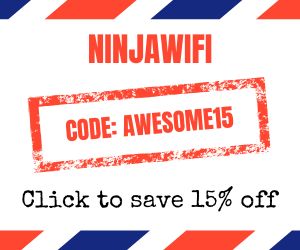
- JR Pass – The two most reliable places we always check are JRailPass and JRPass . If you are taking long distance Shinkansen across multiple region, get the full JR Pass . If you’re focusing on one specific area, you only need a JR regional pass .
- Shinkansen – The JR Pass prices have gone up and for many of you, it’ll make more sense to book tickets individually. The secret is that when you buy your Shinkansen tickets through Klook offers special vouchers for Don Quijote and BIC when booking. Their tickets are super easy to redeem as well. Right now, use code SKS10OFF to save $10 USD off.
- Hotels/Ryokans – In Japan, the best website for accommodations, hands down is Agoda . When we’ve compared them against Booking , Agoda consistently came out cheaper.
- Tours – While Viator and GetYourGuide are our go-to’s, Klook and KKDay are much popular in Asia so it’s always worth comparing across all of them to make sure you get the best price.
- Pocket Wifi – While we do love eSIMs, having a pocket wifi is great for sharing data with a large group. The most popular is NinjaWifi which is easy to pick up at the airport. Use code AWESOME15 to save 15% (automatically applied). Alternatives are offered by JRPass and JRailPass but they aren’t as cheap. For a more global solution, consider Solis and PokeFi .
- eSIM – The best one is Airalo . Save money by getting the Japan region eSIM and use referral code WILLIA9500 to get $3 USD credit on your first purchase. From now to Feb 29, the 10GB package is half price as well! Ubigi is another one that we’ve had success with where they uniquely offer 5G coverage. Use code AWESOME10 to save 10% on your first order.
- Car Rental – Big companies like Budget , Avis , and Enterprise operate in Japan but they’re usually the most expensive. The best companies are the local Japanese ones such as Toyota Rentacar, Nippon Rentacar, Orix Rentacar, Nissan Rentacar, and Times Car Rental. To make things easier, use Rentalcars and Klook to compare prices all in one place. Don’t forget, you need an IDP to drive in Japan so get one before you leave your home country.
- Learn Japanese – It helps to know even a bit of the language before you go. Start your learning with Rosetta Stone Japanese .
- Cash or credit – Cash is still very important to have in Japan but when you use credit cards, make sure you’re not getting charged those extra exchange rate fees. The best card right now is the Wise Multi-Currency Card which is actually a debit card where you can convert at favorable rates beforehand. This cuts out any sneaky transaction fees.
- Travel Insurance – Make sure you’re covered in case something happens. Get quotes from Insured Nomads and if you’re from Canada, get quotes from RATESDOTCA .
- Shopping – Discovering Don Quijote is a quintessential part of the Japan experience. The secret for tax-free shopping is that they have a coupon that can help you save 10% off + additional 5% off if you spend ¥10,000 or more.
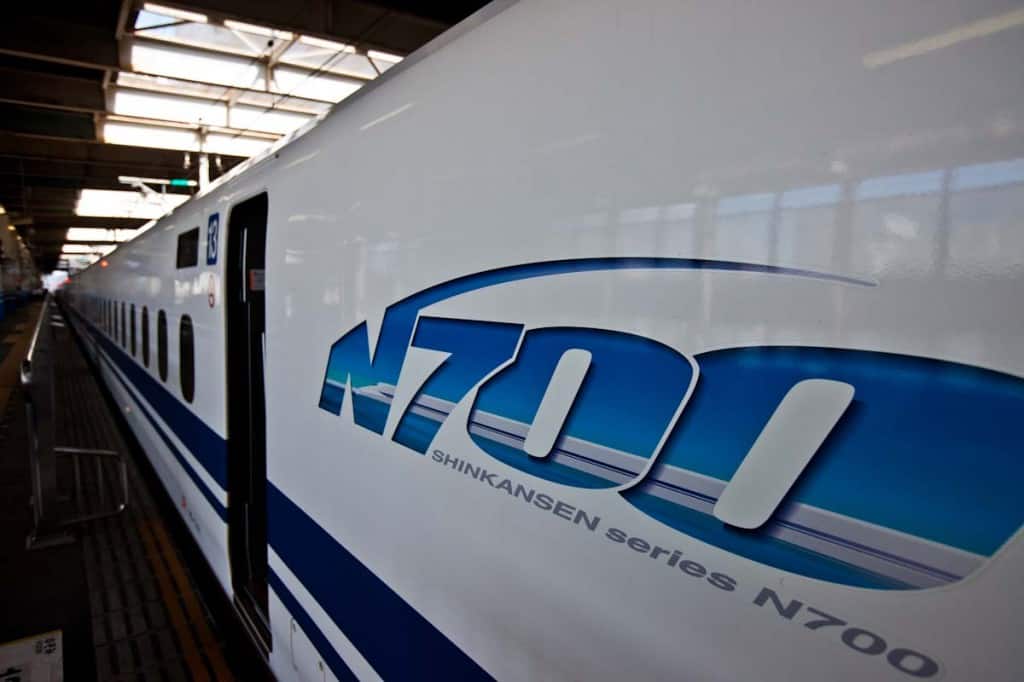
Japan by Train – The JR Pass is pretty much a must if you’re going to be travelling between major cities in Japan. Read more about Japan by Rail .
Get Your JR Pass Before You Go
If you’re looking to do any travelling around Japan, I highly recommend picking up a JRailPass . Keep in mind that you’ll need to purchase it before your trip and ship it to your home.

Train Schedules – If there’s one site you need to know when travelling with a JR pass is www.hyperdia.com . First of all, it’s English friendly so no need for complicated translations. This is an excellent page to figure out the train schedules and since you know the Japanese railway system runs like clockwork you don’t need to worry about whether it’ll be early or late. I used this on many occasions during the trip to figure out the most effective trains to take to get from point A to B.
- For example when going from Kyoto to Hiroshima most of the itineraries involved a transfer in Osaka which would waste time. I played around with different departure times and eventually found a direct Shinkansen that ran from Kyoto to Osaka and then to Hiroshima. No transfer required = less time = more sleep on the train.
ATM’s – If you have a foreign debit card like I did, you’re going to run into problems withdrawing from normal legit bank ATM’s. For some reason these machines don’t take foreign cards. The only machine that worked for me the entire trip was the 7-Eleven . This one worked all the time. So don’t worry, it’s not you when your debit card doesn’t work anywhere else. Just go over to any 7-Eleven which won’t be hard to find and you’ll be good to go.
Baggage Delivery Service – Look for Yamato either at the airport or anywhere in major cities to get it done. They’re fast, simple and reliable. You can either use this service to ship bags from the airport to a city ahead of you so you don’t have to lug it around while taking the train. You can also do what I did which was to ship my larger suitcase to my last destination in Japan.
Most Useful Website – Aside from my own of course ;), Japan Guide was probably the most useful site for Japan that rivalled even TripAdvisor and their forums.
Tuesdays – This one easily creeps up on you without you realizing. There are many places including attractions and restaurants that are closed on Tuesdays so make sure to double-check.
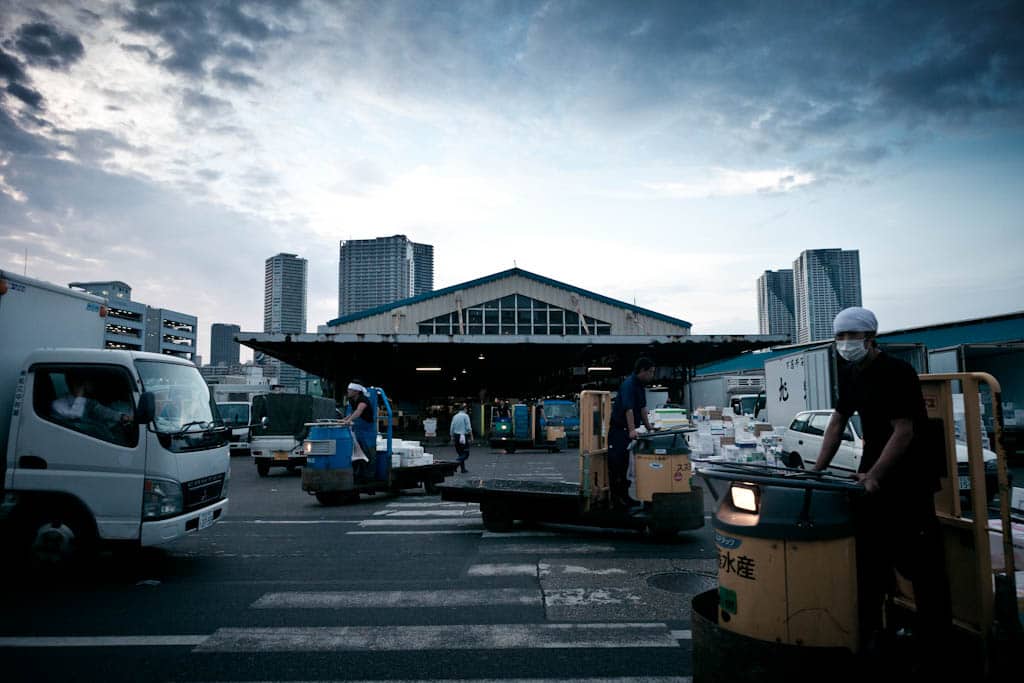
Tsukiji Fish Market Toyosu Fish Market
- NEW IN 2019 – Toyosu Market (豊洲市場) opened October 2018 and is the new site of the Tsukiji Fish Market. Tuna auctions occur at 5:30 and 6:30AM and can be viewed from a few places – observation windows, observation deck (reservation required). For a full guide on how to get into the Toyosu Fish Market Lottery and the full details about what the experience is like .
- How to get to the observation deck – Advance reservation is required to access this deck during the tuna auctions. Similar to before, there are 3 groups of 40 that are allowed in for 10 minutes at a time between 5:45AM and 6:15AM. You must submit your application a month prior at a selected time . It’s a lottery system which is good and bad – good that you don’t have to attempt in the morning and fail but bad in that it is possibly even more competitive because everyone will put their names in.
- Eat lots – Make sure you make it to the restaurants there. Sushi Dai and Daiwa are the go-to places but expect to line up. If you failed at going to the auction you might as well go straight to the restaurants. These classics from Tsukiji Fish Market have been relocated to the new market.
- Seafood Intermediate Wholesaler’s Area – The area is off limits to visitors but they also have their own observation windows for viewing. That said the views are quite narrow and limited.
Restaurant Reservations – For a lot of the well-known restaurants in Tokyo it’s important to make reservations a day in advance. We did this for the entire trip and didn’t run into any problems.
Harajuku – One of the must-visit neighbourhoods of Tokyo. It was a ton of fun to explore even when packed. Filled with many boutique shops, girls in Lolita costumes, and many snacks.
- TIP: To see Lolita girls, make sure you go on the weekend.
Hato Bus – This is a popular tour bus company that locals use and is just as well known for visitors. Hato Bus is a great option in Tokyo because it saves you the hassle of figuring out public transit and allows you to see way more in one day than you would on foot. They offer high quality tours that are quite affordable as well. For the tour that we went on, it also came with a fabulous lunch in a zen park.
- TIP: If you’re doing the Hato Bus, just make sure you plan your itinerary around the tour so you don’t end up redoing any sights.
Looking For Great Views? – If you’re looking to go up a skyscraper with fantastic views of the city AND you want to do it for FREE , look no further than the Tokyo Metropolitan Government Building is the one you want to go to. Based on personal experience though, the one thing to note is that the views from the top are somewhat limited. I feel that Tokyo Tower or Tokyo Skytree would offer better views but those have paid admission.
Best Shrine – If there’s one shrine you want to go to in Tokyo, I would recommend Meiji Shrine. My #2 would probably be the one in Asakusa.
Recommended Restaurant – Gonpachi is a must-do restaurant in Tokyo. Make reservations! It’s the restaurant that inspired the epic restaurant scene in Kill Bill.
Odaiba – I wouldn’t necessarily recommend Odaiba to first time visitors of Tokyo but if you’re looking to do some shopping and want to hang out at as a local for shopping and entertainment arcades, you can definitely make the trip out to this man-made island.
Day trips – Tokyo is massive and so if you’re looking for a great day-trip recommendation, check out foodie destinations like Kichijoji which is well known for their street food.
Where to Stay – Here are my recommendations for top 4 picks in the city that caters to all budgets. If you want more recommendations, make sure to take a look at the in-depth neighbourhood guide and best places to stay in Tokyo .
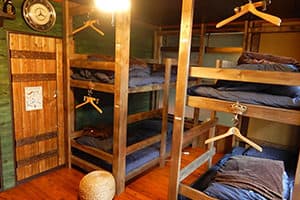
HOSTEL OOMORI SOUKO
If you’re looking for cheap accommodations in Tokyo (sub $100), you’re looking at hostels and ones that are going to be a little away from the core. The host, Kato-san is extremely friendly which is why the property is so well reviewed. It’s minutes away from Haneda airport and 16 minutes walk to the train to head into the downtown.
Booking.com
BUDGET-FRIENDLY

DAIWA ROYNET HOTEL
Brand new hotel as of February 2019, this a 3-star hotel with affordable prices because it is in the Shinjuku Ward which should not be confused with Shinjuku. You’ll need to take the train into the city but for the cost and as a brand-new property, this can’t be beat.
TripAdvisor
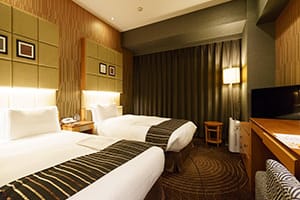
HOTEL SUNROUTE HIGASHI SHINJUKU
Located near Shinjuku, this hotel is conveniently located 10 minutes walk from the Isetan department store and more importantly right by the train station. The rooms are spacious, clean, and comfortable and up to standards as a mid-level hotel.
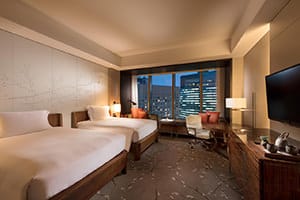
CONRAD TOKYO
This property is well deserved of Hilton’s top brand. Located near Shimbashi and Shiodome, this is located in a financial area which means there isn’t too much around directly in its vicinity but Shimbashi certainly makes up for it. It is also walking distance to Tsukiji. Impressive room, executive lounge, the lobby, and impeccable service.

Hotels in Osaka – Accommodations aren’t the easiest to find in Japan but Hostel 64 Osaka was recommended by my Japanese friend and it sure was a winner. Highly recommended for their spacious rooms, location, service, and breakfast. It has many of the hostel qualities but out of all hostels I have ever stayed at, this has to be #1.
Foodie Paradise – Come to Osaka for the food. There’s just so many options here and things seem more accessible here than in Tokyo.
Where to Stay – Even with only a couple of days here, you’ll need to find a good place to stay as a base of operations whether you’re doing Osaka, Nara, or any of the other outlying cities.
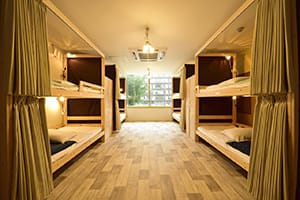
HOSTEL CHILL OUT
This is a killer hostel that’s conveniently located right along the Dotonbori River, is really cheap, and comfortably spacious for shared accommodations. This one is top in my books for Osaka.

SARASA HOTEL SHIN OSAKA
A great steal of a property for those not looking to stay at a hostel where I’ve seen prices hovering around USD$60 or less. What you need to know that this is located north of central Osaka in Yodogawa Ward district and right by Shin Osaka station. Bonus is that they include a mobile phone with internet access.

HOTEL UNIZO OSAKA
A hotel that includes all the fixings you’d expect from a modern property. The highlight though is the location which is just a here 5-minute walk to Umeda station and a 10-minute walk to Osaka station, respectively. There is free wifi at this hotel.

HOTEL NIKKO OSAKA
Looking to go a little fancy? Well right up there in terms of top properties in Osaka is the Nikko Osaka which sits right above Shinsaibashi subway station which gives you access to the shopping and restaurants of the Dotonbori area. It is also located Daimaru. The rooms are of the highest class and many offer excellent views of the city.
Is Nara Worth It? – Without seeing much of Osaka outside of Dotonbori I can’t really say whether Nara was better than Osaka or not but it’s definitely a side trip worth doing. The deer experience alone made it worthwhile.
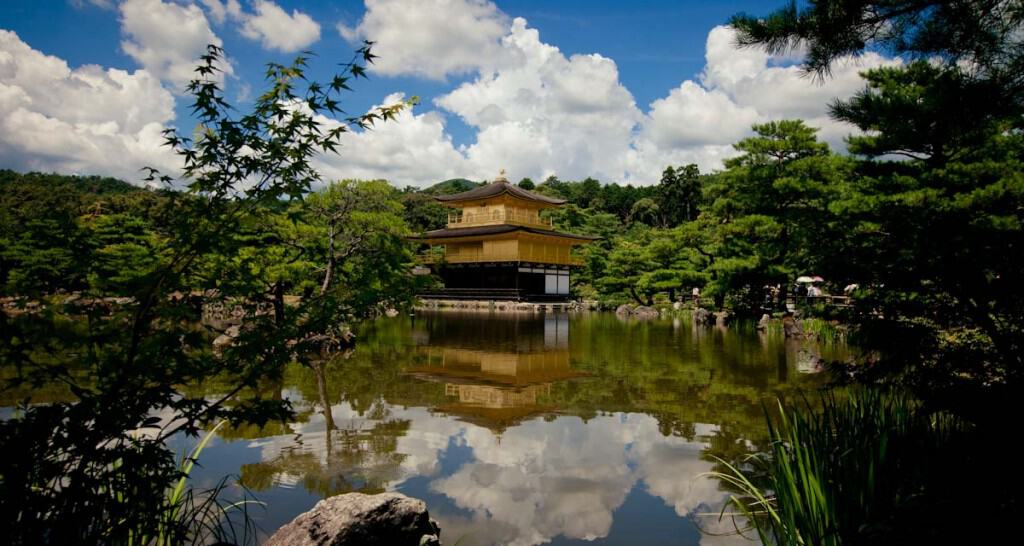
Ryokans – One of the must-try things in Kyoto is to stay at a traditional ryokan. Ryokans are a type of traditional Japanese inn that has existed since the eighth century. For something on the budget side of things Ryokan Shimizu is perfect. It’s clean, it has its own en-suite bathroom, and is close to transportation. Get the ryokan experience for a fraction of the cost.
Higashiyama District – You can easily spend a full day in the Higashiyama Area and I would highly recommend it if you have 2 days to work with. This is the area where you’ll be able to see Kiyomizu-dera and Yasaka Shrine.
Plan Wisely – Something you should note as you plan your trip is that special buildings such as temples, shrines, and castles close between 4PM-5PM. This means that if you don’t want to run risk of being shut out of any places, it makes sense to do these sights earlier in the day.
Fushimi Inari – Now what’s unique about this cascade of red torii gates is that there’s no official closing time here so when planning your day, slot this towards the end of the day so you can still see your temples, shrines and castles and then round out the day exploring Fushimi Inari. For the photographers out there, Fushimi Inari is absolutely stunning for photos.
Where to Stay – Kyoto has an interesting mix of accommodations that makes it one that you really have to do some research for. As mention above, there are the traditional ryokans that most of you will undoubtedly want to try here. I pick out the best affordable ryokans in Kyoto but what are others you should consider? We also have an detailed Kyoto where to stay and neighbourhood guide that you should use for your trip planning.

HOTEL M’S PLUS SHIJO OMIYA
It’s crazy to find such a popular property (close to 6,000 reviews) at such cheap prices (USD$50) in Kyoto but here it is. The surprising thing is that their rooms are just like any other high quality hotel room. You can’t go wrong with this one.

HOTEL KEIHAN KYOTO GRANDE
Another property that should be more expensive than it is. Hotel Keihan is directly connected to the JR Kyoto train station, is 10 minutes from Higashi Hongan-ji Temple, and 15 minutes from To-ji Temple. All of the modern rooms also come with free wifi.

HOTEL RESOL KYOTO KAWARAMACHI SANJO
Located in the Nakagyo Ward, just north of Kyoto station, you’re only 1.6km to temples such as Shoren-in. This is comfortable and upscale hotel that is built in the modern style but mixes in the ambiance of what it’s like to stay in a ryokan.

RYOKAN TORI
Completely authentic ryokan experience that is definitely more expensive than the budget ryokans I’ve written about but the reason for this is all the extras you get – private hot bath well prepared for you each evening, tea ceremony at the tea room, and love the homemade Kyoto style breakfast.

I’m glad we were able to fit in Hiroshima as part of this 12 day itinerary of Japan. For more details about places to go, make sure to head to the top 5 things to do in Hiroshima .
Photography at Miyajima – One thing that people say about photographing Miyajima and the floating torii is that you have to decide whether you want to shoot it with the tide up or down. I didn’t have the luxury of choosing when I went so this was a non-factor for me but if you want to shoot it at high tide, go in the morning. If you want to see it at low tide and be able to walk right up to the gate, you’ll want to be there in the late afternoon. Of course the time of the year matters as well but the tide trend should stay the same.
Why Hiroshima? – Hiroshima is definitely something not to miss if you’re going to be in the Osaka region. Even if you’re not a WWII history buff, the atomic bomb history is thoroughly interesting and of course Miyajima is beautiful.
Remembering – The atomic bomb monuments, museums, and park can done in half a day so if you have a full day in Hiroshima, you can easily do both the atomic bomb memorials and Miyajima island. If you’re looking for a tour, this full day tour that combines Hiroshima with Miyajima is excellent.
Where to Stay – When in Hiroshima, you’ll need a few nights stay so here are my top picks for the city. I have a full guide on where to stay in Hiroshima but for a few quick recommendations take a look below.
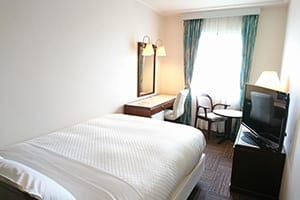
COURT HIROSHIMA
The rooms here are tiny but for the cost, you can hardly complain. At rates around US$50, you’re walking distance from the Hiroshima tram and in between the train station and the downtown core. Note that they only offer free wired internet.

DAIWA ROYNET HIROSHIMA
Conveniently located in Hiroshima ‘s main commercial district, it’s just a 1 minute walk to Chudenmae Tram Station. This property is affordably under US$100 and offers free wifi which is key. Walking to Hiroshima Peace Memorial Park only takes 10 minutes.
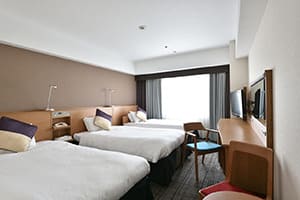
HOTEL GRANVIA HIROSHIMA
Ranked #2 in Hiroshima, this hotel is directly connected to the JR Hiroshima station which makes it uber convenient. Also, you’ll find that the rooms are larger than most hotels in Hiroshima. Wifi is free as well.
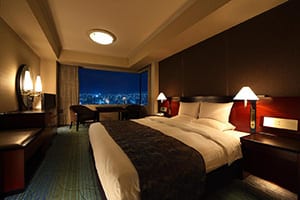
RIHGA ROYAL HOTEL HIROSHIMA
Smack right in the middle of the Hiroshima core is this top-end hotel that can only be described as grand. As more of a business-hotel, the rooms are extremely spacious but some have said are a bit dated. The best part is that it is only 5 minutes away from the city’s main attractions.
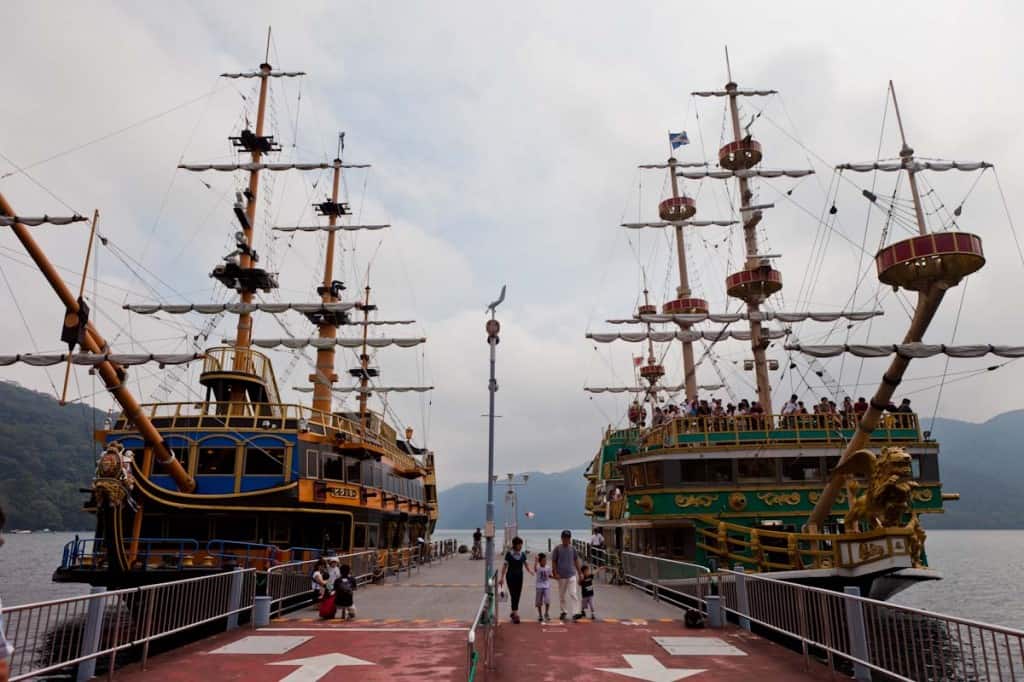
Hakone Free Pass – If you’re going to be going to Hakone and going to do the round-the-city tour like we did, this is the one to get. 5000 JPY can’t be beat. Get an earlier start than we did and in one day you can pretty much see all the main sights and activities in Hakone.
Hot Springs for Couples – Do your research beforehand and if you’re not sure, ask your concierge if you have any questions or get them to call to get the answers. If you’re looking for hot springs for couples, they are rare in Hakone. The onsen we ended up choosing was Tenzan and they had them available but only for 2 hour time slots. On top of that, you can only reserve them when you get there. There are only 3 or 4 of these type of rooms but you only get one temperature pool and that’s it. We opted to go to the regular onsen area as we wanted to experience it to its fullest (nude and all).
The visuals really tell the story of why it was so easy to fall in love with Japan in a matter of 12 days. Here’s a glimpse of the things I was able to capture.
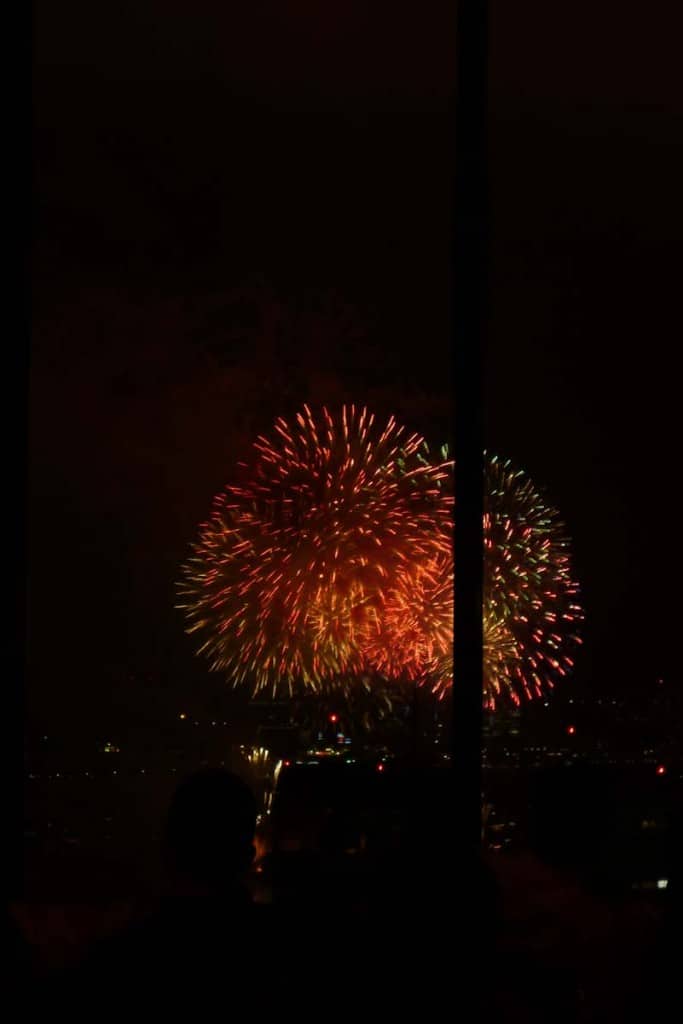
Read More About Japan
- Guide to the Must-Try Food in Osaka
- Where To Stay In Hiroshima – A Guide To The Best Hotels and Neighborhoods
- Top 5 Things to Do in Hiroshima, Japan
- When Is The Best Time To Go To Kyoto?
- Immerse Yourself in Japanese Culture in Kyoto
- Facebook 100
- Pinterest 717
About William Tang
William Tang is the Chief of Awesome behind the award-winning Going Awesome Places which is focused on outdoor adventure, and experiential travel. His true passion lies in telling stories, inspiring photography and videos, and writing detailed itineraries and travel guides. He is a member of Travel Media Association of Canada (TMAC), Society of American Travel Writers (SATW), Adventure Travel Trade Association (ATTA), and Travel Massive. He has also been featured in publications such as Reader's Digest, Entrepreneur, Men's Journal, and Haute Living. Make sure to learn more about William Tang to find out his story and how Going Awesome Places started.
Find us on social media

The Ultimate Two Weeks in Japan Itinerary: Where to Visit

For the first-timer, spending two weeks in Japan is the ultimate way to go. This Japan itinerary will break down exactly where to visit in Japan and how long to stay. Japan is a special place for me. After visiting for my third time this last year, it has become easily my number one destination in Asia.

Japan is wildly different from anything here in the U.S. Their culture has preserved the arts and historic components of society. Meanwhile, it has integrated technology and processes that drive their community forward. I’ve never seen anything quite like it — an incredible blend of the old world and the new world. Japan has a wonderful way of drawing you in and showing you a new way to live.
So if you’ve booked yourself a two-week trip to Japan, here’s everything you need to know about where to visit and why.
Why You Should Spend Two Weeks in Japan
How long you spend in Japan is entirely up to you. I would vote to do two weeks for a few reasons especially if it’s your first time. The first is that it allows you to get off the main path that most tourists will visit. All of those cities like Osaka, Kyoto, and Tokyo are wonderful. However, there are some other hidden gems of places to go. Spending two weeks gives you the right amount of time to truly digest it all. You can blend the perfect trip of highlighted cities and some other experiences that will take you by surprise. There are several world heritage sites you won’t want to miss as well along the way.

On our first trip to Japan, we booked in over two weeks and we felt we had really gotten a taste of the country. By the end of the trip, we were ready to go home. Our most recent trip was around 12 nights long and we felt we could have stayed the full two weeks. So my suggestion based on experience is that two weeks is the golden number.

What will be in this two-week itinerary in Japan post:
- A sample itinerary.
- Information on accommodations and dining.
- Sources for more detailed guides.
- What to Know About Transportation and the JR Rail Pass
Short on Time? Here’s How I Would Spend 2 Weeks in Japan:
Before arrival.
- Purchase a JR Rail Pass , for unlimited train travel while in Japan

Stop 1: Tokyo — 3 nights
- Shibuya Hotel En , for the best centrally-located hotel
- Shibuya Granbell Hotel , for the best Shibuya Station hotel
- Keio Plaza Hotel , for the best Shinjuku hotel
Stop 2: Kiso Valley — 2 nights
- Magome Chaya , for the best Magome hotel
- Ooedo Onsen Monogatari Hotel Kisoji , for the best hotel near Tsumago
- Japanese Guesthouses , for the best intimate stays in the Kiso Valley
Stop 3: Kyoto — 4 nights
- Kyoto Hotel Okura , for the best downtown hotel
- Yuzuya Ryokan , for the best ryokan hotel
- Hotel Mystays Kyoto Shijo , for the best budget hotel
Stop 4: Onsen Experience — 2 nights
- Gora Kadan , for the best modern onsen hotel
- Yaeikane , for the best traditional onsen hotel
Stop 5: Tokyo — 2 nights
The ultimate two weeks in japan itinerary, stop 1: tokyo — 3 nights.

Tokyo Highlights
Starting in Tokyo is a wonderful immersion into Japan. I’d recommend flying into Narita Airport as it has a fast train into the heart of the city. Your first day or night will give you time to adjust to the changes. There are wonderful highlights to visit in Tokyo including incredible museums, neighborhoods, markets, and restaurants. You get an opportunity to experience Japan’s sprawling city.
A few favorites for me include spending a morning at Tsukiji Fish Market. It is certainly sensory overload but out of this world. One new thing we did this last trip was going to teamLab Borderless afterward since they’re both on the outskirts of town. It was a wonderful way to spend a day.

There are other day trips you can do as well like to the Fuji Five Lakes, so if you want a break from the city you can consider this. Overall starting your time in Tokyo is the most convenient for getting adjusted and from there you can continue on to your next destination with the extensive train routes.
Helpful Tokyo Guides to Plan Your Trip
- For creative things to do: The Alternative Guide to Tokyo
- Most recent coffee guide: A Guide to the Coolest Coffee Shops in Tokyo
- Back-up coffee guide: 7 Coffee Shops Not to Miss in Tokyo
- General travel guide: The First-Timer’s Guide to Tokyo
Where to Stay in Tokyo
I personally love to stay in Shibuya as it’s the best-located neighborhood to explore. A few recommended hotels:
Stop 2: Kiso Valley — 2 Nights

Kiso Valley Highlights
If there is one recommendation for getting out of the major cities, it’s to go visit the mystical Kiso Valley. It’s famed for the Nakasendo Trail where you can hike between the small towns of Tsumago and Magome. These two towns are historic and contain old-world buildings telling of Japan’s past.
Whether you’re looking to slow down, get some time in nature, or do something a bit more traditional like stay in a ryokan, the Kiso Valley is it. It does take some patience and time to plan this part of a trip to Japan as it’s only ryokans available in the towns. You can reach it by train from Tokyo with a few transfers and a final bus ride into Tsumago.
Need A Japan Rail Pass? This Is Where I Book Mine

Two nights is wonderful here and a welcomed reprieve from city life. This is mostly why I’d recommend doing it between Tokyo and Kyoto and you can easily follow the train routes.
Helpful Kiso Valley Guides to Plan Your Trip
- My personal experience : Visiting the Kiso Valley
Sample Train Route from Tokyo to Tsumago
You will need to bus from Nagiso to Tsumago, see schedule here

Where to Stay in Kiso Valley
I’d recommend staying in Tsumago or Magome which sit on either end of the Nakasendo Trail. Here are my top picks of where to stay in the Kiso Valley:
Stop 3: Kyoto — 4 Nights

Kyoto Highlights
Oh Kyoto, this city forever has my heart. Whether you come for the famed cherry blossom season that transforms the city or to explore the UNESCO World Heritage sites, it’s wonderful. Kyoto is a special place in Japan and a must on the first trip.
A few highlights for me are the Arashiyama bamboo grove in the early hours before the crowds. I’ve done it twice and each time it has been worth the early wake-up call to catch sunrise there. The red Torii gates of Fushimi Inari Shrine are another wonderful highlight as well. Fushimi Inari Taisha (full name) is not a world heritage site but nonetheless incredible.

You could easily spend 4 nights in Kyoto mostly because there is so much to do there. One way you can get out of the city is a day trip to Nara as well, utilizing the central train station. I’d recommend reading the extensive guides below to plan your days in Kyoto as there is a lot to do. That’s why I’d allot four nights in this city alone.
Helpful Kyoto Guides to Plan Your Trip
- Accommodation advice : Where to Stay in Kyoto By Neighborhood
- Temple and shrine guide : A Guide to the Best Temples & Shrines in Kyoto
- Local artisan shops: 7 Local Shops Not to Miss in Kyoto
- For photography: Best Photography Locations in Kyoto
- Where to eat: 20 Best Restaurants in Kyoto
- Where to get coffee: 7 Coffee Shops Not to Miss in Kyoto
- The overall guide: The Ultimate Guide to Kyoto
Sample Train Route from Tsumago to Kyoto
You will need to bus from Tsumago to Nagiso, see schedule here

Where to Stay in Kyoto
I have an entire post on where to stay in Kyoto and it is broken into the neighborhoods. The city is very diverse so I’d recommend giving it a read before making a choice on where you stay. The accommodation location in Kyoto makes a huge difference in your experience in the city.
Here’s my short list of best hotels in Kyoto:
Stop 4: Onsen Experience — 2 Nights

Onsen Experience Highlights
A traditional experience in Japan is to go stay and enjoy the healing waters of an onsen. It’s truly Japanese in the sense of slowing down and restoring the body. After all the travel, I love to schedule this towards the end of the trip which is why I’ve placed it after four nights in Kyoto where you’ll walk a lot.
Since you’ll need to make your way back toward Tokyo eventually, you can choose a few locations. The more commonly visited area is Hakone which is filled with onsen ryokans. You can even get a day pass to the onsens and buy the Hakone Free Pass to visit the nearby sights. This is just one option if the area of Hakone is of interest.
We decided to spend a few more hours on a train and make our way towards the onsen region of the Yakushiyma mountains where the Yamashiro Onsen is. We splurged on two nights at Beniya Mukayu. It’s the single most expensive hotel we’ve paid for but in return received the best stay and a lot included. The hotel stay included daily breakfast and dinner, and our room had a private onsen. The food was exquisite, each meal several courses long with fine ingredients. Again this is a splurge experience but I’d say is well worth it.
You could choose to stay in this region (there are other onsen ryokans and hotels) as well. You’ll have to account for a few more transfers to get back to Tokyo but it is totally doable.
Helpful Onsen Guides to Plan Your Trip
- Our onsen experience : Staying at an Onsen in Japan’s Countryside
Sample Train Route from Kyoto to KagaOnsen
Local hotels pickup at the train station.

Where to Stay: Best Onsen Hotels
In Hakone, some of the top-rated onsen hotels include:
- Hakone Airu , for the best Balinese onsen hotel
Check out 224 more hotel options in Hakone here.
For onsen hotels near the Beniya Mukayu in Kaga, see this page for the city of Kaga and over 40 options.
Stop 5: Tokyo — 2 Nights

We always tack on two more nights in Tokyo before leaving Japan. One reason is that we want to be in the city at least the night before our flight and the second is, there’s always something we didn’t get to. If you’re there for cherry blossom season, then definitely make an extra stop as the blooms could have changed.
I love eating once more at our favorite yakitori restaurant, strolling the gardens and shrines of Yoyogi Park, and soaking in the city’s energy. It’s a special city and one I always look forward to going back to.
- The Alternative Guide to Tokyo
- A Guide to the Coolest Coffee Shops in Tokyo
- 7 Coffee Shops Not t o Miss in Tokyo
- The First-Timer’s Guide to Tokyo
Sample Train Route from KagaOnsen to Tokyo

Before leaving Tokyo to go back to the airport, I’d recommend booking a hotel near the main train station like Shibuya for easy, direct access. Here are my top picks for best hotels when returning to Tokyo:
Planning for Transportation in Japan

One of the most overwhelming parts of Japan is sorting out whether or not you need a Japan Rail Pass and the train systems. The rail pass and Japan Rail are incredibly easy to use and convenient pending a few factors. I have an entire blog post dedicated to transportation in Japan which goes into great detail on all of the factors to consider.
The JR Rail Pass is essentially a joint pass for the majority of the JR Company trains in Japan. Passes are available by either a 7, 14, or 21-day period. If you do a quick tally of individual ticket prices (especially between Tokyo, Osaka, Kyoto, and other regions) it will be worth it. You can use it on the JR lines in Tokyo and Kyoto which connect you between neighborhoods. You can purchase it through this link and it must be done so before arrival (give a few weeks to receive the pass). One other benefit is the ability to reserve seats on certain trains.
*You’ll find each train station easy to navigate and the famed bullet train really is wonderful. Trains in Japan are timely so be prepared to arrive ahead of time.
Other Destinations to Consider for Your Two-Week Japan Itinerary
There are several other destinations you can consider as even Hakone mentioned above. One popular other destination is Hiroshima which is home to the Hiroshima Peace Memorial and Peace Memorial Park. I know so many people love to visit as the Peace Memorial Museum is incredibly special. A few other destinations to consider are:
- The Alpine Route
- Miyajima Island
- Osaka (wonderful for a few days in a different city)
Get Travel Insurance Here
I always recommend travel insurance for international travel. Especially when you’re headed overseas for an extended time. I often use World Nomads , they’ve reimbursed me personally on a few occasions for trip delays and cancellations.
Want to create your own travel itinerary?
Save this post for later on pinterest.

PS — Are You Booking a Trip Soon? Use My Booking Checklist!
These are the sites I use most to book my own trips. Using the links below is a great way to support Bon Traveler’s travel journalism at no extra cost to you . If you need help organizing your itinerary, get my free travel itinerary template here .
1. Book Your Flights
I use Skyscanner to find the best flights. It searches 100s of airlines and websites across the globe to ensure you’re not missing out on any route options or deals.
2. Book Your Accommodations
I use Booking.com for hotels and guest houses. They have the biggest inventory and consistently offer the best rates.
3. Book Your Tours & Experiences
I use Viator or Get Your Guide to find the best tours and experiences. They are my favorite tour search engines. I always check both as their inventory varies depending on the destination.
4. Book Your Rental Car
Self-driving is the best way to explore most destinations. I use Discover Cars for our rental cars, select full coverage insurance, and opt for a reputable company like Alamo, Hertz, or Sixt.
5. Don’t Forget Airport Lounge Access
I use Priority Pass to gain access to 1,400+ VIP lounges and airport experiences worldwide. The Priority Pass app is the first thing I check when I have a layover. I’ve been a member for over a decade, and having a comfortable place to relax before and between flights makes air travel so much more enjoyable.
6. Don’t Forget Travel Insurance
I never leave the country without travel insurance. It provides comprehensive protection in case anything goes wrong (ie. illness, injury, theft, and cancelations, etc.). I use it frequently for my travels to stay protected.
My favorite companies that offer the best coverage and rates are:
- World Nomads (best for all-around)
- Safety Wing (best for frequent travelers)
Xx, Jessica
Related Posts

The Ultimate 7-Day French Riviera Itinerary

The Best Things to Do in Apple Hill in the Fall (2024)

The Ultimate London 3-Day Itinerary
Yes yes yes. Japan is at the absolute top of my list of dream places to visit and I’m saving this guide.
Thank you! I loved this guide, super helpful: concise, informative and an easy read. Loved your photos too!
Write A Comment Cancel Reply
Save my name, email, and website in this browser for the next time I comment.
- Cayman Islands
- Dominican Republic
- Puerto Rico
- South Dakota
- Washington DC
- Czech Republic
- Netherlands
- Switzerland
- French Polynesia
- Travel Tips
- Family Travel
- Accommodations
- Packing Lists
- Photography Tips
- Northern California Guide
- San Francisco
- Lightroom Presets
- Rent Our Home For Photoshoots
- California Map
Type above and press Enter to search. Press Esc to cancel.

The Perfect One Month Japan Itinerary And Travel Guide (2024)
By: Author Lotte
Posted on Last updated: July 31, 2024
Categories Japan

Japan is a beautiful country with a history of emperors and samurai, unique culture and religion, ancient temples, impressive castles, and stunning nature. Japan never ceases to amaze and it's one of my favorite countries in the world. Over the years, we've made quite a few trips to Japan; the last one was in October 2023.
Altogether we've spent almost two months exploring Japan and I'd love to go back for another trip!
This Japan itinerary gives you several options to explore this truly unique nation, depending on your preference and the amount of time you have available. It includes some of the most popular places to visit and things to do in Japan, but also several off-the-beaten-path destinations .
Japan itinerary
Disclosure: Some links in this post are affiliate links. If you make a purchase through one of these links, we may earn a small commission (at no extra cost to you!). We're very grateful when you use our links to make a purchase:-).

Itinerary for Japan and Japan travel map
You can find our itinerary of Japan on the map below, as well as our accommodation and the highlights we visited during our trip to Japan.

Click here for the interactive map
The perfect one month itinerary in Japan

- Day 1-7: Eat your way through Osaka and enjoy the city’s streets and tranquil shrines. Then, pay a visit to Universal Studios .
- Day 7-9: Try the world-famous wagyu beef in Kobe, visit the museums in Hiroshima and explore the lovely island of Miyajima .
- Day 9-11: Visit the magical Kyoto . Stroll around historic neighborhoods, learn about Japanese culture, and admire beautiful temples and the famous Fushimi Inari-Taisha Shrine. After that, explore ancient temples in Nara and hike the Koyasan pilgrimage trail .
- Day 11-18: Take a road trip around Hokkaido , Japan's wild and untamed northernmost island with stunning scenery. Alternatively, stay in Sapporo and enjoy little daytrips to the nearest fun locations (like Asahiyama Zoo or nearest port town of Otaru).
- Day 18-28: Explore Tokyo . Visit ancient temples, marvel at modern buildings, relax in one of the many parks and eat your way around this bustling city.
- Day 28-33: Go off the beaten track in the Japanese Alps and visit Kanazawa, Shirakawa-go , Takayama , Kamikochi , and Matsumoto.

One-month Japan itinerary
Our recent trip to Japan in fall of 2023 was the most epic one: We spent 10 days in Osaka, then an entire week in Sapporo, before polishing off our stay with 10 days in Tokyo. Taking into account all the new and old information, we’ve created this perfect masterpiece — our extended and improved itinerary for an entire month in Japan!
I have written extensive guides for the majority of all the places we visited in Japan, with more information about our day-to-day activities, transportation, and accommodation.
You can find the links to those detailed posts in the itinerary below. If you don't have that much time available to explore Japan, don’t worry, I’ve got you covered.
Further on in the post, I also suggest shorter options (7 and 10 days, plus 2 and 3 weeks) for your Japan travel itinerary.
Day 1 – 7: Osaka

✔️Osaka cheat sheet:
- How to get around Osaka? Get an ICOCA IC Card (it comes with Kansai Thru Pass, perfect for moving around the cities). If you plan on being Osaka-bound for a few days in a row, without peeking outside city limits, then Osaka Metro Pass will be fine.
- Where to stay in Osaka? 4* Miyako City Osaka Hommachi (from $130 a night) is a great option for travelers. The hotel is located close to the train station, and the nearest tourist attractions are only a stop away!
- What to book in advance for your time in Osaka? A ticket to teamLab Botanical Garden and a Universal Studios pass .
- Where to learn more about Osaka? Our 1-Day Osaka itinerary is a treasure trove of things to do and see in this marvelous city.
Osaka is a great first stop on our 1-Month Japan Itinerary, and here’s why: The city has the best balance between tradition and modernity. Here, you can ease into the culture that is so different from the ones you’ve experienced before. If you get easily overwhelmed by neon-lit loud main streets, take a step back into nature — thankfully, Osaka has got the best of both worlds!
Apart from having the best time by eating your way around Osaka (after all, the proud title of the Nation’s Kitchen didn’t come from nothing), there are a few places that you absolutely must visit to get the most well-rounded experience of the city:
📍 Tsutenkaku Tower: Osaka’s very own Eiffel Tower, this landmark is a crown jewel of the bustling Shinsekai district and the city in general. The structure lights up at night but it's not the only feature that attracts crowds of visitors daily. The tower is home to a viewing deck (¥900 / $6) which is great for enjoying bird’s-eye view panoramas of Osaka, in all its dazzling glory.

📍 Osaka Castle: After getting demolished and rebuilt again and again, the construction now stands as the epitome of traditional Japanese architecture. A visit to the castle grounds doesn’t stop at the main structure though, as there’re so many other things to marvel at here: Giant stone walls, moats (!), cherry blossoms… The mind reels at the sheer thought of seeing all of this for the first time. I recommend you booking tickets to Osaka Castle (¥600 / $4) in advance as the lines at the gates are HUGE.
📍 teamLab Botanical Garden Osaka: When nature and technology come together, something beautiful appears. This installation (¥1800 / $12) set in Nagai Botanical Garden, is nothing you’ve ever seen before: Walking through moving fields, under lit-up trees, and surrounded by shapes out of a ski-fi movie is a once-in-a-lifetime experience you simply cannot miss when in Osaka.
Tickets to teamLab Botanical Garden >>
📍 Dotonbori: A great foodie destination by day, the street comes alive with lights at night! Rendezvous with your travel buddies by the Glico running man and go explore this Adventureland-esque area of Osaka till the early hours.
Universal Studios

Most people travel to Osaka just to get the experience of Universal Studios Japan (USJ), and who can blame them: This world-famous theme park is the ultimate fun capital of the country! With areas ranging from Harry Potter to Nintendo World (Jurassic Park, Jaws, Minions, and other themes to boot), this place has something for everybody.
- There are a few Universal Studios passes you can choose from. You can get a simple 1-Day Studio Pass (¥8600 / $58,5) or an Express Pass (from ¥12,800 / $87) that lets you cut the line on a number of rides, depending on the package. Nintendo World requires a ticket with a separate access, you can reserve your spot in the USJ app in the morning of your visit.
Note that exploring Universal Studios usually takes no less than a full day, so plan your itinerary accordingly! After all, there’s so many things to accomplish once inside: Take a ride on the Flying Dinosaur, drink butterbeer, help Mario save the Princess, hug minions, and eat your weight in themed snacks… You will need lots and lots of energy to experience anything and everything at Universal Studios Japan.
🔹 Side note : Based purely on our experience, we’ve come to a conclusion that you will have a great time at Universal Studios if you spend extra to fast-track everything. Huge lines for virtually all rides (with wait times starting at one hour) and giant crowds in general will dampen your mood if that’s all you’ll get to look at once inside.
Day 7 – 9: Kobe, Hiroshima, Miyajima

After you’ve explored everything that Osaka has to offer, it’s time to broaden your horizons! Kobe, Hiroshima, and Miyajima are perfect day trips you can take and still come back to your hotel in Osaka for a nightcap.
Personally, that’s exactly what we did: With just day packs on our backs, we perused the fast and furious services of the Japanese bullet trains and got to discover these fantastic cities, each so unique and different.

✔️Kobe cheat sheet:
- How to get around Kobe? Just like in Osaka, the same ICOCA IC Card will make your movements to and around the city much easier (it works in all of the greater Kansai area). You can take a short but sweet shinkansen (bullet train) ride from Osaka to Kobe — just 15 minutes and you’re here! Another option you can look into is taking a small detour in Kobe on your way back from Hiroshima — just remember to keep your original ticket, and then you can top it off with some cash to finally reach your base in Osaka.
- Where to stay in Kobe? 4* The Royal Park Canvas Kobe Sannomiya (from $70 a night) — a perfectly located hotel, close to the train station and set right in the city center. But to tell you the truth, it’s much better to use Osaka as your base and go to Kobe purely in search of new experiences.
- What to book in advance for your time in Kobe? Nunobiki Herb Gardens and Ropeway and Kobe Animal Kingdom . Besides these experiences, the best things to do in Kobe are walking and eating!
A beautiful city not too far from Osaka, Kobe is world-famous for being the place where the finest beef — Kobe Wagyu beef — comes from. However, that’s not all that Koby’s wrapped up to be! Because of its rich history as a port, Kobe is also home to some unique tourist attractions and landmarks worthy of your time and money. It’s as multicultural as Japan can get!
Sandwiched between the sea and the mountains, this small town can be explored in just a few hours (at least its main sights, since it's pretty much impossible to get to know the place in such a short amount of time). So, when in Kobe, try and diversify your experiences (thankfully, the city has many sides to it) and visit the following attractions:
📍 Kobe Port Tower : Referred to as “Steel Beauty”, this spectacular hourglass-shaped red structure is an iconic city landmark. The site is currently closed for seismic restoration, set to open in spring of 2024. Until then, the stunning views that open up from the tower’s viewing deck are unavailable to the public. The waiting’s going to be worth it, trust us!
📍 Nunobiki Herb Gardens and Ropeway : One of the largest herb gardens in Japan, Nunobiki is a standalone, super aesthetically-pleasing and relaxing destination in Kobe, perfect for a chill afternoon. Take a 10-minute ride on the ropeway and enjoy the lush greenery (lavender and lily gardens were the highlights of our visit). Ticket to Nunobiki is ¥1440 / $9,7.

📍 Kobe Maritime Museum : A cross between Sydney Opera House (the shape) and Louvre Abu Dhabi (the pattern), Kobe Maritime Museum is an architectural marvel and a true eye-candy set right by the water. At night, the structure is a stark contrast from the Kobe Port Tower: The swooshing strokes of green-illuminated roof construction of the museum are set against the tall and bright red tower complex. Inside, Kobe Maritime Museum is a wonderland of exciting maritime trivia — exhibitions are perfect for kids and adults alike! Admission is ¥900 / $6.
📍 Akashi Kaikyo Bridge : World’s second largest suspension bridge (it was the first for more than 20 years, until 2022; when the newly opened Turkish 1915 Çanakkale Bridge took the title), it connects Kobe to Awaji Island. The sight of the bridge itself is great enough: Just think about the efforts it took to create such a monstrous structure! However, if you’re more of a doer than an observer, there are tours you can book that let you climb to the very top of the bridge’s towers (adrenaline junkies unite!).
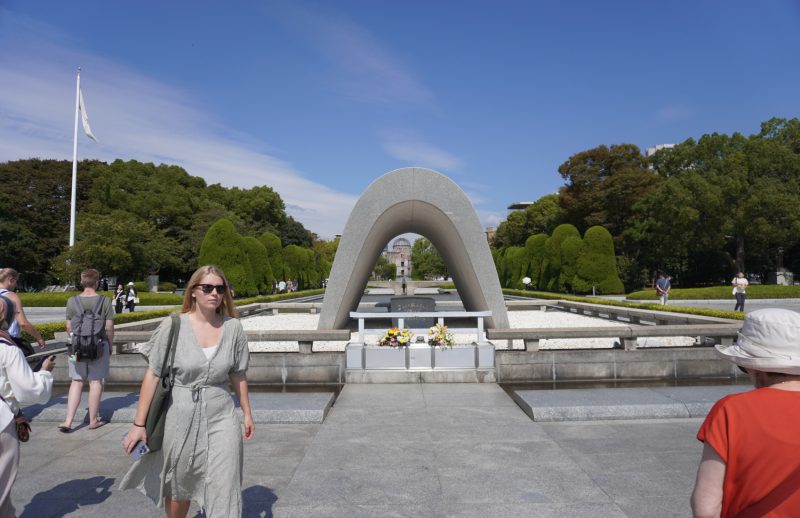
✔️Hiroshima cheat sheet:
- How to get around Hiroshima? If you’re serious about covering lots of ground in Japan, maybe start looking into a JR Pass. It makes sense to invest in it if you move around a lot, otherwise we would stick to single-trip tickets.
- Where to stay in Hiroshima? 2* WeBase Hiroshima — one of the more budget-friendly hotel options in Japan ($80 a night!) that we were lucky enough to experience during our last trip. Great location, as well as clean light rooms and spacious communal spaces make for a fantastic stay in Hiroshima.
- What to book in advance for your time in Hiroshima? A guided bike tour of the main tourist attractions is a great idea for the city where history is literally palpable when you’re exploring its streets. If you decide to kill two birds with one stone and explore both Hiroshima and Miyajima in one day, then a bus tour would be a perfect choice.
- Where to learn more about Hiroshima? Our detailed guide to Hiroshima should be more than enough to guarantee you have the best time in the city.
For me, visiting Hiroshima was a very moving experience. It felt strange to wander around streets that were completely and utterly destroyed when the A-bomb was dropped during WWII in 1945.
An entire city lost…
I couldn’t, and still can’t, grasp the enormity of that tragedy. When in Hiroshima, there are several places you must visit, to learn about the history of the city:

📍 The Atomic Bomb Dome : The atomic bomb dropped by the United States Army detonated about 600 meters above this building, which is why it's still (partially) standing. It's a vivid reminder of the tragic history of Hiroshima.
📍 The Children’s Peace Monument: This monument is dedicated to the children who died in the atomic bombing of Hiroshima.
📍 Hiroshima Castle : The original castle was also destroyed by the atomic bomb, but has been reconstructed perfectly (like you could expect anything less in Japan). Explore the museum inside (¥370 / $2,5), wander the gardens, and admire the view from the top of the caste.
Check out my Hiroshima itinerary .
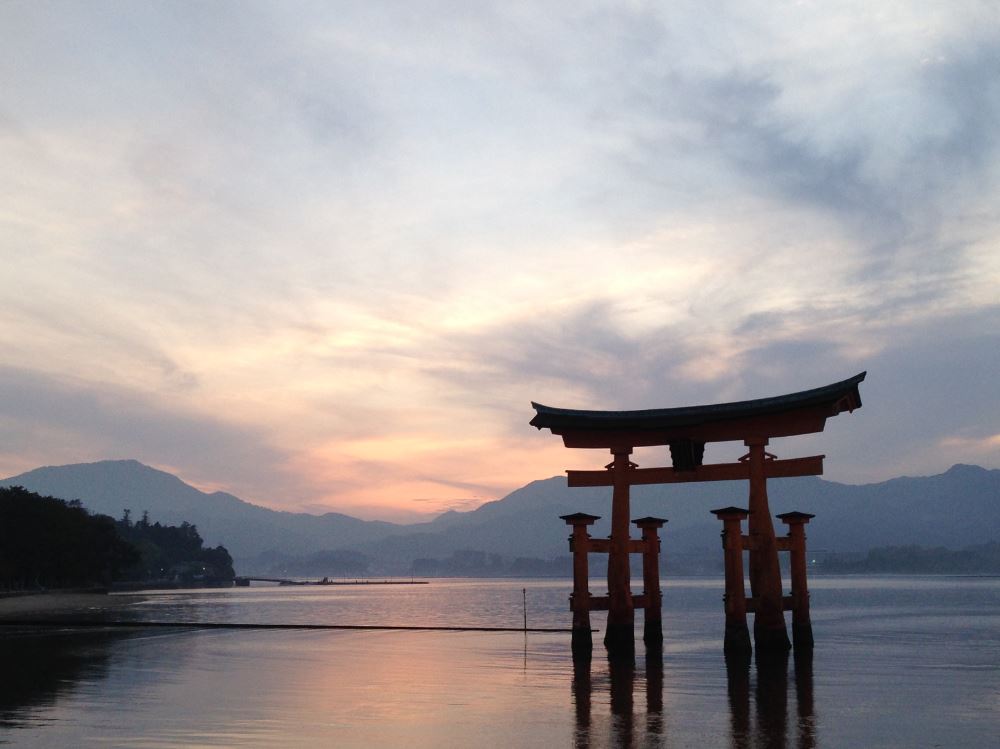
✔️Miyajima cheat sheet:
- How to get around Miyajima? First, you get on the island by ferry: From Hiroshima, take a train to the station nearest the pier — Miyajimaguchi Station, and then proceed onto the ferry. Both of these modes of transport are covered by JR Pass , so think about making this investment for your trip to Japan. While on the island, you can either rent a bike, walk, or hail a taxi — most of the sights are located quite close to each other, so you can see them in one day, easy.
- Where to stay in Miyajima? Accommodation options on the island are pretty out there, price-wise. However, you can find something affordable, if you look hard enough: Miyajima Guest House Mikuniya (from $70 a night) is a great choice for spending the night on the island.
- What to book in advance for your time in Miyajima? Apart from an obvious guided tour option, try and diversify your travel portfolio by booking a one-of-a-kind Kimono experience that comes clad with a tea ceremony and a calligraphy lesson.
- Where to learn more about Miyajima? Our Miyajima itinerary will make you want to start your Japan exploration with the island, but pace yourself: Good things come to those who wait!
From Hiroshima, we traveled to Miyajima Island (also called Itsukushima). Miyajima is a beautiful green island and a great place if you love outdoor activities like me.
Things to do are:

📍 Itsukushima Shrine and the ‘floating’ Torii gate : This is definitely the most popular tourist attraction on Miyajima Island. The shrine is built over the water and supported by pillars. If you can, time your visit with high tide and the sunset for an unforgettable view.
📍 Hike to the top of Mount Misen : Mount Misen is a 535 meters tall ‘mountain' on Miyajima Island. Three official trails lead to the summit, though you can also do part of the ascend by ropeway .
📍 Daisho-in Temple: This ancient temple was founded in the year 80. Don’t miss the multicolored sand mandala, the beautiful lanterns hanging from the ceiling of the Henjokutsu Ichigandaishi cave and the many little statues found all around the complex.
Check out my Miyajima Island guide .
Day 9 – 11: Kyoto, Nara and Koyasan

Both Nara and Koyasan are very interesting places to visit.
While Nara offers some of the most famous temples in Japan, Koyasan is considered a sacred place and remains a popular pilgrimage destination even today.
Moving on to a more “traditional” city in Japan (after all, it has been the country’s capital for more than a thousand years), we made our way to Kyoto.

✔️Kyoto cheat sheet:
- How to get around Kyoto? First, you need to know that the short trip from Osaka to Kyoto doesn't have to be by Shinkansen. You can get to Kyoto from Osaka station by train for 30 minutes and ¥580 / $4. When in the city, we did a lot of walking and occasionally hopped on the local trains to get to the shrines.
- Where to stay in Kyoto? Although during our last trip we still decided to keep Osaka as our home base and use Kyoto as one of our daytrip destinations, we can’t help but mention that there are great accommodation options in the city, and some of them pretty budget-friendly. Take 3* Tune Stay Kyoto (from $40 a night), for example, — it’s the best value hotel for the humble price tag in Kyoto! Clean rooms, great location, and excellent service will make you believe you’re paying hundreds of dollars for the experience.
- What to book in advance for your time in Kyoto? Exciting (and romantic) train (!) tour of Kyoto’s best sights , as well as a ticket to Kyoto Tower should be good enough to start your Kyoto adventure with.
- Where to learn more about Kyoto? Also known as the mother of all shrines, it’s easy to get lost in the myriad of sightseeing options of Kyoto (its “modern” side is pretty diverse as well). That’s why we encourage you to check out our Kyoto guide before commiting to the itinerary.
Kyoto with its many temples and other highlights was another great place to visit in Japan.
We strolled around the busy streets for two days (three nights) and didn’t nearly see everything there is to see in Kyoto…
🔹 2024 Update : Another trip to Japan meant a well-overdue overhaul of all things we’ve first experienced in Kyoto. Our daytrip from Osaka to Kyoto (this time we opted against moving our luggage back and forth between the cities) was full with sights and experiences! Remember though, that Kyoto’s landmarks are pretty scattered, so you will spend quite a bit of time commuting between them. Because of that, we recommend you try and shake things up with some sort of activity; kimono rental should do the trick!
I liked the vibe of this beautiful city and the gorgeous weather didn’t hurt either. And again, the food… Oh Japanese cuisine, I would travel back to Japan today for a bowl of abura soba or ramen!
In any case, when in Kyoto, definitely visit these places:

📍 Gion: Gion is the historic district of Kyoto, a maze of narrow streets and alleys lined with old (wooden) buildings, restaurants, cafes, and traditional teahouses. If you are lucky, you may even spot a real geisha!
📍 Kinkakuji (the Golden Pavilion): Possibly the most famous construction in Kyoto, this temple was originally the retirement villa of the shogun Ashikaga Yoshimitsu. Later it became a temple and with its golden exterior and splendid architectural style, it's highly worth a visit (¥500 / $3,5).
📍 Inari Fukushi shrine: For me, this was the highlight of our trip to Kyoto. You probably have seen many photos similar to the one pictured above (on the right), however, actually walking this famous path below the Torii gates yourself is a very special experience.
📍 Kyoto Tower : The best way to get the feel for the city you’re visiting is looking at it from above! We have no idea why a lot of people consider the tower tacky and “ugly” (maybe it has something to do with the way Kyoto is advertised: Its not all historic districts and shrines like the internet makes it out to be), since we quite enjoyed looking at this tall structure and going up to its observation deck (¥900 / $6). A bird’s-eye view of Kyoto is like nothing you would expect; it’s a perfect way to finish your day in the city with: All the lights of the bustling city streets paired with shaded mountainous horizon make for a mind-boggling picture!
Check out my Kyoto itinerary .

✔️Nara cheat sheet:
- How to get around Nara? First, consider investing in some sort of travel pass for a more hassle-free experience: An ICOCA IC Card with Kansai Thru Pass should do the trick.
- Where to stay in Nara? Nara is a mere half-hour ride away from Kyoto by Shinkansen, so you don’t have to look for accommodation here unless you really want to explore the area in detail (a daytrip is more than enough for Nara, at least it was in our experience). Still, it’s nice to know that should you decide to spend the night in Nara, there would be some appropriate accommodation options: 3* Centurion Hotel Classic Nara (from $50 per night) and 4* Henn na Hotel Nara (from $40 a night) are both amazing and budget-friendly choices!
- What to book in advance for your time in Nara? A day tour of Nara is a great way to get to know the city without doing too much planning yourself.
Nara, while far from a big city, is home to about 400.000 people and is most well-known for its temples and deer. And we saw plenty of both during our one-day visit to Nara.
Some of the main attractions in Nara are:
📍 Naramachi District: In the former merchant district of Nara, you can find traditional wooden houses, pretty little shops, art galleries, and much more. When strolling around this beautiful neighborhood, you will feel like you have stepped back in time.
📍 Todaiji : Todaiji roughly translates into the Great Eastern Temple, a fitting name for this huge and impressive temple. Housing the world's largest bronze Buddha statue, a visit to this temple should definitely be on your Nara itinerary (¥600 / $4).
📍 Nara Park : Go for a stroll in Nara Park, one of the oldest parks in Japan. Nara Park is home to hundreds of deer, which have become a symbol of the city. Several of Nara's highlights are located in the park as well, such as the aforementioned Todaiji, but also Kofukuji, and the Nara National Museum.
📍 Nara Kingyo Museum : If you enjoyed Osaka’s teamLab experience, then you will absolutely love this museum in Nara! However, it's not so much a museum per se, the exhibitions inside are all goldfish-themed (!) and are better described as backdrops for stunning Instagram pics. Get your Alice-in-Wonderland fix and leave with tons of content for your socials!
Check out this great guide to Nara for more details!

✔️Koyasan cheat sheet:
- How to get around Koyasan? You’ve probably gotten your ICOCA IC Card already (about time, you’ve spent more than a week in Japan as of right now!), so use it to get to/around Koyasan.
- Where to stay in Koyasan? Accommodation options are few and far between in Koyasan; and most of them are pretty expensive. Still, there’s a fantastic opportunity here if you want to spend the night — a temple stay experience! For a price of around $100, you can stay at a real functioning Buddhist temple — Mitsugonin.
- What to book in advance for your time in Koyasan? There’s not a lot of “bookable” activities in Koyasan, so make do with simply walking around and enjoying the scenery, free of charge!
- Where to learn more about Koyasan? We go into more detail about the area in our guide to hiking the Koyasan Chōishi-Michi trail .
From Nara, we traveled to Koyasan, or Mount Koya, to be exact.
We hiked the 24km Koyasan Chōishi-Michi pilgrimage trail, definitely a highlight of our trip. The fog drifting through the forest made the entire experience magical and mysterious…
And if our trip to Koyasan wasn’t perfect enough already, the next day was sunny with a clear blue sky.

Some of the places in Koyasan you must visit are:
📍 Okunoin : The oldest graves in this cemetery date back to the year 816. Okunoin is a UNESCO heritage site, with over 200.000 tombstones, many of them covered by thick layers of moss, and the Kobo Daishi's mausoleum.
📍 Garan: This is Koyasan's central temple complex. Pictured above is the 45-meter-high vermilion Konpon Daito Pagoda, one of the most impressive buildings within the complex (¥1000 / $6,8). Another notable building is the Kondo Hall, a large wooden temple used for important ceremonies.
📍 Daimon Gate : A magnificent two-story wooden gate that marks the end of the 24km Koyasan Chōishi-Michi pilgrimage trail. You'll be very happy to see this gate, it means you've finished your hike and made it all the way to Koyasan!
Check out my detailed guide to hiking the Koyasan Chōishi-Michi trail .
Day 11 – 18: Hokkaido (with and without a car)

Hokkaido is the northernmost island of Japan, and, in our opinion (though we may be biased), it's the most beautiful of the bunch. Famous for its flowering fields in the summer and the kick-ass slopes in the winter, it is a year-round destination that attracts tons of visitors from all over the world to the area.
- Speaking of tourists, maybe it's because the sights in question are quite remote or because they’re mostly set in vast natural landscapes, we didn’t feel suffocated by crowds, which is a fear many travelers have when visiting Japan.
Hokkaido is also every foodie’s dream: Their produce (particularly melons), seafood (crab and sea urchin), and milk-based foods (soft-serve ice-cream is the best in the biz on Hokkaido) will leave you full and happy!
The island, as naturally beautiful as it is in real life, can seem daunting to an unexperienced traveler: It’s not as “modern” as the rest of Japan. Even bullet trains go only as far as Hakodate (Hokkaido’s southernmost city, one of the few large cities on the island), and then it’s good old slow trains all the way to Sapporo.
Because of that, there are a couple of ways to enjoy Hokkaido: First, to set up camp in Sapporo and make use of the bus and train system to make day trips to notable locations in the vicinity, and second, to rent a car and have more freedom of choosing your destinations and change your plans on the go, depending on the weather.
Hokkaido without a car (Sapporo and daytrips from the city)

✔️Sapporo cheat sheet:
- How to get around Sapporo? Use the extensive Sapporo metro system and local trains.
- Where to stay in Sapporo? 3* Sapporo Tokyu REI Hotel (from $50 a night) — a perfect choice of a hotel that provides great value for the money. In Hokkaido, you won’t be spending too much time inside anyway: There’s so much waiting for you outside!
- What to book in advance for your time in Sapporo? All the day trips, obviously: We chose a tour to Noboribetsu and Lake Toya .
- Where to learn more about Sapporo? Our Hokkaido road trip itinerary has some unique insight into the city of Sapporo, so make sure to check it out before you go!
Most of you must have heard of Hokkaido’s capital through Sapporo Snow Festival (held each February, the ice sculptures of Sapporo are unlike anything we’ve ever seen) and the eponymous brand of beer — Sapporo. However, in true Japanese fashion, the city is practically teeming with possibilities to have the best time — high-end and vintage shopping, thousands of restaurants, and exciting landmarks.
Because of the time limits, we will focus more on the day trip destinations you can explore on the island — the city will still be waiting for you when you get back!
📍 Hill of the Buddha : A marvelous Buddhist temple set in the most picturesque of places. Surrounded by lavender fields, with Easter Island-esque statues and a Bond-villain-ey pond in the vicinity, the temple is a must-see if you love to be surprised and aesthetically pleased by what you’re witnessing.

📍 Lake Toya : Located about two hours away from Sapporo, Lake Toya is one of the largest caldera lakes in Japan (lakes formed in the hollowed out volcano). The scenery of the area is simply breathtaking; it helps to know that plenty of tours have the lake in their itinerary.
📍 Otaru : A quaint port town set within an hour’s drive from Sapporo. Famous for its charming canals and historic fishermen’s mansions (also called Herring Mansions), Otaru is a perfect daytrip destination for people who enjoy exploring a new city at a leisurely pace. Sometimes referred to as the Venice of Japan, Otaru is the town with the right amount of fun and history, without the crowds.
📍 Jozankei Onsen : A very popular destination in Hokkaido. The hot springs and autumn foliage create a unique setting for a day trip from Sapporo. Trust me, if you want to lose your onsen innocence, let your first time be at Jozankei Onsen: These hot springs will help you alleviate all the travel stress and long days spent exploring the country thus far.
📍 Asahiyama Zoo : A perfect answer to the question of what to do in Hokkaido with children — pay a visit to Asahiyama Zoo ! An activity that includes watching animals like penguins and polar bears is a win in our book.
Hokkaido road trip

During our very first trip here, I was already sold on Hokkaido when I was still on the plane (from Tokyo to Sapporo). From my window seat, I could see nothing but nature. And nature is what I love the most.
Cities are nice, but nature is best…
I loved our time on Hokkaido, the island is wild and untamed and completely blew me away with its natural beauty.
There are impressive volcanoes, extensive forests, and vast lakes. Also, it was cold! And I mean cold…

Hokkaido is a place where you'll be in awe but also grow healthy respect for nature.
The wind can be fierce and freezing, and we endured snow and hail but also got to enjoy days of sunshine and admire the famous cherry blossoms ( sakura ).

We explored Hokkaido by car, which in my opinion is the best way to get around this island.
We discovered places we wouldn’t have been able to visit if we didn’t have a car and each of those places was absolutely incredible.
A couple of the highlights of our Hokkaido trip were:
📍 Matsumae Castle: A beautiful traditional Edo-style castle surrounded by thousands of cherry blossom trees. Matsumae Castle is worth a visit during any time of the year but is particularly stunning during sakura.
📍 Furano: My favorite small town on Hokkaido with a myriad of things to do. You can visit a cheese or wine factory (or both), go for a hike, admire the vivid Blue Pools, and much more. Stay here for at least two nights if you have time!
📍 Shikisai no Oka : The most Instagrammable destination on the island, with vast rolling hills covered in a patchwork rotation of flowers. Amsterdam’s tulip fields don’t stand a chance in front of Shikisai no Oka! Don’t believe me? Come here and decide for yourself!
Check out my Hokkaido road trip guide .
Day 18 – 28: Tokyo

✔️Tokyo cheat sheet:
- How to get around Tokyo? There are quite a few pass options you can look into: Tokyo Subway Ticket for unlimited rides, or a Welcome Suica Pass .
- Where to stay in Tokyo? We chose 3* Almont Inn Tokyo Nihonbashi (from $55 a night) — a great hotel within walking distance of Ginza, one of our favorite neighborhoods in Tokyo . From Pokémon to Godzilla, early morning fish markets, and high-end shopping, — Ginza will always leave you wanting more!
- What to book in advance for your time in Tokyo? Tokyo Sky Tree and Shibuya Sky admission tickets, as well as possible day outings to Warner Bros. Studio ( The Making of Harry Potter ) and Mt Fuji .
- Where to learn more about Tokyo? Our 7-day itinerary is the ultimate guide for all things Tokyo, check it out!
Of course, no visit to Japan is complete without exploring Tokyo.
The city of flashing neon, Lolita dresses and other quirky looks , hidden alleys, ancient temples, the famous Tokyo Sky Tree , and the most Michelin stars of any city in the world. Tokyo offers days (or should I say months) of activities.
Tokyo is the most populous metropolitan area in the world. While the city center can be extremely busy at places like Tokyo Station and Shibuya Crossing, there are also much more quiet areas, like lovely Ueno Park.
We've visited Tokyo several times, twice for several days and once during a stopover. During our last visit we were lucky enough to spend an entire week in Tokyo, which was definitely the highlight of our entire Japan experience! With each trip, we discover more to see and do in this unique capital, mixing ultramodern and ancient traditions!
Some of the top things to do are:

📍 Asakusa and the Senso-Ji Temple : Don't miss this beautiful historic neighborhood in Tokyo. Here you can find quaint little streets, boutique shops, and the impressive Sensō-Ji temple.

📍 TeamLab Digital Art Museum: This amazing interactive museum creates a fairytale world filled with light and colors. Be sure to buy a ticket online (¥3800 / $25) as they often sell out! It’s also good to note that the neighborhood adjacent to the museum — Odaiba — is definitely worth a detour during your visit to the area.

📍 The Tokyo Sky Tree: The Tokyo Sky Tree is currently the third-tallest building in the world (after Burj Khalifa in Dubai and Merdeka 118 in Kuala Lumpur). It is still, however, the tallest tower in the world! There are two observation decks, one at 350 meters and at 450 meters high, offering impressive views over Tokyo city. Book your ticket online (¥1800 / $12 ) to save money and skip the queue .
📍 Shibuya Sky : Another viewpoint with stunning views of Tokyo. Come here if you haven’t secured the very sought-after Tokyo Sky Tree ticket and enjoy your time with less crowds and more open city panoramas. Book your ticket here (¥2200 / $15) and don’t forget to learn more about Shibuya neighborhood in this article .

📍 Daytrips from Tokyo : After you’ve exhausted all the main city attractions (although it’s quite an impossible task, just look at our week in Tokyo itinerary here , it’s time to look outside Tokyo limits! Warner Bros. Studio Harry Potter (¥6300 / $42), Tokyo Disney Resort Park (¥8400 / $56,5), and Mt Fuji are the top choices that you can start with. Although we doubt you’ll have the time or energy for more — each of these locations requires an entire day to experience!
Check out my Tokyo itinerary and what to do in Tokyo with kids .
Day 28 – 33: The Japanese Alps

✔️The Japanese Alps cheat sheet:
- How to get around the Japanese Alps? Bus passes (some with add-ons like a ropeway ticket included) are the most obvious transportation options, in our opinion.
- Where to stay in the Japanese Alps? Depending on how much of your travel budget is left after an entire month in Japan, you can either treat yourself to a luxurious stay in 4* Takayama Green Hotel (from $120 a night) or resort to spending the night at 3* Alpico Plaza Hotel (from $40 per night). What will it be?
- What to book in advance for your time in the Japanese Alps? If you’re unsure how to navigate the many towns and locations that make up the Japanese Alps, an organized day tour will be the perfect way to go about it!
- Where to learn more about the Japanese Alps? Our Japanese Alps itinerary will make even the idlest homebodies into avid hiking enthusiasts in record time, that’s a guarantee!
Though our entire trip around Japan was amazing, the Japanese Alps were definitely one of my favorite areas. After all, getting outside city limits is one of the crucial tips to enjoying your time in Japan to the fullest (what are other things you should know before traveling to the Land of the Rising Sun?)
I love mountains, though unfortunately, we don’t have any near my home town. I also love hiking and this is something we did a lot in the Alps.

We started our journey through the Alps in Kanazawa to stroll around the lovely Kenruko-en garden.
Shirakawa-go
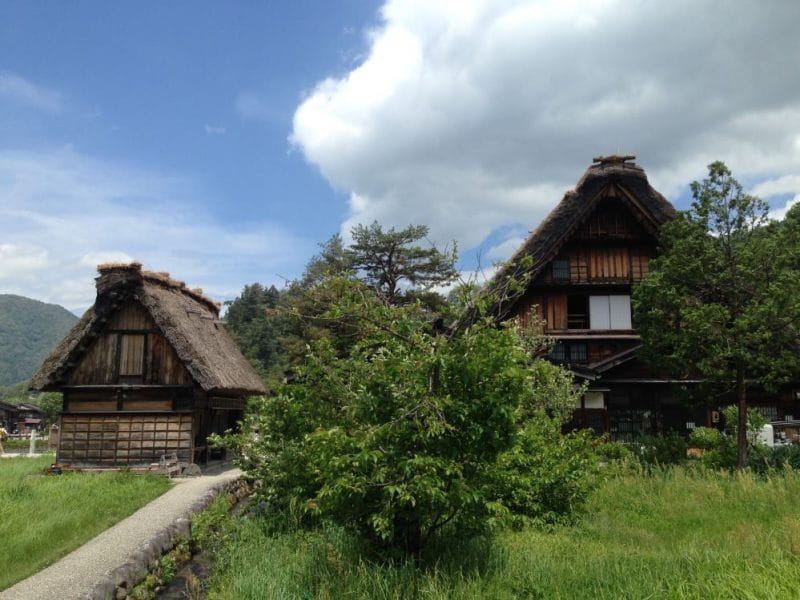
The next day we got on a bus to Shirakawa-go, famous for its traditional gassho-zukuri farmhouses, some of which are more than 250 years old!
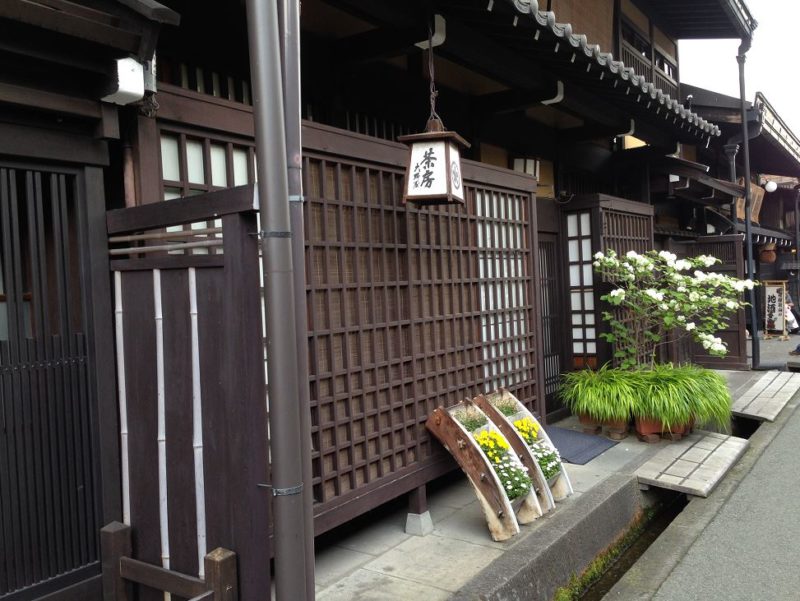
The next city on our Alps itinerary was Takayama, where we explored the old neighborhoods and Hida Folk Village.

The absolute highlight of our Japan trip was Kamikochi, one of the most beautiful places I have ever seen.
I spent three days in Kamikochi. We were surrounded by stunning mountains and scaled a volcano (Mount Yakedake).
We slept in our little tent at a very well-managed campsite and wandered around the valley. Suffice it to say, I was completely and utterly happy.
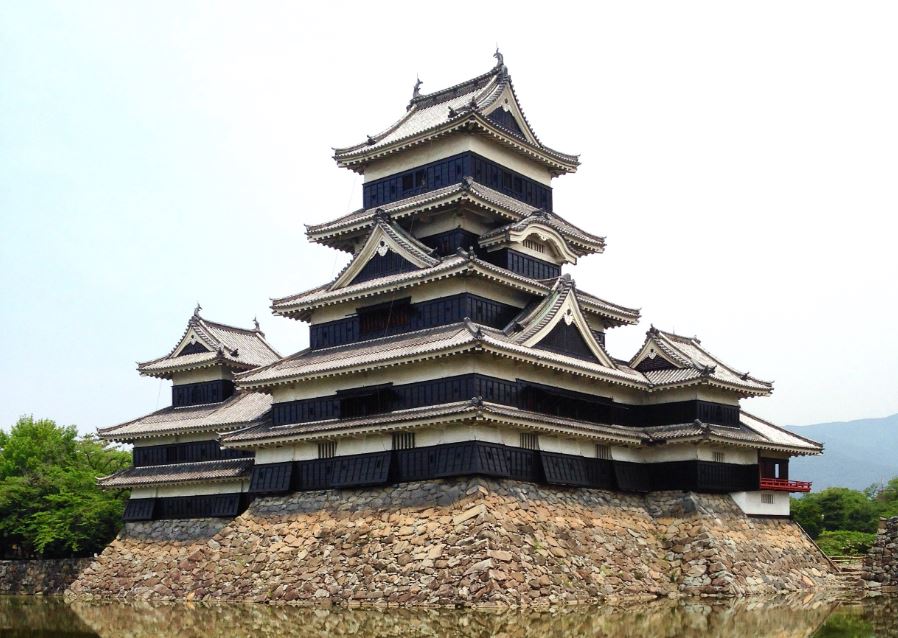
Last but not least we visited the beautiful castle in Matsumoto, one of Japan's most famous and well-preserved historic castles.
During our second trip to Japan, we spent 3 nights in Matsumoto, it's a very convenient hub to explore the Japanese Alps and a nice city as well.
Check out my Japanese Alps itinerary and Kamikochi camping and hiking guide .
Day 34: Goodbye Japan…

Our flight back home was from Tokyo, so we changed the snowy mountain peaks for bustling city streets for our last day here. I was sad to leave because we had such an amazing month in Japan…
From the wilds of Hokkaido with its hauntingly beautiful nature and its bitter cold to the tragic and terrible history of Hiroshima.
From the floating Tori gate of Miyajima to the peaks of Kamikochi, the temples in Kyoto , and the mysterious forest of Koyasan, it was a wonderful trip. And that’s not even taking into account all the delicious Japanese food!
Japan is an amazing country and I highly recommend adding Japan to your travel bucket list, you won't regret it.

Alternative Japan itineraries (7 and 10 days + 2 and 3 weeks)
Japan itinerary 7 days.
If you just have 1 week in Japan, don’t worry! While you cannot see everything the country has to offer, you can get a taste and feel of the country. Here is my suggestion for a 7-day Japan itinerary:
- Day 1-2: Explore Tokyo
- Day 3: Make an easy day trip from Tokyo to Mount Fuji (one of the most popular destinations in Japan), Kamakura , or Nikko
- Day 4: Take the Shinkansen to Kyoto (2 hours and 15 minutes) and explore Kyoto
- Day 5-6: Explore Kyoto
- Day 7: Return to Tokyo and fly home (you can also fly out from Osaka)
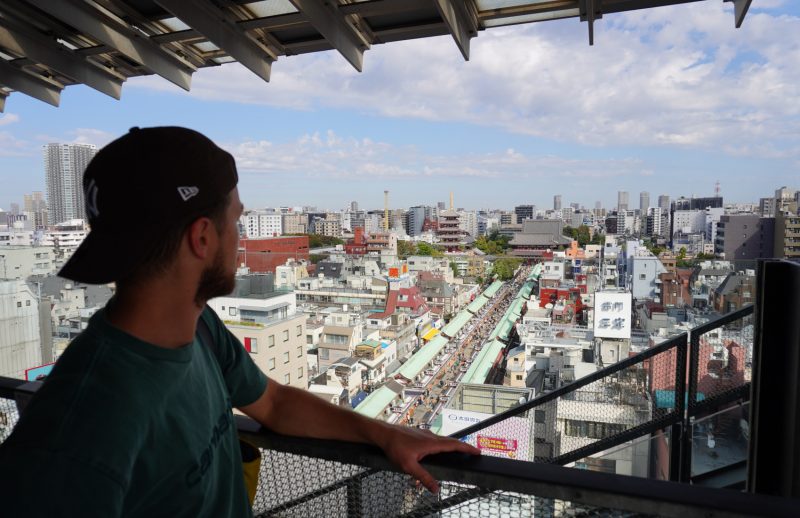
10 day Japan itinerary
This Japan 10-day itinerary includes big cities such as Tokyo and Kyoto, but also the beautiful nature of Koyasan and the famous temples (and deer) in Nara.
This Japan 10 days itinerary isn't too fast-paced, however, you will get to visit five very different places in Japan:
- Day 3: Make a day trip from Tokyo to Mount Fuji , Kamakura , or Nikko
- Day 5-6: Explore Kyoto
- Day 7-8: Hike the Koyasan Chōishi-Michi pilgrimage trail and explore sacred Koyasan
- Day 9: Visit Nara
- Day 10: Fly home from Osaka

Japan 2 week itinerary
This 2 week Japan itinerary includes the major highlights of Japan, without rushing around the country.
During your 2 weeks in Japan, you'll visit the major cities of Tokyo, Kyoto, and Hiroshima and get to enjoy some beautiful nature (and temples) in Koyasan and on Miyajima island.
- Day 1-3: Explore Tokyo
- Day 4: Make a day trip from Tokyo to Mount Fuji , Kamakura , or Nikko
- Day 5: Take the Shinkansen to Kyoto (2 hours and 15 minutes) and explore Kyoto
- Day 6-7: Explore Kyoto
- Day 8-9: Hike the Koyasan Chōishi-Michi pilgrimage trail and explore sacred Koyasan
- Day 10-11: Travel to Hiroshima and learn about the tragic history of the city
- Day 12-13: Go hiking on Miyajima island and admire the famous floating Torii gate
- Day 14: fly home from Osaka

Japan 3-week itinerary
With this 3 week Japan itinerary, you get to experience very different sides of Japan. You’ll explore several interesting cities, spend a night in Koyasan, and hike around the Japanese Alps.
When you have 3 weeks in Japan, I suggest the following route:
- Day 10-11: Visit Nara
- Day 12-13: Explore Osaka
- Day 14-20: Travel around the Japanese Alps (Kanazawa, Shirakawago, Takayama, Kamikochi, and Matsumoto)
- Day 21: Fly home from Tokyo

Plan your Japan trip like a pro with these tools: ✅ Get a Japan Railpass to save lots of time and money. ✅ Rent a car for your Japan road trip via Rentalcars.com . ✅ Stay connected with Airalo Japan offer . ✅ Plan your journey with the Japan Lonely Planet . ✅ Find the best hotel deals on Booking.com . ✅ Join the best tours in Japan via Klook . ✅ Travel safely and get reliable travel insurance from Safety Wing .
Important things to know when planning a trip to Japan
What is the best time to visit japan.
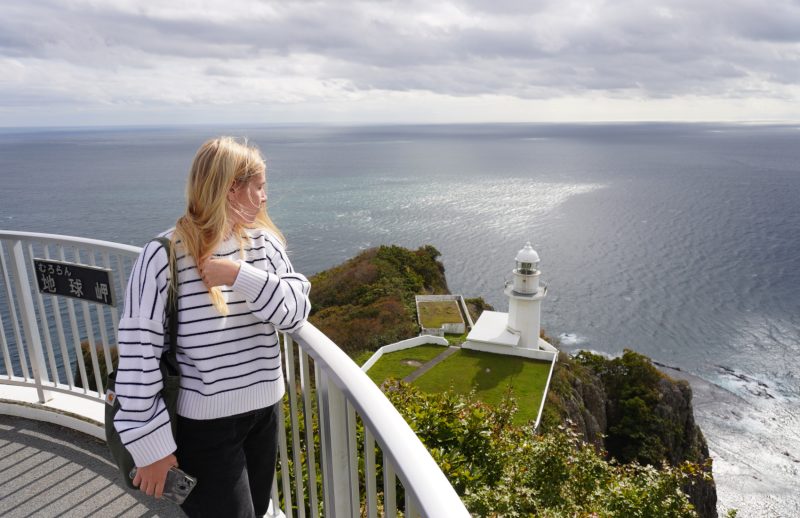
While Japan is a year-round destination, the best and most popular times to visit are March – May and September – November .
Sakura (the famous cherry blossom season) is very important in Japan and there is even a daily Cherry Blossom report with up-to-date information on where the flowers are at their most beautiful.
The changing color of the leaves in Autumn is almost equally popular, there is a daily report to monitor this as well.
We visited once in late April-May and once in October and had very comfortable temperatures and mostly sunny weather.
The winter months can be extreme with freezing temperatures and lots of snow, especially in the Alps (Honshu) and on Hokkaido. That being said, if you want to go skiing or visit the famous Sapporo snow festival, consider planning a winter trip to Japan .
The summer months are hot and humid and not the most comfortable time to visit Tokyo or Kyoto. Be sure to pack appropriately !

Which currency is used in Japan?
The official currency in Japan is the Japanese Yen (¥). Here you can find the current exchange rates, at the time of writing €1 is approximately ¥160 and $1 is around ¥150.
How to travel around Japan?
Japan has an excellent public transport system and is famous for the shinkansen , also known as the bullet train (pictured below).
During both our trips to Japan, we mostly traveled by public transport (train, bus, MRT, and ferry).
Travel by train in Japan

If you plan on covering large distances in Japan within a short period of time, I highly recommend buying the Japan Rail Pass .
This pass gives you unlimited trips on all JR trains, JR buses, and several other lines. You can choose a pass valid for 7, 14, or 21 consecutive days.
While the Japan Rail Pass offers great value for money it may not always be the most economical option for your trip. It's worth calculating the costs of your itinerary to Japan with and without the rail pass to see which option is best for you.
You can use Hyperdia to check the costs of your intended Japan itinerary and decide whether or not the JR Pass is worth the money for your trip.
Rent a car in Japan

If you plan to visit the more remote areas in Japan, public transport isn't your best bet. For our road trips to Hokkaido and Shikoku, we rented a car .
The public transportation network on these islands isn't as great as on Honshu, plus, driving on these islands is an awesome experience. Read more about driving on Hokkaido here .
Which car rental service is the best? If you're looking for a car rental service for your trip, I recommend Rentalcars . I've used this international car rental booking service myself many times and you'll definitely find the most appropriate car for your Japan itinerary. >Click here to rent your car .

Where to stay in Japan on a budget
I have to admit I was slightly worried about finding affordable accommodation before traveling to Japan , the country of the rising sun.
This is why I searched Agoda , Booking , and Tripadvisor meticulously to find the best possible options.
While we definitely spend more on accommodation during our Japan family trip than when we were backpacking Japan as a couple (with a tent), I can say from personal experience that it is possible to find (relatively) cheap places to stay in Japan.
But let's also face the fact that prices in Japan are not like in Southeast Asia, you won't be able to find a pretty pool villa for €25 a night…
Read more about our Japan travel budget here.
The best budget tip to save on accommodation in Japan
Go camping! During our first Japan trip, we brought a small tent and stayed at several campsites around Japan, which were only $10-$15 a night.
Another advantage is you get to wake up with views like the one in the picture below.
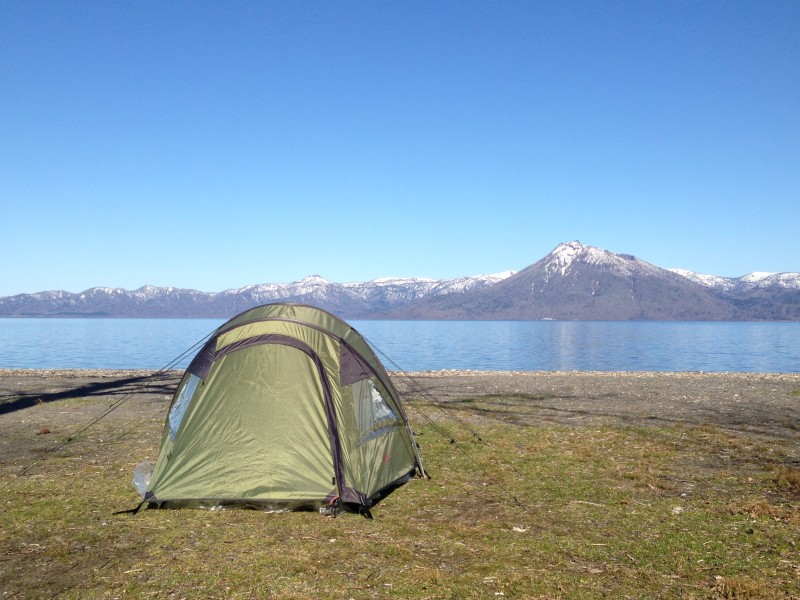
Here is a list of all the places we stayed during our travels around Japan.
* Read more about our stay at Cando Hotel Shimbashi here .
** Unfortunately the accommodation we stayed at in Furano during our Hokkaido trip is no longer available. While we didn't personally stay at the Shin Furano Prince hotel we did visit their spa twice during our time in Furano.
Note: Prices for the hotels, campgrounds, and guesthouses depend on the time of year and how far in advance you book. Click ‘book here’ to see the latest prices on Booking and book ahead to get the best deal.
Golden Week
Golden Week is the period from the 29th of April to early May and includes a number of Japanese holidays.
During this week many Japanese people go on holiday and accommodation can be extremely difficult to find.
If you are traveling in peak season and Golden Week in particular: book your accommodation in advance !
During our first trip to Japan, I was looking for accommodation for a night during Golden Week. I have never seen Agoda and Booking come up with only 2 available hotels in an entire city, the cheapest one was €400 a night…
I was very happy to have our tent and car as backup options!
Japan recommended itinerary: in conclusion
I hope this post has given you an idea of what to see in Japan, you can download the map of our Japan one-month itinerary below.
If you have any questions, leave a comment or send me a message .

This post was updated in February 2024 .
Friday 27th of October 2023
Well it’s now 2023, ( what happen to 2020 - 2022, I wonder, little virus, unfortunately ? ) and we are thinking October 2024, I hope nothing has changed . Great article .
Sunday 4th of September 2022
Is there anything to consider when renting a car in Japan? Or something you have to do in advance that you are allowed to rent a car at all? I am planning to go on a road trip with my friends.
Tuesday 6th of September 2022
Hey Cedric,
Thanks for reading! Regarding your question, you may want to check out my guide to driving on Hokkaido: https://www.phenomenalglobe.com/driving-on-hokkaido-japan-road-trip/. Many of the tips mentioned here are applicable for entire Japan. Most importantly: don't forget to bring a Geneva Convention International Driver’s Permit. You must have one in order to rent a car.
Have a great trip and let me know if there's anything else you need help with! Lotte
Wednesday 6th of January 2021
Fantastic itinerary. I will keep this in mind for the next time I travel:-)
Thursday 7th of January 2021
Thank you Daniel, let's hope we can travel (safely) again in the near future:-)
Sunday 8th of September 2019
Did you get any vaccinations for your trip to Japan? Specifically, for Japanese Encephalitis?
Cheers, Brendon
Monday 9th of September 2019
Hi Brendon,
Thank you for your email and we didn't get any vaccines specifically for Japan. However, we already had many vaccines (Hep A&B, MMR and tetanus etc). We did not get the Japanese Encephalitis vaccines, though I'm no medical expert so I don't feel qualified to give any advice regarding health issues. I recommend to check with your doctor and discuss the pros and cons with him/her:-). Have a great trip to Japan!
Thursday 13th of June 2019
Hello! I am wondering how you contacted the campsite in Miyajima. Thank you so much for this blog! It’s really helped a lot!
Very welcome! I actually didn't contact the campsite, we just showed up:-) Sorry I can't be more help. Have a great trip!
The Travel Sisters
7 days in japan: the perfect itinerary for first time visitors.
by Patti | Jun 23, 2018 | Destinations | 5 comments

7 Days in Japan Itinerary for First Time Visitors
With 7 days in Japan, we recommending focusing on Tokyo and Kyoto . If you like to pack in a lot on your travels, we recommend adding a few day trips.
Disclaimer: This article contains affiliate links. We may make a small commission if you make a booking using our links at no extra cost to you . See our Disclosure page for more information.
Day 1 – Tokyo
Tsukiji Fish Market

If your body is on a different time zone, your first day in Tokyo might be the best day for an early morning visit to the Tsukiji Fish Market , the biggest wholesale fish and seafood market in the world. Make sure to catch the tuna auction – spots are limited so you need to arrive at 3:00 am in the morning! After watching the tuna auction, make sure to enjoy some fresh sushi for breakfast. If you want to guarantee catching the tuna auction it might be easier to sign up for a tour here .
Sensōji Temple (or Asakusa Kannon Temple)

Visit the famous Sensōji (or Asakusa Kannon Temple) in Asakusa. Although the temple and surrounding area is very busy and packed with tourists, it is still a Tokyo must see.
The walk to Sensōji, Nakamise Dori, is lined with small shops selling various souvenirs. This is a good spot to knock out your souvenir shopping.

Spend a few hours in Akihabara, a district in Tokyo famous for its many electronics shops. One of the popular things to do in Akihabara is to visit a maid cafe .
Day 2- Tokyo
Meiji Shrine/ Omotesando/ Yoyogi Park/Harajuku

If you enjoy window shopping take a walk on Omotesando which is a broad, tree-lined street that houses various top designer boutiques. As Omotesando comes to an end you will reach Yoyogi Park , a great spot for people watching.
Also nearby is the famous Harajuku neighborhood. The main action is at Takeshita Dori, which is a short pedestrian walkway. Here you will see shops selling clothes for teens, and lots of Japanese youth and girls wearing Harajuku style.
Make sure to also visit the Meiji Shrine which is located right next to the Harajuku station.
Shibuya Crossing

Shibuya Crossing is huge famous pedestrian intersection. While you are at Shibuya do not miss the statue of Hachiko . The statue is a popular meeting point for Tokyo residents and a good spot for people watching. The statue was erected in honor of Hachiko, who was a loyal dog that faithfully came to fetch his owner at the train station each day (even after his owner passed away).

Tokyo can be hectic so visiting a park is a nice way to spend a couple of hours during your time in Tokyo. One of the most beautiful parks in Tokyo is Shinjuku Gyoen National Garden which consists of three different types of gardens: traditional Japanese, formal French and an English garden. Home to a large number of cherry trees, it is a popular but also peaceful spot for hanami (cherry blossom viewing) during the spring cherry blossom season .
Day 3 -Tokyo or Day Trip to Jigokudani Snow Monkey Park
Now that you have seen the major sites in Tokyo, you can have some fun and do some of the unique things to do that Tokyo is known for. Another option (especially if visiting in the winter) is to do a day trip to Jigokudani Snow Monkey Park to see the famous snow monkeys. The best time to visit the snow monkeys is early in the morning.

Watch a Sumo Wrestling Tournament or Sumo Practice

Sumo is Japan’s national sport. Attending a sumo grand tournament is a fun and cultural experience we would recommend to anyone visiting Japan during the tournament.
The sumo tournament runs in Tokyo for 15 days at a time during January, May and September (exact dates vary each year). If you visit Tokyo outside of these dates, consider visiting a sumo stable to watch a sumo wrestling practice .
(If you are interested in attending a sumo wrestling match, check out our Tips for Watching Sumo Wrestling in Japan for the schedule, advice on finding tickets, choosing seats and other information that we think is helpful.)
Have a drink or meal at a themed café or restaurant

Tokyo is full of some interesting cafes from various animal cafes (cat cafes, dog cafes, owl cafes , rabbit cafes and a hedgehog cafe ) to maid cafes and even a robot restaurant . Read about our visit to a bunny cafe here .
Where to Stay in Tokyo
These are our top choices for every budget:
Grand Hyatt Hotel. This is a great hotel in Tokyo for those looking for a luxury experience or have hotel points to use. The Grand Hyatt Hotel has a great location and gets great reviews on tripadvisor. Click here to see the latest prices or read Tripadvisor reviews .
Park Hyatt Tokyo. This luxury hotel in Shinjuku is the hotel in the travel movie , Lost in Translation. Click here to see the latest prices or read Tripadvisor reviews .
Akasaka Excel Hotel Tokyu. This midprice hotel is where we usually stay in Tokyo. The location is super convenient -it is in the same building as a 7-11 and several restaurants and it is also across the street from the Akasaka-Mitsuke subway station with underground access to five different lines. Click here to see the latest prices or read our full review .
The Prince Park Tower Tokyo. This midprice hotel get good reviews. It has a great location and also offers a free shuttle to the closest train station. Click here to see the latest prices or read Tripadvisor reviews .
Richmond hotel Asakusa. This small modern hotel is located in a great location in Asakusa walking distance to the famous Sensōji Temple. Click here to see the latest prices or read Tripadvisor reviews .
Red Planet Asakusa. This newly built hotel also has a great location in Asakusa and offers great views of the Tokyo Skyline and Sky Tree from some rooms. Click here to see the latest prices or read Tripadvisor reviews .
Day 4 – Train from Tokyo to Kyoto
The fastest way from Tokyo to Kyoto is the Shinkansen (bullet train) on the Tokaido Shinkansen line.
There are three options: the Nozomi, Hikari and Kodama. The Nozomi is the most frequent and the fastest train with a travel time of 2 hours and 20 minutes but it is not covered by the Japan Rail Pass . If you wish to use the Japan Rail Pass , the best choice is the Hikari which takes 2 hours and 40.
If you do not have a Japan Rail Pass, the fare is 13,080 yen one way.
To search for times and prices visit www.hyperdia.com .
Keep an eye for Mt. Fuji.

Day 5 – Kyoto
Fushimi Inari Shrine

Take the train to southern Kyoto to see Fushimi Inari Shrine , one of the most popular attractions in Kyoto. The Fushimi Inari Shrine is an important Shinto shrine famous for its thousands of vermilion torii gates. The Fushimi Inari Shrine is always open and admission is free.
At the back of the shrine’s main grounds is the entrance to the torii gate covered hiking trail which goes up to the summit of the mountain. You can hike all the way to the top of the mountain which takes about 2-3 hours roundtrip but you can turn back any time. Most visitors just do the shorter hike through the clustered torii gates (approximately 30 minutes) to the Yotsutsuji intersection roughly half way up the mountain which has a great view of Kyoto. The rest of the hike is less crowded but there are less gates and there is not that much more to see. I recommend doing just the shorter hike as there are other places to walk in Kyoto.
Eastern Kyoto

After seeing the Fushimi Inari Shrine head to Eastern Kyoto which is a historic part of Kyoto full of temples, shrines, gardens and shops to get a taste of traditional Japan. I recommend starting with Ginkakuji (the Silver Pavilion) a Zen temple that despite it’s name is not silver or covered in silver.
From Ginkakuji you can access the start of the Philosopher’s Path, a pedestrian path that follows a canal lined by hundreds of cherry trees. In April, this is one of the best places in Kyoto to see cherry blossoms. Near the end of the Philosopher’s Path are Eikando Temple (one of the most beautiful places for autumn foliage in the fall) and Nanzen-ji Temple (a zen temple with a beautiful rock garden). The Philosopher’s Path is about 2 km long and takes about 30 minutes but you can spend more time visiting other temples and shrines along the way.

If you are still up for more walking after the Philosopher’s Path, head to the Heian Shrine (orange shrine), followed by Kodaiji Temple and then Kiyomizudera . Otherwise take a taxi directly to Kiyomizudera in the Higashiyama area which is famous for its large wooden terrace and amazing views of Kyoto. If you can time it and don’t mind the crowds try to visit Kiyomizudera during sunset for beautiful photos.

In the late afternoon or evening, head to the ancient geisha district of Gion . Gion is known for its traditional wooden houses and is filled with restaurants, shops and tea houses. Kyoto Free Walking Tour has free morning and early afternoon walking tours of Gion and Higashiyama districts.
Gion is also the best place in Kyoto to spot geishas and their apprentices (called maiko) and you will see many tourists waiting around to photograph them. We spotted several geishas on or near Hanami-koji street. The best time to spots geishas is around dusk (5-6pm) when geisha are on their way to their appointments at tea houses. Real geishas are pretty elusive and avoid tourists – you might spot them entering a taxi or one of the buildings. If you see geishas posing with tourists or stopping for photos they are not real geishas, they are tourists dressed up as geishas .
The tea houses are not open to the public but you could book a tour which includes entry to a teahouse and time with a maiko .
After spotting geishas, you can cross the Kamo River and head to Pontocho , a narrow pedestrian only street that runs along the bank of the river and lined with restaurants and bars. In the summer many of the establishments build platforms extending over the Kamo River so you can dine outside.
Day 6 Arashiyama and Northern Kyoto
Sagano Bamboo Forest

Take the train west to Arashiyama to view the famous and beautiful Sagano Bamboo Forest . It gets very busy so I recommend visiting early in the morning. You don’t need a lot of time if you are only visiting the forest as it is not very big but you will need a half or full day if you also visit the nearby monkey park. From the train station, the bamboo forest is a short walk through the town passing shops and restaurants.
Iwatayama Monkey Park
After the bamboo park you can walk to the Iwatayama Monkey Park to see Japanese macaque monkeys. Located in the Arashiyama mountains, the walk to the monkey park is an approximately 20-30 mins steep hike uphill from the bamboo forest. Once you reach the top you will find tons of monkeys roaming around and there are also great views of the city. You can purchase food to feed the monkeys.
Kinkakuji (Golden Pavilion)

From Arashiyama, you can take the train to Northern Kyoto and then take a taxi or bus to the iconic Kinkakuji temple (Golden Pavilion). Kinkakuji overlooks a large pond and you can take photos of Kinkakuji with its reflection in the pond.
Ryoanji Temple
Ryoanji Temple is another temple located close to the Golden Pavilion which has a famous Zen rock garden. Personally, I though the garden was a bit overrated but it was packed with tourists during my visit.
Okonomiyaki Katsu
After visiting Ryoanji Temple, I recommend heading to the nearby Okonomiyaki Katsu restaurant which is located in a residential neighborhood nearby. It is owned by a Japanese couple gets great reviews and their specialty is okonomiyaki . Their website is in Japanese but check their times as they are only open for lunch and dinner and are closed on Wednesdays.
Day 7 Central Kyoto and Day Trips
If you ran out of time, visit any temples you missed today in the morning. Then head to Nijo Castle in Central Kyoto.
Nijo Castle
Located in central Kyoto, Nijo Castle is easily accessible by subway. Nijo Castle is large but easy to explore so I would allow an hour or two to enjoy at leisurely pace. In addition to its beautiful art, Nijo Castle is famous for its squeaky floors (not because they are old they were designed to make noise to alert for intruders).
Nishiki Market
After sightseeing in the morning head to Nishiki Market for lunch. Nishiki Market is a narrow shopping street lined by shops and restaurants selling fresh seafood, produce, and even souvenirs. Nishiki Market is a good place to wander around and spend hours sampling Japanese food. If you would like some guidance, you can book a food tour .
Day Trip to Nara
If you have time today, your last day in Kyoto might be a good time to take a day trip to Nara. Nara is the ancient capital of Japan and is famous for Buddhist temples, shrines and the famous Nara deer park. You can visit Nara in half a day .
Head to Osaka/Tokyo
If you are flying out of Osaka instead of heading back to Tokyo, you might want to head to Osaka early and explore Osaka a bit.
Where to Stay in Kyoto
Kyoto has many great ryokan (traditional Japanese inns) so consider if you would like to stay at a ryokan instead of a western hotel.
These are our top picks for the best hotels and ryokan in Kyoto for every budget.
The Ritz-Carlton, Kyoto. This is our top pick if looking for a hotel luxury experience. The Ritz-Carlton, Kyoto has a great location in Central Kyoto close to Gion and Pontocho and gets great reviews on tripadvisor. Opened in 2014 as the first luxury urban resort in Japan, The Ritz-Carlton is on the banks of the Kamogawa river with views of the Higashiyama mountains. The resort features four restaurants and bars, spa, pool, free wi-fi, in room refrigerator and some rooms have river views. Click here to read Tripadvisor reviews .
Arashiyama Benkei . Traditional Japanese Ryokan located in a beautiful area in Arashiyama near the river. It is not as centrally located but is close to the famous bamboo forest and monkey park. Click here to read Tripadvisor reviews .
Citadines Karasuma-Gojo Kyoto. Citadines Karasuma-Gojo Kyoto has serviced apartments with a kitchenette and free wi-fi. It has a convenient location close to a train station (one stop from the Kyoto Train station), supermarket and restaurant. Click here to read Tripadvisor reviews .
Hokkaikan Ohanabo. This midprice ryokan is in a great location within very close walking distance to Kyoto Station. Click here to read Tripadvisor reviews .
Hotel Gran Ms Kyoto. Very affordable hotel in a convenient location close to Nikishi Market and subway. Click here to read Tripadvisor reviews .
Ryokufuso. Affordable ryokan near train station. Click here to read Tripadvisor reviews .
Getting Around Japan
• The best way to get around Tokyo is by the efficient and comprehensive metro system . If you plan to take the subway more than a couple of times, you might want to purchase a PASMO card . PASMO is a prepaid reloadable smart card that you can use for trains and buses without having to calculate and pay a separate fare each trip. You can purchase a PASMO card at airports or train stations.
• Consider whether you need to purchase a Japan rail pass before heading to Japan. Japan Rail Pass is a multi-use discounted ticket, valid for travels on all JR national trains in Japan, including Shinkansen bullet trains and Narita Express . You can select 7, 14 or 21 consecutive validity days. A 7 day rail pass is $262 USD which is about the price of a round trip between Kyoto and Tokyo. If you are flying into Tokyo and out of Osaka and only taking the train between Tokyo and Kyoto you won’t need the pass.
Tips for Visiting Japan
• Most Japanese ATMS don’t work with foreign ATM cards. To find ATMs that work head to the nearest 7-11.
•Not sure when is the best time to visit Japan? To help you decide before you book your trip see related post: The Best Time to Visit Japan .
• Want to be sure you are prepared for your trip to Japan? See related post : Planning a Trip to Japan: Essential Tips to Prepare for Your First Trip to Japan to help you plan and prepare for your first trip to Japan.
Hope you enjoyed our 7 day Japan itinerary . Have you been to Japan? If so, what would you do in 7 days?

I would love to visit the Hachiko statue and see the snow monkeys as well as a bunch of other things on this itinerary. Japan is totally on my bucket list.
I spent one day in Tokyo (layover) about 27 years ago, and I still remember how overwhelming it was! Your itinerary is really helpful, as there is so much to see in Tokyo and Japan. It’s important to break it down for visitors. Wish I’d had this (or at least the internet) back then. 🙂
This looks like a great Japan itinerary! I’d love to go to the bamboo forest especially.
Wow, what a whistle stop tour that would be. I’ve been lucky enough to go to Japan twice now and each time I’ve stayed for a week. It always leaves me wanting more.
Japan is not somewhere that’s ever really been on my bucket list, I have to admit. That said, I really like the look of the Asakusa Kannon Temple – the colours and all the details are beautiful 🙂 It seems like 7 days was enough for you in Japan, it’s a shame that it’s just so far for me to travel for just 7 days… x
Submit a Comment Cancel reply
Your email address will not be published. Required fields are marked *
Save my name, email, and website in this browser for the next time I comment.
Notify me of follow-up comments by email.
Notify me of new posts by email.

Subscribe to Blog via Email
Recent posts.
- All Southwest Airlines International Flight Destinations
- Airlines Giving Extra Bonus Miles for Online Shopping (Earn Up to 9,500 Bonus Miles)
- Earn Up to 9,500 Bonus Miles: 5 Airlines Giving Extra Bonus Miles for Online Shopping
- Best Amazon Prime Day Travel and Luggage Deals – Day 2
- Best Amazon Prime Day Travel and Luggage Deals -Day 1
Follow us on Facebook

Pin It on Pinterest
- Media & Industry
- Meetings & Events
- Select Language 简体中文 繁體中文(香港) 繁體中文(臺灣) India (English) Bahasa Indonesia 한국어 ภาษาไทย Tiếng Việt Singapore (English) Philippines (English) Malaysia (English) Australia/New Zealand (English) Français Deutsch Italiano Español United Kingdom (English) Nordic countries(English) Canada (English) Canada (Français) United States (English) Mexico (español) Português العربية Japan(日本語) Global (English)
- India (English)
- Bahasa Indonesia
- Singapore (English)
- Philippines (English)
- Malaysia (English)
- Australia/New Zealand (English)
- United Kingdom (English)
- Nordic countries(English)
- Canada (English)
- Canada (Français)
- United States (English)
- Mexico (español)
- Global (English)
- Fujiyoshida
- Shimonoseki
- Ishigaki Island
- Miyako Island
- Kerama Island
- Tokyo Island
- Koka & Shigaraki
- Hida Takayama
- Ginza, Nihonbashi
- Beppu & Yufuin (Onsen)
- Ginzan Onsen
- Nagasaki Islands

- Kumano Kodo
- Shikoku Karst
- Amami Oshima
- Hachimantai
- Omihachiman
- Aizuwakamatsu

- Diving in Japan
- Skiing in Japan
- Seasonal Flowers in Japan
- Sustainable Outdoors
- Off the Beaten Track in Japan
- Scenic Spots
World Heritage
- Home Stays & Farm Stays

- Japanese Gardens
- Japanese Crafts
- Temple Stays
- Heritage Stays
- Festivals and Events
- Theater in Japan
- Japanese Tea Ceremony
- Cultural Experiences in Japan
- Culture in Japan

- Local Cuisine Eastern Japan
- Local Cuisine Western Japan
- Local Street Food
- Japan's Local Ekiben
- Japanese Whisky
- Vegetarian and Vegan Guide
- Sushi in Japan Guide
- Japanese Sake Breweries

- Art Museums
- Architecture
- Performing Arts
- Art Festivals
- Japanese Anime and Comics
- Japanese Ceramics
- Local Crafts

- Scenic Night Views
- Natural Wonders
- Theme Parks
- Samurai & Ninja
- Iconic Architecture

- Wellness Travel in Japan
- Japanese Ryokan Guide
- A Guide to Stargazing in Japan
- Relaxation in Japan
- Forest Bathing (Shinrin-yoku)

- Experiences in Japan
- Enjoy my Japan
- National Parks
- Japan's Local Treasures
- Japan Heritage
- Snow Like No Other
- Wonder Around Japan

- Visa Information
- Getting to Japan
- Airport Access
- COVID-19: Practical Information for Traveling to Japan
- Anime Tourism
- Countryside Stays
- Accessible Tourism
- Hokkaido Great Outdoors
- Scenic World Heritage in Tohoku
- Shikoku’s Nature and Traditions
- Southern Kyushu by Rail

- Traveling by Rail
- How to Travel by Train and Bus
- JR Rail Passes
- Scenic Railways
- Renting a Car
- Sustainable Travel in Japan
- Travel Brochures
- Useful Apps
- Online Reservation Sites
- Eco-friendly Accommodation
- Luxury Accommodations
- Traveling With a Disability
- Hands-free Travel
- How to Book a Certified Tour Guide
- Volunteer Guides
- Tourist Information Center

- Japanese Manners
- Spring in Japan
- Summer in Japan
- Autumn in Japan
- Winter in Japan
- Cherry Blossom Forecast
- Autumn Leaves Forecast

- Japan Visitor Hotline
- Travel Insurance in Japan
- Japan Safe Travel Information
- Accessibility in Japan
- Vegetarian Guide
- Muslim Travelers
- Safety Tips

- JAPAN Monthly Web Magazine
- Arts & Cultures
- Nature & Outdoor
- Festivals & Events
- Insider Blog
- Things to do
- Local Guides
- Food & drink
- Traditional
- Hokuriku Shinetsu

My Favorites
${v.desc | trunc(25)}
Planning a Trip to Japan?
Share your travel photos with us by hashtagging your images with #visitjapanjp
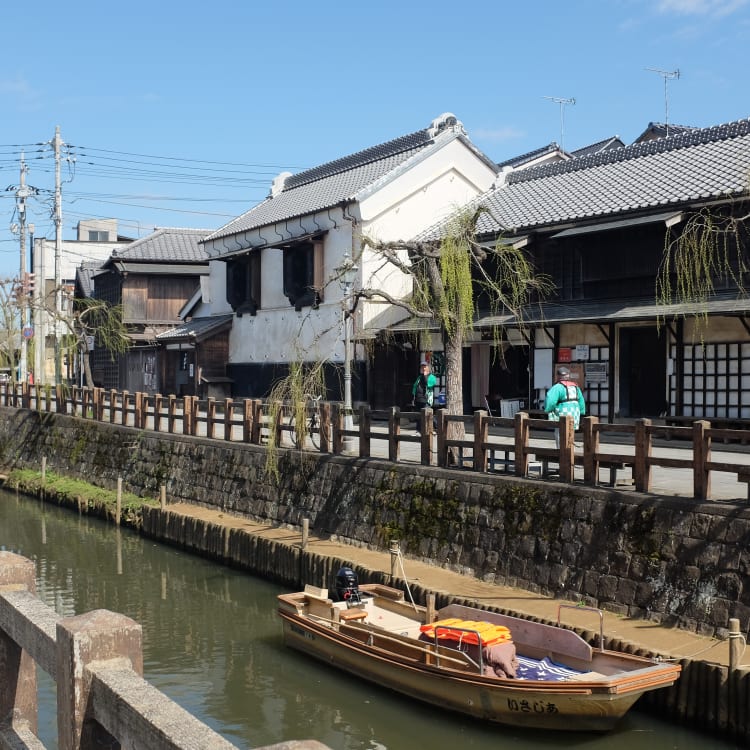
Itineraries Take a journey through Japan's scenic countryside, quaint towns, and cosmopolitan cities with these suggested routes
Explore the possibilities and make the best use of your time throughout your japan journey.

Into the Wild—The Shiretoko Peninsula
Unspoiled nature awaits
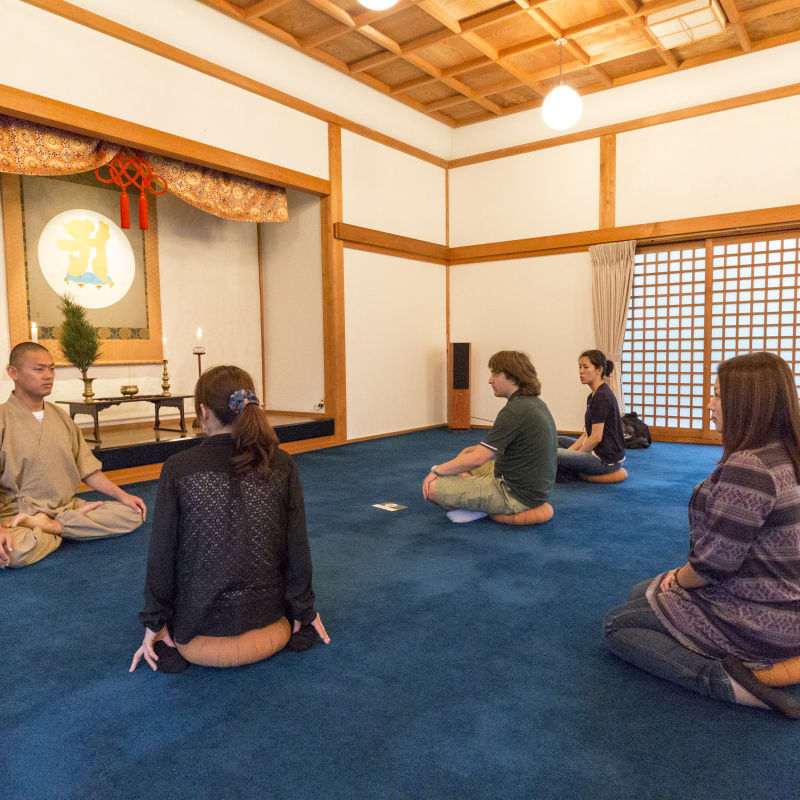
Spirituality in the Mountains of Koyasan
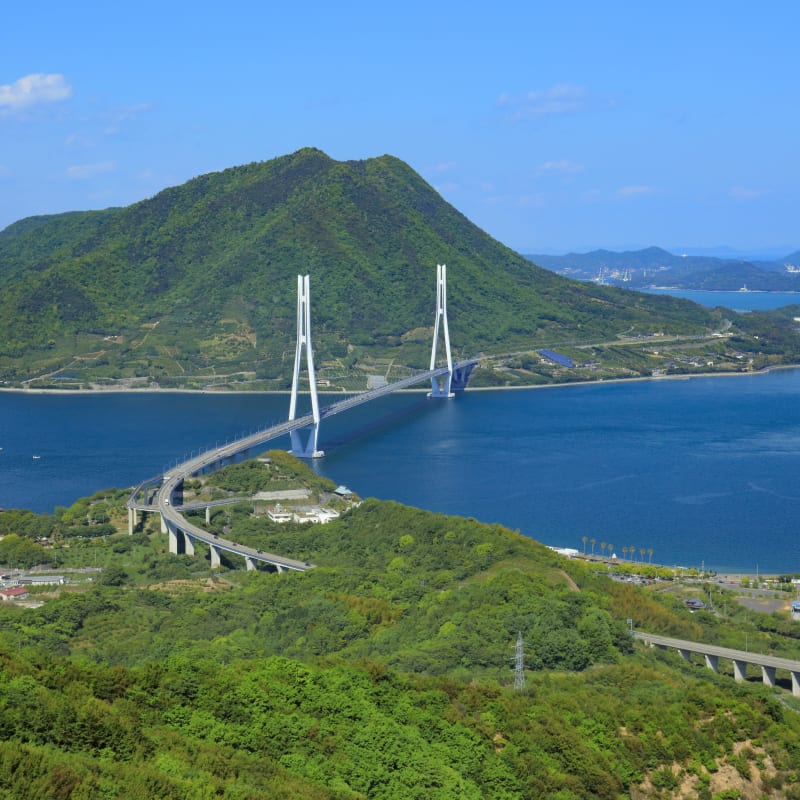
Cycling the Shimanami Kaido
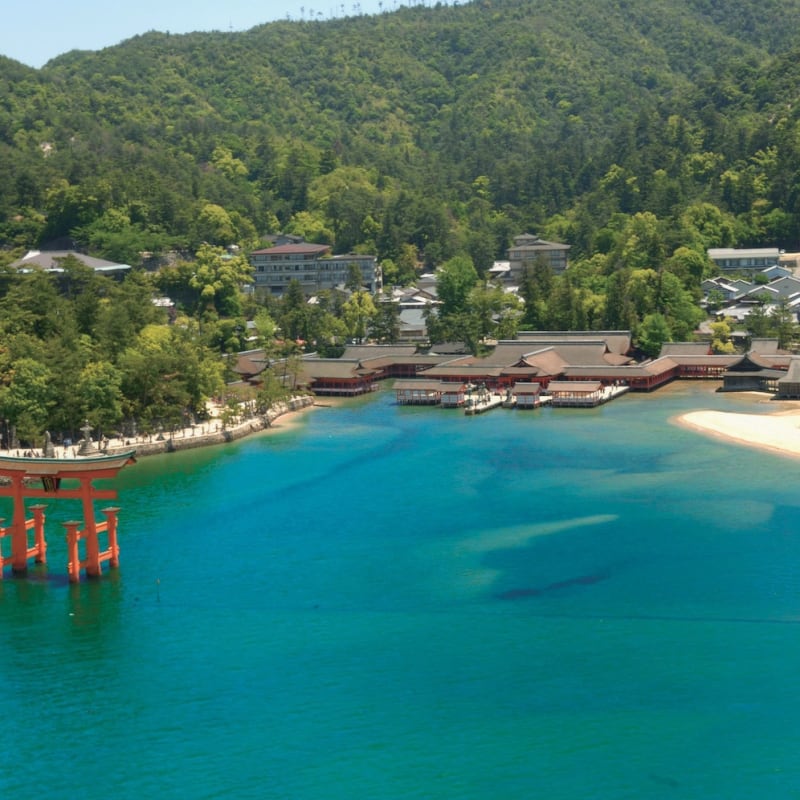
Hiroshima in Autumn
Visit Hiroshima's Peace Memorial and experience panoramic views of the Seto Inland Sea
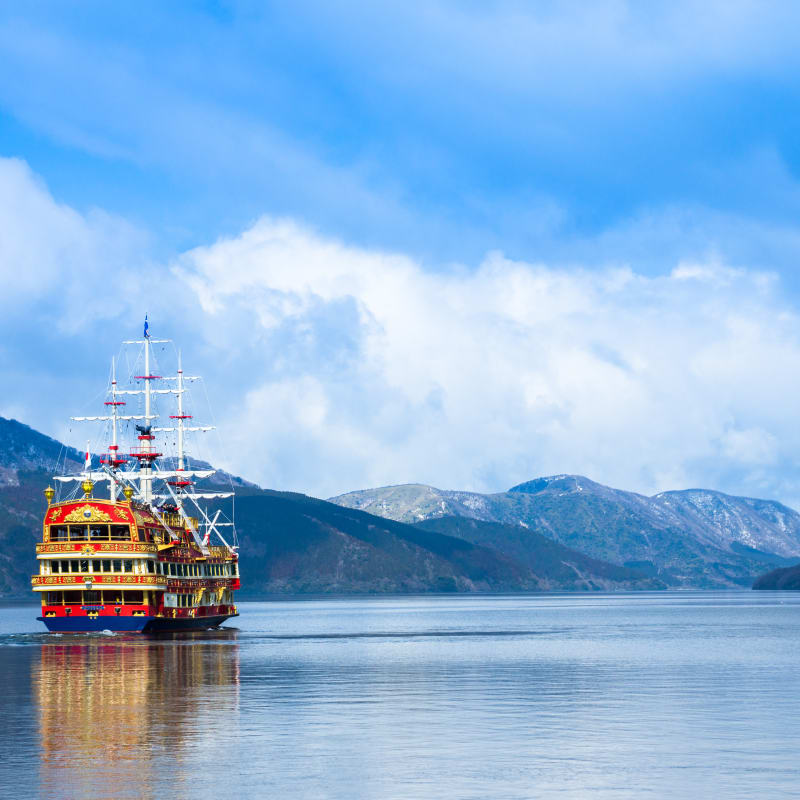
Hakone—An Easy Excursion From Tokyo
Escape the big city and soak in Hakone's scenic hot springs and abundant nature
Top Off The Beaten Path Trips
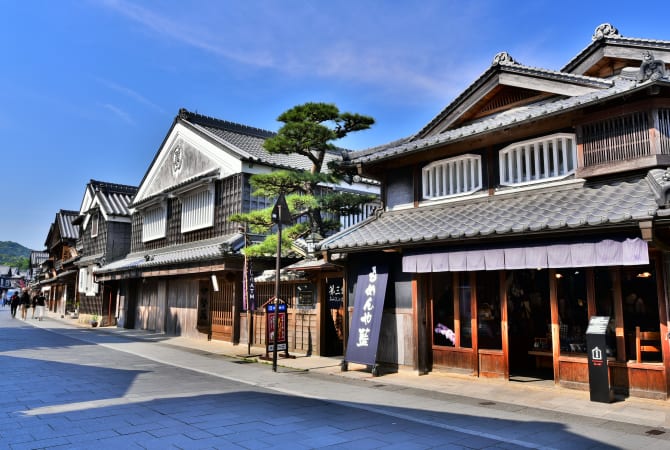
2 Days Trip

3 Days Trip
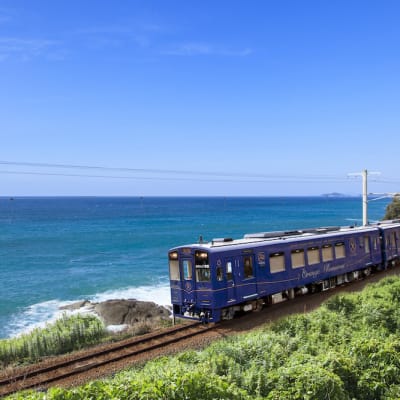
4 Days Trip
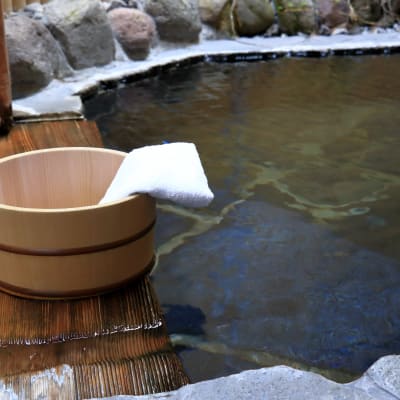
5 Days Trip
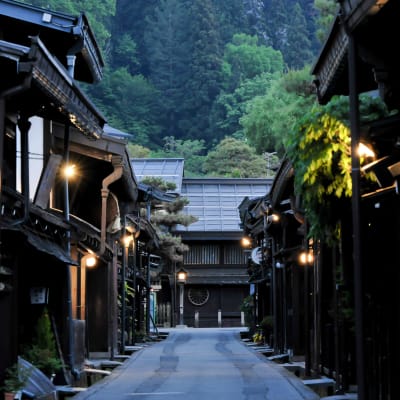
6 Days Trip
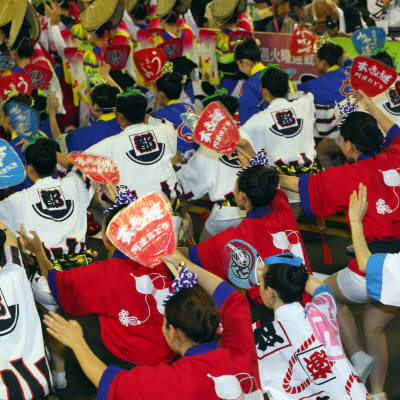
- Itineraries
Please Choose Your Language
Browse the JNTO site in one of multiple languages

21 days, 20 nights
The following is a suggested itinerary for first time travelers to Japan who spend 21 days and 20 nights in Japan, and arrive/depart from Tokyo 's Narita Airport .
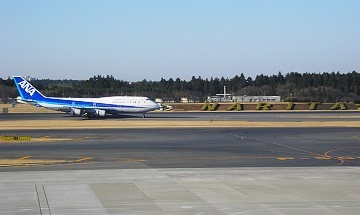
Regular train tickets will be cheaper than a Japan Rail Pass for this itinerary; however, travelers who do not mind paying extra for the convenience and flexibility of the pass' all-you-can-ride priviledge could consider using a 21-day Japan Rail Pass. Below are some sample budgets for the itinerary, excluding airfare. Find out more about the sample budgets and about the current yen exchange rates .
Questions? Ask in our forum .


- Meet the Team
- Work With Us
- Itineraries
- Italy Travel Guide
- Hawaii Travel Guide
- Travel Tips
The Perfect Japan 2 Week Itinerary: 10-14 Days in Japan
Planning a trip to Japan can be very overwhelming, because there are so many place to go and things to see. Where do you start planning the perfect Japan vacation?
You want to make sure you see everything possible in your 2 weeks in Japan, so planning each step of the way is very important. That’s why we’ve prepared the perfect Japan 2-week itinerary for you, so you have a starting point to build your dream trip from.
» Also read about Japanese Food: 45 Traditional Dishes to Look for in Japan.

You can use our itinerary to build your own independent trip to Japan, or you can leave the planning to the pros and go on a guided tour. Either way you choose, you’ll find all the information you need in this post.
Planning Your Japan Trip?
Buy flights. We recommend using Skyscanner or Expedia to find the best flight deals. Check out our guide to finding the best airfare for additional tips.
Get your Japan Rail Pass. You can buy it online here
Hotels See all hotel options
- In Tokyo: The Strings by InterContinental Tokyo
- In Kyoto: ACE Hotel Kyoto
- In Osaka: Intercontinental Osaka
Best Tours to Book
- Fully escorted 8-day Intro to Japan tour
- Private Custom Tour: Tokyo in a Day
- Tsukiji Fish Market Food and Culture Walking Tour
Table of Contents
Japan Itineraries
If you have longer to spend in Japan, you can expand this itinerary to any length you wish.
- We have a 7-day itinerary and a 2-week Japan itinerary so you can choose which length of trip suits you best.
- If you will only be visiting Tokyo, here’s a shortened 3-day itinerary for Tokyo .
- Want to add more days outside of Tokyo? Here’s a 3-day Kyoto itinerary and a 2-day Osaka itinerary .
Traveling in Japan can be expensive, but we’ve put together a list of the best budget travel tips for Japan to ease the strain.
Also keep in mind that it takes a considerable amount of time to travel between destinations and cities. So you have to be very wise in your planning to make everything fit together perfectly.

Where to Go in Japan
Japan is full of mesmerizing landscapes, incredible sights and – my favorite – amazing food!
There are a good number of tourist destinations that just about anyone planning a trip to Japan will want to include in the itinerary. Obviously, with just 10-14 days in Japan, there’s no way you can cover them all, so for this itinerary we’ve chosen the top destinations that we feel you can fit comfortably into 10+ days.
Here are the top destinations we recommend visiting in 10+ days in Japan: Tokyo , Hakone, Osaka, Kyoto, Nara, Hiroshima and Miyajima, and Kamakura.
Japan Vacation Options
There are two perfectly acceptable choices for your vacation in Japan: a self-planned individual trip or a guided trip. Either way can be quite rewarding, but which you should choose depends greatly on your travel style and how much energy you want to put into planning.
While Japan is very easy to get around and well suited for independent travelers, it can be difficult to do it on your own due to the language barrier, difficult train schedules you’ll have to navigate, and different foods and customs you’ll come across.
A pre-planned tour won’t give you the same freedom to do what you want, but it is completely planned out for you and you will always have a guide along to help you with anything you need.

1. Guided Tours of Japan
The tour company we recommend, Japan and More , offers fully escorted, small group and private tours of Japan that can be from 8 to 15 days in length.
The company is run by Japan travel specialists, Becki and Shawn, who have over 20 years of experience living, working, and traveling in Japan. They know where to go, what to see, and how to get there.
They are Americans who know Japan, understand Japanese culture, and speak the language. Their group tours book fast! So secure your place at least a year in advance.
Discover Japan Tour – 15 days
- Start out in Tokyo, then travel to Nagoya and Kiso Valley
- Stay in a traditional Japanese Ryokan
- Visit the ancient capital of Nara
- Hiroshima Peace Memorial Park
- See the famous floating torii gate at Miyajima
- Ride a cable car up Mount Koya
- Soak in a Japanese onsen bath in Hakone
- Discover Kyoto and Osaka
Intro to Japan Tour – 8 days
- Visit one of the last remaining original castles at Inuyama
- See the preserved mountain village of Takayama
- Explore Kyoto and have a traditional kaiseki dinner in Gion
For more information, check out Japan and More’s website . You’ll get $100 off the cost of your tour by using our coupon code.
Not sure about a guide tour? Read this review by someone who’s taken the trip.
Japan 13-Day Adventure
Another option we love for a guided Japan tour is this 13-day adventure by Intro Travel.
You’ll walk the streets of one of the world’s busiest and most futuristic cities, watch monkeys bathe in hot springs, roll your own sushi, visit ancient shrines and castles, get taught to wield a sword by a Samurai master, stay overnight with monks in a 1000 year old Buddhist temple, experience incredible and unique accommodation and much more!
» See more details of this trip
2. Self-Guided Two Weeks in Japan
If you want to plan your own trip and be in charge of your own trip, then a self-guided tour is the way to go.
With a good plan of action, your Japan 2-week itinerary will run smoothly and provide you with a stunning overview of this beautiful country.
If this schedule seems too ambitious for just 14 days in Japan, you can always extend your stay in the areas that interest you most and cut out a destination or two that you can save for your next trip.
There’s no right or wrong way to do it. It’s entirely up to you.

2-Week Schedule
Day 1-3: tokyo, day 4: kamakura, day 5-6: hakone and mount fuji, day 7-8: kyoto, day 9: nara, day 10-11: osaka, day 12: kobe, day 13-14: setouchi, hiroshima & miyajima.

Arrive in Tokyo. Keep in mind that Tokyo is a huge city with many different areas to explore. You won’t want to stay put in one area, but travel around and see as much as possible.
We recommend seeing these major sites:
- Tokyo Skytree
- Tsukiji outer fish market
- Hamarikyu Gardens
- Asakusa area
- Meiji Shinto Shrine
- Imperial Palace
- Shibuya Crossing
One of the best ways to see all the sights in a few days is on a day tour with a guide. We recommend this private customizable walking tour with Japan Wonder Travel. You can fit in whatever you want to see in one day or book them for a second to see even more.
Besides the main sights listed above, you have to save time for food! Tokyo is one of the best food cities in the world and there are dozens of food experiences to have. My favorites include:
- Ramen Tasting
- Tokyo Pub Crawl
- Hidden Izakaya and Sake Small-Group Pub Tour
- Sake Tasting & Seminar
⇒ Make it easy on yourself and follow this 3-day Tokyo itinerary for food lovers.
If you’ve got more time, check out these day trips from Tokyo that will get your further out into the countryside and to surrounding cities.
Where to Stay in Tokyo
We recommend the Intercontinental The Strings Tokyo Hotel. It’s a really large hotel with nice rooms, located in Shinagawa, which is really close to shopping, eating and transportation. If this doesn’t suit you, check out our full list of Tokyo hotels we recommend .
⇒ Read reviews on Trip Advisor .

For a change in pace, visit Kamakura, a seaside town south of Tokyo. It was the political center of medieval Japan, but is now a popular resort town, with dozens of Buddhist temples and Shinto shrines.
The most recognizable of these is the Great Buddha, a 42-foot-high bronze statue that has withstood the test of time.
Spend the day visiting the temples and shrines, hiking one of the many trails, enjoying Shichirigahama Beach, and the many museums around town.
Where to stay in Kamakura
For a lovely stay on the beach with a view of the ocean from your room, stay at the Kamakura Prince Hotel . ⇒ Read reviews on Trip Advisor .
▶ Transfer to Hakone via the Tokaido-Sanyo Shinkansen

Known for its traditional onsen, or hotsprings, Hakone is part of the Fuji-Hakone-Izu National Park and it has incredible mountain scenery and hikes, as well as art museums and shrines to see.
You can also take the cable car to catch a glimpse of Mt. Fuji. You’ll want a full day here to explore and stay overnight. With just one day it’s not practical to hike up Mt. Fuji. Did you know that the best time to see Mt. Fiji is in winter because of the crisp clear days? Check out other things you didn’t know about winter in Japan .
If you don’t have enough time for hiking, the best activity for visitors with only 1-2 days in the area is Lake Kawaguchiko.
One of the best views of Mt. Fuji can be found at Lake Kawaguchi, one of the largest of the 5 lakes in the region. It’s a great resort area with museums, a concert hall, and a museum shop. You can walk around it, go boating, fishing, and shopping.
- Take the JR Chuo Line from Shinjuku Station (Tokyo) to Otsuki Station
- From Otsuki, take Fujikyu Railway to Kawaguchiko Station (not covered by the JR Pass)
You can also catch amazing glimpses of Mt. Fuji from Arakurayama Sengen Park, which is located halfway up Mount Arakura.
Where to Stay in Hakone
Hyatt Regency Hakone Resort and Spa is within walking distance of the cable car that takes you toward Mt. Fuji. The hotel has very nice, classy rooms, with great views. ⇒ Read reviews on Trip Advisor .
We also recommend Hakone Mount View for a traditional Japanese ryokan experience with nice accommodations and good food. They have a rare volcanic hot spring called Nigori-yu – a fun and unique experience, especially for couples. ⇒ Read reviews on Trip Advisor .
Transfer to Kyoto.

There are many iconic and eye-catching shrines and temples in Kyoto that you’ll want to see, including the Fushimi Inari Shrine, Kinkaku-ji Golden Temple, and Kiyomizu-dera. (More in depth info on the temples of Kyoto.)
You can’t leave without visiting Nishiki Market, Arashiyama Bamboo Groves, seeing the geishas walking around the city center, participating in a tea ceremony, and eating at a traditional kaiseki restaurant for lunch or dinner.
At the right time of year – usually from early to mid-April – you can also see the cherry blossoms, which are gorgeous in Kyoto.
» See our full guide on how to spend 2-3 days in Kyoto , and then tack on these extra day trips from Kyoto if you have extra time.
Where to Stay in Kyoto
We recommend the Hyatt Regency , because it has a reliable standard for Western accommodations, however it’s not as close to the main sights as we’d like to be.
We found it more convenient to stay near Kyoto Station, since everywhere we visited we needed to go in and out of there. Our preferred hotel is the Hotel Granvia Kyoto .
Have a look at all Kyoto hotels for comparison.

Nara Park: Take a JR train to Nara Park at the base of Mount Wakakusa. The park is home to more than 1200 freely roaming deer that are domesticated enough to let you feed them.
You will also see the world’s largest bronze Buddha statue and one of the tallest pagodas in Japan, among other historic structures. Take the JR train onward to Osaka.
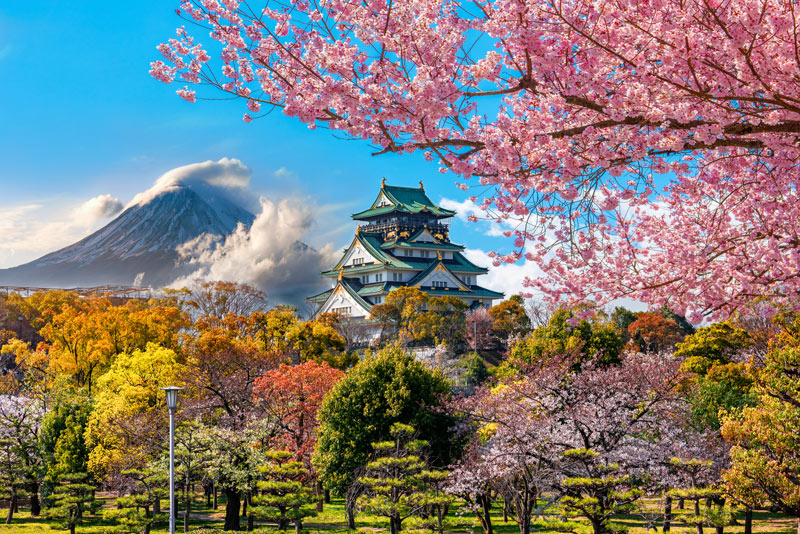
For foodies, there’s nothing quite as exciting as Dotonbori Street during the evening hours. The street comes alive with every kind of Japanese specialty street food, like okonomiyaki and takoyaki.
A great way to see a lot of Osaka during the day is on an Osaka Walking Tour . You’ll see Dotonbori during the day, visit the Hozenji temple, ride the subway, sample a local specialty, Kushikatsu, and explore traditional Shinsekai.
On your own, you can visit Osaka Castle, and check out the Instant Ramen Museum. If you have time, visit the food-focused Kuromon Ichiba Market and shop for a Japanese knife.
If you want to try the best izakaya food such as Okonomiyaki and Takoyaki and drink in Osaka, try this Osaka Bar Hopping Food Tour or go on a Foodie Walking Tour in Dotonbori and Shinsekai.
>> Read this post for an in-depth 2-day Osaka itinerary and here are some great day trips to take from Osaka if you have more time.
Where to Stay in Osaka
One of my favorite hotels is the Osaka Marriott Miyako Hotel . It is conveniently located for transportation, so you can easily get around to the top sights in Osaka and beyond. It’s got an insane view and really comfortable rooms. ⇒ Read reviews of the Osaka Marriott on Trip Advisor .
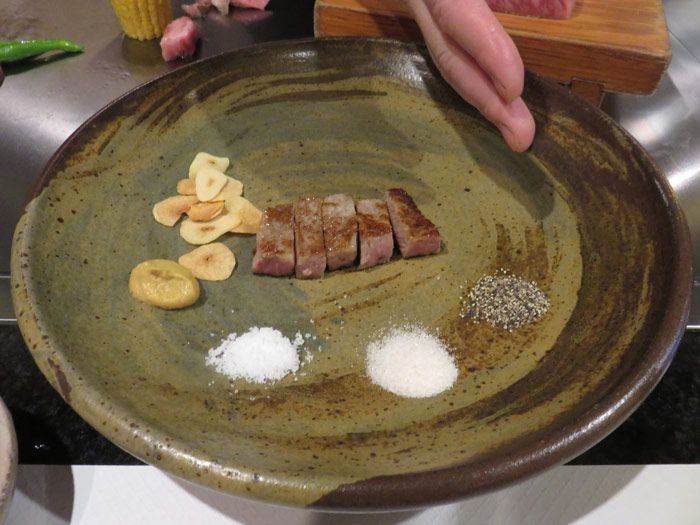
Take a 30-minute train ride to Kobe to try the famous Kobe beef. You will thank yourself for doing it – there’s nothing quite like it, and as a foodie, you owe it to yourself!
On the way back to Osaka, you can stop off in Kobe’s Nada district for a tasting and history about the making of sake at a few sake breweries . If you aren’t a sake drinker, check out the Himeji Castle, just 30 mins outside Kobe.
Stay overnight again in Osaka.
Transfer to Setouchi: Take the train from Shin-Osaka Station to Okayama Station, then the Ako line to Oku Station

The more off-the-beaten-path Setouchi region in Japan is a gem that many travelers miss in their typical itinerary, except those who make a point to visit Hiroshima (which we’ll talk about next). Setouchi has 350 islands that flank the Seto Inland Sea, so there are many hidden gems to explore.
For foodies, you don’t want to miss the oysters and the udon. With the proximity to the sea, oysters are a specialty in the area, with all-you-can-eat shacks open throughout the season.
Ritsurin Garden and Korakuen are two of the most beautiful of Japanese gardens and a must-see in Setouchi.
Hiroshima & Miyajima
Knowing that Hiroshima was effectively leveled in 1945, you will be in awe to see the city now. Hiroshima preserves the memory of the atomic bombing in the Peace Memorial Park and Museum .
Other popular sights to see in the city are the Hiroshima Castle, the city’s family shrines and temples, the Museum of Art and the Flame of Peace garden.
You can also go out to Miyajima, where the orange Great Torii Gate sits at the entrance to the Itsukushima temple, and is partially submerged in water during high tide.
If you have a Japan Rail Pass , it will cover the train and ferry between Hiroshima and Miyajima on the Japan Rail ferry.
Where to stay in Hiroshima
The Sheraton Grand Hotel in Hiroshima. The hotel is connected to Hiroshima Shinkansen station by a short, covered walkway, providing easy transportation around the city and out to Miyajima. ⇒ Read reviews on Trip Advisor .
Return to Tokyo.
Tips for planning a vacation in japan, best time to go to japan.
When you decide to go to Japan should be based on what type of experience you want to have. A lot of people make it a priority to go to Japan in the spring to see the cherry blossoms, while others wouldn’t want to be there during such a high tourist season.
If you want to catch the fireworks season in Japan, you need to go in August, but it’s really steamy and hot at that time of year. The best weather can be found from late March to May.
Another great time to visit is in autumn, when the leaves are changing, from September to November. As it can get very hot in summer in Japan, try to avoid traveling between June and August.
Getting to and Around Japan

Many top airlines have direct flights into Japan. You can check the status of flights into Japan from your home airport, to see which route and airline is best for you.
Top Japan airlines include ANA and Japan Airlines, but you can fly to Japan with most U.S. airlines that fly internationally, like United and American. Once you arrive in Japan – likely in Tokyo – you can get the train into the city center.
The best way to do it is to get on the Japan Rail (JR) Narita Express (called NEX). If you have a Japan Rail Pass , this journey is included in the pass. It goes to Tokyo Station in 60-90 minutes.
You will then likely have to change trains at Tokyo Station for the Yamanote Line, which serves most of the tourist hotels.
The best way to travel around Japan in by train. You’ll want to purchase a 14-day Japan Rail Pass . The pass allows you to travel on all JR trains throughout Japan, including the high-speed Shinkansen bullet trains. It’s the most economical and worry-free way to travel.
Travel in Japan is not cheap and the cost of buying individual tickets will far exceed the cost of the Japan Rail Pass, which you can purchase for 7, 14 or 21 consecutive days.
Just remember , you have to purchase it before entering the country and give time for it to be delivered to you. Read our guide on where to buy a Japan Rail Pass and if it’s worth it.
When planning your Japan itinerary, keep in mind the distance between each destination (for instance, the train from Tokyo to Kyoto takes 3:15). As long as there is a train linking each of your chosen cities, you’ll be able to easily travel around the country.
Traveling in Japan is not cheap, but you can save money in Japan by doing things like buying a Japan Rail Pass and eating street food.
Tipping in Japan
If you’re from the United States , Canada, or another country where tipping is customary, you should be aware that tipping in Japan is not customary.
If you do try to tip, in a restaurant or a hotel for instance, it might even be refused or considered rude. To avoid awkwardness, follow the Japanese custom and do not tip.
Eating in Japan

Japan is a country with a lot of unique foods. You will have the best overall experience if you’re willing to try the food and have an open mind that you mind really like something you’ve never tried before.
Aside from the expected and incredible sushi you’ll find all over the country, there are many specialties you should try. Some of our favorites are okonomiyaki (found mostly in Osaka), takoyaki (also from Osaka), yakitori, gyoza , and Kobe beef (only in Kobe).
You might also want to try kaiseki cuisine in Kyoto, a traditional, yet very modern preparation. Many of the top kaiseki restaurants have been awarded Michelin stars, too!
⇒ Learn the proper way to eat sushi in Japan.
Whether you take a guided tour or do this Japan 2 week itinerary on your own, I am certain it will be one of the most exciting and rewarding trips you’ll ever take. It is a fascinating country full of surprises.
Let us know how your trip to Japan turns out!
Like this post? Why not save it to Pinterest? FOLLOW US on Pinterest , Instagram , Facebook for more great travel inspiration and tips.

Laura Lynch, creator and writer of Savored Journeys, is an avid world traveler, certified wine expert, and international food specialist. She has written about travel and food for over 20 years and has visited over 75 countries. Her work has been published in numerous guidebooks, websites, and magazines.
29 thoughts on “ The Perfect Japan 2 Week Itinerary: 10-14 Days in Japan ”
Hello Nick! Your vacation in Japan is very interesting and very enjoyable. Moreover, you enjoy this holiday with the people closest to you. Thank you for sharing your experience and knowledge.
Hello! I know you wrote that summer isn’t a very ideal time to visit Japan, but my plans don’t allow me to go at any other time unfortunately. Would the beginning of July really be that bad?
Of course it’s still a great time to go as long as you don’t mind the sometimes intense heat and humidity.
Hi, we are in our 60’s so not as energetic as some! We are planning a 2 week trip to Japan in April. We arrive in Narita and initial thoughts are to stay somewhere close to airport on first night to help with jet lag and then head out to Kyoto/Nara for 3 nights, followed by Fuji five lakes for 3 nights. We want to end our stay with 3 nights in Tokyo, where would you suggest we go between our Fuji stay and return to Tokyo?
Hi Louise, I would suggest adding another day to Kyoto for a day trip to Osaka. It’s very much worth it. Then how about adding in Hakone and/or Kamakura before heading back to Tokyo.
Hi, We are a family that loves hiking, biking and outdoor activities in general. Can you suggest some places for us to visit? It’s our first time in Japan and we are staying 14 days. Thanks and I really like your website; it’s easy to understand and full of good information.
Hi Anne. I’m sure you’d love the area around Mt Fuji. There are numerous opportunities for hiking, biking and outdoor activities. Check out our post on day trips from Tokyo for more information.
Interested in a two week tour but we want to go see the snow monkeys north oh Nagano. Is there another spot to see them. We want to go in oct. and we are aware no snow then. Two couples to start tour around 10/12.
Ruth, you can visit the snow monkey park year round. There won’t be snow, but the monkeys are still there!
Hi Laura, I’m from Australia/NZ and want to say THANKS for your itineraries! I was a but lost. My hubby and I & two boys (12 & 14) are trying to plan a late January Japan trip but the boys (ie all but me :-D) want to add in a 3day snow holiday which I’m happy to do, as long as we get to at least do your 7 day itinerary! Can you please help me by suggesting an addition to your fantastic 7day itinerary that would get them their chance to try ski/boarding. Also maybe a spot that has other snow fun and a spa for me?
Hi Andrea. Glad you found the itinerary helpful! If you’re doing the 7-day trip, I would recommend a ski resort near Mt. Fuji. There’s Snowtown Yeti and Fujimi Panorama Resort nearby that are fantastic for International visitors. There are many hot springs and tons of other things to do nearby. Plus amazing views.
Thanks!! So if we add in 3 days at Hakone/Mt Fuji that would work? 10 days total. So excited! Thanks for your help.
Absolutely. And it won’t require additional travel time. Have a great time. Come back and let us know how it was!
Hello Savoredjourneys Team,
I hope you are doing well. I’ve been following your post on “Savoredjourneys.com”, for quite some time now. Every time I read a post, I feel like I’m able to take a single, clear lesson away from it, which is why I think it’s so great. I, Kousik author at “Value Walk”. Working all around the globe. We are always looking for many resources for our business development.
Our goal is an only satisfied client. I saw your post on “Savoredjourneys”, It looks good. So I contact you for this purpose if you want to work for our company. When we can always increase when we grow:)
Looking forward to working with you.
Warm Regards! Kousik
Oh, this itinerary is everything I was looking for. Thanks for coming up with this comprehensive itinerary.
Regards Anshul www.dailypassengerr.com
So I am planning a trip to go to Japan with my coworker and friend. Basically we want to go when there when is less tourists is that possible? We are planning to stay for two weeks as well. Also really good itinerary it is very helpful.
Paul – the main tourist spots will always be very busy, but those are likely the places you’ll want to see. I suggest following our 2 week plan and adjusting it to fit your interests. You can get off the beaten path in those places sometimes.
Hi Laura, thanks for the great guide! there’s just one thing that consearns me about this. How did you go all around with all the luggages? Since most hotels only check in at 12pm, that leaves you touristing with a lot of backpacks and luggages. If we stop to shop, that would just go heavier and heavier to go from place to place. How did you solved this? Thanks
Hi Thiago. Even if you can’t check into the hotel before afternoon, you can always check your bags with the hotel and go out exploring. We tend to pack really light so we don’t have a lot of luggage to trek around. It gets old when you’re on the train. I suggest taking a single piece of luggage, if possible.
Hi there! My trip is in October and we wanted buy the JR pass. I’m wondering if the JR pass will get us to all of these locations without purchasing extra train tickets? I woukd greatly appreciate hearing from you.
Hi Jouberte. All of the places in the itinerary are covered by the JR Pass. You would only need to purchase extra tickets if you want to take a train that isn’t a JR train, but there is a way to get to each place using JR trains.
Hi! We are heading to Japan in April 2020. We arrive in Tokyo on the 3rd and leave on the 7th. We are scheduled to be in Okinawa on the 10th to the 15th. We are trying to figure out the “best” place to visit in those 3 days (the 7th to the 10th), and need to keep in mind we need to fly into Okinawa in the 10th. Where do you recommend? We want somewhere either countryside or mountain town, but my wife seems to think Nagano is too “winter focused” so we’re looking elsewhere. We want traditional Japanese culture, a peaceful, country-like setting, and of course, great food and sites! Thanks!!
Hi. Read through your travel guide and would be trying out with my Mum. Would like your advise on how is it like to travel with luggage on train and buses as we would be planning to visit the Hakone for the hot springs. Also on day 7 it says that you in Nara. Did you spend the night there or in Osaka?
Gabriel, The trains and buses are usually packed full. While it’s absolutely possible to travel with luggage, I would advise taking the smallest form or luggage you can. We prefer backpacks, but you can get away with wheeled luggage. The biggest issue is just getting through the crowd easily, so suitcases with spinner wheels are the best option. When going to Nara, we always stay overnight in Osaka or Kyoto. It’s easy to get back and forth.
I am planning on going to Japan for 2 weeks in october this year, I really want to visit rabbit island (Ōkunoshima) but am unsure how to fit this in as it is not included on any online itinerarys I have seen – what would you suggest? Thank you!
Rachelle, it’s fairly easy to get there from Hiroshima, so I’d tack it on as an extra day in that area. You have to skip something else to fit it in, probably Kobe. If you go there directly from Osaka, then on to Hiroshima, it’ll fit right in.
Thank you!!
We are coming this December and have 16 nights between 12/18 – 1/3. Would your two week plan work at that time of year with maybe more time in Tokyo and a few modifications since no way to know the weather. We are from Colorado and our son is doing 1st semester of his Senior Year in College there in Osaka so a truly Once in a Lifetime Christmas Family Vacation! Thank you soo much!
Yes, I think you could do all of our itinerary in the winter time, though maybe not some of the things around Fuji. It’s always great to have more time in Tokyo, I think. Enjoy your trip!
Leave a Reply Cancel reply
Your email address will not be published. Required fields are marked *
Save my name, email, and website in this browser for the next time I comment.
- Travel Resources

How to Plan a 1-Week Itinerary in Japan (2024/2025)
If you only have a week, it is hard to see all of Japan's highlights without rushing. We recommend taking it easy and taking the time to savor your Japan trip.
To make the most of your travel time without feeling rushed, we recommend that you focus on the top two cities of Tokyo and Kyoto . If you want to experience more and don't mind speeding up a little, you could visit Osaka at the end of your trip.
In this article, we will share our personal experiences and insights from our investigation visits to Japan, to help make your 1-week trip to Japan as fulfilling as possible.
- What to Do in a Week in Japan
A Classic 7-Day Japan Itinerary
- How Much Does 7 Days in Japan Cost
How to Get Around Japan
Best times to visit japan, what to do in a week in japan.
During your 7-day itinerary, we suggest you start by exploring Japan's top cities, Tokyo and Kyoto, to get a great introduction to the country. If you're looking to travel wider, consider visiting Osaka. While it may offer fewer experiences compared to Tokyo and Kyoto, it's definitely worth a visit for its renowned cuisine.
Tokyo: Modernity and History
Tokyo is a blend of the old and the new. You could step back in time and explore the city's modern side, with experiences from traditional culture to anime. For a refreshing day trip surrounded by natural beauty, admire must-see Mount Fuji at Lake Kawaguchi, which is just a 2-hour drive from Tokyo.
We suggest you allow 2–3 days in Tokyo to explore the city's highlights.
For families with teenagers (or tweens), Tokyo has more kid-favored experiences than other cities, such as Pokémon Center, interactive exhibits at teamLab , and different themes at anime cafés.
Kyoto: Traditional Charm
Kyoto is the medieval capital of Japan. Highlights include admiring the history-filled shrines, experiencing the unique geisha culture, and enjoying a night at a Japanese-style ryokan (a Japanese inn).
You could allow 2–3 days in Kyoto to immerse yourself in its traditional charm.
Apart from experiencing Kyoto's strong cultural atmosphere, we strongly recommend you take day trips from Kyoto to Arashiyama and Nara. In Arashiyama, you could enjoy wandering through the bamboo groves, while in Nara, you could interact closely with friendly deer.
Osaka: Culinary Paradise
Spend 1–2 days in Osaka to sample a range of Japanese cuisines and experience the historical trading hub's unique culture . Enjoy a food tour to taste takoyaki (octopus balls), okonomiyaki (a Japanese pancake), and kushikatsu (deep-fried skewers). You could engage in ukiyo-e printmaking for a special experience as well.
This itinerary is our clients' most chosen 7-day Japan itinerary , allowing you to explore the must-visit attractions in Tokyo, Kyoto, and Osaka. Although it would be a tight schedule, it would provide you access to all the main highlights mentioned above: Japanese history, unique cultural experiences, Mount Fuji, and delicious food.
Here is the handpicked itinerary for your inspiration:
- Days 1–3: Tokyo (Meiji Shrine, Asakusa, sushi-making, and Mount Fuji)
- Days 4–5: Kyoto (Kinkaku-ji, Nijo Castle, Nishiki Market, and Fushimi Inari Shrine)
- Day 6: Osaka (ukiyo-e printmaking and a food tour at Shinsekai)
Day 7: Departure
Day 1: tokyo arrival.
Tokyo has two international airports: Narita and Haneda. Narita has the most international flights in Japan and it takes 60–90 minutes to get to the city center by train or car. On the other hand, Haneda is closer. It is just a 20 to 30-minute train or car ride away but it offers fewer international flights.
Using public transportation from the airport to get to your hotel is easy in Tokyo. However, if you prefer to go directly to the hotel from the airport to save time and energy, it's recommended to have a private car collect you from the airport. We would happily handle it if you book your trip with us.
After a long flight with a big time difference, we suggest not to plan any activities on your first day in Japan . Just rest well for the trip ahead.
Where to Stay in Tokyo ?
We suggest staying in the Shinjuku area for its convenient proximity to the attractions, a variety of dining options nearby, and ease of exploring on your own. Based on our experience, the Keio Plaza Hotel Tokyo in Shinjuku is a great 4-star hotel choice.
For families who are looking for a triple room, Hotel Gracery Shinjuku is perfect.
Day 2: Tokyo City Highlights
You would explore the top attractions of Meiji Shrine and Senso-ji, and experience authentic sushi-making.
Stop 1: Meiji Shrine
Kick off your trip at Meiji Shrine , a wooden shrine in the downtown area. It is surrounded by over 100,000 towering trees, creating a serene forest-like atmosphere upon entry. If you're lucky, you may even witness a traditional Japanese wedding ceremony.
Meiji Shrine is very large, so you won't feel crowded most of the time. To enjoy a quieter experience with fewer travelers, we suggest you visit it in the morning. Moreover, the chances of seeing a Japanese wedding in the morning are higher.
Avoid visiting during New Year or Golden Week (April 29th to May 5th), when millions of visitors flock there to attend a blessing ceremony.
Stop 2: Making Sushi
We would arrange for you to make sushi during lunchtime so you could proudly enjoy the meal you have prepared. You could try it at a restaurant or in a local home, but each experience is similar.
A chef would introduce you to different ingredients that are usually used to make sushi, teach you how to shape the rice, and show you how to cook tamagoyaki. You would get to experience creating about 10 pieces of sushi.
Stop 3: Senso-ji
In the afternoon, head to Senso-ji. It is known for the golden statue of Kannon and the ancient shopping street, Nakamise-dori, with over 400 years of history.
Senso-ji is crowded from 9 am to 5 pm throughout the year, especially on weekends and public holidays. If you want to avoid the large crowds and are not interested in shopping at Nakamise-dori, you're highly recommended to visit during the quieter times of 7–8 am or after 7 pm.
If you want to buy souvenirs , consider the new Nakamise-dori outside the temple. It has fewer crowds and is cheaper than the ancient street. Although many travelers buy souvenirs at the old Nakamise-dori, the costs are about a third more expensive than at other temples and almost all of the shops are full of travelers.
For families with teenagers , you could add some kid-friendly experiences. For example, shopping at Pokémon Center, dining at Pokémon Café, or trying out a ninja adventure by dressing up like a ninja. Just tell us your preferences and our Japan travel advisor could make it happen.
Day 3: Day Trip to Lake Kawaguchi to Admire Mount Fuji
Don't miss the iconic Mount Fuji during your trip. With its convenient transportation (a 2-hour drive from Tokyo) and more observation decks, Lake Kawaguchi is the best spot to admire Mount Fuji in Japan. You could admire Mount Fuji in four main ways: boating, taking the cable car, enjoying light hiking, or biking.
Boating on the lake is highly recommended. It's relaxing and allows you to admire the mountains up close in a serene atmosphere.
Taking the ropeway is easy and effortless. It is perfect for those looking to capture pictures of Mount Fuji from a high observation deck. However, there is little to experience on or around the observation deck apart from the awesome views.
Hiking around the lake is moderately tiring. The recommended route goes from Kawaguchiko Station to Oishi Park, taking about 2 hours each way. You could enjoy the mountain and lake views, and if you get tired, there are cozy cafés along the way where you could take a break.
Biking is suitable for outdoor enthusiasts. Due to the many steep slopes around Lake Kawaguchi, biking is more physically demanding. We recommend renting an electric moped bike to make it easier to tackle uphill slopes.
Day 4: Take the Shinkansen to Kyoto
Traveling from Tokyo to Kyoto on the efficient and comfortable Shinkansen, a journey takes only 2 hours 10 minutes.
Upon reaching Kyoto, take your time exploring this ancient capital for the remainder of the day.
Where to Stay in Kyoto?
Kyoto has many centuries-old buildings and a rich traditional atmosphere, unlike Tokyo and Osaka. It's the top place to experience a time-honored Japanese-style ryokan stay. You could sleep on tatamis, slide paper doors, and enjoy a delicious kaiseki feast. Kyoto Ryokan Kinoe is well-received by our clients for its fully-Japanese vibe.
If you are not used to sleeping on the floor and still prefer a star-rated hotel, Hotel Higashiyama by Kyoto Tokyu Hotel in the downtown Sanjo area is an excellent 4-star hotel.
Day 5: Kyoto City Highlights
To truly gain insights into the historic buildings in Kyoto and uncover the city's stories, we highly recommend that you explore with a private local guide. Don't miss the must-visit attractions in Kyoto, as detailed below.
Stop 1: Kinkaku-ji
Kinkaku Temple is a landmark in Kyoto, attracting many Japanese student groups seeking a deeper understanding of their country's history every year. Covered in golden leaf, the temple we see today was rebuilt in 1955 after the original structure was destroyed by fire.
You may only admire Kinkaku-ji's beauty from around the lake as visiting inside is not permitted. Once you're on the Kinkaku-ji path, there's no turning back, so you must move straight ahead in one direction.
Stop 2: Nijo Castle
Nijo Castle is an imperial palace with a history of over 400 years. It is a perfect place for a short visit.
Ninomaru-goten Palace is a must-see inside the place. To explore the rooms up close, you're required to walk barefoot through the corridors. Admire the well-preserved murals and discover mannequins dressed in Edo-period clothing showcasing the original functions of the rooms.
Except for the castle, the well-designed Japanese garden within the palace grounds is also worth visiting. It is beautiful, especially in spring when the garden is adorned with cherry blossoms.
Stop 3: Nishiki Market
Enjoy your lunch at Nishiki Market . You would discover a variety of Japanese snacks, kitchenware, and restaurants. If you're unsure of what to try, our private guide could offer suggestions based on your preferences.
The market closes at 5 pm, so lunchtime is the best time for you to visit and try out as many foods as you would like.
Nishiki Market is an excellent choice for families with kids looking to have a fun time. You would find various themed animal cafés in the market, including Shiba Inu, owl, and Pet Pig cafés.
Stop 4: Fushimi Inari Shrine
Fushimi Inari Shrine is well-known for its thousands of orange-red torii gates. The most beautiful view could be seen halfway up the hill along the road. You don't need to go all the way to the summit as the scenery isn't as appealing and it could be tiring.
You may have seen many beautiful photos online of people wearing kimonos at Fushimi Inari Shrine, and you might feel tempted to do the same. However, it's not a good idea. Due to the numerous steps at Fushimi Inari Shrine, it's uncomfortable to climb the hill in a kimono and Japanese clogs as you wouldn't be able to take long strides.
If you're looking to enjoy authentic experiences, such as a tea ceremony, watching a geisha's performance, or making Kyoto pottery, our Japan travel advisor would make them happen for you.
Day 6: Transfer to Osaka via Nara
You would transfer to Osaka by private car. On the way, you would pass Nara Park , a place to feed the beloved deer. Nara locals believe that deer are messengers of God, which is why you would find many well-protected and friendly deer in Nara's park and temples.
Spend half a day there to have close interactions with deer. Nara Park is the most popular place to feed deer, but it has large crowds most of the time. For a more peaceful experience with fewer people, visit Mount Wakakusa, another deer park located just a 10–15-minute walk from Nara Park.
If you plan to spend the entire day in Osaka, it's best to skip Nara. Osaka is an hour's drive from Kyoto. In Osaka, you could have a food tour at Shinsekai, savoring famous Japanese snacks, such as takoyaki (octopus balls) and okonomiyaki (a Japanese pancake).
For a special experience, you could try a unique ukiyo-e printmaking session guided by experienced staff. You would learn how to color and print your favorite design. To fully enjoy your time, aim to arrive before 3 pm as the venue stops admitting visitors at 4:30 pm.
Where to Stay in Osaka?
The 4-star Hotel Vischio Osaka by Granvia is an excellent choice in Osaka. It provides convenient airport transportation, a wide range of nearby dining options, and triple rooms for families.
Say farewell to the exotic charm of Japan and fly home. We can provide an airport transfer service for a smooth departure and peace of mind.
How Much Does 7 Days in Japan Cost?
A private tour in Japan costs US$350–500 per person per day with 4-star hotels, based on 3–5 people. This includes a private guide, private car, full-day itinerary, tickets for attractions, and well-selected 4-star hotels. Therefore, the total cost for 7 days in Japan is about US$2,500–3,500 (international flights not included).
If you're planning to travel to Japan during peak seasons, such as the cherry blossom season , Christmas, or New Year, be prepared for prices to be up to twice as expensive as usual.
Travel costs in Japan are higher than in other Asian countries. However, Japan offers abundant experiences and excellent service that makes the extra money worthwhile. To secure your favorite hotels, have more room options, and save some money, it's highly recommended to make your reservation at least 3 months in advance, especially for peak seasons, such as the cherry blossom season (March/April), summer vacation, Christmas, and New Year.
Getting around Japan is convenient thanks to its super-slick train system. The Shinkansen is known for being efficient, fast, and extremely punctual, making it the most popular transportation option in Tokyo, Kyoto, and Osaka.
For example, it takes less than 2½ hours to go from Tokyo to Kyoto and just 15 minutes to get from Kyoto to Osaka!
The Two Seat Classes on the Shinkansen
There are two seat classes on the Shinkansen: Green Car (first class) and Ordinary Car. The table below shows the two Shinkansen ticket option features.
Reserved/Non-Reserved Tickets for the Shinkansen
There are two types of tickets for the Shinkansen: reserved and non-reserved. It's better to buy reserved seats to guarantee you and your partner/family can sit together.
- Reserved seats are available in both Green Cars and Ordinary Cars. You're advised to book your seat at least 1 week in advance.
- Non-reserved tickets only give access to Ordinary Cars. You could sit anywhere that is not reserved, but if all seats are taken, you might have to stand.
Dealing with Your Luggage
For oversized luggage measuring a total of 160–250 cm (63–98 inches) adding the three dimensions, you're highly recommended to reserve a seat in the last row in front of the designated area for oversized luggage on the Shinkansen.
Many hotels and supermarkets provide luggage delivery services. With this convenient option, you could send your suitcases to your next destination or airport, minimizing the trouble of having to carry your luggage around.
Japan is a year-round country to visit. The best times to visit Japan are spring (March to May) and autumn (September to November) when the weather is pleasant with more sunny days. During these times, the peak seasons in Japan are mid-March to early April for the cherry blossoms and late October to November for the autumn leaves.
Summer (June to August) is hot, humid, and crowded in Japan, making it uncomfortable for you to explore scenic spots. The average daily high in summer is 31°C (88°F), sometimes even reaching 35°C (95°F). June offers cooler weather and fewer crowds. It is better for a family vacation compared to July and August.
Winter in Japan (December to February) is cold and dry, with an average daily high of 10°C (50°F). It's the best time to relax in an onsen at a ryokan, witness the unique sight of snow monkeys soaking in onsens, or enjoy skiing/snowboarding at top powder snow resorts.
Let Us Help You Plan Your Trip to Japan
You could take the above 7-day itinerary as a starting point and we would customize your Japan itinerary from there. Or you could just tell us your preferences and our Japan travel advisors would make your dream trip happen. Contact Us Now !
Discover real reviews of Highlights Travel Family 's best-rated service across trusted platforms.
Get Inspired with Some Popular Itineraries
At Asia Highlights, we create your kind of journey — your dates, your destinations, at your pace. You can have any trip tailor made for your travel.
More Travel Ideas and Inspiration
Sign up to our newsletter.
Be the first to receive exciting updates, exclusive promotions, and valuable travel tips from our team of experts.
Why Asia Highlights
Where can we take you today.
- Middle East
- African Safari
- Travel Agents
- Loyalty Program
- Privacy Policy
Address: Building 6, Chuangyi Business Park, 70 Qilidian Road, Guilin, Guangxi, 541004, China
- Today's deals
- Search travel guides

3 Days in Kobe Itinerary: Your Ultimate Guide to Japan’s Hidden Gem
Kobe, Japan’s hidden gem, offers a remarkable mix of cultural heritage, culinary delights, and scenic beauty. Nestled between Mount Rokko and the sea, Kobe is known for its picturesque landscapes and as the birthplace of the world-renowned Kobe beef. This 3-day itinerary will guide you through the best attractions, dining experiences, and activities that Kobe has to offer. Whether you’re a first-time visitor or a returning traveler, this guide will help you make the most of your stay in this vibrant port city.
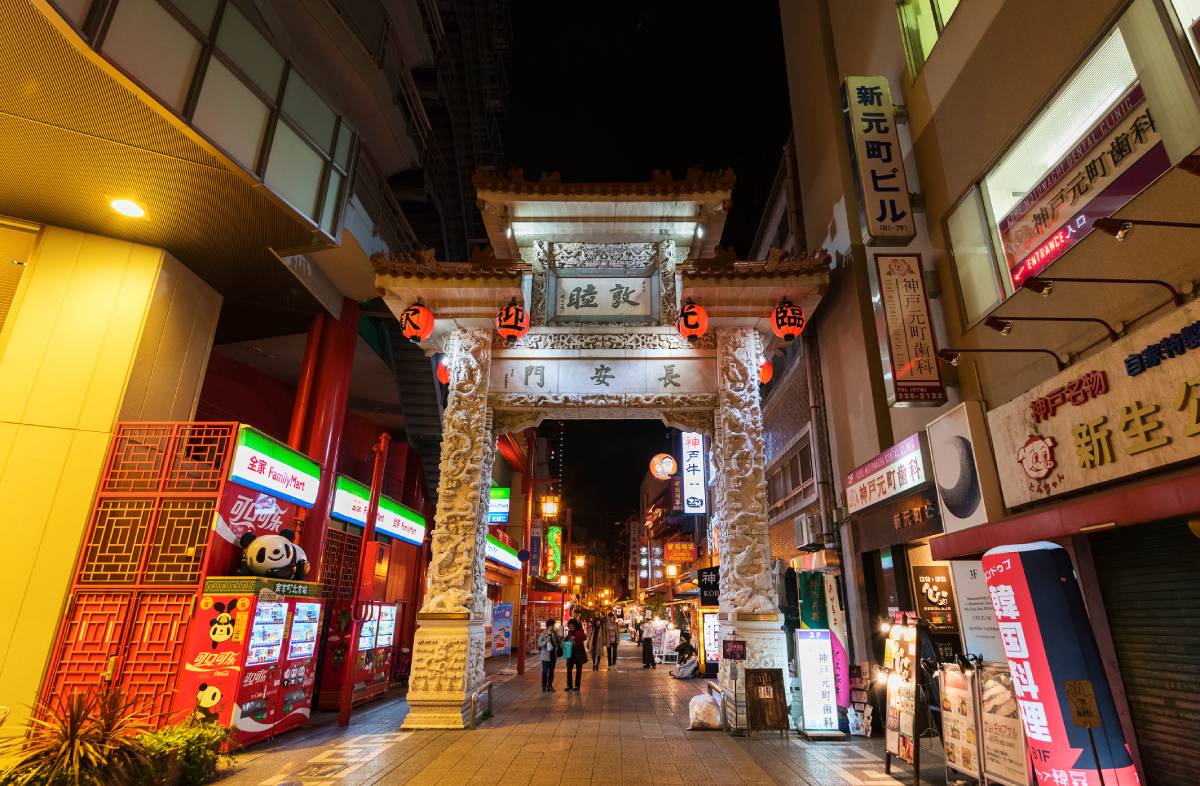
Day 1: Exploring Central Kobe
Morning: arrival and sannomiya area.
Start your journey in the heart of Kobe – the Sannomiya area. This bustling district is the city’s transportation hub, filled with shops, eateries, and entertainment options. Begin your day by exploring the shopping streets of Sannomiya Center Gai and Tor Road . These lively corridors will give you a taste of Kobe’s modern vibe.
Just a short walk from Sannomiya Station, you’ll find the historic Ikuta Shrine . This ancient shrine, dating back to the 3rd century, is dedicated to the Shinto deity Wakahirume. Explore the serene grounds, offer prayers, and be sure to take a picture of the iconic red torii gate.
- Ikuta Shrine – Address: 1 Chome-2-1 Shimoyamatedori, Chuo Ward, Kobe, Hyogo 650-0011, Japan – Opening hours: 7:00 AM – 6:30 PM
Afternoon: Kobe Chinatown (Nankinmachi) and Kobe Port Tower
Head to Nankinmachi , Kobe’s vibrant Chinatown, for lunch. This bustling area is brimming with street food vendors and authentic Chinese restaurants. Don’t miss the chance to try delicacies like pork buns , dumplings , and Peking duck .
After satisfying your taste buds, make your way to the iconic Kobe Port Tower . This observation tower offers panoramic views of the city and the harbor. It’s a great spot to get a comprehensive view of the cityscape.
- Kobe Port Tower – Address: 5-5 Hatoba-cho, Chuo-ku, Kobe-shi, Hyogo – Opening hours: 9:00 AM – 11:00 PM
Evening: Meriken Park and Harborland
Spend your evening relaxing at Meriken Park . This waterfront park features stunning sculptures and the Kobe Maritime Museum. It’s a perfect spot to enjoy the evening breeze and watch the sunset.
For dinner, head to Kobe Harborland , a bustling entertainment district with a variety of dining options, shopping malls, and cafes. Consider dining at one of the many restaurants offering fresh seafood or authentic Kobe beef.

Day 2: Culture and Nature in Kobe
Morning: kitano-cho and kobe nunobiki herb gardens.
Begin your second day in the quaint district of Kitano-cho , known for its well-preserved Western-style houses (Ijinkan) from the Meiji and Taisho periods. Visit the Weathercock House and the Moegi House for a glimpse into Kobe’s international past.
Next, take the cable car from Shin-Kobe Station to the Kobe Nunobiki Herb Gardens . This garden is one of Japan’s largest herb gardens, offering breathtaking views of Kobe from its observatory. Stroll through the vibrant terraces, enjoy the scent of herbs and flowers, and relax at the garden café.
- Kobe Nunobiki Herb Gardens – Address: 1 Chome-4-3 Kitano, Chuo Ward, Kobe, Hyogo 650-0007, Japan – Opening hours: 9:30 AM – 8:15 PM
Afternoon: Arima Onsen
Spend the afternoon unwinding at Arima Onsen , one of Japan’s oldest and most famous hot spring towns. Located just a short ride from central Kobe, Arima Onsen offers a variety of public baths and traditional ryokan (inns) with private baths. Relax and rejuvenate in the therapeutic waters of the golden and silver hot springs.
Evening: Dining in Kobe
Return to the city and enjoy an exquisite dinner featuring Kobe beef at one of the renowned steakhouses in the area. Popular choices include Misono and Wakkoqu , which offer an unforgettable dining experience with top-quality beef grilled to perfection.
- Misono – Address: 1 Chome−1−2, Shimoyamatedori, Chuo Ward, Kobe, Hyogo – Opening hours: 11:30 AM – 1:40 PM & 5:00 PM – 10:00 PM
- Wakkoqu – Address: 1 Chome−22−13, Nakayamatedori, Chuo Ward, Hyogo – Opening hours: 12 PM – 3:00 PM & 5:00 PM – 9:00 PM

Day 3: Scenic Beauty and Modern Marvels
Morning: mount rokko.
Start your final day with an excursion to Mount Rokko . Take the Rokko Cable Car to the top of the mountain, where you’ll be greeted with stunning panoramic views of Kobe and the surrounding region. Explore the Rokkosan Pasture , a beautiful area where you can interact with farm animals and even taste freshly made dairy products.
Afternoon: Kobe City Museum and Meriken Park
Head back to the city to visit the Kobe City Museum . This museum offers a deep dive into Kobe’s history, culture, and art. It features exhibitions on both local and international art, making it a rich cultural experience.
Revisit Meriken Park for a leisurely afternoon. If you missed the Kobe Maritime Museum on Day 1, now is a great time to explore it. The Earthquake Memorial Park within Meriken Park also provides insight into the impact of the Great Hanshin Earthquake and Kobe’s recovery.
Evening: Kobe Harbor Cruise
Conclude your trip with a Kobe Harbor Cruise . As the city lights up in the evening, enjoy a romantic and scenic cruise around the harbor. This experience offers fantastic views of the illuminated cityscape and iconic landmarks such as the Kobe Port Tower and Meriken Park.
For your final dinner, choose a restaurant along the waterfront to enjoy fresh seafood with a wonderful view of the harbor. Try The Oyster Bar Kobe for an unforgettable dining experience.
Practical Information and Travel Tips
- Currency: Japanese Yen (JPY)
- Language: Japanese (English is widely understood in tourist areas)
- Transportation: Consider purchasing an IC card (ICOCA or PASMO) for convenient travel on public transportation.
- Travel Tip: When visiting hot springs and traditional bathhouses, remember that tattoos may be prohibited in many onsen. Check the rules beforehand or select tattoo-friendly facilities.
Kobe is a city that beautifully blends tradition with modernity, offering visitors a vast array of experiences from serene shrines and hot springs to vibrant shopping districts and gourmet Kobe beef. This 3-day itinerary aims to showcase the best of what Kobe has to offer, ensuring that you leave with unforgettable memories. Whether you’re exploring historical landmarks, enjoying panoramic views from Mount Rokko, or indulging in the local cuisine, Kobe promises a rewarding and delightful journey. Make sure to set aside time to savor every moment in this extraordinary city.
You may also like
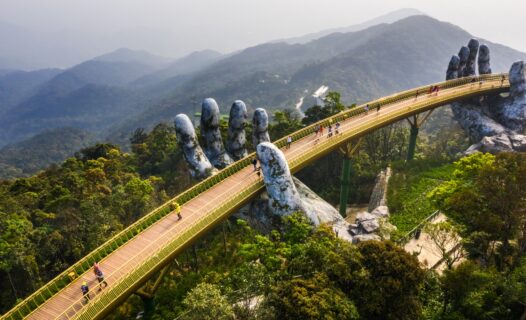
Fun for the Whole Family: Must-Do Activities in Da Nang with Kids
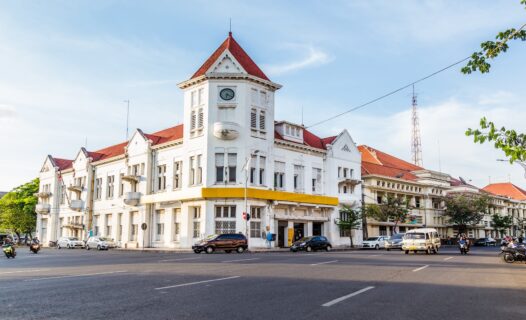
Discover the Best Time to Visit Surabaya: A Year-Round Travel Guide for Tourists

Jeju in Full Bloom: Discovering the Magic of Canola Flower Season
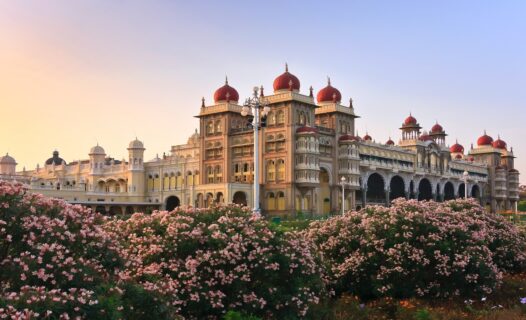
Discover the Magic of Mysore: Top Things to Do in the City of Palaces

Unmissable Things to Do in Nagano: Your Ultimate Travel Guide
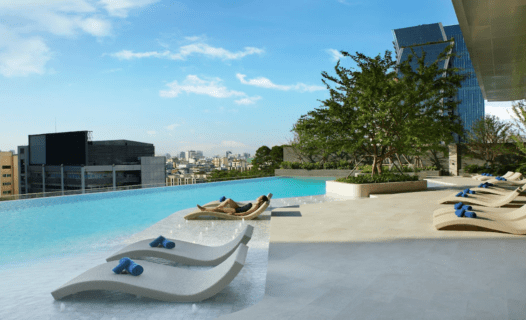
Discovering Somerset Rama 9: Your Home Away from Home in Bangkok

Unveiling Yogyakarta: Must-Visit Destinations and Hidden Gems in Java's Cultural Heart

Ultimate Guide for First-Time Travelers to Indonesia: Discover Paradise in Southeast Asia
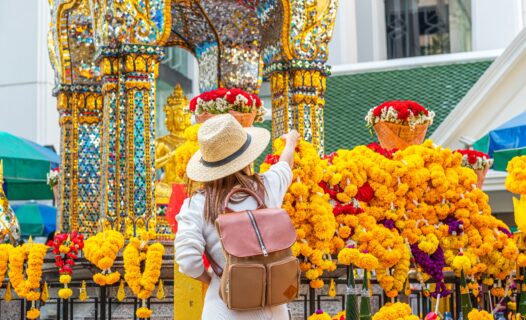
Unveiling the Mystique of Bangkok's Four-Faced Buddha: A Spiritual Guide

Unveiling Malacca: The Ultimate 7-Day Itinerary for an Unforgettable Journey Through History and Culture

The Ultimate Guide to Accommodations in Hong Kong: Where to Stay for Every Traveler's Budget

Discover the Charm of Pattaya: The Perfect Stay at Payaa Hotel
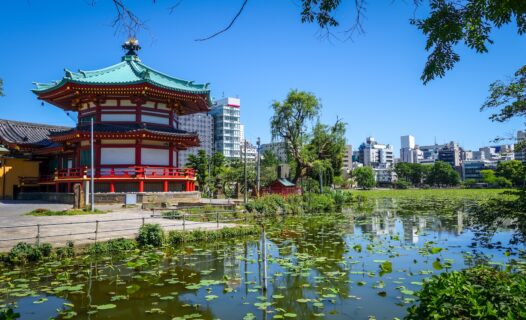
Discover the Serenity: A Complete Travel Guide to Lake Shinobazu, Tokyo
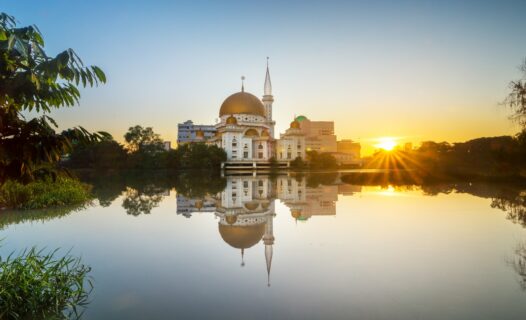
Discover Klang: Top Things to Do and See in Selangor's Historic Gem

Exploring Rajamangala Stadium: The Ultimate Guide to Bangkok’s Premier Sports Venue
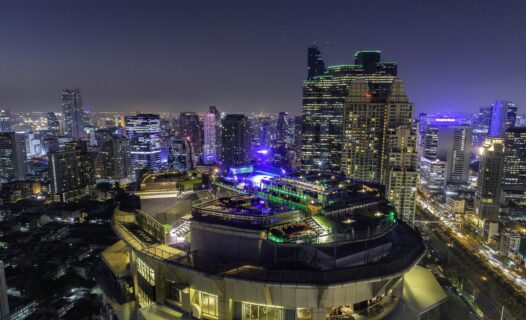
Discover Luxurious Tranquility at JC Kevin Sathorn Bangkok Hotel: Your Ultimate Bangkok Retreat

Journey Through Time: Ultimate Travel Guide to Japan’s Nakasendo Trail
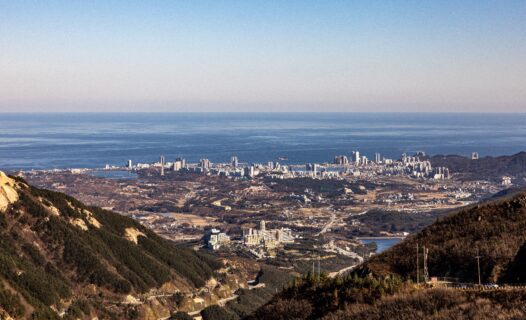
Savoring Sokcho-Si: A Culinary Journey through the Best Local Eats

Your Ultimate Guide to Dream World Bangkok: Entrance Fees, Attractions, and Insider Tips
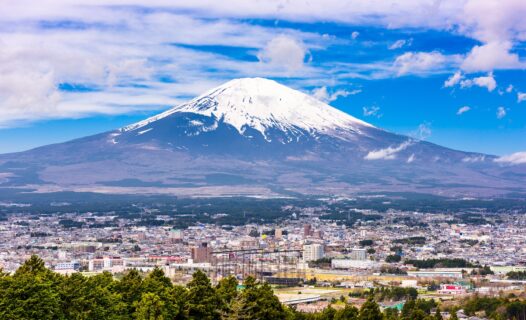
Discover the Magic of Gotemba: Top Things to Do in Japan's Hidden Gem

Explore the best family-friendly attractions and kid-friendly activities in Da Nang. Our guide provides the ultimate itinerary for a memorable trip with kids.

Explore the best time to visit Surabaya with a detailed travel guide. Discover must-see attractions, cultural events, and travel tips for a perfect trip.

Explore Jeju Island during the radiant canola flower season. Our comprehensive travel guide covers must-see spots, tips, and cultural insights to enjoy spring in Jeju.

Explore the best things to do in Mysore, from historical sites and cultural experiences to local cuisine and shopping. Discover the magic of the City of Palaces with our ultimate travel guide.

Explore the top attractions, hidden gems, and unforgettable experiences in Nagano with this ultimate travel guide.

Explore Somerset Rama 9 Bangkok, a top-rated accommodation featuring luxurious amenities, family-friendly facilities, and an unbeatable location within the Rama 9 neighborhood. Plan your stay today!

Unveiling Yogyakarta: Must-Visit Destinations and Hidden Gems in Java's Cultural Heart
Discover the best places to visit in Yogyakarta with our travel guide. From ancient temples and cultural landmarks to vibrant streets and hidden gems, explore the cultural heart of Java with us.

Discover everything you need to know about traveling to Indonesia for the first time. From visa requirements to top attractions, this guide covers it all.

Unveiling the Mystique of Bangkok's Four-Faced Buddha: A Spiritual Guide
Discover the spiritual significance and history of Bangkok's Four-Faced Buddha at the Erawan Shrine. Your ultimate guide to visiting this mystical site, complete with tips and insights.

Explore the rich history, stunning architecture, and vibrant culture of Malacca with our ultimate 7-day itinerary. Discover the best things to do, eat, and see in this UNESCO World Heritage city.

The Ultimate Guide to Accommodations in Hong Kong: Where to Stay for Every Traveler's Budget
Discover the best accommodations in Hong Kong. From budget hotels to luxury stays, find the perfect place to stay that suits your travel needs.

Explore Pattaya while enjoying a luxurious stay at Payaa Hotel. Discover top attractions, dining options, and travel tips for an unforgettable vacation.

Explore Lake Shinobazu in Tokyo with this comprehensive travel guide. Discover what to see, things to do, best time to visit, and accommodation options around Ueno Park.

Discover Klang: Top Things to Do and See in Selangor's Historic Gem
Explore the top attractions, cultural experiences, and hidden gems in Klang, Malaysia. Discover the best things to do, places to visit, and enjoy a memorable journey through Klang.

Discover all you need to know about Rajamangala Stadium in Bangkok. From sports events to accessibility, our ultimate guide has you covered.

Discover luxurious tranquility at JC Kevin Sathorn Bangkok Hotel. Find out why this hotel is the ultimate retreat in Bangkok — from its amenities to local attractions.

Explore the historic Nakasendo Trail in Japan with our comprehensive travel guide, including itinerary, cultural insights, and accommodation tips for a memorable hiking experience.

Discover the best places to eat in Sokcho-si. From traditional Korean cuisine to hidden gems, our comprehensive guide offers must-try dishes, dining recommendations, and travel tips.

Discover everything you need to know about Dream World Bangkok, including entrance fees, top attractions, and insider tips to make your visit unforgettable.

Discover the Magic of Gotemba: Top Things to Do in Japan's Hidden Gem
Explore the top things to do in Gotemba, Japan. Our travel guide covers everything from shopping at Gotemba Premium Outlets to breathtaking Mt. Fuji views.
Last Updated: September 07, 2024
Current language
All languages.
10 Best restaurants in Narita Airport

Mao Goto is a Japanese freelancer who was born in Hayama, Kanagawa prefecture, and raised in Tokyo. Since 2016 she lives in the Taito Ward, home to a lot of Japanese culture hotspots such as Asakusa, Akihabara, and Ueno. She has been interested in the field of English education in Japan and got her Master’s degree in March 2020. A lover of photography, travel, sweets, and cross-stitch. Contact her via Facebook .
This post may contain some affiliate links. When you click through and make a purchase we may receive some commission, at no extra cost to you .
Narita Airport is the gateway to Japan for foreign visitors traveling to Japan. After a long flight, filling one’s stomach is something that doubles the pleasure of the trip. Fortunately, Narita Airport is home to a variety of excellent restaurants where one can enjoy a delicious Japanese meal. These restaurants offer a wide variety of cuisines, including Japanese, Western, and more. Why not visit one of them when you arrive in Japan by plane? This article introduces 10 restaurants in Narita Airport that we especially recommend.
1. Dashichazuke EN
2. kaitensushi misaki, 4. kineya mugimaru, 5. japanese grill & craft beer tatsu, 6. meat dishes yakisuki yanma, 7. tonkatsu shinjuku saboten, 8. tsukiji – sushiiwa, 9. ramen ichikakuya, 10. keisei-yuzen, japan wonder travel tours .

“Dashi Chazuke En,” an ochazuke specialty restaurant located inside Narita Airport that offers authentic dashi chazuke that cannot be found anywhere else. It is a Japanese fast food restaurant where you can casually enjoy the particular taste of a Japanese restaurant. Customers are more than welcome to stop by and enjoy a meal before heading into the heart of Tokyo. In addition to chazuke, other dishes such as udon and rice balls can also be ordered. Enjoy the superb dashi broth made from kombu, iriko, shaved bonito flakes and chicken, along with seasonal ingredients. We hope you will try the ultimate chazuke at “Dashi Chazuke En” during your layover or transit time at Narita Airport.
Official Website: Dashichazuke EN
Location and business hours (Only in Japanese)
KAITENSUSHI MISAKI is a conveyor-belt sushi restaurant where you can enjoy the finest sushi using the freshest and most carefully selected ingredients. The wide variety makes it hard to decide which one to choose. This restaurant is particular about the freshness that comes from ordering fish from the Toyosu Market and is recommended for those who want to enjoy sushi casually at Narita Airport.
Official Website: KAITENSUSHI MISAKI
Location and business hours
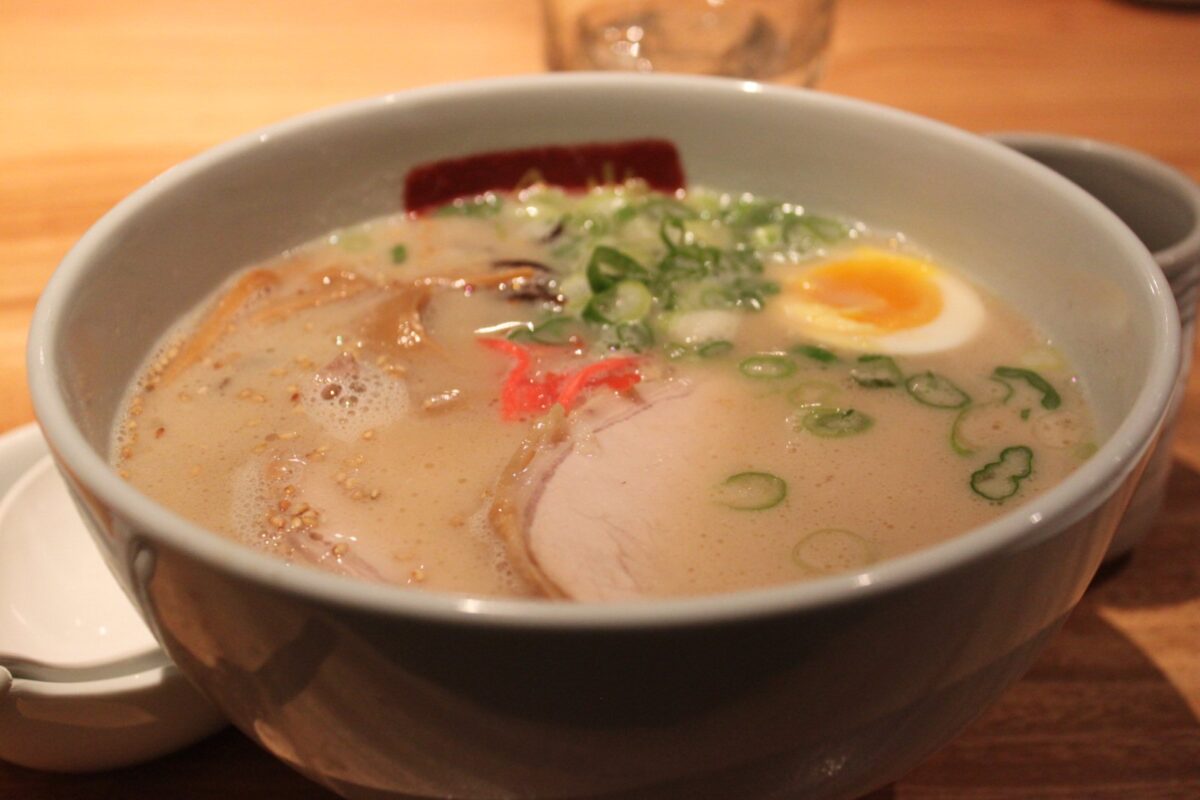
Ippudo is a ramen restaurant from Hakata , Japan, and is popular worldwide. The exterior of many of the restaurants is characterized by a warm, wooden design. “Shiromaru Classic”, their mainstay of tonkotsu ramen, has a royal yet deep flavor that goes perfectly with the thin noodles. On the other hand, the “Akamaru Modern” differs from the previous one in that it has a tangy taste with the addition of spicy miso and seasoning oil. Ippudo’s ramen is loved and eaten by people all over the world. Enjoy these authentic tonkotsu ramen at Narita Airport!
Official Website: IPPUDO
Kineya Mugimaru is an authentic udon specialty restaurant where you can taste the finest udon made by kneading wheat flour with salt water in the restaurant every day. The restaurant has an open kitchen, so you can watch the udon chefs making udon noodles, and the prices are very reasonable, with some udon orders starting at 300 yen. This restaurant is also recommended when you want to fill up on a small appetite.
Official Website: Homemade Udon Noodles KINEYAMUGIMARU
JAPANESE GRILL & CRAFT BEER TATSU is a restaurant where you can enjoy craft beer and freshly prepared Japanese food. Here you can fully enjoy the traditional taste of Japan. Udon, tendon , tonkatsu, steak, curry rice, and many other Japanese dishes that everyone loves are available in abundance. All dishes served here are cooked in the restaurant and made with fresh ingredients. Please enjoy the exceptional taste with their craft beer!
Official Website: JAPANESE GRILL & CRAFT BEER TATSU
MEAT DISHES YAKISUKI YANMA is a meat restaurant with an at-home atmosphere. Here, you can enjoy live cooking where delicious Wagyu beef is juicy grilled on a special teppan and finished in front of you with a special sauce. Yaki-suki, Yanma’s unique dish, is unforgettable once you try it. The aromatic sound of the special sauce sizzling on the hot griddle is very appetizing. On top of that, the exquisite combination of the Yakisuki sauce and meat goes perfectly with white rice. Enjoy the harmony of these delicious dishes to the fullest!
Official Website: MEAT DISHES YAKISUKI YANMA
Tonkatsu Shinjuku Saboten, a deep-fried food specialty restaurant with many locations nationwide, prides itself on providing customers with high quality deep-fried food. Their signature dish, tonkatsu , uses tender and juicy pork parts. The crunchy texture of the special bread crumbs, a result of high quality cooking skills, is a perfect match for your appetite ! Enjoy their hot and delicious tonkatsu!!
Official Website: Tonkatsu Shinjuku Saboten
Tsukiji Sushiiwa is a sushi restaurant that focuses on “tradition” and craftsmanship that has been handed down since the Taisho Era . They maximize the deliciousness of fresh seasonal fish and provide their customers with the finest taste. The restaurant is a place where good old-fashioned taste, comfortable atmosphere, and pleasant conversation are the main attractions. Take your time and enjoy a special sushi course to your heart’s content!
Official Website: tsukiji – Sushiiwa
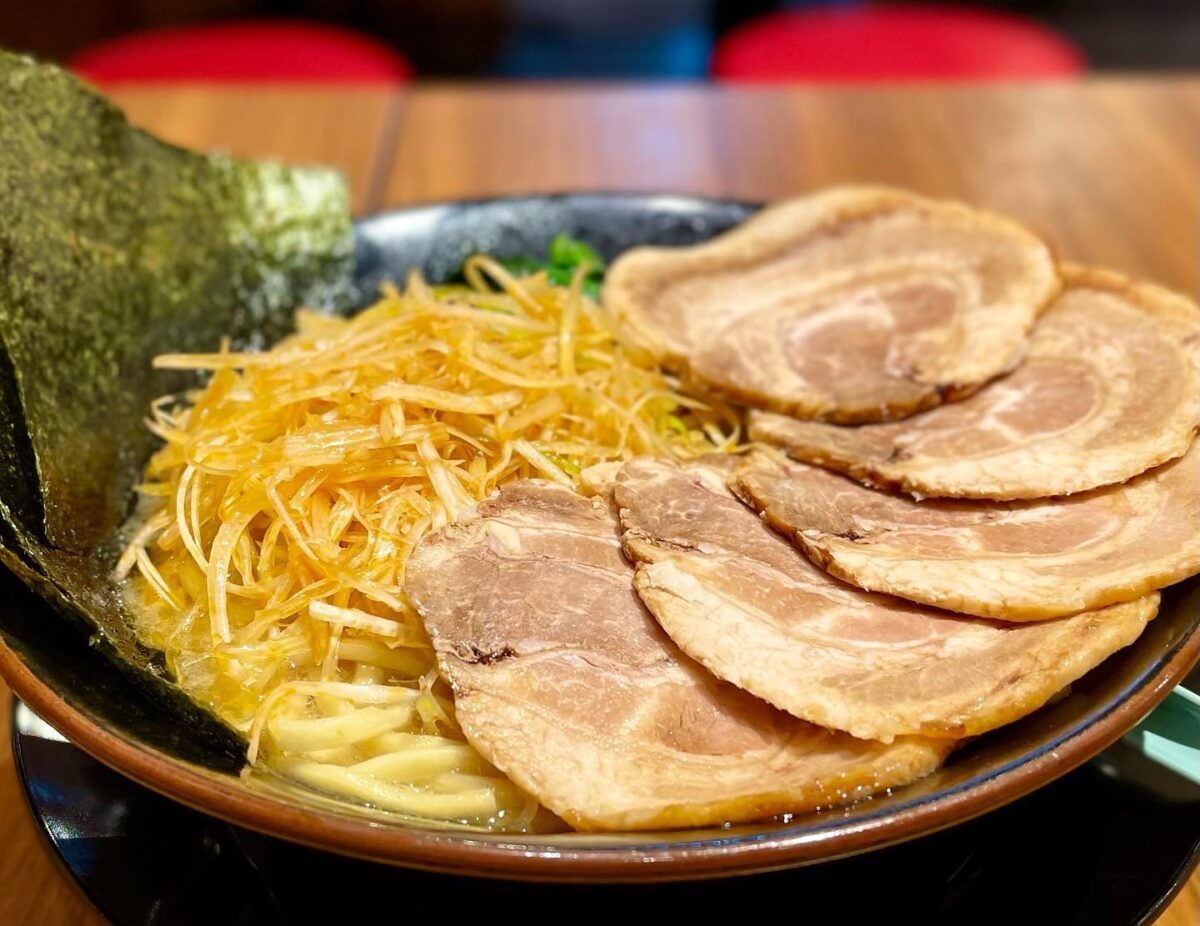
Ramen Ichikakuya is a famous chain of Yokohama-style Ramen restaurants. Their signature medium-thick noodles are specially made with the aroma of wheat with a unique texture. This restaurant especially mastered their interplay of the rich and creamy pork bone broth and their noodles. The soup, simmered over time, is concentrated with the deep flavor of pork bones, delighting your taste buds with every sip. Enjoy the luxurious flavor to the fullest with Ichikakuya’s special ramen. You will enjoy a cup of bliss with a pleasant aroma and rich broth.
Official Website: RAMEN ICHIKAWA
Keisei Yuzen is a family restaurant that offers a large selection of set menus of Japanese cuisine, ranging from tempura, grilled meat to sashimi and delicious noodles. It also offers the famous Eel box set menu, which is famous as an upscale food, and is highly recommended for those who would like to try some eel. “Sky Cider,” with its beautiful sky blue color, is typical for the Narita Airport branch and is the perfect drink for arrivers.
Official Website: KEISEI-YUZEN
These are the 10 recommended restaurants you can experience at Narita Airport. But have you found a restaurant you want to visit? The best restaurants at Narita Airport offer a wide range of choices, including not only Japanese and Western cuisine, but also cafes, curry and rice, and snacks , allowing you to fully enjoy both Japanese gastronomy and cuisine from around the world. You are sure to have a memorable dining experience on your trip.
Japan Wonder Travel is a travel agency that offers guided tours throughout Japan. From private walking tours to delicious Food and Drink tours, we can help you organize the best tours just for you! If you want to explore Japan and learn more about the history and backstories of each area you are visiting, our knowledgeable and friendly English speaking guides will happily take you to the best spots! In addition, we can provide you with any assistance you may need for your upcoming trip to Japan, so please feel free to contact us if you have any questions or need some help!
▶ Tokyo Tsukiji Fish Market Food and Drink Tour Explore the most lively and popular fish market in Tokyo and try some of the local’s favorite street foods and sake with one of our friendly and knowledgeable English speaking guides!

▶ Tokyo 1–Day Highlights Private Walking Tour (8 Hours) There’s no better way to explore an area than taking a tour with a knowledgeable local guide. You will have the chance to learn about the history and interesting background stories of Tokyo, as well as discover some hidden gems which can be hard to do without a guide.

▶ Mt. Fuji Day Trip Bus Tour from Tokyo Experience the breathtaking views of Mt. Fuji by visiting the highlights of the area on our guided sightseeing bus tour! Departing from Shinjuku in central Tokyo, you can travel comfortably to all of the best spots in the area by bus.

▶ Kyoto Private Full Day Walking Tour On this full-day private tour of Kyoto, you will be able to see the highlights of Kyoto in just one day and at the same time develop a deeper understanding of both the culture of the area and Japan as a whole.

Follow us on Instagram , Facebook , Twitter , and TikTok for more travel inspiration. Or tag us to get featured!
Happy traveling!
Stay informed of the best travel tips to Japan, the most exciting things to do and see, and the top experiences to have with the Japan Wonder Travel Newsletter. Every week we will introduce you to our latest content.
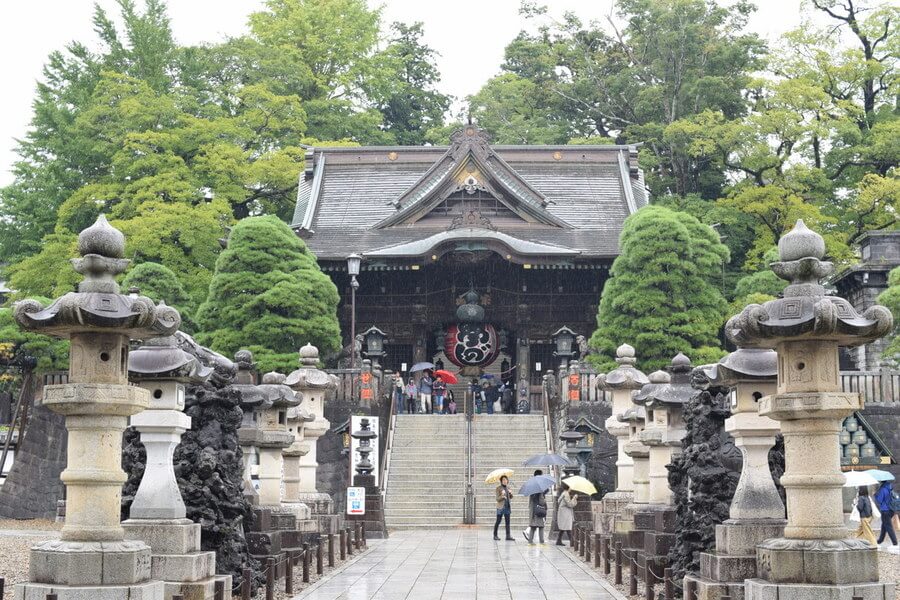
- Popular destinations
- Hidden places in Japan
- Tours and workshop
- Food and drink in Japan
- Itinerary in Japan
- Places to visit in Tokyo
- Food and drink in Tokyo
- Seasonal events
- Tours & workshops
- Tokyo This Week
- Day trip from Tokyo
- Itinerary in Tokyo
- Places to visit in Kyoto
- Food and drink in Kyoto
- Itinerary in Kyoto
- Day trip from Kyoto
- Travel tips
- Accommodation
- Cultural tips
- Transportation
- Tokyo Tours
- Kyoto Tours
- Kimono Rental
- Fukushima Tours
- Mount Fuji Tours
- Tour Package
- Travel Concierge Service
- Media Kit(English/日本語)
- Tour Operators
- Destinations
- Hotels & Resorts
- Digital Edition Spring 2024
- Digital Edition Fall 2023
- Travel Webcast
- Voices of Travel
- Agents' Choice Gala
- Agents' Choice survey results
- Canadian Travel Press
- Travel Courier
- Agents' Choice 2023
- Agents' Choice 2022
- Offshore Travel Magazine
- Culinary Travels
Viking announces six new Asia itineraries through Japan & China
September 4, 2024

Viking has announced six new itineraries in Asia that will expand exclusive access for guests to Japan and China, with Tibet (Xizang) in 2025.
The new voyages range from 15 to 22 days and explore iconic destinations in China, including Shanghai, Beijing, Xi’an and Lhasa in Tibet (Xizang), as well as Osaka, Japan. The itineraries will continue to highlight rarely-seen destinations and ports in China to which only Viking has access.
Each voyage will offer guests immersive destination-focused experiences, insightful lectures and regionally inspired cuisine.
Now open for booking, the new itineraries will operate from September 2025 to November 2025 on the Viking Yi Dun —formerly the Viking Sun —a sister ship featuring the same award-winning design and service as all other ocean ships in Viking’s fleet.
“We are proud to open our second season of these unique itineraries featuring exploration of the China coast—something that is entirely exclusive to Viking,” said Torstein Hagen, Chairman and CEO of Viking. “For centuries, these phenomenal destinations in Asia have inspired travelers with ancient history and rich culture. Our guests are curious travellers who travel as a way to broaden their minds, and we look forward to introducing more of Asia to them in 2025.”
New Asia voyages in 2025
- Jewels of Japan & China (15 days; Beijing to Tokyo)
- Classic China Discovery (20 days; Hong Kong to Beijing)
- Pearls of Japan & China (22 days; Tokyo to Beijing)
- Gems of China & Japan (22 days; Beijing roundtrip)
- 2025 Wonders of China (22 days; Beijing roundtrip)
- 2025 Best of China (22 days; Hong Kong to Beijing)
Pre and post land extensions
For additional immersion in Asia, Viking is also offering a variety of pre and post land extensions for its 2025 China itineraries, including:
- Beijing – Delve into the mysteries of Beijing, one of history’s great capitals and home to seven UNESCO World Heritage Sites, including the Forbidden City and Great Wall of China. Optional excursions offer an opportunity to be immersed in this multilayered city’s eclectic mix of China’s ancient past and bold future.
- Hong Kong – Delve into one of the world’s foremost metropolises with a three-night extension in Hong Kong. Admire the captivating cityscape and soak up its blend of tradition and modernity, culture and commerce. An optional excursion to Macau allows for more opportunities to experience China’s lively southern coast.
- Hong Kong & Guilin – Explore two versions of China – the urban spectacle of Hong Kong and the enchanting natural beauty of Guilin. Admire the towering skyscrapers and energy of Hong Kong, a metropolis steeped in commerce and culture, while tranquil Guilin captivates with karst mountains, serene rivers and ancient caves.
- Spirit of Mongolia – Immerse yourself in rich traditions and revel in the stark beauty of the Gobi Desert. Explore Ulaanbaatar, an eclectic mix of the ancient and the 21st century. At your desert lodge, admire striking landscapes and enjoy a range of activities curated to bring insight into Mongolia’s nomadic heritage.
- Tokyo – Unravel the mysteries of Tokyo, Japan’s neon-lit capital steeped in imperial history. Zen-like gardens and Shinto shrines mingle with towering skyscrapers in this bustling metropolis, all while the perfectly symmetrical cone of Mt. Fuji watches over.
The Viking Yi Dun
Dedicated specifically to exploring destinations in China, with an onboard experience that complements guests’ discoveries ashore, the Viking Yi Dun is a sister ship in Viking’s award-winning ocean fleet.
Classified by Cruise Critic as “small ships,” Viking’s ocean vessels have a gross tonnage of 47,800 tons, with 465 staterooms that host 930 guests; the ships feature all veranda staterooms, Scandinavian design, light-filled public spaces and abundant al fresco dining options.
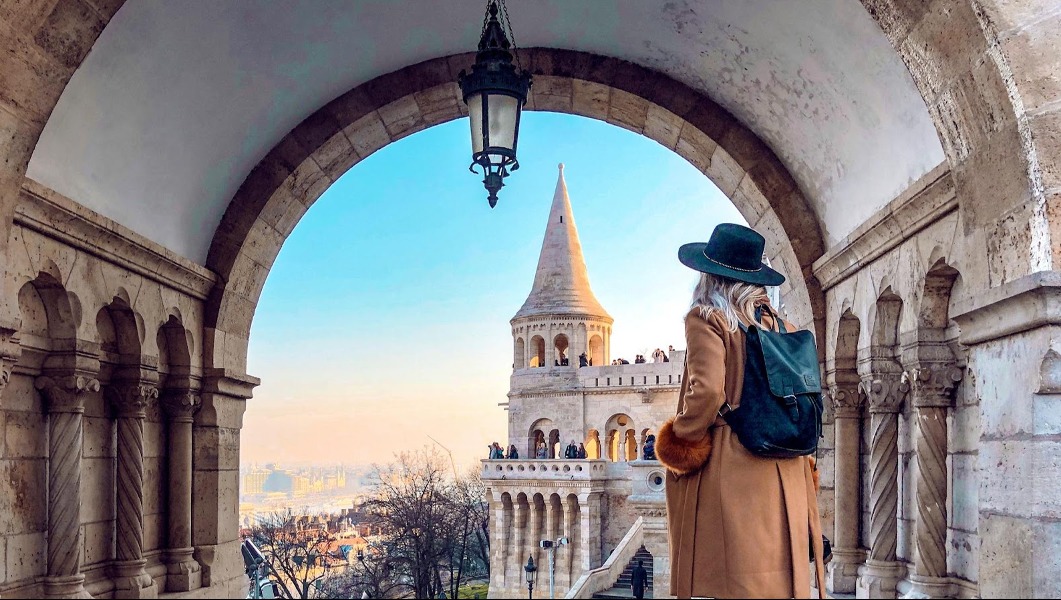
One in four Canadians like to plan their vacations early, study finds
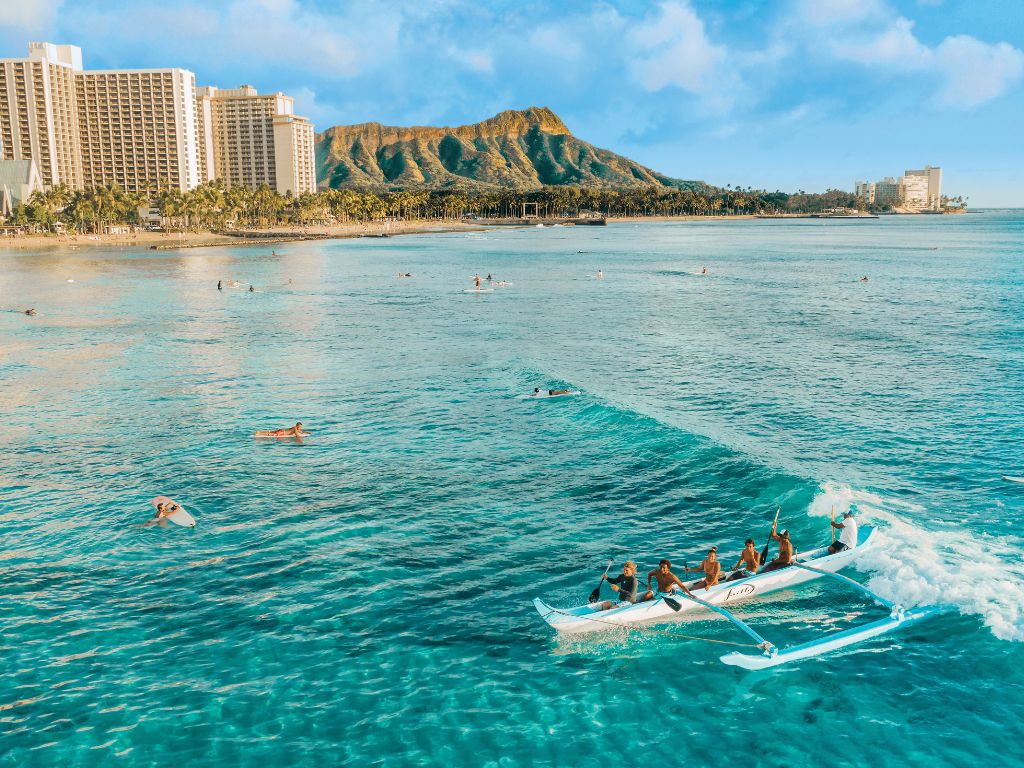
O‘ahu and Kaua‘i Visitors Bureaus to host travel agent webinars

IMAGES
COMMENTS
The Ultimate Japan Itinerary for 2024: From 1 to 3 Weeks
10 Days in Japan: A First-Timer's Complete Itinerary
2 Weeks in Japan Itinerary 2024: First-Timer 14 Day Guide
Japan Travel Itinerary - Best of Japan in 14 days
The Perfect 7-Day Japan Itinerary (Updated 2024)
The Best Japan Itinerary for First-Timers
Japan Travel: Suggested Itineraries
Japan Itinerary - The Best Of Japan In Two Weeks
Overview of our 10 days in Japan. Our itinerary covers Tokyo, Hakone, Shibu Onsen (to see the snow monkeys), Kyoto, Nara, Koya-san and Osaka. This provided a perfect mix of the best that Japan has to offer, from its fast-paced cities to its magnificent nature (including Mount Fuji) and captivating ancient temples.
A Japan Rail (JR) pass is exclusively available to tourists, and grants you unlimited travel on JR trains within Japan, including the world-famous bullet trains. Depending on your itinerary, this will save you time and money vs buying individual train tickets within Japan. But importantly, you must purchase the pass before you arrive in Japan.
How to Spend Two Weeks in Japan: An Itinerary for First- ...
To give you an idea, you should expect to travel in Japan with an average daily cost of about USD $45~ per person on a budget, or at least $120~ if you want to experience more comfort in activities, tours, hotels, and more. (Values below show low budget to medium budget ranges). Hotels: $25 to $120 USD / day.
The next step in our 14-day Japan itinerary is Matsumoto. There're many Samurai Castles scattered across Japan and you should visit at least one during your 14 days in Japan. We opted for the castle in Matsumoto as it is one of the few remaining original castles. Most other castles you will see are reconstructions.
Day 1 - Osaka - Reunited in Japan. Day 2 - Nara - When Deer Attack in Nara. Day 3 - Kyoto - Exploring Kyoto. Day 4 - Kyoto - Fushimi Inari Shrine. Day 5 - Hiroshima and Miyajima. Day 6 - Hiroshima - The Atomic Bomb. Day 7 - Tokyo - Not Early Enough for Tsukiji. Day 8 - Hakone - Hot Springs. Day 9 - Tokyo - Hato Bus.
Purchase a JR Rail Pass, for unlimited train travel while in Japan; Stop 1: Tokyo — 3 nights. Shibuya Hotel En, for the best centrally-located hotel; ... Other Destinations to Consider for Your Two-Week Japan Itinerary. There are several other destinations you can consider as even Hakone mentioned above. One popular other destination is ...
The Perfect One Month Japan Itinerary And Travel Guide ...
Japan Rail Pass is a multi-use discounted ticket, valid for travels on all JR national trains in Japan, including Shinkansen bullet trains and Narita Express. You can select 7, 14 or 21 consecutive validity days. A 7 day rail pass is $262 USD which is about the price of a round trip between Kyoto and Tokyo.
Itineraries | Travel Japan(Japan National Tourism ...
The following is a suggested itinerary for first time travelers to Japan who spend 21 days and 20 nights in Japan, and arrive/depart from Tokyo 's Narita Airport. Day 1 - Arrive at Narita Airport. Arrive at Narita Airport and spend the rest of the day in Tokyo. Day 2-5 - Tokyo with sidetrips.
8 Days in Japan: Top 5 Itineraries for First Visit 2024/2025
Obviously, with just 10-14 days in Japan, there's no way you can cover them all, so for this itinerary we've chosen the top destinations that we feel you can fit comfortably into 10+ days. Here are the top destinations we recommend visiting in 10+ days in Japan: Tokyo, Hakone, Osaka, Kyoto, Nara, Hiroshima and Miyajima, and Kamakura.
Here is the handpicked itinerary for your inspiration: Days 1-3: Tokyo (Meiji Shrine, Asakusa, sushi-making, and Mount Fuji) Days 4-5: Kyoto (Kinkaku-ji, Nijo Castle, Nishiki Market, and Fushimi Inari Shrine) Day 6: Osaka (ukiyo-e printmaking and a food tour at Shinsekai) Day 7: Departure.
The old imperial capital is Japan's most intriguing major tourist destination, where temples dot the backstreets, geishas shuffle around, and gardens and shrines hide in the deepest recesses. Unload at least four days in Kyoto to take the city in at a relaxed pace and leave room for a couple of awesome Kyoto day trips.
Practical Information and Travel Tips. Currency: Japanese Yen (JPY) Language: Japanese (English is widely understood in tourist areas) Transportation: Consider purchasing an IC card (ICOCA or PASMO) for convenient travel on public transportation. Travel Tip: When visiting hot springs and traditional bathhouses, remember that tattoos may be prohibited in many onsen.
Hi everyone, I'm traveling to Japan for the first time and would love some help crafting our itinerary, especially with how to get to each destination, the cheapest ways to travel between them, and advice on how many days to spend in each place.. Here's what we're thinking so far: 4-5 nights in Tokyo. 3 nights in Osaka and Kyoto (combined). Sapporo Snow Festival in February
Mikey V, (CC BY-NC 2.0), via Flickr. Ippudo is a ramen restaurant from Hakata, Japan, and is popular worldwide.The exterior of many of the restaurants is characterized by a warm, wooden design. "Shiromaru Classic", their mainstay of tonkotsu ramen, has a royal yet deep flavor that goes perfectly with the thin noodles.
Viking has announced six new itineraries in Asia that will expand exclusive access for guests to Japan and China, with Tibet (Xizang) in 2025. The new voyages range from 15 to 22 days and explore iconic destinations in China, including Shanghai, Beijing, Xi'an and Lhasa in Tibet (Xizang), as well as Osaka, Japan.